Sony PM-0440 Quad GSM/WCDMA/LTE cellular mobile telephone with BT, WLAN, Ant+ and RF ID User Manual
Sony Mobile Communications Inc Quad GSM/WCDMA/LTE cellular mobile telephone with BT, WLAN, Ant+ and RF ID
Sony >
Contents
- 1. User Manual
- 2. SAR Info Leaflet
User Manual

’13.9
INSTRUCTION MANUAL
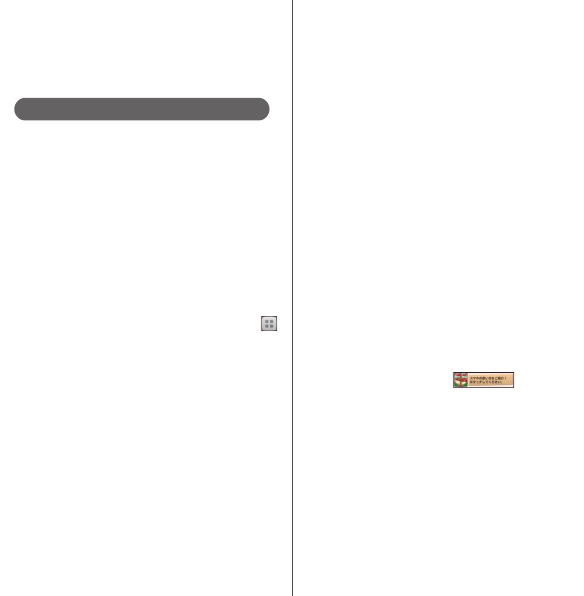
Introduction
Thank you for your purchase of "SO-01F".
For proper use of the SO-01F, read this manual
carefully before and while you use the SO-01F.
About manuals of SO-01F
In addition to this manual, the operations of SO-01F
are described in "
クイックスタートガイド
(Quick Start
Guide)" (in Japanese only) and "Instruction Manual"
application of the terminal (in Japanese only).
●
"
クイックスタートガイド
(Quick Start Guide)"
(Supplied accessories)
The initial operations and settings after purchasing
the terminal, screen view contents and operations of
main function are explained.
●
"Instruction Manual" (Application of the terminal)
Similarly to this manual, operations and settings of
each function are explained. To use "Instruction
Manual" application, from the Home screen, tap
and [Instruction Manual]. When using for the first
time, download and install the application according
to the onscreen instructions. You can use the
application as an electronic book. You can also shift to
actual operations by tapping the description in the
contents or view reference contents.
❖
Note
・
For downloading or updating the application, a high
packet communication charge will be applied
because of a large amount data communication. For
this reason, subscription of packet flat-rate service is
highly recommended.
●
"Instruction Manual" (PDF file)
Operations and settings of each function are
explained. It can be downloaded from NTT DOCOMO
website.
http://www.nttdocomo.co.jp/english/support/
trouble/manual/download/index.html
* You can download the latest information of "
ク
イックスタートガイド
(Quick Start Guide)". The
URL and contents are subject to change
without prior notice.
❖
Note
・
Reproduction or reprint of all or part of this manual
without prior permission is prohibited.
・
Important information for SO-01F is posted in the
following website. Be sure to check before using.
http://www.sonymobile.co.jp/support/use_support/
product/so-01f/ (In Japanese only)
●
スマホなるほどツアーズ
(Tips of smartphone)
(widget of the terminal
)
(in Japanese only)
An widget with which you can easily learn useful
functions and basic operations you should know with
Docomodake.
To use
スマホなるほどツアーズ
(Tips of smartphone),
from the Home screen, tap .

1
Operation descriptions
In this manual, each key operation is described with
P
,
x
,
y
,
r
,
m
,
k
. And selection
operations of the icons or function items on the
touch screen are described as follows.
❖
Information
・
In this manual, the instructions are described with
the default Home screen. If you set the other
application to the home screen, the operations may
differ from the descriptions.
・
Display examples and illustrations used in this
manual are just images for explanations and may be
different from actual ones.
・
In this manual, the easier procedure is described for
the functions and settings which have multiple
operating procedures.
・
Please note that "SO-01F" is called "the terminal" in
this manual.
・
In this manual, explanations for "docomo" as Home
application are provided. To switch the Home
applications, see "Switching Home application" (P.57).
Description Operation
From the Home screen,
tap and tap
[Settings]
u
[About
phone].
From the Home screen, tap
(Applications button),
and then tap "Settings" on
the next screen and "About
phone" on the following
screen in order.
Touch and hold an
icon.
Keep touching an icon
longer (1-2 seconds).

2
・
SO-01F (with warranty)
・
Back Cover SO22
・
クイックスタートガイド
(Quick Start Guide) (In
Japanese only)
・
SO-01F
のご利用にあたっての注意事項
安全上/取り扱い上のご注意
(Notes on usage Safety/Handling
precautions) (In Japanese only)
・
Desktop Holder SO17 (with warranty)
For details on optional devices, see "Optional
and related devices" (P.257).
Supplied accessories

Contents/Precautions
3
Contents
■
Supplied accessories. . . . . . . . . . . . . . . . . 2
■
About using the terminal . . . . . . . . . . . . 5
■
Safety Precautions (Always follow these
directions) . . . . . . . . . . . . . . . . . . . . . . . . . . 7
■
Handling precautions. . . . . . . . . . . . . . . 17
■
Waterproofness/Dustproofness . . . . . 23
Before Using the Terminal . . . 29
Part names and functions................................................29
docomo mini UIM card .....................................................30
Charging.....................................................................................33
Turning power on/off.........................................................37
Initial settings...........................................................................39
Basic operations.....................................................................40
Notification LED .....................................................................43
Status bar ...................................................................................44
Notification panel .................................................................46
Home screen............................................................................48
Application screen................................................................51
Task manager...........................................................................57
Switching Home application.........................................58
Searching information in the terminal and web
pages ............................................................................................58
Character entry.......................................................................60
Setting character entry......................................................75
Setting Xperia
™
Japanese keyboard........................76
USB keyboard/Bluetooth keyboard...........................83
docomo Palette UI. . . . . . . . . . . 85
Home screen............................................................................85
Managing the Home screen ..........................................85
Application screen................................................................91
Managing applications...................................................... 92
Phone . . . . . . . . . . . . . . . . . . . . . . 96
Making/Receiving a call.................................................... 96
Operations during a call ................................................... 99
Call history.............................................................................. 100
Call settings ........................................................................... 102
Phonebook ............................................................................ 104
Mail/Web browser . . . . . . . . . .114
sp-mode mail ....................................................................... 114
Message (SMS)..................................................................... 114
Email........................................................................................... 118
Gmail.......................................................................................... 124
Google Talk............................................................................ 125
Early Warning "Area Mail".............................................. 126
Web browser ........................................................................ 127
Apps. . . . . . . . . . . . . . . . . . . . . . .132
dmenu ...................................................................................... 132
dmarket.................................................................................... 132
Play Store ................................................................................ 133
Osaifu-Keitai .......................................................................... 134
Mobacas .................................................................................. 139
1Seg............................................................................................ 144
FM radio................................................................................... 151
Using earphone set .......................................................... 152
Camera ..................................................................................... 152
Playing multimedia content ....................................... 173
Album ....................................................................................... 174
YouTube .................................................................................. 177
Media Player.......................................................................... 178

4
Contents/Precautions
Socialife .................................................................................... 180
Location services................................................................181
Calendar................................................................................... 186
Alarm & clock........................................................................ 188
ドコモバックアップ
(docomo backup).................. 191
OfficeSuite .............................................................................. 193
Settings . . . . . . . . . . . . . . . . . . . 194
Viewing the setting menu............................................194
Wireless & networks.......................................................... 194
Device........................................................................................ 206
PERSONAL............................................................................... 215
ACCOUNTS............................................................................. 223
SYSTEM ..................................................................................... 226
File management . . . . . . . . . . 229
Storage structure................................................................ 229
File operations......................................................................231
Data communication . . . . . . . 233
Using infrared communication ................................. 233
Using Bluetooth function.............................................. 236
Using NFC communication ......................................... 240
External device connection . 242
Connecting to PC............................................................... 242
Connecting to DLNA device....................................... 245
Connecting to other devices...................................... 247
International roaming . . . . . . 249
Overview of International roaming (WORLD
WING)......................................................................................... 249
Available services ............................................................... 249
Before using........................................................................... 250
Making/receiving calls in the country you stay
....................................................................................................... 253
International roaming settings.................................. 255
Appendix/Index . . . . . . . . . . . .258
Optional and related devices ..................................... 258
Troubleshooting................................................................. 258
Smartphone Anshin Remote Support ................. 266
Warranty and After Sales Services ........................... 267
Updating software ............................................................ 270
Main specification ............................................................. 274
Language................................................................................ 278
Certificate and compliance ......................................... 279
End User Licence Agreement .................................... 292
About Open Source Software.................................... 293
Export Controls and Regulations ............................. 293
Intellectual Property Right ........................................... 294
SIM unlock.............................................................................. 297
Index .......................................................................................... 298

5
Contents/Precautions
Contents/Pre cautions
・
The terminal supports LTE, W-CDMA, GSM/
GPRS and Wireless LAN Systems.
・
Because a terminal operates using radio
frequencies, it cannot be used inside a tunnel,
underground, in a building or other locations
where radio waves do not reach the terminal,
in locations with weak radio wave condition,
or out of Xi/FOMA service area. The services
may not be available on high upper floors of
high-rise apartments or buildings, even if you
can see no obstructions around you. On
occasion, your calls may become
disconnected even in areas with strong radio
wave condition, even if you are not moving, or
even if there are 4-antenna marks in the
terminal's display.
・
Because your terminal uses radio waves to
communicate, it is possible that a third party
may attempt to tap your calls. However, the
LTE, W-CDMA, GSM/GPRS system
automatically scrambles all calls through a
private call feature. Therefore, even if third
party successfully intercepts your call, they
will only hear noise.
・
The terminal operates on radio frequencies by
converting voice into digital signals. If the
caller moves into an area of adverse radio
wave condition, the digital signal may not be
restored accurately, and the voice received in
the call may differ slightly from the actual
voice.
・
Note down the information saved in the
terminal in a separate note and keep it safely.
Note that DOCOMO assumes no
responsibility for any loss of saved contents of
data resulting from malfunction, repair,
changing of the model or other handling of
the terminal.
・
You are recommended to save important
data to microSD card.
・
As with PCs, some user-installed applications
may disrupt the stability of the terminal
performance, or unexpectedly transmit
information via the Internet causing improper
use of your location information as well as
personal information recorded on the
terminal. Therefore, verify the supplier and
operating conditions of the applications to be
used before using them.
・
This terminal has Xi Area, FOMA Plus-Area and
FOMA HIGH-SPEED Area support.
・
The terminal does not support i-mode sites
(programs) or i-
D
ppli.
About using the terminal

6
Contents/Precautions
・
The terminal automatically performs
communication for synchronizing data,
checking the latest software version, maintain
connection with the server, etc. If you
transmit a large amount of data such as
downloading applications or watching video,
a packet communication charge becomes
high. Subscription of packet flat-rate service is
highly recommended.
・
Depending on the applications or service you
use, packet communication charge may be
applied even in Wi-Fi communication.
・
Since Mobacas is a service linking
communication, using the service requires
packet communication charge. Subscription
of packet flat-rate service is recommended.
・
Public mode (Driving mode) is not supported.
・
Setting the terminal to the silent mode does
not mute sounds for shutter, playback of
video or music, alarm, dial pad touch tones
during a call, sound emitted when tapping
[End call], etc.
・
The name of the operator is displayed on
unlock screen (P.37).
・
To check your phone number (own number),
from the Home screen, tap and tap
[Settings]
u
[About phone]
u
[Status] to see
"My phone number".
・
To check the software version, from the Home
screen, tap and tap [Settings]
u
[About
phone].
・
You can perform software update by
downloading an update file with a PC via
Internet and connecting the PC to the
terminal. For details, see "Connecting to a PC
and updating" (P.272).
・
By some software updates, the operating
system (OS) may be version-upgraded for
improving the terminal quality. For this
reason, you always need to use the latest OS
version. And some applications that used in
the previous OS version may not be available
or some unintended bugs may occur.
・
You can use the terminal only with docomo
mini UIM card. If you have a UIM or FOMA
card, bring it to a docomo Shop to replace.
・
Set the screen lock to ensure the security of
your terminal for its loss. For details, see
"Screen lock" (P.218).
・
If your terminal is lost, change your each
account password to invalidate
authentication using a PC to prevent other
persons from using Google services such as
Google Talk, Gmail, Google Play, etc.,
Facebook, Twitter and mixi.
・
For services provided by Google, refer to
Google Terms of Service. For other web
services, refer to each terms of service.
・
Google application and service contents are
subject to change without prior notice.
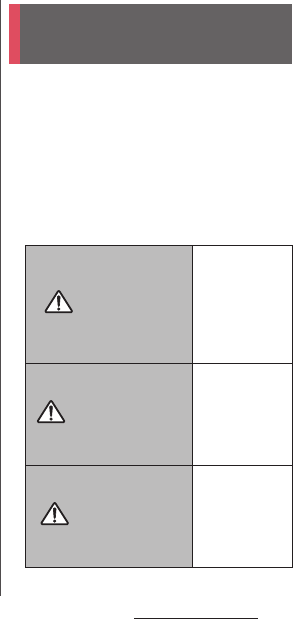
7
Contents/Precautions
・
The terminal supports only sp-mode, mopera
U and Business mopera Internet. Other
providers are not supported.
・
To use tethering, subscription of sp-mode is
required.
・
Packet communication charge when using
tethering varies depending on the charging
plan you use. Subscription of packet flat-rate
service is highly recommended.
・
For details on usage charge, etc., refer to the
following website.
http://www.nttdocomo.co.jp/english/
・
Display is manufactured by taking advantage
of highly advanced technology but some
dots may be always or never lit. Note that, this
shows characteristics of liquid crystal displays
and not defects in the terminals.
■
For safe and proper use of the terminal, please
read the "Safety Precautions" prior to use.
Keep the Manual in a safe place for future
reference.
■
ALWAYS observe the safety precautions since
they intend to prevent personal injury or
property damage.
■
The following symbols indicate the different
levels of injury or damage that may result if
the guidelines are not observed and the
terminal is used improperly.
Safety Precautions (Always
follow these directions)
Failure to
observe these
guidelines may
immediately
result in death
or serious
injury.
Failure to
observe these
guidelines may
result in death
or serious
injury.
Failure to
observe these
guidelines may
result in injury
and property
damage.
DANGER
WARNING
CAUTION

8
Contents/Precautions
■
The following symbols indicate specific
directions.
■
"Safety Precautions" are described in the
following categories:
1. Handling the terminal, battery pack, adapter,
desktop holder, docomo mini UIM card
(common) . . . . . . . . . . . . . . . . . . . . . . . . . . . . . . . . . . 8
2. Handling the terminal . . . . . . . . . . . . . . . . . . . . . . 10
3. Handling battery pack . . . . . . . . . . . . . . . . . . . . . . 12
4. Handling adapter or desktop holder. . . . . . . . . 13
5. Handling the docomo mini UIM card . . . . . . . . 15
6. Handling the terminal near electronic medical
equipment. . . . . . . . . . . . . . . . . . . . . . . . . . . . . . . . . 15
7. Material list. . . . . . . . . . . . . . . . . . . . . . . . . . . . . . . . . 16
1. Handling the terminal, battery
pack, adapter, desktop holder,
docomo mini UIM card (common)
DANGER
Do not use, store or leave the equipment in
hot places (e.g. by the fire, near a heater,
under a kotatsu, in direct sunlight, in a car in
the hot sun). (including the event that you
ware the equipment in the pocket of your
clothes, etc.)
Doing so may cause fire, burns or injury.
Do not place equipment inside cooking
appliance such as a microwave oven or high-
pressure containers.
Doing so may cause fire, burns, injury or
electric shock.
Do not disassemble or modify the
equipment.
Doing so may cause fire, burns, injury or
electric shock.
Do not let the equipment get wet with
water, drinking water, urine of pet animals,
etc.
Doing so may cause fire, burns, injury or
electric shock.
For waterproof, see
→
P.23. "Waterproofness/
Dustproofness".
Use a battery pack and an adapter specified
by NTT DOCOMO for the terminal.
Failure to do so may cause fire, burns, injury or
electric shock.
Indicates prohibited actions.
Indicates not to disassemble.
Indicates not to use where it could
get wet.
Indicates not to handle with wet
hands.
Indicates compulsory actions in
accordance with instructions.
Indicates to remove the power plug
from the outlet.
Don’t
No disassembly
No liquids
No wet hands
Do
Unplug
Don’t
Don’t
No disassembly
No liquids
Do
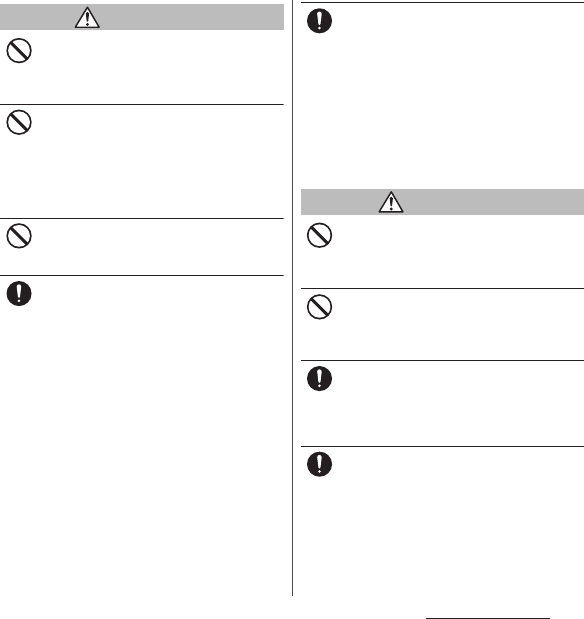
9
Contents/Precautions
WARNING
Do not subject the equipment to excessive
force or throw it.
Doing so may cause fire, burns, injury or
electric shock.
Do not allow the contacts for the desktop
holder, the microUSB jack or headset jack to
touch conducting foreign substances (a
piece of metal, pencil lead, etc.). Never allow
these objects to get inside.
Doing so may cause fire, burns, injury or
electric shock.
Do not cover or wrap the equipment with a
cloth or bedding in use or while charging.
Doing so may cause fire or burns.
Power off the terminal before you step into a
place where flammable gas can leak, such as
gas stations. Stop charging if you charge the
battery.
Gas may catch fire.
When using Osaifu-Keitai in a place such as a
gas station, turn OFF the terminal before using
it.
(When NFC/Osaifu-Keitai lock is activated,
deactivate it before turning OFF the terminal.)
If you notice anything unusual about the
equipment such as an unusual odor,
overheating, discoloration or deformation
during operation, charging or storage,
immediately perform the following
measures.
・
Remove the power plug from the power
outlet or cigarette lighter.
・
Power off the terminal.
・
Remove battery pack.
Failure to do so may cause fire, burns, injury or
electric shock.
CAUTION
Do not place on an unstable or inclined
platform.
Doing so may cause the device to fall and
cause injury.
Do not keep in a place that is very humid,
dusty, or subject to high temperature.
Doing so may cause fire, burns or electric
shock.
If children use the terminal, parents or
guardians should give them the proper
instructions for use. Make sure that they use
the terminal as instructed.
Failure to do so may cause injury.
Keep the equipment out of the reach of
babies and infants.
Failure to do so may cause accidental
swallowing or injury.
Don’t
Don’t
Don’t
Do
Do
Don’t
Don’t
Do
Do
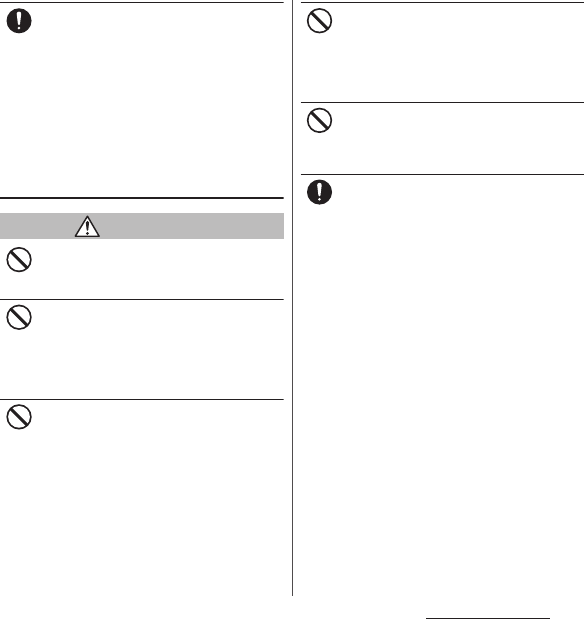
10
Contents/Precautions
Be careful especially when using the
terminal connected to the adapter
continuously for a long time.
If you play a game, watch 1Seg, etc. for a long
time while charging, the temperature of the
terminal, battery pack and adapter may rise.
If you are directly in contact with hot parts for
a long period of time, it may cause your skin to
become red, itchy, or develop a rash
depending on your physical condition and
also it may cause low-temperature burn.
2. Handling the terminal
WARNING
Do not direct the infrared data port toward
your eye and transmit signals.
Doing so may cause harmful effect your eyes.
Do not direct the infrared data port toward
home electric appliances etc. equipped with
infrared device when using infrared
communication.
Doing so may cause an accident because of
erroneous operation of infrared device.
Do not turn on the light with the lighting
luminescence part close to the eyes.
Especially to shoot infants or young
children, step away from them 1 m or more.
Doing so may cause blurred vision. Or injury
by dazzling eyes or surprising may occur.
Do not allow a foreign substance such as
water and other liquids, metal parts, or
flammables to get in the docomo mini UIM
card or microSD card slot on the terminal.
Doing so may cause fire, burns, injury or
electric shock.
Do not turn on the light toward a driver of a
car etc.
Doing so may disturb driving and cause an
accident.
Power off the terminal in a place where the
use is prohibited such as in airplane or
hospital.
Failure to do so may affect electronic
equipment and electronic medical
equipment.
Follow the instructions of each medical facility
for the use of mobile phones on their
premises.
Prohibited acts such as mobile phone usage
on board an airplane may be punished by law.
If usage of mobile phones in an aircraft is
admitted by setting airplane mode, etc., use
the terminal under the direction of the airline.
If the microUSB cable is connected into the
microUSB jack for charging etc. with the
terminal powered off, the terminal is
automatically powered on although the
operations are not available. Be careful not to
connect the microUSB cable in a place where
the use is prohibited such as in an airplane or
hospital.
Do
Don’t
Don’t
Don’t
Don’t
Don’t
Do
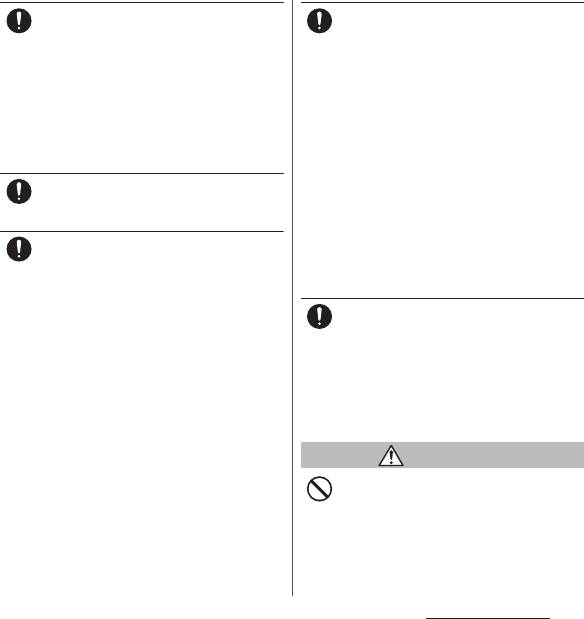
11
Contents/Precautions
Always keep the terminal away from your
ear when you talk setting the hands-free
function.
Also, when you play game, play back music,
etc. connecting the Earphone/Microphone,
etc. to the terminal, adjust the volume
adequately.
If the volume is too loud, it may cause
difficulty in hearing.
Moreover, if you barely hear the surrounding
sounds, it may cause an accident.
If you have a weak heart, set the vibrator or
ringtone volume carefully.
Failure to do so may affect your heart.
If you are wearing any electronic medical
equipment, check with the relevant medical
electronic equipment manufacturer or
vendor whether the operation may be
affected by radio waves.
The radio waves from the terminal may affect
electronic medical equipment.
Power off the terminal near electronic
devices or equipment operating on high
precision control or weak signals.
Failure to do so may interfere with the
operation of electronic devices or equipment.
* The followings are some electronic devices
or equipment that you should be careful of:
Hearing aids, implantable cardiac
pacemaker, implantable cardioverter
defibrillator, other electronic medical
equipment, fire detector, automatic door,
and other automatically controlled devices
or equipment.
If you use an implantable cardiac
pacemaker, implantable cardioverter
defibrillator, or other electronic medical
equipment, check with the relevant medical
electronic equipment manufacturer or
vendor whether the operation can be
affected by radio waves.
Be careful about broken glasses or exposed
internal from the terminal if the display or
the camera lens is broken.
Shatterproof film-applied hardened glass is
used on the display surface and the acrylic
resin is applied on camera lens so as not to be
shattered when broken. But they may cause
injury if you touch a cut surface or exposed
portion mistakenly.
CAUTION
Do not swing the terminal around by
holding the antenna, strap, etc.
The terminal may hit you or others and cause
accident such as injury.
Do
Do
Do
Do
Do
Don’t
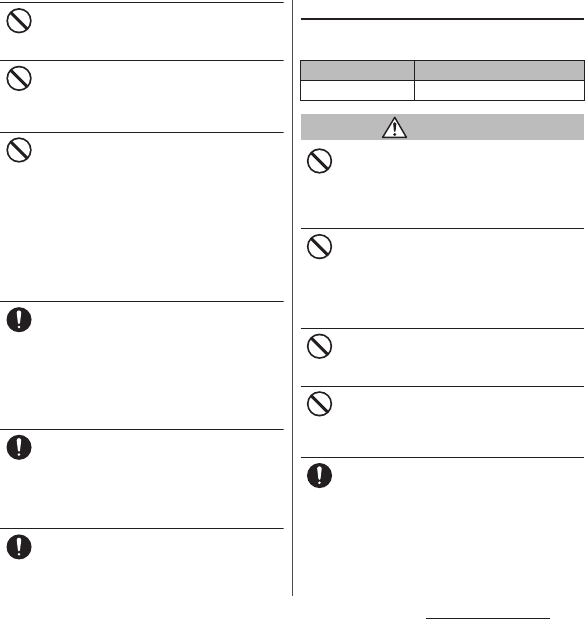
12
Contents/Precautions
Do not use damaged terminal.
Doing so may cause fire, burns, injury or
electric shock.
When using the motion sensor, check the
safety around you, hold the terminal firmly,
and do not shake it unnecessarily.
May cause accident such as injuries.
If the display is mistakenly damaged and
when the liquid crystal runs out, do not get
it on your skin such as face, hands, etc.
Doing so may cause blindness or injury on
your skin.
If the liquid crystal gets in your eye or mouth,
rinse with clean running water, and get
medical treatment immediately.
Also, if it gets on your skin or clothes, use
something such as alcohol to wipe off and
wash it with soap in clear water.
To use the terminal in car, check with
automobile manufacturer or dealer to
determine how the device is affected by
radio waves before using.
In rare cases, using the phone in some vehicle
models can cause the vehicle's electronic
equipment to malfunction. In that case, stop
using the terminal immediately.
The use of the terminal may cause itching,
rashes, eczema, or other symptoms
depending on the user's physical condition.
Immediately stop using and get medical
treatment in such a case.
For material of each part
→
P.16 "Material list"
When watching the display, take a certain
distance from the display in a fully bright
place.
Failure to do so may reduce visual acuity.
3. Handling battery pack
■
Check that the battery type matches the type
displayed on the battery pack label.
DANGER
Do not connect a wire or other metal objects
to the jack. And, do not carry or store the
terminal with objects like a metal necklace.
Doing so may cause battery pack to ignite,
burst, heat or leak.
Check the orientation of the battery pack to
attach to the terminal, and do not try to
force the battery pack onto the terminal if
you are having trouble attaching it.
Doing so may cause battery pack to ignite,
burst, heat or leak.
Do not throw the terminal into fire.
Doing so may cause battery pack to ignite,
burst, heat or leak.
Do not stick a nail into the terminal, hit it
with a hammer, or step on it.
Doing so may cause battery pack to ignite,
burst, heat or leak.
If the battery pack fluid etc. contacts eyes,
immediately flush the eyes with clean water
and see a doctor right away. Do not rub the
eyes.
Failure to do so may cause blindness.
Don’t
Don’t
Don’t
Do
Do
Do
Display Type of Battery
Li-ion 00 Lithium Ion Battery
Don’t
Don’t
Don’t
Don’t
Do
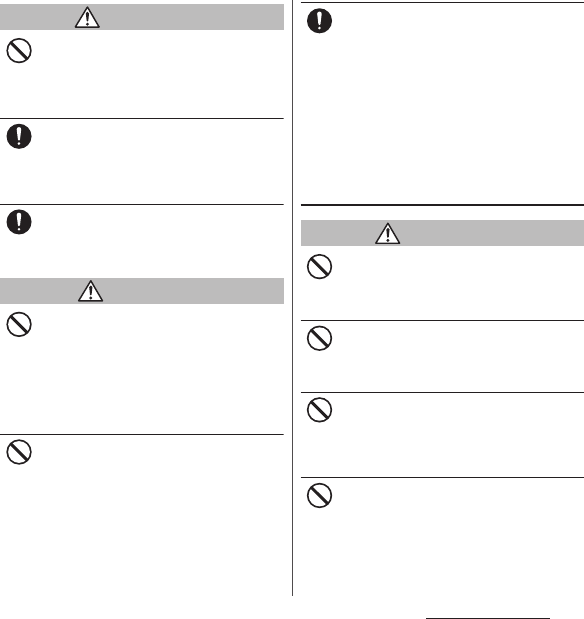
13
Contents/Precautions
WARNING
If the battery pack seems to have
abnormalities such as deformation or
scratches due to falling, never use it.
Doing so may cause battery pack to ignite,
burst, heat or leak.
If the battery pack leaks or gives off a
strange smell, immediately remove it from
the vicinity of open flames.
The leaking liquid may ignite fire, catch fire, or
explode.
Be careful not to let your pet bite the battery
pack.
Doing so may cause battery pack to ignite,
burst, heat or leak.
CAUTION
Do not discard the battery together with
other garbage.
Doing so may cause igniting or environmental
destruction. Tape the contacts of old battery
packs to insulate them, and then bring them
into a sales outlet such as docomo Shop. If
your local municipality has a battery recycling
program, dispose of them as provided for.
Do not use or charge a wet battery pack.
Doing so may cause battery pack to ignite,
burst, heat or leak.
If fluid etc. leaks out from the battery pack,
do not make the fluid contact with your skin
of face or hands.
Doing so may cause blindness or injury on
your skin. If the fluid etc. gets into your eyes or
mouth, or contacts skin or clothes,
immediately flush the contacted area with
clean running water. If the fluid gets into the
eyes or mouth, immediately see a doctor after
flushing.
4. Handling adapter or desktop
holder
WARNING
Do not use the adapter cord if it gets
damaged.
Doing so may cause fire, burns or electric
shock.
Do not use the AC adapter or desktop holder
in a very humid place such as bathroom.
Doing so may cause fire, burns or electric
shock.
DC adapter is only for a negative ground
vehicle. Do not use DC adapter for a positive
ground vehicle.
Doing so may cause fire, burns or electric
shock.
Do not touch the adapter if you hear
thunder.
Doing so may cause electric shock.
Don’t
Do
Do
Don’t
Don’t
Do
Don’t
Don’t
Don’t
Don’t
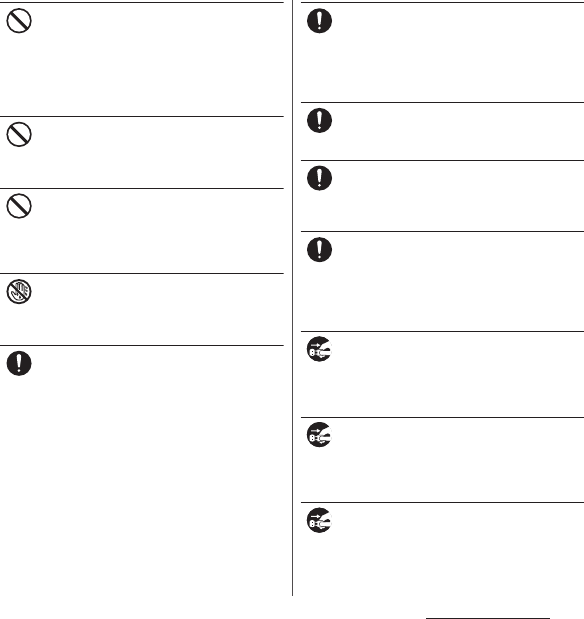
14
Contents/Precautions
Do not short-circuit the charging jack while
it is connected to the power outlet or
cigarette lighter socket. Do not touch the
charging jack with your hands, fingers, or
any part of your body.
Doing so may cause fire, burns or electric
shock.
Do not place heavy objects on the adapter
cord.
Doing so may cause fire, burns or electric
shock.
When you insert and remove the AC adapter
from power outlet, do not contact a metal
strap or other metal objects with the jack.
Doing so may cause fire, burns or electric
shock.
Do not touch the adapter cord, desktop
holder or outlet with wet hands.
Doing so may cause fire, burns or electric
shock.
Use the adapter only on the specified power
supply and voltage.
When charging the terminal overseas, use
AC adapter for global use.
Failure to do so may cause fire, burns or
electric shock.
AC adapter : AC 100 V
DC adapter : DC 12 V or 24 V (only for a
negative-ground vehicle)
AC adapter for global use : AC 100 V to 240 V
(Make sure to connect the adapter to a
household AC power outlet.)
When the fuse in a DC adapter is blown,
make sure to use the specified fuse.
Failure to do so may cause fire, burns or
electric shock. For the specified fuse, see the
users manuals that supplied with a DC
adapter.
Clean dust from the power plug.
Failure to do so may cause fire, burns or
electric shock.
When you connect the AC adapter to the
power outlet, insert it firmly.
Failure to do so may cause fire, burns or
electric shock.
When you disconnect the power plug from
the outlet or cigarette lighter socket, do not
pull the adapter cord with excessive force.
Instead, hold the adapter to disconnect.
Failure to do so may cause fire, burns or
electric shock.
Always remove the power plug from the
outlet or cigarette lighter when not using
the adapter for an extended period.
Failure to do so may cause fire, burns or
electric shock.
Immediately remove the power plug from
the outlet or cigarette lighter socket if water
or other fluids get into the adapter.
Failure to do so may cause fire, burns or
electric shock.
Before cleaning, remove the power plug
from the power outlet or the cigarette
lighter socket.
Failure to do so may cause fire, burns or
electric shock.
Don’t
Don’t
Don’t
No wet hands
Do
Do
Do
Do
Do
Unplug
Unplug
Unplug
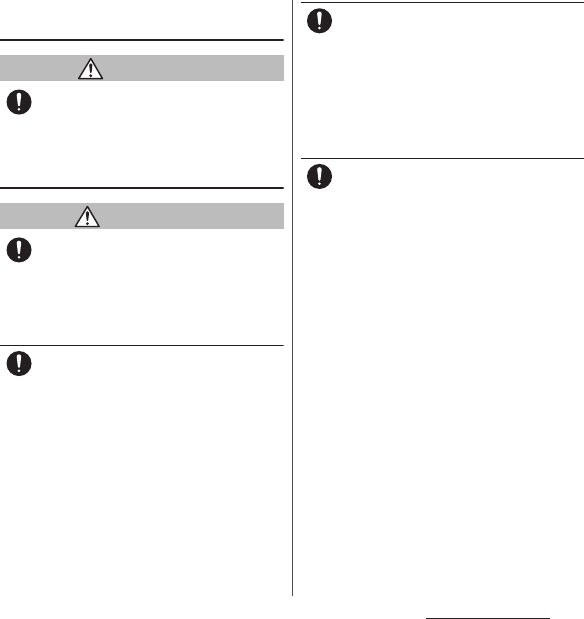
15
Contents/Precautions
5. Handling the docomo mini UIM
card
CAUTION
Be careful of the cut surface when removing
docomo mini UIM card.
Failure to do so may cause injury.
6. Handling the terminal near
electronic medical equipment
WARNING
If you use an implantable cardiac pacemaker
or implantable cardioverter defibrillator,
keep the terminal 15 cm or more away from
the implant at all times.
The radio waves from the terminal may affect
the performance of electronic medical
equipment.
If you need to use electronic medical
equipment other than implantable cardiac
pacemaker or implantable cardioverter
defibrillator outside medical facilities such
as treating at home, check with the relevant
medical electronic equipment manufacturer
whether the operation may be affected by
radio waves.
The radio waves from the terminal may affect
the performance of electronic medical
equipment.
When you get close to other people within
15 cm just like not having enough space to
turn around, set the radio wave of the
terminal to OFF beforehand (Airplane mode,
to turn OFF, etc.).
A person in close proximity may put on
implanted a medical electrical equipment
such as pacemakers and ICDs. The radio waves
from the terminal may affect the performance
of electronic medical equipment.
Follow the instructions of each medical
facility for the use of the terminal on their
premises.
Do
Do
Do
Do
Do
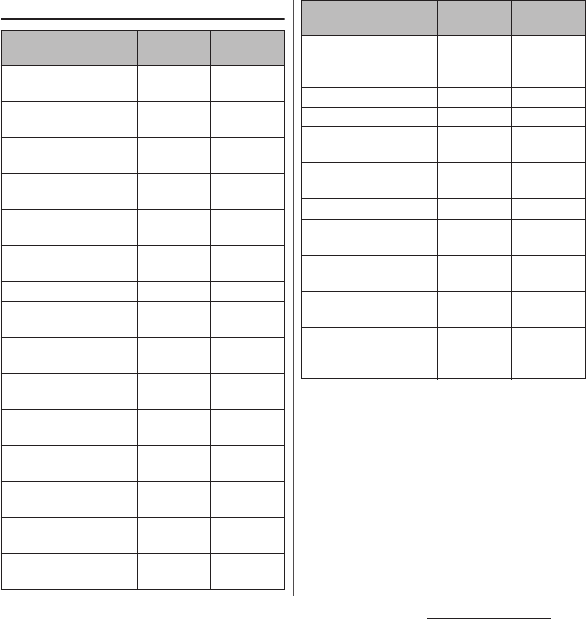
16
Contents/Precautions
7. Material list
Part Material Surface
treatment
Exterior case (side cover) PA resin
(with glass)
UV coating
Exterior case (back cover) PC resin
(with glass)
Urethan
coating
Exterior case (headset
jack cover)
PC resin
(with glass)
Urethan
coating
Exterior case (microUSB
jack cover)
PC resin
(with glass)
Urethan
coating
Side panel PET resin +
PC resin
Hard coating
Transparent plate
(camera)
PC + PMMA
resin
AR
treatment
Transparent plate (flash) PC resin
―
Transparent plate
(display)
Glass + PET
resin
Hard coating
Decoration ring (power
key cover, camera)
Aluminum
alloy
Anodic oxide
coating
Side keys (power key,
volume key, camera key)
Aluminum
alloy
Anodic oxide
coating
Mobacas/1Seg antenna
(cap)
PC resin
(with glass)
―
Mobacas/1Seg antenna
(shaft top)
SUS
―
Mobacas/1Seg antenna
(shaft middle)
SUS
―
Mobacas/1Seg antenna
(shaft bottom)
Nickel
titanium
―
Mobacas/1Seg antenna
(hinge)
SUS
―
Battery pack (contacts) Copper alloy First nickel
plating/Gold
plating
Battery pack (body) PC resin
―
Battery pack (label) PET resin
―
Desktop holder (upper
case)
ABS resin
―
Desktop holder (lower
case)
ABS resin
―
Desktop holder (lever) POM resin
―
Desktop holder
(contacts)
Phosphor
bronze
Gold plating
Desktop holder (label) Polyester
resin
―
Desktop holder (rubber
foot)
Polyester
resin
―
Desktop holder (screws) SWCH Black
chromate
plating
Part Material Surface
treatment

17
Contents/Precautions
■
Common precautions
・
SO-01F is waterproof/dustproof,
however, do not allow water or dust to
seep into the terminal and do not allow
accessories or optional devices to get
wet or dust.
The battery pack, adapter, desktop holder and
docomo mini UIM card are not waterproof/
dustproof. Do not use in a bathroom or other
highly humid area or do not let rain touch. Or
putting them on your body, humidity of sweat
may cause internal corrosion and malfunction.
Note that malfunctions which are determined to
be caused by water as result of inspections are
outside the scope of the warranty. Since these
conditions are outside of the scope of the
warranty, a repair, if at all possible, is charged.
・
Clean the terminal with a dry soft cloth
(such as used for cleaning eyeglasses).
- Do not rub it roughly with a dry cloth. The
display may be damaged.
- Drops of water or dirt left on the display may
cause stains.
- Do not use alcohol, thinner, benzine, cleaning
detergent, etc. to clean the terminal. These
chemicals may erase the printing on the
terminal or cause discoloration.
・
Clean the terminals occasionally with a
dry cotton swab.
If the jack is soiled, connection gets worse and it
may cause power to be turned off or insufficient
battery charge, so clean the jack with a dry
cotton swab etc. When cleaning, be careful not
to damage the terminals.
・
Do not leave the terminal near the air
conditioning vent.
Extreme temperature changes may produce
condensation and corrode the internal parts of
the terminal, causing it to malfunction.
・
Make sure to use the terminal etc.
without excessive force.
If you put the terminal in a bag full of items or sit
down with the terminal in the pocket of your
cloth, it may damage the display, internal circuit
board, battery pack, etc. and cause malfunction.
If doing so while the external device is connected
to the microUSB jack or headset jack, it may
damage the connector and cause malfunction.
・
Do not rub or scratch the display with
metal.
The display may get scratched and it may cause
malfunction or damage.
・
Read the users manuals supplied with
optional devices.
■
The terminal precautions
・
Do not press touch screen surface
forcibly, or not operate with a sharp-
pointed objects such as nail, ballpoint
pen, pin, etc.
Doing so may cause damage of touch screen.
・
Do not use the terminal in extremely hot
or cold places.
Use the terminal where the temperature ranges
between 5
℃
and 35
℃
and humidity ranges
between 45% and 85%.
Handling precautions

18
Contents/Precautions
・
Using the terminal near land-line phone,
television or radio may cause
interference in these electric appliances.
Make sure to move far away from them
when using the terminal.
・
Note down the information saved in the
terminal in a separate note and keep it
safely.
Under no condition will DOCOMO be held liable
for any damaged or lost data saved in the
terminal.
・
Do not drop or give a strong impact to
the terminal.
Doing so may cause malfunction or damage.
・
Do not insert the plug of the external
device into the microUSB jack or
headset jack at the slant or pull it
obliquely while connecting.
Doing so may cause malfunction or damage.
・
The terminal could become warm while
in use and charging. This condition is
not abnormal. You can continue using
the terminal.
・
Do not leave the camera under direct
sunlight.
If you do so, some of the elements may melt or
become faded.
・
Usually, use the terminal with microUSB
jack cover and headset jack cover
closed.
Failure to do so may get dust or water inside and
cause malfunction.
・
Do not use the terminal with the back
cover removed.
Doing so may cause removal of battery pack,
malfunction or damage.
・
Do not let magnetic cards, etc. close to
the terminal.
The magnetic data in cash cards, credit cards,
telephone cards, floppy disks, etc. may be erased.
・
Do not bring strong magnetic objects
close to the terminal.
Strong magnetic objects may cause
misoperation.
■
Battery pack
・
The battery pack is a consumable part.
Replace the battery pack if the terminal has
extremely short operation time on a full charge,
though it may vary by operating conditions.
Purchase a new battery pack of the specified
type.
・
Charge the battery in an environment
with the proper ambient temperature (5
℃
to 35
℃
).
・
The operating time of the battery pack
varies depending on the operating
environment and the secular
degradation of the battery pack.
・
The battery pack may swell out as it
comes to near the end of its lifetime
depending on the usage conditions, but
it is not a problem.

19
Contents/Precautions
・
Be careful especially about the
following points when preserving the
battery pack.
- The battery is fully charged (immediately after
the charging is complete)
- The battery has run out (the phone cannot
power on)
The performance and life of the battery pack may
deteriorate.
It is recommended that you store the battery
with the remaining battery level of about 40% as
a guide.
■
The adapter precautions
・
Charge the battery in an environment
with the proper ambient temperature (5
℃
to 35
℃
).
・
Do not charge in the following places.
- Places that are very humid, dusty or exposed to
strong vibrations
- Near land-line phone or TV/radio
・
The adapter cable could become warm
while charging. This condition is not
abnormal. You can continue using the
terminal.
・
When using the DC adapter for
charging, do not turn off the vehicle
engine.
Doing so may cause the vehicle battery run out.
・
When you use the power outlet with a
mechanism to prevent the plug from
being removed, follow the instructions
on the outlet's user's manual.
・
Do not subject the equipment to a
strong impact. Do not deform the
charging jack.
Doing so may cause malfunction.
■
docomo mini UIM card
・
Do not use unnecessary force to insert/
remove the docomo mini UIM card.
・
Note that DOCOMO assumes no
responsibility for malfunctions
occurring as the result of inserting and
using docomo mini UIM card with
another IC card reader/writer.
・
Always keep the IC portion clean when
you use the card.
・
Clean the terminal with a dry soft cloth
(such as used for cleaning eyeglasses).
・
Note down the information saved in the
docomo mini UIM card in a separate
note and keep it safely.
Under no condition will DOCOMO be held liable
for any damaged or lost data saved in the
terminal.
・
Take an expended docomo mini UIM
card to sales outlet such as docomo
Shop for proper disposal in order to
protect the environment.
・
Do not carelessly damage, contact, or
short-circuit an IC.
Doing so may cause data loss or malfunction.
・
Do not drop a docomo mini UIM card or
subject it to impact.
Doing so may cause malfunction.
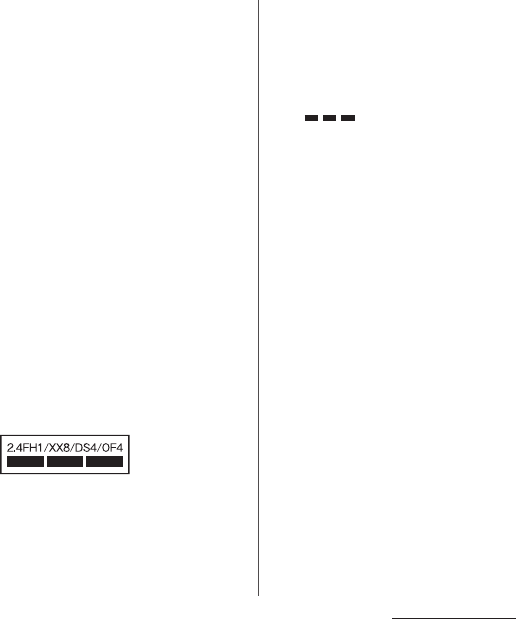
20
Contents/Precautions
・
Do not bend a docomo mini UIM card or
place a heavy object on it.
Doing so may cause malfunction.
・
Do not insert the docomo mini UIM card
on which any label or seal is stuck into
the terminal.
Doing so may cause malfunction.
■
Bluetooth function precautions
・
To secure the Bluetooth communication
security, the terminal supports the
security function compliant with
Bluetooth standards, but the security
may not be sufficient depending on the
setting. Concern about the
communication using the Bluetooth
function.
・
Please be aware that DOCOMO is not
responsible for data leak when making
data communications using Bluetooth.
・
Frequency band
The frequency band used by the terminal's
Bluetooth/wireless LAN function is written as
follows:
・
Bluetooth cautions
The operating frequency band of the terminal is
used by industrial, scientific, consumer and
medical equipment including microwave ovens,
premises radio stations for identifying mobile
units used in the manufacturing lines of plants
(radio stations requiring a license), specified low
power radio stations (radio stations requiring no
license) and amateur radio stations (hereinafter
referred to as "another station").
- Before using this equipment, confirm that
"another station" is not being operated nearby.
- In the event of the terminal causing harmful
radio wave interference with "another station",
promptly change the operating frequency or
stop radio wave emission by turning off the
power, etc.
- If you have further questions, contact "General
Inquiries" on the last page.
2.4 : This radio equipment uses the 2400 MHz
band.
FH/XX/DS/OF
:
Modulation scheme is the
FH-SS, other system, DS-SS,
or OFDM system.
1 : The estimated interference distance is 10
m or less.
4 : The estimated interference distance is 40
m or less.
8 : The estimated interference distance is 80
m or less.
: The full band between 2400 MHz
and 2483.5 MHz is used and the
band of the mobile identification
device can be avoided.
Available channels vary depending on the
country.
For use in an aircraft, contact the airline
beforehand.

21
Contents/Precautions
■
Wireless LAN (WLAN) precautions
・
Wireless LAN (WLAN) exchanges
information using radio waves, and
allows you to freely establish LAN
connection if you are within an area
where radio wave reaches. On the other
side, if you communicate without
appropriate security settings,
communications may be intercepted or
hacked by malicious parties. It is
recommended to make necessary
security settings on your responsibility
and expense.
・
Wireless LAN
Do not use wireless LAN near magnetic devices
such as electrical appliances or AV/OA devices, or
in radio waves.
- Magnetism or radio waves may increase noises
or disable communications (especially when
using a microwave oven).
- When used near TV, radio, etc., reception
interference may occur, or channels on the TV
screen may be disturbed.
- If there are multiple wireless LAN access points
nearby and the same channel is used, search
may not work correctly.
・
2.4GHz device cautions
The operating frequency band of the WLAN
device is used by industrial, scientific, consumer
and medical equipment including home electric
appliances such as microwave ovens, premises
radio stations for identifying mobile units used in
the manufacturing lines of plants (radio stations
requiring a license), specified low power radio
stations (radio stations requiring no license) and
amateur radio stations (radio stations requiring a
license).
- Before using the device, confirm that premises
radio stations for identifying mobile units,
specified low power radio stations and amateur
radio stations are not being operated nearby.
- If the device causes harmful radio interference
to premises radio stations for identifying
mobile units, immediately change the
frequency band or stop use, and contact
"General Inquiries" on the last page for crosstalk
avoidance, etc. (e.g. partition setup).
- If the device causes radio interference to
specified low power radio stations or amateur
radio stations, contact "General Inquiries" on
the last page.
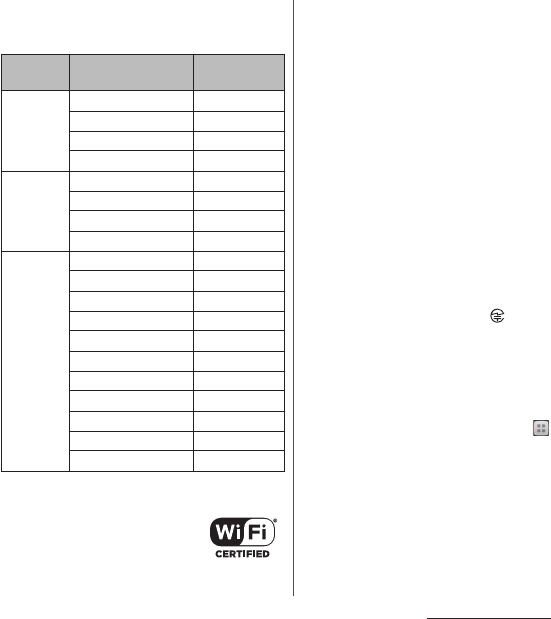
22
Contents/Precautions
・
5GHz device cautions
The following channel numbers and frequency
bands are available in Japan.
Using wireless LAN built-into the terminal in 5.2/
5.3 GHz outside is prohibited by the Radio Law.
■
FeliCa reader/writer function
precautions
・
FeliCa reader/writer function of the
terminal uses weak waves requiring no
licenses for radio stations.
・
It uses 13.56 MHz frequency band.
When using other reader/writers in your
surroundings, keep the terminal away
sufficiently from them. Before using the
FeliCa reader/writer, confirm that there
are no radio stations using the same
frequency band nearby.
■
Note
・
Do not use a remodeled terminal. Using
a remodeled terminal violates the Radio
Law/Telecommunications Business Act.
A "Technical Conformity Mark " shown on the
terminal certifies that the terminal meets
technical regulations for specified radio
equipment that are based on the Radio Law and
also certifies a technical standards conformity for
terminal equipment that are based on the
Telecommunications Business Act. To check the
certificate, from the Home screen, tap and
tap [Settings]
u
[About phone]
u
[Legal
information]
u
[Certificates].
If you remove the screws and alter the inside of
the terminal, the technical regulations
conformity certification becomes invalid.
Do not use the terminal with the certification
invalid, as it is a violation of the Radio Law and
Telecommunications Business Act.
Channel number (Ch) Frequency
band (MHz)
5.2GHz
band
36 5,180
40 5,200
44 5,220
48 5,240
5.3GHz
band
52 5,260
56 5,280
60 5,300
64 5,320
5.6GHz
band
100 5,500
104 5,520
108 5,540
112 5,560
116 5,580
120 5,600
124 5,620
128 5,640
132 5,660
136 5,680
140 5,700

23
Contents/Precautions
・
Be careful when using the terminal
while driving.
Using a handheld mobile phone while driving
will result in a penalty.
However, absolutely necessary cases such as
rescue of a sick person or maintaining public's
safety are exempted.
・
Use the FeliCa reader/writer function
only in Japan.
FeliCa reader/writer function of the terminal
conforms to Japanese radio standards. If you use
this function overseas, you may be punished.
・
Do not alter the basic software illegally.
It is regarded as the software modification and
Repairs may be refused.
SO-01F provides waterproofness property of
IPX5
*1
, IPX8
*2
and dustproofness property of
IP5X
*3
with microUSB jack cover, headset jack
cover and back cover firmly attached.
*1 IPX5 means that a phone keeps functioning
after applying a jet flow of 12.5 L/min. from
every direction from a distance of
approximately 3 m for at least 3 minutes
using water nozzle in 6.3 mm inner
diameter.
*2 IPX8 means that a phone keeps functioning
after SO-01F is slowly submerged to depth
of 1.5m in static tap water at room
temperature, left there for approximately 30
minutes and then taken out.
*3 IP5X means a degree of protection that a
communication device will securely
maintain its operability even after it has
been placed in an apparatus with grit and
dust of diameters of 75 μm or less and
shaken for 8 hours.
Waterproofness/
Dustproofness

24
Contents/Precautions
・
You can talk or watch 1Seg program without
an umbrella in the rain (for rainfall of 20 mm or
less per hour).
- Do not open or close microUSB jack cover,
headset jack cover or back cover when your
hands are wet or waterdrops are attached to
the terminal.
・
You can wash the terminal when it gets dirt or
stained with liquid other than tap water.
- Wash the terminal with tap water at normal
temperature (5
℃
-35
℃
) by weaker water
flow (less than 6 L/min.) at distance of
approximately 10 cm away from the tap or
shower.
- When washing the terminal, hold the
microUSB jack cover, headset jack cover and
back cover so as not to open, and wash the
terminal with your hands, not using brush or
sponge. After washing, drain the terminal
before use (P.27).
・
You can use at a poolside. Do not throw water
from the pool on the terminal, or soak it in
pool water.
To avoid water ingress, be sure to observe the
following points.
・
Do not throw any liquid other than room
temperature tap water on the terminal, or
soak it in such liquid.
・
Firmly close the microUSB jack cover, headset
jack cover and back cover. Even a fine obstacle
(one hair, one grain of sand, tiny fiber, etc.) put
between contact surfaces may allow water to
enter.
・
Do not poke the microphone, earpiece,
speaker, flash/photo light/second
microphone or strap hole with a sharp object.
・
Do not let the terminal fall. It may become
scratched causing the waterproof/dustproof
performance to degrade.
・
The rubber gaskets of the inner side of the
microUSB jack cover, headset jack cover and
back cover play important roles for keeping
waterproof/dustproof performance. Do not
remove or damage them. Also, prevent dust
from adhering to them.
What you can do with
waterproofness/dustproofness
of SO-01F
To ensure waterproofness/
dustproofness

25
Contents/Precautions
■
Opening the headset jack cover and
microUSB jack cover
Open the covers with your fingertip by the
grooves.
■
Closing the headset jack cover and
microUSB jack cover
Press the covers in the directions of the
arrows and ensure there are no gaps.
■
Removing back cover
1
Insert the tip of your finger into
the groove at the bottom of the
terminal, and lift up the back cover
in the direction of the arrow ( ).
■
Attaching back cover
1
Check the orientation of back
cover, and attach it to the terminal
by pressing the back cover as
shown by arrow ( ) then ( ) to
fit, and press the part firmly to
check that no gap exists between
the terminal and the back cover
().
・
Be careful not to hook the projection
part on the edge of the back cover with
finger when attaching the back cover.
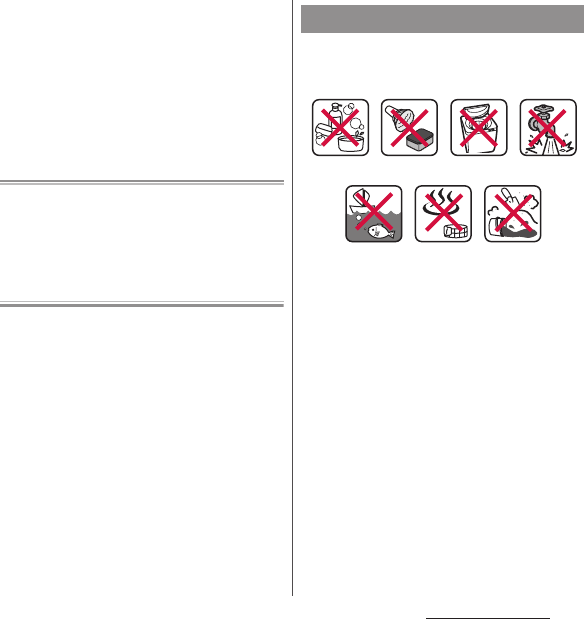
26
Contents/Precautions
It is recommended to replace the parts for
maintaining waterproof/dustproof property once
every two years regardless of whether any
abnormality is present. DOCOMO replaces the
parts as a chargeable service. Bring the terminal to
a sales outlet such as a DOCOMO-specified repair
office.
Do not perform actions shown in the
illustrations below.
Observe the following precautions to use the
terminal properly.
・
Accessories and optional devices are not
waterproof/dustproof.
・
Do not apply water flow stronger than
allowed (water flow of 6L/min. or more : e.g.,
such water flow that gives you pain when
applied to your skin directly from a faucet or
shower). SO-01F provides IPX5
waterproofness, but doing so may cause
malfunction.
・
If the terminal gets wet with salt water, sea
water, refreshing beverage or mud or sand
adhered, wash it immediately. If they dry out,
it is hard to remove the dirt and it may cause
damage or malfunction.
Important precautions
<Example>
Washing with
brush/sponge
Using Soap/Detergent/
Bath powder
Machine-
washing
Applying strong
water ow
Soaking in
ocean water
Using in hot
spring
Attaching
sand/mud

27
Contents/Precautions
・
Do not put the terminal in hot water, use it in
a sauna or apply hot airflow (from a hair dryer
etc.) to it.
・
Do not move the terminal in water or slam the
terminal against the surface of water.
・
If you put the terminal in tap water, be sure to
have it within 30 minutes.
・
When you use the terminal in swimming pool,
obey rules of the facility.
・
The terminal does not float on water.
・
Do not leave water on the terminal. In cold
region, the terminal freezes up and may cause
malfunction.
・
Do not leave water on the microphone,
earpiece, speaker, flash/photo light/second
microphone or strap hole. Such water may
interfere with talking.
・
If the terminal gets splashed with water or
other liquid while microUSB jack cover,
headset jack cover, or back cover is opened,
the liquid may get inside the terminal causing
electric shocks or malfunction. Stop using the
terminal, turn off the power and contact a
DOCOMO-specified repair office.
・
If some or one of the rubber gaskets of the
inner side of the microUSB jack cover, headset
jack cover or back cover are damaged or
deformed, have them replaced at DOCOMO-
specified repair office.
DOCOMO does not guarantee actual operations
under all states. Malfunctions deemed to be caused
by inappropriate operation by the customer are
not covered by the warranty.
When the terminal is wet, water may flow out
after wiping it off; drain the water in the
following steps.
a
Hold the terminal firmly and wipe off moisture on
the terminal surface and back side with dry, clean
cloth etc.
b
Shake the terminal approximately 20 times, firmly
holding it, until there is no more water splattering.
Draining water from the
terminal

28
Contents/Precautions
c
Swing the terminal in about 10 times against dry,
clean cloth etc. to wipe off water remaining in the
microphone, earpiece, speaker, power key, volume
key, camera key, contacts for the desktop holder,
each cover (microUSB jack cover/headset jack
cover/back cover), etc.
d
Wipe off water drained from the terminal with dry,
clean cloth etc., and dry naturally.
・
Wipe off water drained from the terminal with
dry, clean cloth etc., and dry naturally.
・
Do not wipe off water remaining in gaps directly
with a cotton swab etc.
・
Let the terminal, with the back cover of the
terminal facing up, dry naturally for about 3 hours
at room temperature.
Check the following before and after
charging.
・
Check if the terminal is not wet. Never charge
the battery when the terminal is wet.
・
Accessories and optional devices are not
waterproof/dustproof.
・
When charging the battery when or after the
terminal is wet, adequately drain it and wipe
off water with a dry, clean cloth etc., before
connecting the supplied desktop holder or
opening the microUSB jack cover.
・
When the microUSB jack cover is opened for
charging, close the cover firmly after charging.
It is recommended to use the desktop holder
for charging to prevent water or dust from
seeping inside through the microUSB jack.
・
Do not use the AC adapter or desktop holder
in a bathroom, shower room, kitchen, lavatory
or other highly humid area. Doing so may
cause fire or electric shock.
・
Do not touch the AC adapter or desktop
holder with wet hands. Doing so may cause
electric shock.
Charging
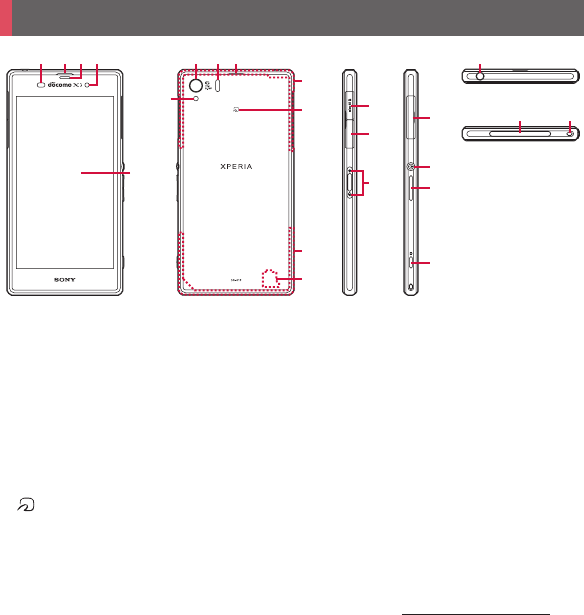
29
Before Using the Terminal
a
Proximity sensor : Turns on or off the touch screen
to prevent misoperation during a call.
b
Earpiece
c
Notification LED
d
Front camera lens
e
Touch screen
f
Camera lens
g
Infrared data port
h
Second microphone : Reduce noise to make easy to
listen.
i
Flash/Photo light
j
FOMA/Xi/GPS antenna section
*1
k
mark
l
FOMA/Xi antenna section
*1
m
Wi-Fi/Bluetooth antenna section
*1
n
microSD card slot
o
microUSB jack : Use for charging or connecting
MHL.
p
Contacts for Desktop holder.
q
docomo mini UIM card slot
r
Power key/Screen lock key
s
Volume key/Zoom key
t
Camera key
u
Headset jack
v
Microphone/Speaker
w
Strap hole
*1 The antenna is built into the main body. Covering
around the antenna with your hand may affect the
quality of communications.
❖
Note
・
Do not put stickers etc. on each sensors.
Part names and functions
i
m
l
j
k
u
wv
o
nq
t
r
s
p
a b c d
e
fg h

30
Before Using the Terminal
The docomo mini UIM card is an IC card
recorded user information such as your
phone number etc.
・
You can use the terminal with docomo mini
UIM card. If you have a UIM or FOMA card,
bring it to a docomo Shop to replace.
・
When docomo mini UIM card is not inserted
to the terminal, making calls, packet
communication, etc. are not available.
・
For details on docomo mini UIM card, refer to
the docomo mini UIM card manual.
・
When inserting/removing the docomo mini
UIM card, make sure to power off the terminal
(P.37). Do not attach an AC adapter.
・
For removing/attaching the back cover, see
"To ensure waterproofness/dustproofness"
(P.24, P.25).
■
Security codes of the docomo mini
UIM card
There is a security code called PIN code in
the docomo mini UIM card. The code is set
to "0000" at subscription, which you can
change by yourself (P.218).
❖
Information
・
Please be careful not to touch or scratch a metal part
(IC) when you handle the docomo mini UIM card.
Doing so may cause malfunction or damage.
1
Hook the groove on the bottom of
the terminal with your fingertip
and lift up the back cover to
remove.
2
Remove the battery pack and hook
the projection part of the tray ( )
with your fingertip to pull out
straight, insert docomo mini UIM
card into the tray with the metal
(IC) part facing down, then press
the tray straight to the end.
・
Be careful about the orientation of the
corner cut.
3
Install the battery pack and attach
the back cover, then make sure
that there are no gaps between the
terminal and the back cover.
docomo mini UIM card
Inserting docomo mini UIM
card
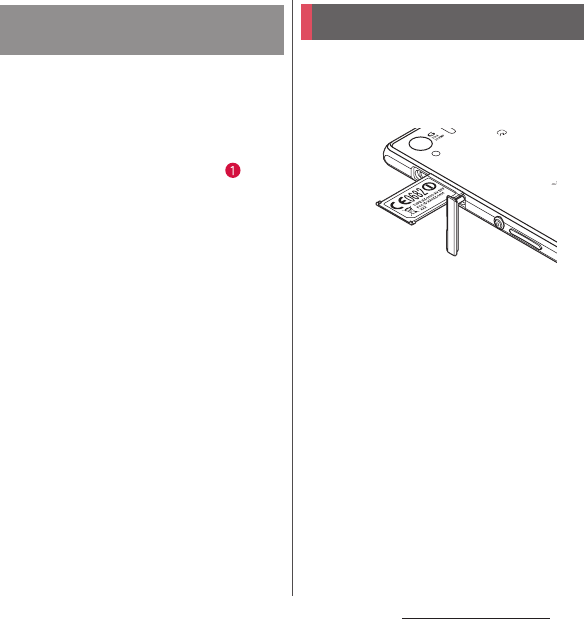
31
Before Using the Terminal
1
Hook the groove on the bottom of
the terminal with your fingertip
and lift up the back cover to
remove.
2
Remove the battery pack, hook the
projection part of the tray ( ) with
your fingertip, pull out the tray
straight and remove the docomo
mini UIM card.
3
Press the tray straight to the end,
install the battery pack and attach
the back cover, then make sure
that there are no gaps between the
terminal and the back cover.
1
Open the docomo mini UIM card
slot cover, and insert a fingernail
into the hook at the edge of the
label tray, then pull it out straight.
Removing docomo mini UIM
card
CE mark and FCC ID
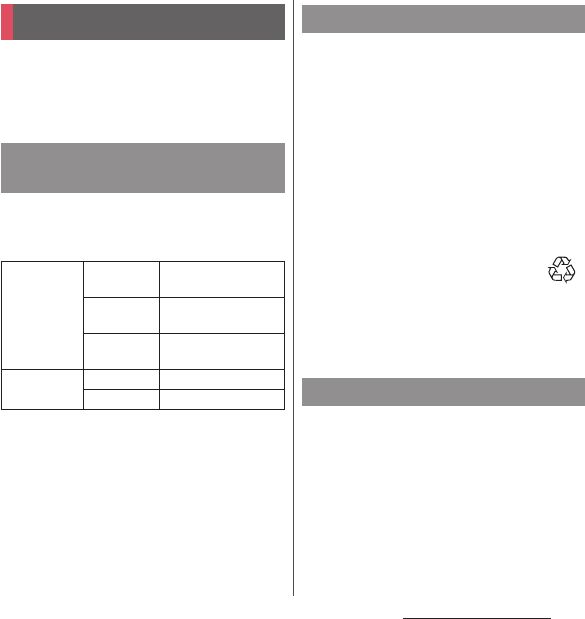
32
Before Using the Terminal
The battery pack is not fully charged by
default.
・
For details on estimate of charging time, see
"Main specification" (P.273).
The following time varies by the battery pack
condition or operating environment. For
details, see "Main specification" (P.275).
・
The battery pack is a consumable accessory.
The usage duration of the battery per one
charge decreases gradually each time the
battery is recharged.
・
When the usage duration per one charge
becomes about half of a new battery, the life
of the battery pack is assumed to be almost
over. The battery pack may swell out as it
comes to near the end of its lifetime
depending on the usage conditions, but it is
not a problem.
・
Watching 1Seg etc. for a long time while
charging may shorten the lifetime of the
battery pack.
・
Be sure to install Battery Pack SO09 dedicated
to SO-01F for charging.
・
It is recommended to use the AC Adapter 04
(optional) for charging. For details on AC
Adapter 04 (optional), see AC Adapter 04
(optional) manual.
Charging
Operation time on full charge
(estimate)
Continuous
stand-by time
FOMA/3G Approx. 420 hours
(stationary)
GSM Approx. 360 hours
(stationary)
LTE Approx. 390 hours
(stationary)
Continuous
call time
FOMA/3G Approx. 630 min.
GSM Approx. 570 min.
Life of battery pack
Charging
Li-ion 00

33
Before Using the Terminal
・
The AC Adapter 04 (optional) is compatible
with AC 100 V to 240 V. For using the terminal
overseas, a plug adapter that fits the electrical
outlets in the country you stay is needed. Do
not use an electrical transformer for overseas
use to charge the terminal.
・
Use a compatible AC adapter or microUSB
cable for charging (P.257). If you use a charger
other than the compatible one, charging may
not be available or operations may not be
performed correctly.
・
Insert and remove the AC adapter cable or
microUSB cable slowly and evenly so that
excessive force is not applied.
・
If remaining battery level is low for activating
the terminal when turning on the power, the
notification LED flashes in red three times by
pressing
P
.
・
When you start charging, notification LED on
the terminal turns red/orange/green, and
green light indicates that the battery level has
reached 90 % or more. To check the battery
level, see the status bar at the top of the
screen or from the Home screen, tap and
tap [Settings]
u
[About phone]
u
[Status] to
see "Battery level". When the battery level has
reached 100 %, battery level is displayed as
"100%" on the status bar or in "Battery level",
and "Charged." appears on the unlock screen
(P.37).
・
When the battery level is 19
%
or less,
"Connect your charger" appears on the
unlock screen. When the battery level is 14
%
or less, "Connect charger" appears in a pop-
up window. Tap [Battery info] in the pop-up
window to set Power Saver or check battery
information (P.210).
・
When you start charging with the terminal
powered off, the power turns on. However,
you cannot operate the terminal. Power off
the terminal in a place where the use is
prohibited such as in airplane or hospital for
this reason.
When using supplied Desktop Holder SO17
and AC Adapter 04 (optional) for charging, do
the following procedures.
1
Insert a microUSB plug of the AC
adapter into the charging jack on
the back side of the desktop
holder with the USB symbol (B)
side facing up ( ).
2
Unfold the power plug of the AC
adapter and insert it into an outlet.
Charging with Desktop Holder

34
Before Using the Terminal
3
Insert the terminal into the
desktop holder.
・
Notification LED lights on the terminal.
For the notification LED for charging,
see "Notification LED" (P.42).
4
When charging is complete,
holding the desktop holder, lift the
terminal up to remove.
5
Remove the power plug of the AC
adapter from the power outlet.
6
Remove the microUSB plug of the
AC adapter from the desktop
holder.
❖
Note
・
You cannot charge the battery by connecting the
desktop holder to a PC.
・
Check the connecting direction to connect correctly.
Wrong connection may cause damage.
When using AC Adapter 04 (optional) for
charging, do the following procedures.
・
For opening/closing microUSB jack cover, see
"To ensure waterproofness/dustproofness"
(P.24, P.25).
1
Hook the groove on the microUSB
jack cover of the terminal with
your fingertip to open the cover
and insert the microUSB plug of
the AC adapter into the microUSB
jack of the terminal straight with
the symbol side (B) facing up.
2
Unfold the power plug of the AC
adapter and insert it into an outlet.
・
Notification LED lights on the terminal.
For notification LED for charging, see
"Notification LED" (P.42).
3
When charging is complete,
remove the power plug of the AC
adapter from the power outlet.
4
Remove the microUSB plug of the
AC adapter evenly from the
terminal.
5
Close the microUSB jack cover,
firmly press it and make sure that
there are no gaps between the
terminal and cover.
Charging with AC adapter

35
Before Using the Terminal
❖
Note
・
Check the connecting direction to connect correctly.
Wrong connection may cause damage.
DC Adapter 03 (optional) supplies power
from a car cigarette lighter socket (12 V/24 V).
For details, refer to the DC Adapter 03
(optional) manual.
When using Micro USB Cable 01 (optional) for
charging, do the following procedures.
・
For opening/closing microUSB jack cover, see
"To ensure waterproofness/dustproofness"
(P.24, P.25).
1
Hook the groove on the microUSB
jack cover of the terminal to open
the cover and insert the microUSB
plug of the microUSB cable
straight into the microUSB jack of
the terminal, with the symbol side
() facing up.
2
Insert the USB plug of the
microUSB cable into a USB port of
a PC.
・
Notification LED lights on the terminal.
For the notification LED for charging,
see "Notification LED" (P.42).
・
When "PC Companion software" screen
appears on the terminal, tap [Skip].
・
When a screen for new hardware
detection etc. appears on the PC, select
"
キャンセル
(Cancel)".
3
When the charging is complete,
remove the USB plug of the
microUSB cable from the USB port
of the PC.
Charging with DC adapter
Charging with a PC

36
Before Using the Terminal
4
Remove the microUSB plug of the
microUSB cable evenly from the
terminal.
5
Close the microUSB jack cover,
firmly press it and make sure that
there are no gaps between the
terminal and cover.
❖
Note
・
Installation of an MTP driver to a PC is required when
charging the battery with a Microsoft Windows XP
PC, because "USB connection mode" (P.242) is set to
"Media transfer mode (MTP)" by default. Install
Windows Media Player 10 or later to install an MTP
driver.
・
Check the connecting direction to connect correctly.
Wrong connection may cause damage.
1
Press and hold
P
for over a
second.
・
The terminal vibrates and unlock screen
appears after a while.
2
Unlock the screen.
・
For unlocking the screen by default, see
"Unlocking the screen" (P.37).
❖
Information
・
For the first time you turn on the terminal, flick
(swipe) up/down the screen to unlock the screen
and make initial settings. For the initial settings, see
"Initial settings" (P.38).
Turning power on/off
Turning power on

37
Before Using the Terminal
・
If you have activated the screen lock (P.218) or SIM
card lock (P.217), unlock screen/PIN code entry
screen appears when turning power on. For
unlocking the screen lock, see "Unlocking the screen
lock" (P.219), and for PIN code entry, see "Entering the
PIN code when powered on" (P.217).
1
Press and hold
P
for over a
second.
2
Tap [Power off ].
3
Tap [OK].
❖
Information
・
Press
P
for over a second and then touch and hold
[Power off] and tap [OK] to restart the terminal in safe
mode. For safe mode, see "The terminal operation is
unstable." (P.259).
When the screen lock is set, the screen
backlight turns off. You can avoid the touch
screen or key from false operations.
・
The screen is locked with turning the screen
backlight off after the specified time duration.
1
Press
P
.
❖
Information
・
For setting time after the backlight turns off until the
screen lock activates, see "Adjusting the idle time
before the screen turns off" (P.208).
Unlock screen appears when turning the
power on or the backlight on by pressing
P
.
1
On the unlock screen, tap .
❖
Information
・
On the unlock screen, tap to activate the camera.
Tap to activate "
しゃべってコンシェル
(Shabette
concier)" or "Google" application.
・
For setting a method to cancel the screen lock, see
"Setting screen unlock method" (P.218), and for
changing the method, see "Changing screen unlock
method" (P.219).
・
The screen lock can be disabled. For details, see
"Canceling screen lock" (P.220).
・
When "Preferred applications" is set to "Xperia
™
applications", or "Set all to" or "Lock screen" is set to
"Xperia
™
" in Preferred apps settings, flick the screen
up or down (swipe) to cancel the screen lock. For the
initial settings, see "Initial settings" (P.38) and for
Preferred apps settings, see "Setting preferred apps"
(P.214).
Turning power off
Setting screen lock
Unlocking the screen
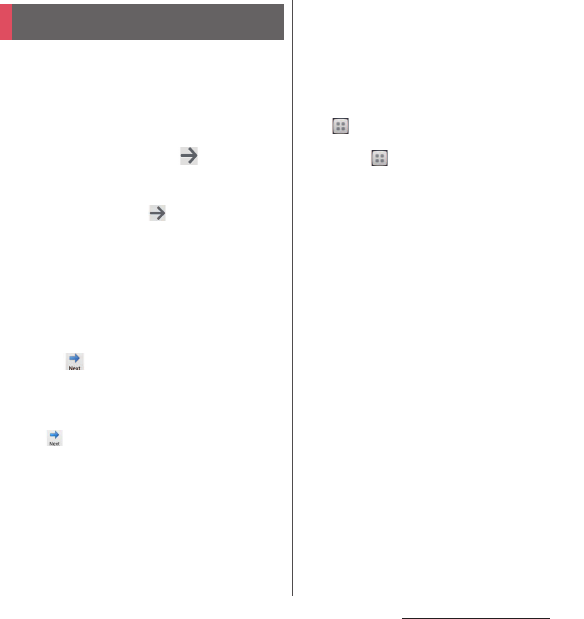
38
Before Using the Terminal
For the first time you turn on the terminal,
flick (swipe) up/down the screen to unlock
the screen and follow the onscreen
instructions to make initial settings.
1
Select [English (United States)]
u
Tap [Done], and tap .
・
After this step, follow the onscreen
instructions to make the following
settings, and tap or [Finish].
-Connect to a Wi-Fi network
- Connecting to Sony Entertainment
Network
- Set accounts and auto-sync
- Select preferred applications
2
Tap [OK].
3
Tap when initial setting screen
for docomo service appears.
・
After this step, follow the onscreen
instructions to set up below, and tap
.
- Select whether to install all apps now
or later
- Select whether to set Osaifu-Keitai
settings
- Set docomo apps password settings
- Set whether to respond when receive
a request of location search
4
Tap [OK].
・
Instruction guide for the Home screen
appears. Tap [Do not show this again]/
[OK] to display the Home screen.
❖
Information
・
To change the language later, from the Home screen,
tap , then tap [Settings]
u
[Language &
input]
u
[Language]. To set functions, from the Home
screen, tap , then tap [Settings]
u
[Setup guide]/
[docomo service].
・
Make sure that the data connection is available (LTE/
3G/GPRS) or Wi-Fi network is connected before
setting up online services. For checking the
connection status, see "Status icon" (P.43).
・
You can use the terminal without creating your
Google account, however the services such as
Google Talk, Gmail, Google Play, etc. are not available.
Initial settings
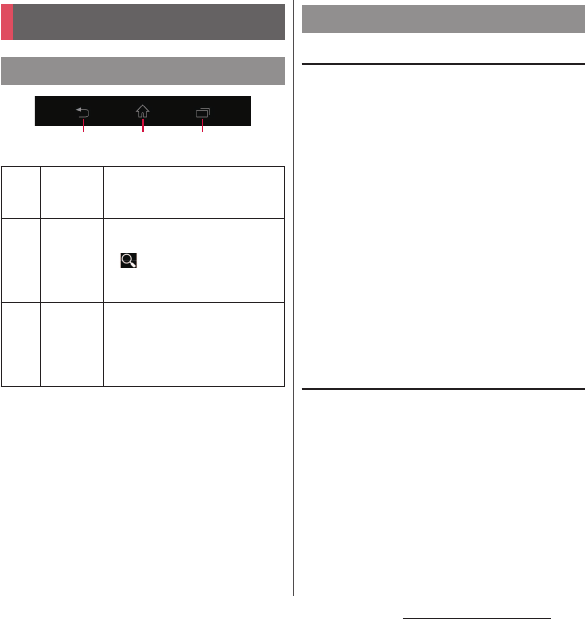
39
Before Using the Terminal
* In this manual, each key icon operation is described
with
x
,
y
,
r
.
Precautions on using touch screen
・
Touch screen is designed for being touched
lightly with fingers. Do not push it forcibly
with a finger or press it with sharp objects
(nail, ballpoint pen, pin, etc.).
・
Touching the touch screen may not work in
the following cases. Note that it may cause
malfunction.
- Operation with gloved hands
- Operation with tip of fingernail
- Operation with foreign object on the screen
- Operation with protective sheet or seal on
the screen
- Operation on the wet touch panel
- Operation with fingers wet with sweat or
water
Operations on the touch screen
■
Tap
Touch an item such as icon or menu with
your finger lightly and release it.
・
Double-tap means tapping twice quickly.
■
Touch and hold
Touch and hold an icon or menu item long.
■
Flick (Swipe)
Touch the screen and flick up/down/left/
right.
Basic operations
Basic key icon operation
x
Back Go back to the previous screen. Or
close a dialog box, an option
menu, the Notification panel, etc.
y
Home Go to the Home screen.
Touch and hold the icon and drag
to to activate "
しゃべってコン
シェル
(Shabette concier)" or
"Google" application.
r
Recently
used apps
Display recently used applications
in thumbnail list to activate or
delete an application from the list
(P.56). Also, use or set small apps
(P.56).
xx y
r
Using the touch screen
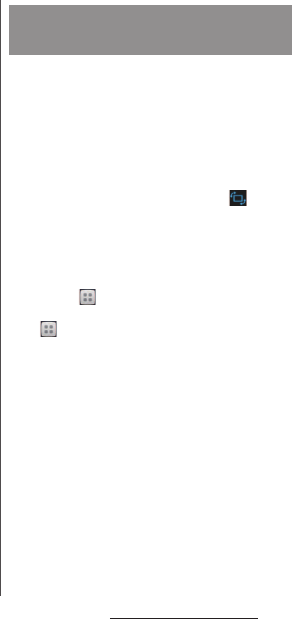
40
Before Using the Terminal
■
Drag
Touch the screen, drag to the desired
position and release the finger.
■
Scroll
When whole content cannot be displayed,
flick up/down/left/right displayed content
to scroll (move) the display position.
■
Pinch
Touch the screen with two fingers and
widen (pinch-out) or narrow (pinch-in) the
fingers' distance. On some screens, pinch-
out to zoom in and pinch-in to zoom out.
You can set the screen orientation to switch
between landscape and portrait view
automatically according to the terminal
orientation.
1
Drag the status bar downwards.
2
Tap [Auto rotate].
・
When the setting is enabled,
appears.
❖
Information
・
To switch the screen automatically between
landscape and portrait screen, from the Home
screen, tap , then tap [Settings]
u
[Display] and
mark "Auto-rotate screen", or from the Home screen,
tap , then tap [Settings]
u
[Accessibility] and mark
"Auto-rotate screen".
・
Even when you change the orientation of the
terminal, the screen may not change to landscape
view depending on the screen such as Home screen,
etc.
・
Changing orientation of the terminal in nearly
horizontal state against the ground does not switch
to portrait view/landscape view automatically.
Switching portrait or landscape
view automatically
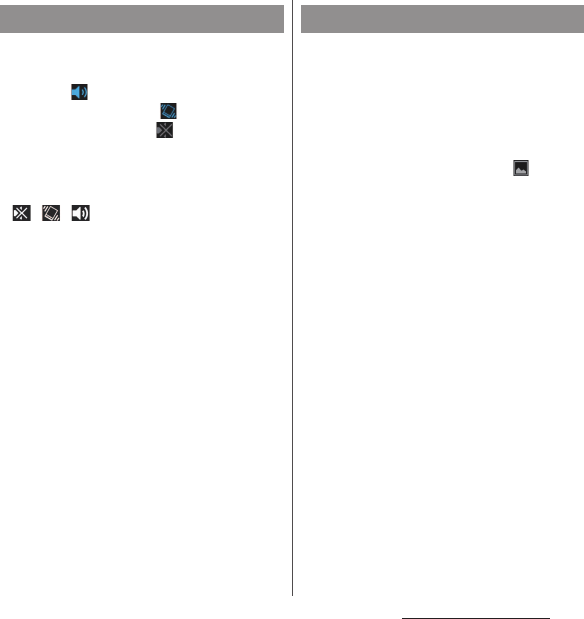
41
Before Using the Terminal
1
Drag the status bar downwards.
2
Tap [Sound].
・
Tap to activate silent mode
(vibration) and tap to activate silent
mode (mute). Tap to cancel silent
mode.
❖
Information
・
Press and hold
P
for over a second and then tap
/ / in the pop-up screen to switch Mute
(Ringtone 0)/Vibrate/Off (disabling silent mode).
・
From the Home screen etc., press and hold lower
part of
m
to set vibrator. While vibration is on,
press
m
to set to Mute (Ringtone 0). On the
unlock screen, during a call, or while the camera,
WALKMAN, Media Player, etc. is activated, pressing
and holding lower part of
m
does not set silent
mode.
・
Setting the terminal to silent mode does not mute
sounds for shutter, playback of video or music, alarm,
dialpad operation sound during a call or when [End
call] is tapped, etc. Note that adjusting volume in
Volumes ("Ringtone & notifications" (P.205)) or
turning the volume up by pressing upper part of
m
cancels silent mode.
You can save the current displayed screen as
an image (screenshot).
1
On the screen you want to capture,
press and hold
P
and lower part
of
m
for over a second at the
same time.
・
Screenshot is captured and appears
in the status bar.
❖
Information
・
You can also capture a screenshot by pressing and
holding
P
for over a second and then tapping
[Take screenshot].
・
Drag the status bar downwards and tap [Screenshot
captured.] on the Notification panel to check
captured images in the "Album" application. Tap
[Share] to attach captured images to an application
to send or to share them. "Share" may not appear
depending on notification status on the Notification
panel, but it appears when pinching out on the
Notification panel.
Setting silent mode Capturing screenshot
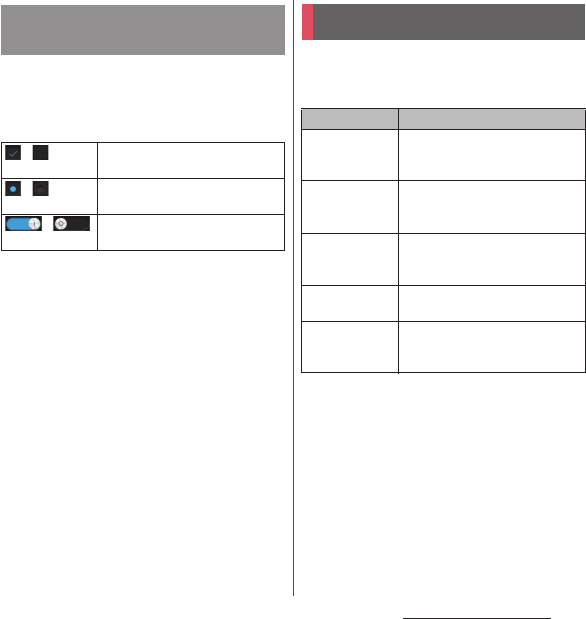
42
Before Using the Terminal
When a checkbox/radio button is displayed
besides a setting item, mark or unmark a
checkbox/radio button to switch on/off for
the setting.
Notification LED provides information on the
terminal status, incoming calls, mail
reception, etc.
* The notification LED flashes when the unlock screen
is displayed, backlight is turned off or unlock
preference is set to None.
❖
Information
・
If remaining battery level is low for activating the
terminal when turning on the power, the notification
LED flashes in red three times by pressing
P
.
・
When charging starts with the power off, notification
LED lights red and when the battery level is displayed
on the screen, notification LED lights in the color
corresponding to the battery level.
Marking/Unmarking to switch
setting
/ Switch on/off the setting for a
checkbox.
/ Switch on/off the setting for a radio
button.
/ Tap or drag left or right to switch
on/off the setting.
Notification LED
Status Indication
Red
Indicate that the battery level is
14% or less while the battery is
being charged
Orange
Indicate that the battery level is
15% - 89% while the battery is
being charged
Green
Indicate that the battery level is
90% or more while the battery is
being charged
Flashing red
The remaining battery level is 14%
or less
Flashing pale
purple
Indicate missed call, new messages
(SMS), new Gmail or new email
exist
*
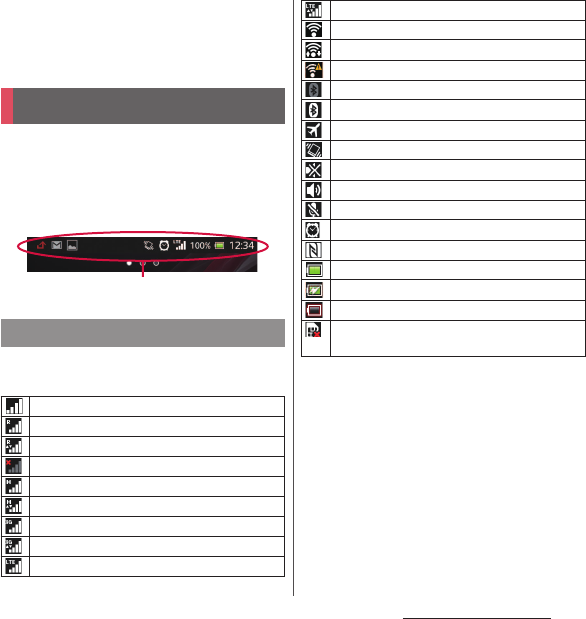
43
Before Using the Terminal
・
While using "Album" application or "WALKMAN"
application, the notification LED lights according to
the content. While receiving a call, it blinks according
to the color of "Themes" (P.207) in Display settings.
A status bar appears at the top of the screen.
In the status bar, the terminal status and
notification are displayed. Notification icons
appear on the left side, and status icons
appear on the right side of the status bar.
The main status icons displayed on the status
bar are as follows.
* Appears when switched to the Home screen etc.
Status bar
Status icon
Signal strength
International roaming available
International roaming connected
Out of service
HSDPA available
Communicating in HSDPA
3G (packet) available
Communicating in 3G (packet)
LTE available
Status bar
Communicating in LTE
Connecting to Wi-Fi
Communicating in Wi-Fi
Connecting to Wi-Fi using Auto IP function
Bluetooth function ON
Connecting to Bluetooth device
Airplane mode activated
Silent mode (vibration) ON
Silent mode (mute) ON
Speaker phone turned on
*
Microphone set to mute
*
Alarm is set
NFC Reader/Writer, P2P function ON
Battery status
The battery is charging
Battery is low (4
%
or less)
PUK code locked or docomo mini UIM card not
inserted
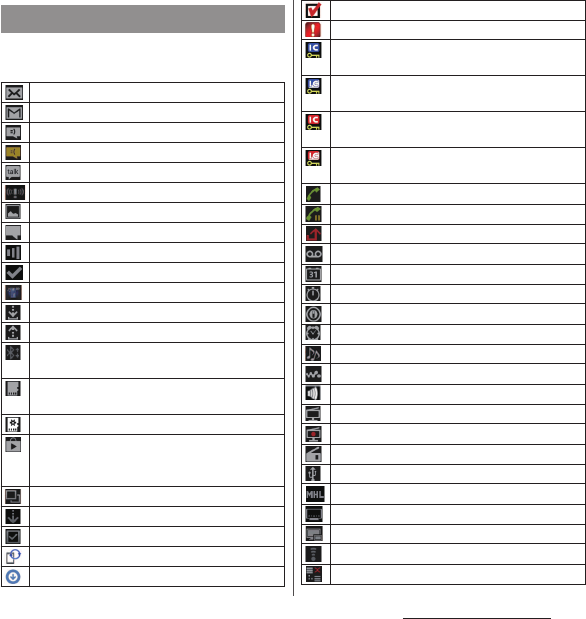
44
Before Using the Terminal
The main notification icons displayed on the
status bar are as follows.
Notification icon
New email message
New Gmail message
New message (SMS)
Problem with message (SMS) delivery
New instant message
New Area Mail
Screenshot captured
New Facebook message
Uploading data to Facebook
Uploading data to Facebook completed
Facebook setting request notification
Receiving/Downloading data
Sending/Uploading data
Notification of data reception etc. via Bluetooth
communication
Unmount microSD card (reading/writing
unavailable)
Preparing microSD card
Update notification/Installation complete
(available update application exist in Google
Play/application installation is complete)
Application update notification
Downloading application update and installing
Installation of application update completed
Software update notification
Downloading software update completed
Installation of software update completed
Software update interrupted, stopped
NFC/Osaifu-Keitai lock set to the terminal and
docomo mini UIM card
NFC/Osaifu-Keitai lock set to the terminal or
docomo mini UIM card
Omakase Lock set to the terminal and docomo
mini UIM card
Omakase Lock set to the terminal or docomo
mini UIM card
Receiving/Making a call
*
, during a call
*
Call on hold
*
Missed call
New voice mail
Upcoming calendar event
Stopwatch is running
Timer in use
Alarm sounding
Playing a track with Media Player
Playing a track with WALKMAN
Receiving Mobacas
Watching 1Seg
*
Recording 1Seg
*
FM radio in use
*
USB connected
MHL connected
Available to activate TV launcher
Screen mirroring connected
Communicating via Infrared
Mobile data communication invalid
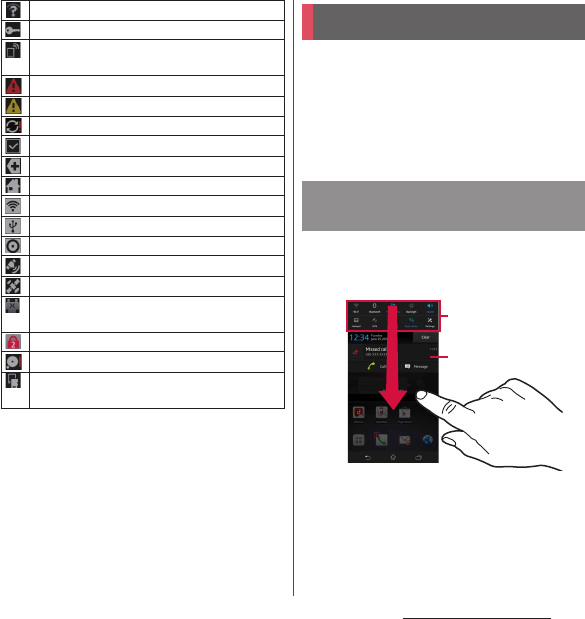
45
Before Using the Terminal
*
Appears when switched to the Home screen etc.
When notification icons appear on the status
bar, you can open the Notification panel to
check the notifications, activate
corresponding application, etc. You can open
the Notification panel to set silent mode,
enable/disable Wi-Fi function, etc.
1
Drag the status bar downwards.
・
Tap
x
to close the Notification
panel.
❖
Information
・
When screen unlock method (P.218) is set to "Swipe/
Touch", you can open the Notification panel without
canceling screen lock by dragging the status bar
downwards.
Wi-Fi open network available
Connecting to a VPN
The terminal set as media server/Connection
request notification received
Error message
Warning message
Problem with sync
Setup guide unchecked
Some notifications are hidden
Notification such as personal area received
Wi-Fi tethering ON
Setting USB tethering
Setting Wi-Fi tethering and USB tethering
Positioning with GPS
AUTO-GPS is set
Green Heart energy saving icon (remove the AC
adapter from the power outlet)
Setting Omakase Lock
Available memory on the terminal is low
Notification of data transfer to microSD card
exists (available internal storage decrease)
Notification panel
Opening/Closing the
Notification panel
Quick settings
Notication panel
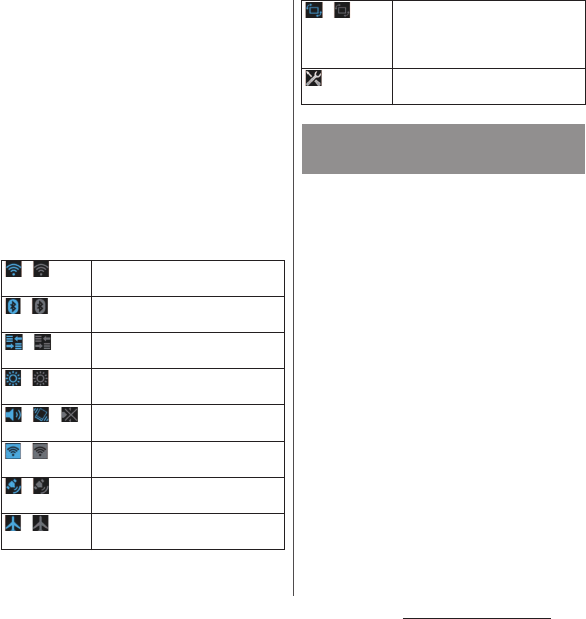
46
Before Using the Terminal
・
On the Notification panel, number of unread mails,
missed calls, and name of callers can be checked.
Depending on the notification status and application
on the Notification panel, sender, subject, part of
message of unread mail can be checked.
・
You can zoom in/out the Notification panel for some
notifications by pinching (P.40) on the Notification
panel.
・
Touch and hold a notification on the Notification
panel, then tap [App info] to check the application
information.
・
You can open the Notification panel to set ON/OFF
etc. of function with the quick setting tool. For
changing order or number of the quick setting tool
displayed in the Notification panel, see "Editing quick
settings on the Notification panel" (P.208).
1
Open the Notification panel and
tap [Clear].
❖
Information
・
Flick left or right a notification on the Notification
panel to delete from the list.
・
Some notifications may not be cleared.
/
Wi-Fi
Enable/disable Wi-Fi function.
/
Bluetooth
Enable/disable Bluetooth function.
/
Mobile data
Enable/disable mobile data
communication.
/
Backlight
Switch screen brightness.
/ /
Sound
Enable/disable silent mode
(Vibration/mute).
/
Hotspot
Enable/disable Wi-Fi tethering
function.
/
GPS
Enable/disable GPS function.
/
Airplane
Enable/disable Airplane mode.
/
Auto-rotate
Set whether to switch portrait/
landscape view automatically
according to the terminal
orientation.
Settings
Display Settings menu (P.193).
Clearing contents on the
Notification panel
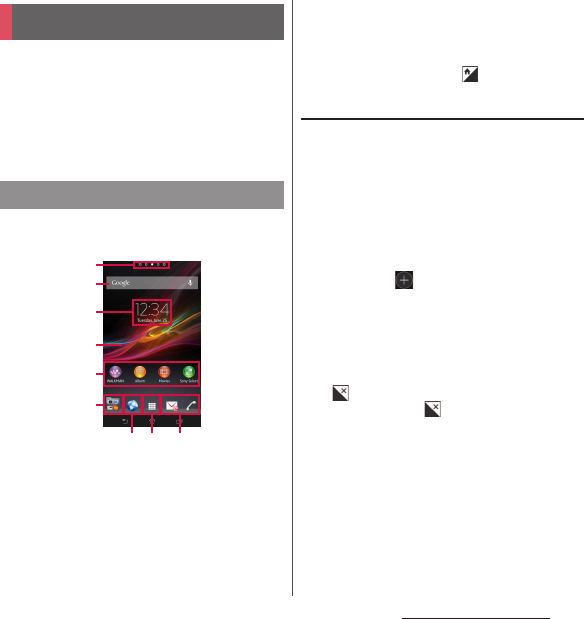
47
Before Using the Terminal
You can switch the Home screen of the
terminal to "docomo" or "Xperia
™
".
・
For "docomo" home screen, see "Home
screen" (P.84).
・
For changing home application, see
"Switching Home application" (P.57).
It appears when the home application is set
to "Xperia
™
".
a
Current home screen position
・
Flick the home screen left or right to switch.
b
Widget : Google Search
c
Widget : Clock
d
Wallpaper
e
Shortcuts (applications)
f
Media folder (Camera, 1Seg, FM radio, Osaifu-Keitai)
g
Application button
❖
Information
・
To change the initial home screen for operations,
switch the home screen you want to change to,
touch and hold the area of the screen where no
icons are displayed, then tap .
Adding a home screen
Up to 7 home screens can be displayed.
1
Touch and hold an area of the
Home screen where no icons are
displayed.
・
Alternatively, pinch-in on the Home
screen.
2
Flick the Home screen left or right
and tap .
❖
Information
・
To return to the Home screen, tap
y
or
x
, or
tap any home screen.
・
To delete a home screen, touch and hold an area of
the Home screen where no icons are displayed and
tap . When you added shortcuts, widgets, etc. to
the home screen, tap and tap [Delete].
Home screen
Xperia
™
home screen
a
b
c
e
f
e g e
d

48
Before Using the Terminal
Adding a widget to the Home screen
Widget is an application which can be added
to the Home screen to use. Use a widget and
start an application easily.
1
Touch and hold an area of the
Home screen where no icons are
displayed.
・
Alternatively, pinch-in on the Home
screen.
2
Tap [WIDGETS] and select a widget
to add.
・
When a settings screen appears, follow
the onscreen instructions.
❖
Information
・
To return to the Home screen, tap
y
or
x
, or
tap any home screen.
・
For some widgets, displaying size can be changed. To
change displaying size, touch and hold a widget,
then drag the blue frame.
・
To delete a widget, from the Home screen, touch and
hold a widget to delete and drag it to displayed
at the bottom of the screen.
Adding a shortcut to the Home
screen
You can add shortcuts of application,
bookmark, etc.
1
Touch and hold an area of the
Home screen where no icons are
displayed.
・
Alternatively, pinch-in on the Home
screen.
2
Tap [APPS].
3
[Shortcuts] or select an application
you want to add.
・
When you select "Shortcuts", select
from the stored shortcuts.
・
When a data selection screen or setting
screen appears, follow the onscreen
instructions.
❖
Information
・
To return to the Home screen, tap
y
or
x
, or
tap any home screen.
・
To delete a shortcut, touch and hold a shortcut to
delete on the Home screen, drag it to displayed at
the bottom of the screen.
Adding a folder to the Home screen
You can put applications, shortcuts, etc.
added to the Home screen into a folder to
manage them.
1
From the Home screen, touch and
hold an icon, then drag it over the
other icon.
・
A new folder creation screen appears.
2
Enter a folder name, then tap
[Done].

49
Before Using the Terminal
❖
Information
・
To move an icon to a folder, on the Home screen,
touch and hold an icon you want to move, drag it
over a folder.
・
To change a folder name, tap a folder, tap the folder
name and enter a folder name, then tap [Done].
・
To delete a folder, on the Home screen, touch and
hold an icon to delete and drag it to displayed at
the bottom of the screen, then tap [Delete].
Applications, shortcuts, etc. in the folder are also
deleted.
Changing wallpaper
You can change wallpaper of the Home
screen.
1
Touch and hold an area of the
Home screen where no icons are
displayed.
・
Alternatively, pinch-in on the Home
screen.
2
Tap [WALLPAPERS].
3
Tap [Album]/[Live Wallpapers].
・
When you tap [Album], select an image
and set range of the image by dragging
or pinching to adjust the cropping
frame, and then tap [Crop] to set
wallpaper.
・
When you tap [Live Wallpapers], select
a content and tap [Set wallpaper].
・
Images displayed at the right of
"Album" or "Live Wallpapers" are
wallpapers of Xperia
™
. Select an image
to set.
❖
Information
・
To return to the Home screen, tap
y
or
x
, or
tap any home screen.
Changing theme
You can change image theme for the Home
screen, unlock screen, etc.
1
Touch and hold an area of the
Home screen where no icons are
displayed.
・
Alternatively, pinch-in on the Home
screen.
2
Tap [THEMES].
3
Flick it left or right to select any
image.
❖
Information
・
To return to the Home screen, tap
y
or
x
, or
tap any home screen.
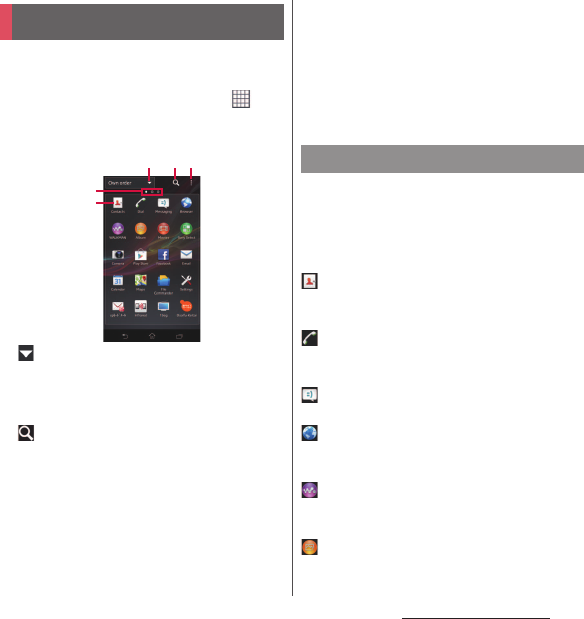
50
Before Using the Terminal
Application screen when the Home screen
(P.47) is set to "Xperia
™
" is explained here.
1
From the Home screen, tap
(Application button).
・
The Application screen appears.
a
(Sort)
・
To sort application icons displayed in the
Application screen, set "Own order" and touch
and hold an application icon, then drag it to any
position.
b
(Search)
・
Search for an application in the terminal.
c
Optional menu icon
・
"Uninstall" (P.54), "Share" (P.55) or "Customize" can
be operated. To customize the Home screen such
as changing the wallpaper, tap [Customize].
d
Current displayed position of the application screen
・
Flick the Application screen left or right to switch.
e
Application icon
・
Some application icons are displayed with a
number of missed calls, unread mails, etc.
❖
Information
・
To add an application screen, while sorting
application icons, drag to the right-end of the
application screen.
Applications displayed on the Application
screen are as follows.
・
For usage of some applications, separate
subscription (Charged) is required.
Contacts
Activate Xperia
™
phonebook application to
manage contacts of your friends or colleagues.
Dial
Activate Xperia
™
phone application to make/
receive calls, and switch between calls.
Messaging
Send and receive messages (SMS).
→
P. 1 1 3
Browser
Browse website and WAP sites (except for
WML) and download files.
→
P. 1 2 6
WALKMAN
Playback music data stored on the internal
storage or microSD card.
Album
View photos and videos you took, and images
posted on Picasa or Facebook.
→
P.173
Application screen
d
e
abc
Application list
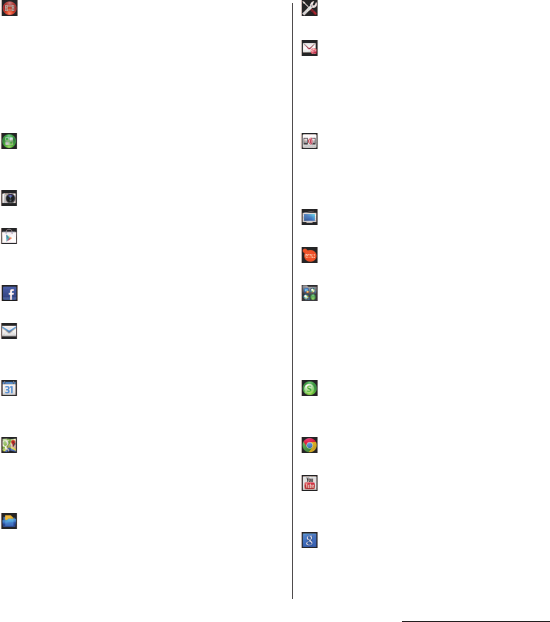
51
Before Using the Terminal
Movies
Play downloaded contents with Video
Unlimited or videos that are transferred from a
PC to the terminal. On the terminal, you can
play videos of a DLNA device or programs that
are recorded with a Blu-ray Disc recorder after
transferring to the terminal by TV transfer.
Sony Select
Connect Sony Select to obtain applications,
games, etc.
Camera
Take photos and record video clips.
→
P. 1 5 1
Play Store
Access to the Google Play, download and buy
new applications.
→
P. 1 3 2
Facebook
Activate Facebook client application.
→
P.223
Email
Send and receive emails (multiple accounts are
available).
→
P. 1 1 7
Calendar
Display a calendar and manage schedule.
→
P. 1 8 5
Maps
Use Google map services, such as viewing
current location, finding another location and
calculating routes.
→
P. 1 8 2
File Commander
You can easily find still pictures, videos, music
data, downloaded files, etc.
Settings
Make the terminal settings.
→
P. 1 9 3
sp
モードメール
(sp-mode mail)
Send/receive mails using DOCOMO mail
address
(@docomo.ne.jp)
. You can use pictogram
and Deco-mail. It supports auto-reception.
→
P. 1 1 3
Infrared
An application which allows you to send and
receive phonebook data etc. via infrared
communication.
→
P. 2 3 2
1Seg
Watch 1Seg program.
→
P.143
Osaifu-Keitai
Use Osaifu-Keitai.
→
P. 1 3 3
Sony Entertainment folder
In the folder, "Let
'
s start PSM", "Music
Unlimited", "Video Unlimited", "
電子書籍
Reader
by Sony (e-Book Reader by Sony)" and
"PlayMemories Online" applications are stored.
Socialife
View/manage SNS such as Facebook, Twitter or
favorite news websites etc. collectively.
→
P. 1 7 9
Chrome
Connect to the Internet with Google Chrome.
YouTube
Playback videos around the world or upload
recorded videos.
→
P.176
Google
Search information in the terminal and web
pages by keywords.
→
P. 5 7
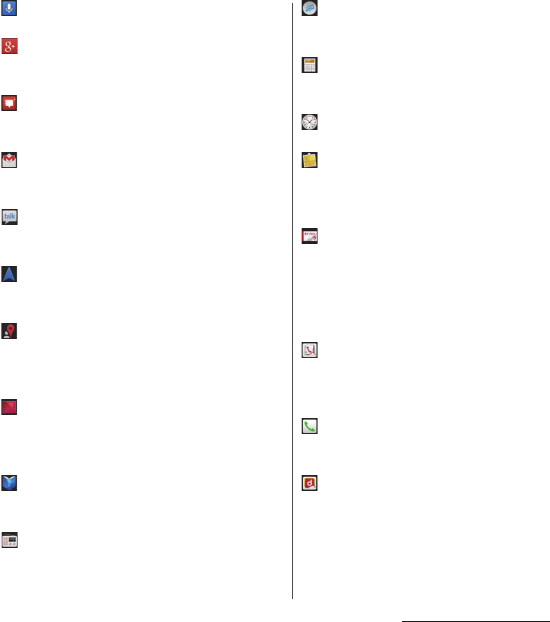
52
Before Using the Terminal
Voice Search
Use Google Voice Search.
Google+
Activate SNS client application Google+
provided by Google.
Messenger
Chat with friends using Google+ instant
messaging.
Gmail
Send and receive mails from/to a Google
account.
→
P.123
Talk
Chat with friends using Google Talk instant
messaging.
→
P. 1 2 4
Navigation
Display Google Maps Navigation to receive
detailed guides for your destination.
→
P. 1 8 4
Local
Use various information registered on Google
Maps, such as shops around the current
location.
→
P.183
Play Movies & TV
An application for accessing movie rental
service of Google Play. Select a movie you want
to watch and rent it.
Play Books
Download new books, bestsellers, etc. from
Google Play Books to read.
FM radio
Use FM radio.
→
P.150
TrackID
™
Use a service that checks the information of
playing music.
Calculator
Perform basic calculations such as addition,
subtraction, multiplication, and division.
Alarm & clock
Set alarm and view clock.
→
P. 1 8 7
Notes
Create notes or voice notes, and send them to
another terminal to share information. Also,
synchronize with Evernote.
Instruction Manual
Display the terminal instruction manual. You
can directly start a function you want to use
from the explanation (in Japanese only).
* See "About manuals of SO-01F" in
"Introduction".
docomo phonebook
Activate DOCOMO phonebook application to
manage contacts of your friends or colleagues.
→
P. 1 0 3
Phone
Activate DOCOMO phone application to make/
receive calls, and switch between calls.
→
P. 9 5
dmenu
A shortcut application for "dmenu" to find
contents that you used in i-mode and joyful
and convenient contents for smartphones
readily.
→
P.131
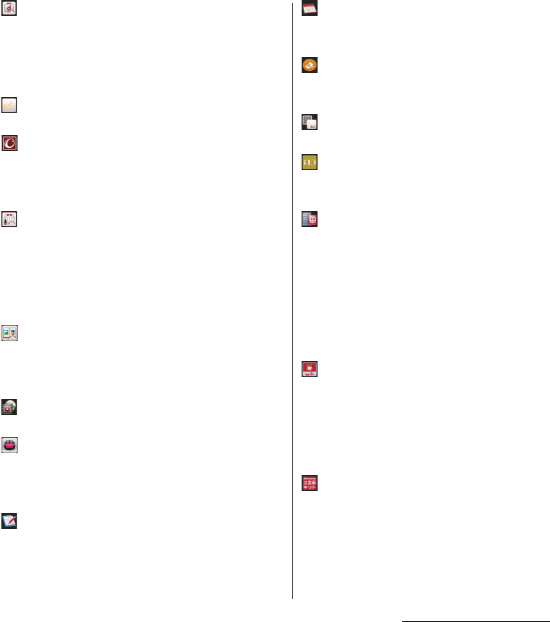
53
Before Using the Terminal
dmarket
An application for activating dmarket. In
dmarket, you can buy contents such as music,
videos or books. Also, applications on Google
Play are introduced.
→
P.131
iチャネル
(i-channel)
An application for using i-channel.
iコンシェル
(i-concier)
An application for using i-concier. i-concier is a
service in which a mobile phone supports your
life like a "butler" or "concierge".
しゃべってコンシェル
(Shabette concier)
Speak "what you want to search" or "what you
want to do" to the terminal. It understands your
intention and display the best solution on the
display from the services or functions of the
terminal (in Japanese only).
フォトコレクション
(Photo collection)
Free storage service of photos/videos. They can
be automatically categorized by recognized
faces or scenes on the cloud.
Media Player
Play music and videos.
→
P.177
NOTTV
Watch Mobacas program. Enjoy programs/
contents of broadcasting stations such as
"NOTTV" etc.
→
P.138
Memo
Create/manage memos. It supports i-concier
service.
Schedule
Create/manage schedule. It supports i-concier
service.
ToruCa
Acquire, display, search, or refresh ToruCa.
→
P. 1 3 7
IC Tag/Barcode Reader
Read IC Tag and barcode.
iD
アプリ
(iD application)
Make settings etc. for use of electronic money,
iD.
→
P. 1 3 7
ドコモバックアップ
(docomo backup)
An application for using "
ケータイデータお預か
りサービス
(Data Security Service)", "
電話帳バッ
クアップ
(Phonebook backup)" or "SD
カード
バックアップ
(SD card backup)". Back up or
restore phonebook data etc. For information on
docomo backup (save to microSD card), see "
ド
コモバックアップ
(docomo backup)" (P.190).
docomo Wi-Fi Easy Connection
An application for simply using "docomo Wi-Fi"
public wireless LAN service by DOCOMO or
home Wi-Fi. Using the widget, you can
connect/disconnect to Wi-Fi with a one-touch
operation in a Wi-Fi area.
Disaster kit
An application which helps you to check
received Early Warning "Area Mail", make
settings (P.125), and record and check
messages on the docomo Disaster Message
Board.
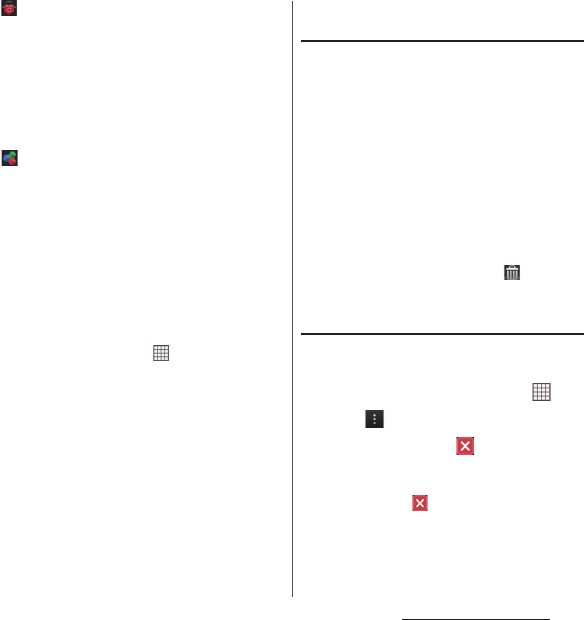
54
Before Using the Terminal
遠隔サポート
(Remote support)
An application for using "
スマートフォンあんし
ん遠隔サポート
(Smartphone Anshin Remote
Support)". With "
スマートフォンあんしん遠隔サ
ポート
(Smartphone Anshin Remote Support)",
call center staff can provide operational
support while checking your terminal screen
remotely.
OfficeSuite
View and read Office documents.
→
P. 1 9 2
❖
Information
・
The applications displayed on this application screen
are pre-installed by default. Some pre-installed
applications can be uninstalled. Even if uninstalled,
some applications can be downloaded from "Play
Store" (P.132) etc. again.
・
Some application names may not be displayed fully.
・
Some applications require downloading and
installation. If you cannot download application,
from the Home screen, tap and tap
[Settings]
u
[Security]
u
[Unknown sources]
u
[OK],
mark the checkbox and then tap the application.
・
Activating two or more applications may increase
battery consumption and the operation time may
become short. For this reason, it is recommended to
end applications when not used. To end an
application, on the application screen you are using,
tap
x
to display the Home screen, or tap
r
and then [Close all].
・
If you selected Japanese as a language in Initial
settings (P.38), some group names are displayed in
Japanese even after the language setting is changed.
These group names can be changed to English (P.92).
Adding an application to the Home
screen
1
From the Application screen, touch
and hold an icon you want to add
to the Home screen.
2
Drag it to "Add to Home screen"
displayed at the top of the screen.
・
A Home screen appears.
3
Drag it to a position to locate the
shortcut.
❖
Information
・
To delete a shortcut, touch and hold a shortcut to
delete on the Home screen, drag it to displayed at
the bottom of the screen.
Uninstalling an application
・
Before uninstalling an application, see
"Uninstalling an application" (P.91).
1
From the Home screen, tap .
2
Tap and tap [Uninstall].
3
Tap an icon with .
・
A confirmation screen appears for
uninstall.
・
Icons with can be deleted.
4
Tap [Uninstall].
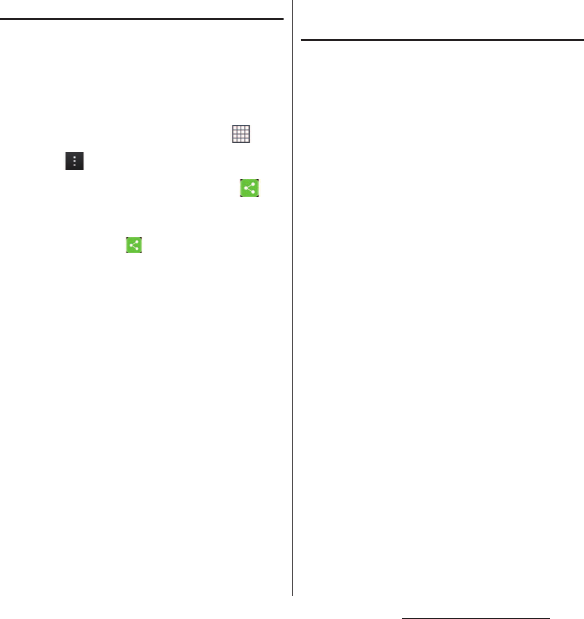
55
Before Using the Terminal
Sharing application
Introduce an application with simple
operation. Send/post an application
downloading information (URL) without
entering manually.
・
Some applications cannot be shared.
1
From the Home screen, tap .
2
Tap and [Share].
3
Tap an application icon with .
・
A selection screen for sharing method
appears.
・
An icon with can be shared.
4
Selecting sharing method.
・
Follow the onscreen instructions.
Adding a folder to the Application
screen
You can enter application icons displayed on
the Application screen to a folder to manage
them.
1
On the Application screen, touch
and hold an application icon, then
drag it over the other icon.
・
A new folder creating screen appears.
2
Enter a folder name, then tap
[Done].
❖
Information
・
To move an application icon to a folder, on the
Application screen, touch and hold an icon you want
to move, then drag it over a folder.
・
To take out an application icon in a folder from the
folder, tap the folder, touch and hold the application
icon, then drag it to a place somewhere you want to
locate.
・
To change a folder name, tap a folder, tap the folder
name, enter a folder name, then tap [Done].
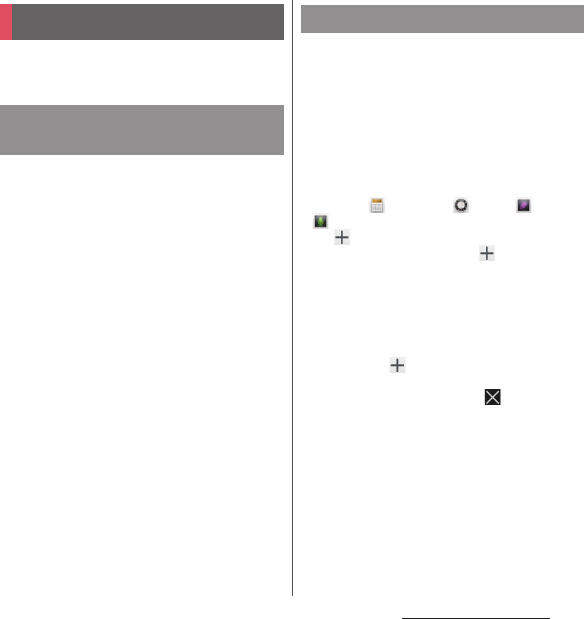
56
Before Using the Terminal
You can check the recently-used application
and end it.
Display recently used applications in
thumbnail list and activate.
1
Tap
r
.
・
Thumbnails of recently used
applications are listed.
❖
Information
・
Tap a thumbnail of application to activate.
・
Flick left or right a thumbnail of application displayed
to delete from the list.
Alternatively, touch and hold a thumbnail of
application and tap [Delete from list] to delete from
the thumbnail list.
・
To end all applications and delete all thumbnail lists,
tap [Close all] displayed at the upper left of the
screen.
・
To check application information, touch and hold a
thumbnail of application and tap [App info].
You can use a small app while using another
application.
1
Tap
r
.
・
The set small apps appear.
2
Select a small app to use.
・
The small app activates.
❖
Information
・
By default, (Calculator), (Timer), (Note),
(Recorder) are set.
・
Tap and [Play Store] to install a new small app
from Play Store and set it. When is not displayed
in the list, flick the small app displayed area left or
right.
・
To delete a set small app, touch and hold a small app
you want to delete and then drag it out of the small
app display area, then tap [Delete] when a deletion
confirmation screen appears. To set deleted small
app again, tap and [Installed small apps], then
select a small app you want to set.
・
To close a running small app, tap .
Task manager
Opening recently-used
application window
Small apps
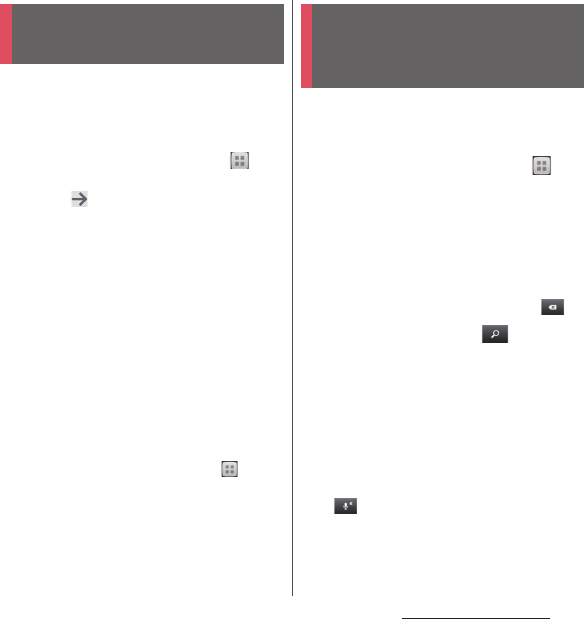
57
Before Using the Terminal
In the terminal, you can switch the Home
screen between "docomo" or "Xperia
™
".
"docomo" is set to the home application by
default.
1
From the Home screen, tap and
tap [Settings]
u
[Setup guide].
・
Tap 4 times.
2
On the Preferred applications
screen, tap [Change now].
3
Tap [Home screen]/[Set all to].
・
When "ALL" is selected, you can set
home application, unlock screen,
phonebook application and application
for playing videos or music as preferred
applications all at once.
4
Tap [docomo]/[Xperia
™
].
5
Tap [OK].
❖
Information
・
Alternatively, from the Home screen, tap and
[Settings]
u
[Xperia
™
]
u
Tap [Preferred apps settings],
then tap [Set all to]/[Home screen] (P.214).
・
When the home application is switched, widgets or
shortcuts on the screen may not be displayed
correctly depending on home screen layout etc.
Enter a word in the search box to browse the
information in the terminal or on the
Internet.
1
From the Home screen, tap ,
then tap [Google].
・
The software keyboard appears.
2
Enter a search word.
・
Search suggestions appear as you enter
a character. For character entry, see
"Character entry" (P.59).
・
To enter a new search word, tap .
3
Tap a search item or of
software keyboard.
・
When you select an application from
the search result, the application is
activated.
❖
Information
・
If a Google account is set, the Google Now screen
appears in Step 1 in portrait view. Follow the
onscreen instructions.
・
Tap on the software keyboard to input a search
word by voice typing with "docomo voice input" or
"Google voice typing".
Switching Home
application
Searching information in
the terminal and web
pages
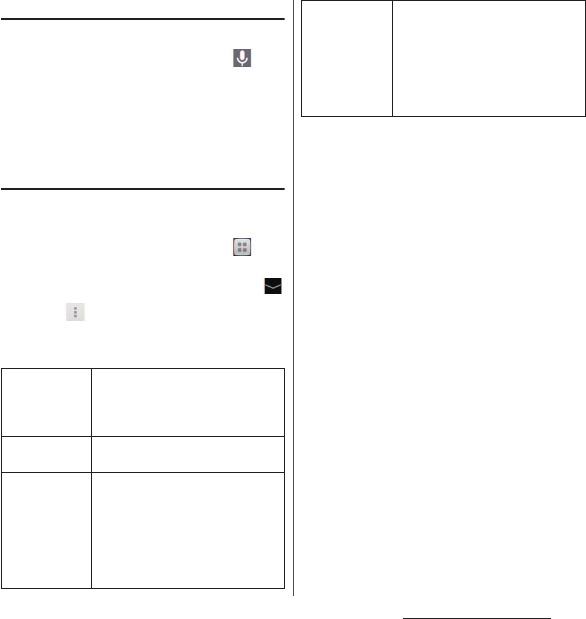
58
Before Using the Terminal
Using Google voice typing
Enter a search word by voice.
1
From the Home screen, tap on
the Google search widget.
2
Speak a search word to the
microphone.
・
Search results appear.
Search settings
You can set to use for search box or set search
objectives in the terminal.
1
From the Home screen, tap ,
then tap [Google].
・
The software keyboard appears. Tap .
2
Tap and [Settings].
・
Google search setting screen appears.
You can set the following items.
* Appears when a Google account is set.
Google Now
*
Set location information service to
on to check weather information for
the current location, traffic
information, directions.
Voice
You can change language and
settings for voice search.
Phone search
Change the search range by
marking/unmarking data categories
(Apps, Browser, Chrome, Contacts,
docomo phonebook, Email, File
Commander, Messaging,
OfficeSuite, Play Books, Play Movies
& TV, WALKMAN) in the terminal.
Privacy and
accounts
Set whether to display search
options from Web history when a
search word is entered, or delete a
search history for contents or
applications in the terminal.
・
You need to create your Google
account.
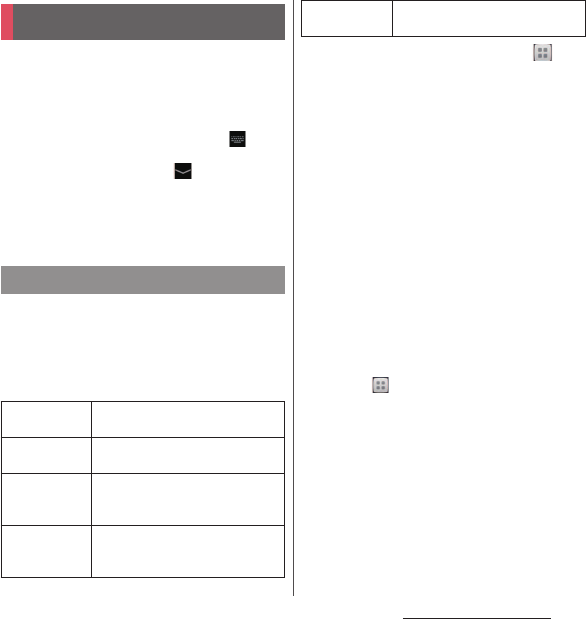
59
Before Using the Terminal
Enter characters using the software keyboard
which appears when you tap the character
input box in a mail, phonebook, etc.
❖
Information
・
When the software keyboard is displayed,
appears on the status bar.
・
To hide software keyboard, tap displayed at the
lower left of the screen.
・
Touch and hold a text in the character entry screen
to display the enlarged text to check with dragging
on the text.
In the terminal, you can select Input method
(keyboard type) from "Google voice typing",
"Moji-Henshu", "Xperia
™
Chinese keyboard",
"Xperia
™
Japanese keyboard" or "Xperia
™
keyboard".
1
From the Home screen, tap ,
then tap [Settings].
2
Tap [Language & input]
u
[Default].
3
Tap [Xperia
™
Japanese keyboard]/
[International keyboard].
❖
Information
・
When the language is set to English, the default
input method is set to "International keyboard". To
use the Japanese keyboard, tap [Xperia
™
Japanese
keyboard] in Step 3. In this manual, explanations are
given only for "Xperia
™
Japanese keyboard".
・
While entering characters, drag the status bar
downwards and tap [Choose input method] to select
from "Google voice typing"/"Japanese Moji-Henshu"/
"Xperia
™
Japanese keyboard"/"International
keyboard".
・
"Xperia
™
Chinese keyboard" is not available by
default. To use Chinese keyboard, from the Home
screen, tap , then tap [Settings]
u
[Language &
input] and mark "Xperia
™
Chinese keyboard".
Character entry
Selecting entry method
Google voice
typing
Select to enter characters by voice
input with Google voice typing.
Moji-Henshu
Select to enter characters by voice
input with docomo voice input.
Xperia
™
Chinese
keyboard
Select to enter Chinese.
Xperia
™
Japanese
keyboard
Select to enter Japanese.
Xperia
™
keyboard
You can select a language for text
entry.
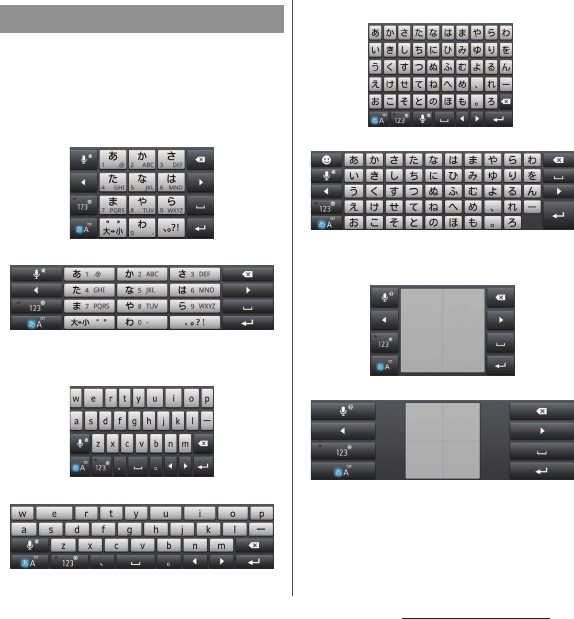
60
Before Using the Terminal
For Japanese keyboard, there are 5 types of
software keyboards: phonepad, QWERTY,
Japanese syllabary, Kana handwriting and
Kanji handwriting input.
■
Phonepad keyboard
■
QWERTY keyboard
■
Japanese syllabary keyboard
■
Kana handwriting input
Software keyboard
Portrait
Landscape
Landscape
Portrait
Portrait
Landscape
Portrait
Landscape
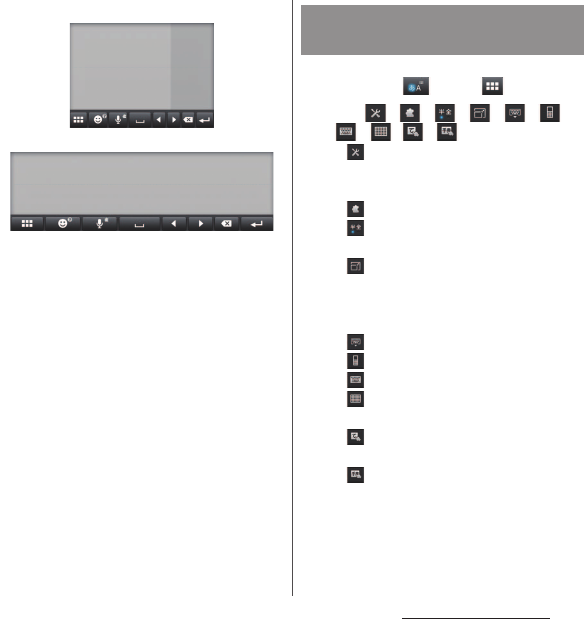
61
Before Using the Terminal
■
Kanji handwriting input
❖
Information
・
The key display of software keyboard varies
depending on the entry screen, character mode or
settings.
1
On a character entry screen, touch
and hold or tap .
2
Tap / / / / / /
/ / / .
・
: Display Japanese keyboard
settings screen and check/change the
settings.
・
: Display the extensions list.
・
: Switch one-byte/two-byte
character.
・
: Change size and location of
software keyboard (except for
landscape screen and Kanji
handwriting input).
・
: Hide the software keyboard.
・
: Display the phonepad keyboard.
・
: Display the QWERTY keyboard.
・
: Display the Japanese syllabary
keyboard.
・
: Display the Kana handwriting
input.
・
: Display the Kanji handwriting
input.
Portrait
Landscape
Changing software keyboard
and settings
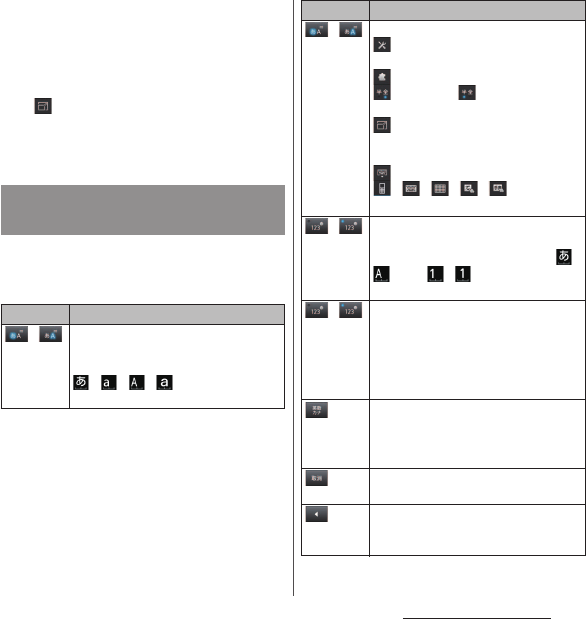
62
Before Using the Terminal
❖
Information
・
By default, the phonepad keyboard for portrait
screen is set and QWERTY keyboard for landscape
screen is set. Also, "Word suggestions", "Auto
capitalization", and "Spell check" are set to ON for
input support.
・
Tap in Step 2 to change size and location of
software keyboard. Drag blue frame to change size.
Drag the software keyboard to move to. To restore
the software keyboard to the default, tap [Reset].
Enter characters using the keyboard with
multiple-character-assigned keys. Flick input
or toggle input is used for character entry.
Entering characters on the
phonepad keyboard
Icon Function
/
Each time you tap, the character mode
switches "Hiragana/Kanji"
→
"Alphanumeric" in order and status icons,
→
/ / appear in the status
bar.
/
Touch and
hold
Display a pop-up menu.
: Display the setting screen for
Japanese keyboard
: Display the extensions list
(Two-byte)/ (One-byte) : Switch
character mode
: Change size and location of
software keyboard (except for landscape
screen and Kanji handwriting input).
: Hide the software keyboard
/ / / / : Software
keyboard switch
/
Each time you tap, the character mode
switches "Hiragana/Kanji/alphabets"
→
"Number" in order and status icons, /
, etc.
→
/ appear in the status
bar.
/
Touch and
hold
Enter one-byte/two-byte symbols from
the displayed list. Switch the tab to enter
facemarks from the displayed list (a
pictogram tab and deco-mail tab are
also displayed when entering in sp-
mode mail).
Appears before fixing character in
Hiragana/Kanji input mode. It displays
alphanumeric or katakana conversion
candidates assigned to tapped key.
Appears after conversion is fixed to
return to text before conversion.
Move the cursor
*1
: To the left.
Touch and hold to move continuously.
Or change the range for conversion.
Icon Function
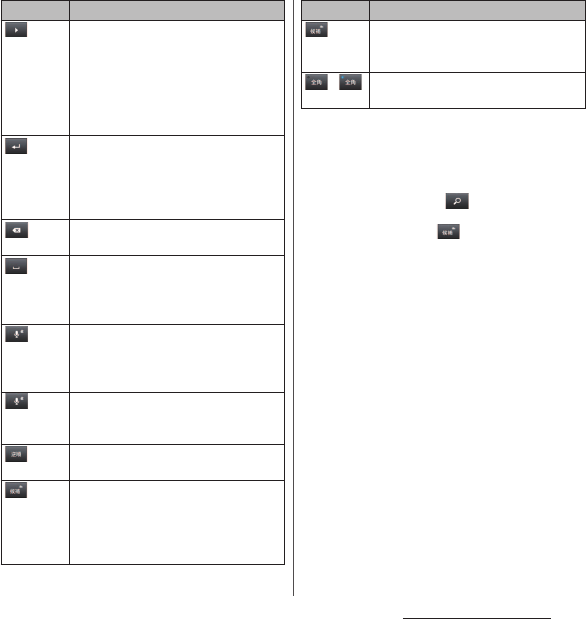
63
Before Using the Terminal
*1 When any characters are entered, just tap the
desired position on the entered character string to
move the cursor.
*2 In some screens such as the mail account
registration screen or search screen, "
次へ
(Next)", "
完了
(Done)", "
実行
(Go)", , etc. appear.
*3 To set online dictionary, in Hiragana/Kanji input
mode, touch and hold , tap [OK] then mark
"Online dictionary", or mark "Online dictionary" in
the Japanese keyboard setting screen (P.80).
Move the cursor
*1
: To the right.
Touch and hold to move continuously.
Or change the range for conversion.
When there is an unfixed character string
with the cursor at the right end, tap to
enter the same character as the one at
the end.
Before the conversion is fixed, "
確定
(Fix)"
is displayed
*2
, and fixes the entering
characters or conversion characters.
When characters are already fixed, enter
a line feed at the cursor position.
Delete the character before the cursor.
Touch and hold to delete continuously.
When any character is entered or after
entered character is fixed, a space can be
entered. Touch and hold to input spaces
continuously.
Input letters by "docomo voice input" or
"Google voice typing". A word
suggestion list appears. Tap a character
string you want to input.
Touch and
hold
Display the available extensions list.
Display the previous character (opposite
order).
In Hiragana/Kanji input mode, highlight
and select word in conversion
candidates. Tap continuously to change
a word highlighted in conversion
candidates and select a word to enter.
Icon Function
Touch and
hold
In Hiragana/Kanji input mode, activate
online dictionary to display in
conversion candidates.
*3
/ Appears when entering numbers, tap to
switch one-byte/two-byte character.
Icon Function
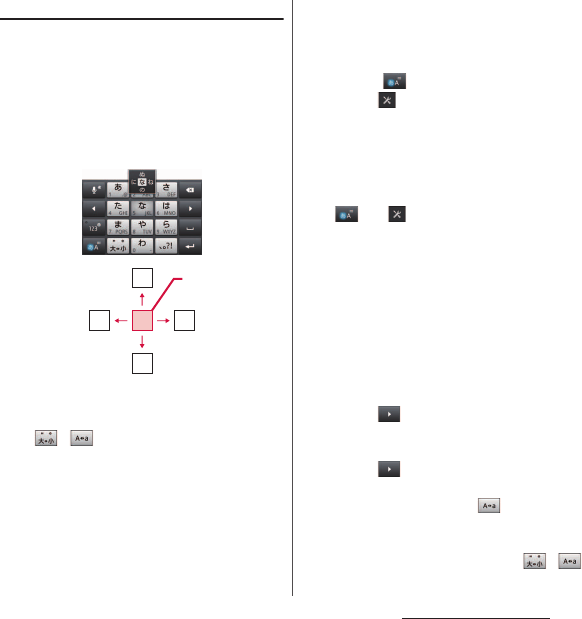
64
Before Using the Terminal
Settings of entry
■
Flick input
Flick up/down/left/right to enter characters
in each column of kana syllabary.
・
Ex: Entering characters in "
な
" column
You can enter "
な
" only by tapping. Flick
left for "
に
", up for "
ぬ
", right for "
ね
" and
down for "
の
".
・
To switch upper/lower case or change to
voiced/semi-voiced sound, tap or flick
/ .
・
Flick input is available by default. When
not using it, you can cancel by the
following operations.
a
On a character entry screen, touch and
hold .
b
Tap .
c
[On-screen keyboard
settings]
u
Unmark "Flick input"
checkbox.
・
To change sensitivity of the flick input, on
a character entry screen, touch and hold
, tap and [On-screen keyboard
settings]
u
[Sensitivity of flick input], then
select "High"/"Medium (default)"/"Low".
■
Toggle entry
Tap the same key continuously to enter the
assigned character.
To enter characters assigned to the same
key continuously, operate the followings.
・
Ex: To enter "
あお
"
a
Tap "
あ
" once.
b
Tap , and tap "
あ
" 5 times.
・
Ex: To enter "ca"
a
Tap "abc" 3 times.
b
Tap
*
.
c
Tap "abc" once.
* In some applications, tap in Step
b
.
・
To switch upper/lower case or change to
voiced/semi-voiced sound, tap / .
ぬ
ねに
の
な
Flick left
Flick up Tap
Flick right
Flick down
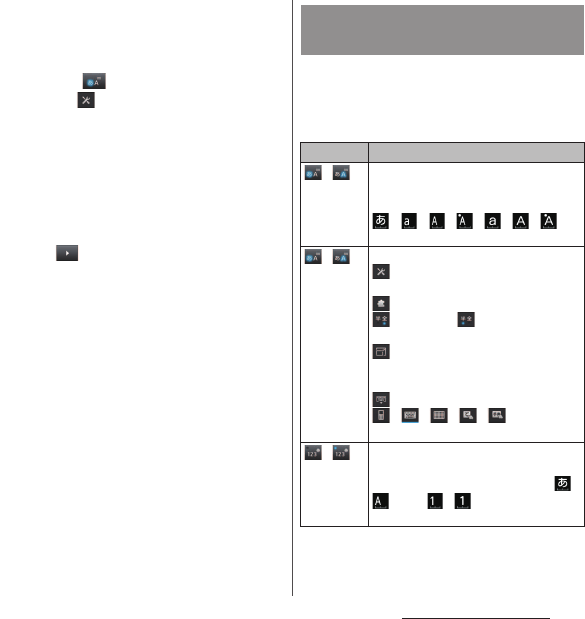
65
Before Using the Terminal
・
Multitap text input is available by default.
When not using it, you can cancel by the
following operations.
a
On a character entry screen, touch and
hold .
b
Tap .
c
[On-screen keyboard
settings]
u
Unmark "Multitap text
input" checkbox.
❖
Information
・
In case of Multitap text input, when the tapped key's
highlighter goes off and you can enter a character
assigned to the same key consecutively without
tapping .
Enter characters using a keyboard with
characters allocated in the same
arrangement as general PCs. Enter Japanese
in Roman character.
Entering characters on the
QWERTY keyboard
Icon Function
/
Each time you tap, the character mode
switches "Hiragana/Kanji"
→
"Alphanumeric" in order and status icons,
→
/ / / / /
appear in the status bar.
/
Touch and
hold
Display a pop-up menu.
: Display the setting screen for
Japanese keyboard
: Display the extensions list
(Two-byte)/ (One-byte) : Switch
character mode
: Change size and location of
software keyboard (except for landscape
screen and Kanji handwriting input)
: Hide the software keyboard
/ / / / : Software
keyboard switch
/
Each time you tap, the character mode
switches "Hiragana/Kanji/alphabets"
→
"Number" in order and status icons, /
, etc.
→
/ appear in the status
bar.
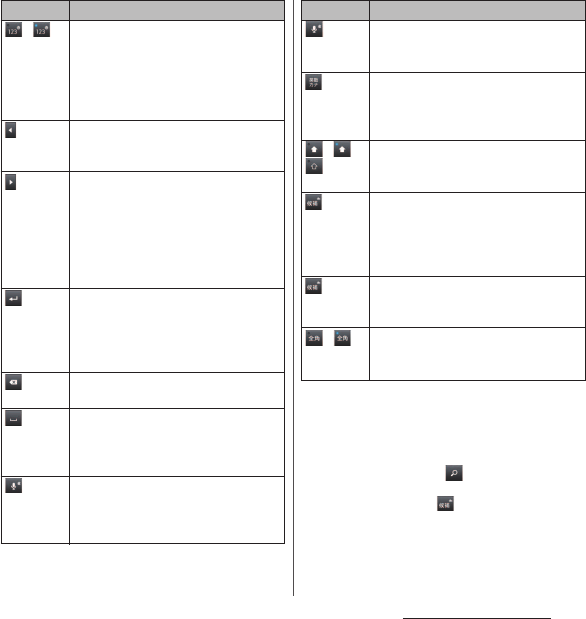
66
Before Using the Terminal
*1 When any characters are entered, just tap the
desired position on the entered character string to
move the cursor.
*2 In some screens such as the mail account
registration screen or search screen, "
次へ
(Next)", "
完了
(Done)", "
実行
(Go)", , etc. appear.
*3 To set online dictionary, in Hiragana/Kanji input
mode, touch and hold , tap [OK] then mark
"Online dictionary", or mark "Online dictionary" in
the Japanese keyboard setting screen (P.80).
/
Touch and
hold
Enter one-byte/two-byte symbols from
the displayed list. Switch the tab to enter
facemarks from the displayed list (a
pictogram tab and deco-mail tab are
also displayed when entering in sp-
mode mail).
Move the cursor
*1
: To the left.
Touch and hold to move continuously.
Or change the range for conversion.
Move the cursor
*1
: To the right.
Touch and hold to move continuously.
Or change the range for conversion.
When there is an unfixed character string
with the cursor at the right end, tap to
enter the same character as the one at
the end.
Before the conversion is fixed, "
確定
(Fix)"
is displayed
*2
, and fixes the entering
characters or conversion characters.
When characters are already fixed, enter
a line feed at the cursor position.
Delete the character before the cursor.
Touch and hold to delete continuously.
When any character is entered or after
entered character is fixed, a space can be
entered. Touch and hold to input spaces
continuously.
Input letters by "docomo voice input" or
"Google voice typing". A word
suggestion list appears. Tap a character
string you want to input.
Icon Function
Touch and
hold
Display the available extensions list.
Appears before fixing character in
Hiragana/Kanji input mode. It displays
alphabet or katakana conversion
candidates assigned to tapped key.
/ /
In alphanumerics input mode, tap to
switch capitalization/upper case/lower
case.
In Hiragana/Kanji input mode, highlight
and select word in conversion
candidates. Tap continuously to change
a word highlighted in conversion
candidates and select a word to enter.
Touch and
hold
In Hiragana/Kanji input mode, activate
online dictionary to display in
conversion candidates.
*3
/ Appears in number input mode. Tap to
switch numbers or symbols to one-byte/
two-byte characters.
Icon Function
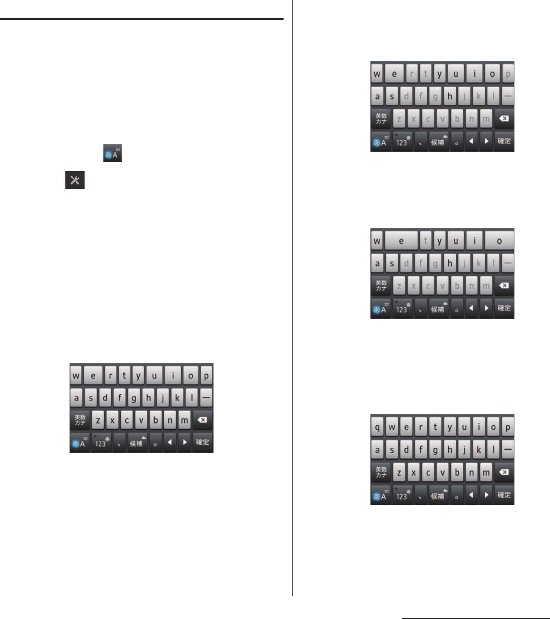
67
Before Using the Terminal
Selecting an assistant keyboard
When you enter in Hiragana/Kanji input
mode using the QWERTY keyboard, you can
change the assistant keyboard to make the
frequent using keys to be displayed widely
for easy tapping.
1
On a character entry screen, touch
and hold .
2
Tap .
3
Tap [On-screen keyboard
settings]
u
[Choose key type].
4
Tap any of [Wide]/[Highlight]/
[Dynamic]/[Standard].
5
Tap [OK].
■
Wide
Widen frequent using key for easy tapping.
■
Highlight
Widen frequent using key and highlight the
key that is predicted for the next entry.
■
Dynamic
Widen the key that is predicted for the next
entry much further and highlight it.
■
Standard
Display equally the width of each key.
Settings of "Hide keys" (P.68) are not valid
and all keys are shown.
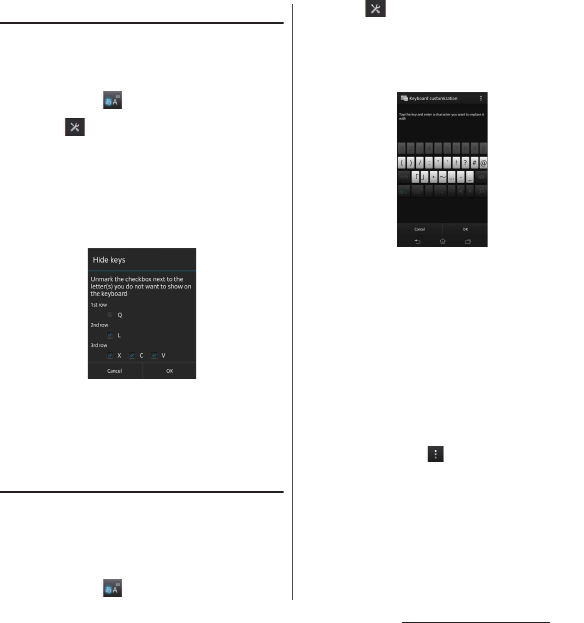
68
Before Using the Terminal
Changing display keys
You can set not to display less-frequent-used
keys (Q, X, C, etc.) on the QWERTY keyboard.
1
On a character entry screen, touch
and hold .
2
Tap .
3
Tap [On-screen keyboard
settings]
u
[Hide keys].
・
When the Choose key type (P.67) is set
to "Standard", "Hide keys" cannot be
selected.
4
Unmark the checkbox of the key
you want to hide.
5
Tap [OK].
Customizing keyboard
You can change symbols which are displayed
in QWERTY keyboard when entering number
to desired characters/symbols.
1
On a character entry screen, touch
and hold .
2
Tap .
3
Tap [On-screen keyboard
settings]
u
[Keyboard
customization].
4
Tap a symbol you want to change
and delete character previously
set, then enter a character to
display and tap [OK].
・
Only one character (two-byte or one-
byte character) can be set.
5
Tap [OK].
❖
Information
・
To return to the default status, on the keyboard
customize screen, tap , then tap [Reset]
u
[OK].
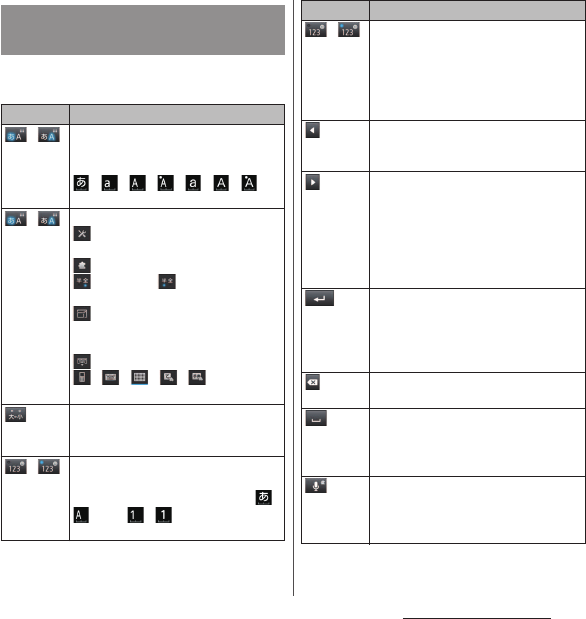
69
Before Using the Terminal
You can use the software keys arranged
according to the Japanese syllabary.
Entering characters on the
Japanese syllabary keyboard
Icon Function
/
Each time you tap, the character mode
switches "Hiragana/Kanji"
→
"Alphanumeric" in order and status icons,
→
/ / / / /
appear in the status bar.
/
Touch and
hold
Display a pop-up menu.
: Display the setting screen for
Japanese keyboard
: Display the extensions list
(Two-byte)/ (One-byte) : Switch
character mode
: Change size and location of
software keyboard (except for landscape
screen and Kanji handwriting input)
: Hide the software keyboard
/ / / / : Software
keyboard switch
Appears in Hiragana/Kanji input mode.
Switch upper/lower case or add voiced
sound/semi-voiced sound.
/
Each time you tap, the character mode
switches "Hiragana/Kanji/alphabets"
→
"Number" in order and status icons, /
, etc.
→
/ appear in the status
bar.
/
Touch and
hold
Enter one-byte/two-byte symbols from
the displayed list. Switch the tab to enter
facemarks from the displayed list (a
pictogram tab and deco-mail tab are
also displayed when entering in sp-
mode mail).
Move the cursor
*1
: To the left.
Touch and hold to move continuously.
Or change the range for conversion.
Move the cursor
*1
: To the right.
Touch and hold to move continuously.
Or change the range for conversion.
When there is an unfixed character string
with the cursor at the right end, tap to
enter the same character as the one at
the end.
Before the conversion is fixed, "
確定
(Fix)"
is displayed
*2
, and fixes the entering
characters or conversion characters.
When characters are already fixed, enter
a line feed at the cursor position.
Delete the character before the cursor.
Touch and hold to delete continuously.
When any character is entered or after
entered character is fixed, a space can be
entered. Touch and hold to input spaces
continuously.
Input letters by "docomo voice input" or
"Google voice typing". A word
suggestion list appears. Tap a character
string you want to input.
Icon Function
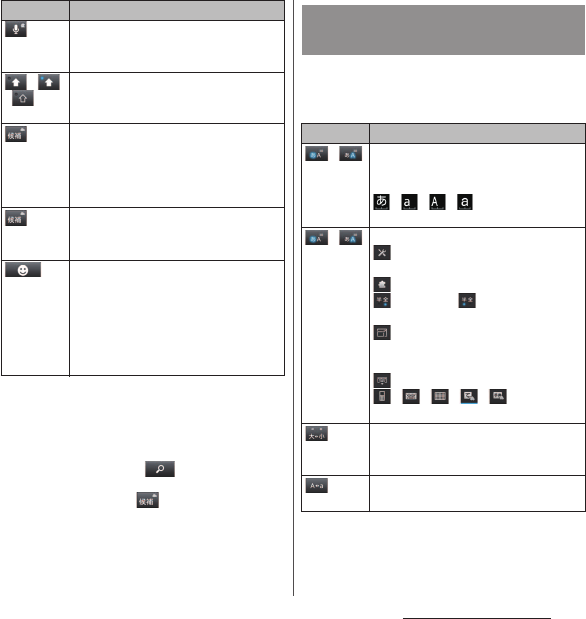
70
Before Using the Terminal
*1 When any characters are entered, just tap the
desired position on the entered character string to
move the cursor.
*2 In some screens such as the mail account
registration screen or search screen, "
次へ
(Next)", "
完了
(Done)", "
実行
(Go)", , etc. appear.
*3 To set online dictionary, in Hiragana/Kanji input
mode, touch and hold , tap [OK] then mark
"Online dictionary", or mark "Online dictionary" in
the Japanese keyboard setting screen (P.80).
Trace characters on the Kana handwriting
area to enter Hiragana, Alphabet, Number, a
part of symbols by handwriting.
Touch and
hold
Display the available extensions list.
/
/
In alphanumerics input mode, tap to
switch capitalization/upper case/lower
case or switch allocated symbol type.
In Hiragana/Kanji input mode, highlight
and select word in conversion
candidates. Tap continuously to change
a word highlighted in conversion
candidates and select a word to enter.
Touch and
hold
In Hiragana/Kanji input mode, activate
online dictionary to display in
conversion candidates.
*3
Appears in landscape mode, and you
can enter one-byte/two-byte symbols
from the displayed list. Switch the tab to
enter facemarks from the displayed list (a
pictogram tab and deco-mail tab are
also displayed when entering in sp-
mode mail).
Icon Function
Entering characters on the
Kana handwriting input
Icon Function
/
Each time you tap, the character mode
switches "Hiragana/Kanji"
→
"Alphanumeric" in order and status icons,
→
/ / appear in the status
bar.
/
Touch and
hold
Display a pop-up menu.
: Display the setting screen for
Japanese keyboard
: Display the extensions list
(Two-byte)/ (One-byte) : Switch
character mode
: Change size and location of
software keyboard (except for landscape
screen and Kanji handwriting input)
: Hide the software keyboard
/ / / / : Software
keyboard switch
Appears in Hiragana/Kanji input mode.
Switch upper/lower case or add voiced
sound/semi-voiced sound.
Appears in alphanumerics input mode,
tap to switch upper case and lower case.
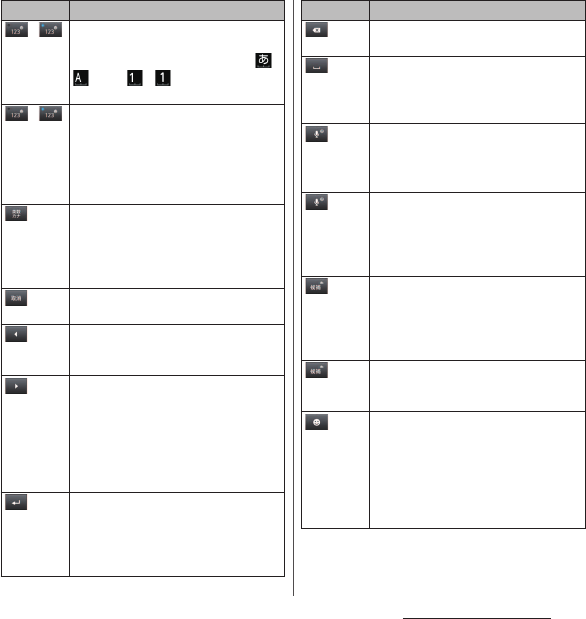
71
Before Using the Terminal
*1 When any characters are entered, just tap the
desired position on the entered character string to
move the cursor.
/
Each time you tap, the character mode
switches "Hiragana/Kanji/alphabets"
→
"Number" in order and status icons, /
, etc.
→
/ appear in the status
bar.
/
Touch and
hold
Enter one-byte/two-byte symbols from
the displayed list. Switch the tab to enter
facemarks from the displayed list (a
pictogram tab and deco-mail tab are
also displayed when entering in sp-
mode mail).
Appears before fixing character in
Hiragana/Kanji input mode. It displays
alphanumeric or katakana conversion
candidates assigned to entered
characters.
Appears after conversion is fixed to
return to text before conversion.
Move the cursor
*1
: To the left.
Touch and hold to move continuously.
Or change the range for conversion.
Move the cursor
*1
: To the right.
Touch and hold to move continuously.
Or change the range for conversion.
When there is an unfixed character string
with the cursor at the right end, tap to
enter the same character as the one at
the end.
Before the conversion is fixed, "
確定
(Fix)"
is displayed
*2
, and fixes the entering
characters or conversion characters.
When characters are already fixed, enter
a line feed at the cursor position.
Icon Function
Delete the character before the cursor.
Touch and hold to delete continuously.
When any character is entered or after
entered character is fixed, a space can be
entered. Touch and hold to input spaces
continuously.
Input letters by "docomo voice input" or
"Google voice typing". A word
suggestion list appears. Tap a character
string you want to input.
Touch and
hold
Kana handwriting input guide in the
POBox Touch User Guide (Japanese)
activates and you can view the detailed
explanations on the Kana handwriting
input.
In Hiragana/Kanji input mode, highlight
and select word in conversion
candidates. Tap continuously to change
a word highlighted in conversion
candidates and select a word to enter.
Touch and
hold
In Hiragana/Kanji input mode, activate
online dictionary to display in
conversion candidates.
*3
Appears when entering number. Enter
one-byte/two-byte symbols from the
displayed list. Switch the tab to enter
facemarks from the displayed list (a
pictogram tab and deco-mail tab are
also displayed when entering in sp-
mode mail).
Icon Function
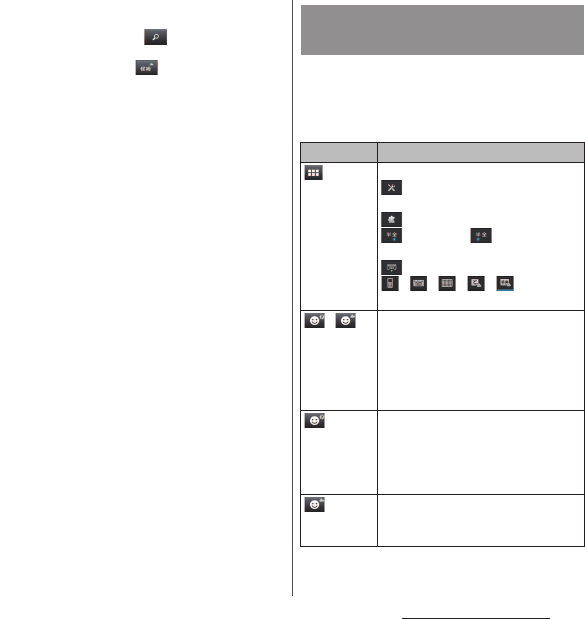
72
Before Using the Terminal
*2 In some screens such as the mail account
registration screen or search screen, "
次へ
(Next)", "
完了
(Done)", "
実行
(Go)", , etc. appear.
*3 To set online dictionary, in Hiragana/Kanji input
mode, touch and hold , tap [OK] then mark
"Online dictionary", or mark "Online dictionary" in
the Japanese keyboard setting screen (P.80).
❖
Information
・
When you enter character by Kana handwriting for
the first time, read a guidance and tap [OK].
・
You can enter a character continuously without
deleting entered character.
・
For voiced sound and semi voiced sound mark, enter
in the right upper part of the Kana handwriting input
screen.
・
For punctuation mark and lower case, enter in the
lower part from the center of the Kana handwriting
input.
・
For entering alphabet, enter it with reference to
lower horizontal line of the Kana handwriting input
screen.
You can input Hiragana, Kanji, Katakana,
Alphabet, Number, a part of symbols by
tracing characters on Kanji handwriting area
without switching input mode.
Entering characters on the
Kanji handwriting input
Icon Function
Display a pop-up menu.
: Display the setting screen for
Japanese keyboard
: Display the extensions list
(Two-byte)/ (One-byte) :
Switch character mode
: Hide the software keyboard
/ / / / : Software
keyboard switch
/
*1
Enter one-byte/two-byte symbols from
the displayed list. Switch the tab to
enter facemarks from the displayed list
(a pictogram tab and deco-mail tab are
also displayed when entering in sp-
mode mail).
Touch and
hold
The Kana handwriting input guide in
the POBox Touch User Guide
(Japanese) activates. You can view the
detailed explanations for the
handwriting input.
*1
Touch and
hold
When inputting character, activate
online dictionary to display in
conversion candidates.
*2
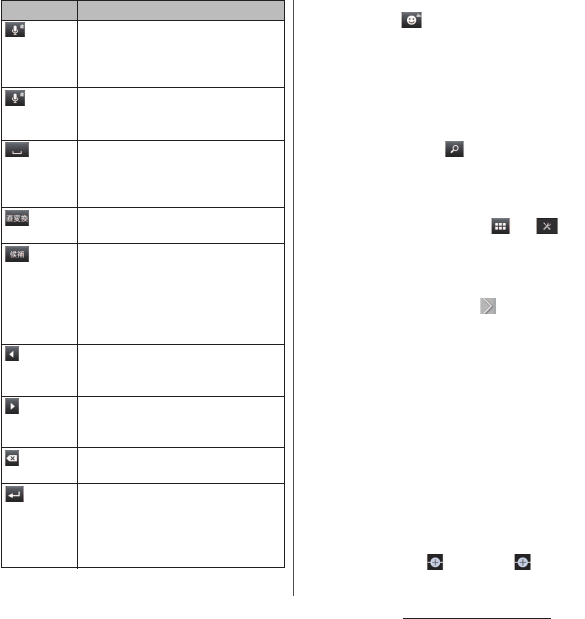
73
Before Using the Terminal
*1 Appears when entering characters.
*2 To set online dictionary, when inputting character,
touch and hold , tap [OK] then mark "Online
dictionary", or mark "Online dictionary" in the
Japanese keyboard setting screen (P.80).
*3 When any characters are entered, just tap the
desired position on the entered character string to
move the cursor.
*4 In some screens such as the mail account
registration screen or search screen, "
次へ
(Next)", "
完了
(Done)", "
実行
(Go)", , etc. appear.
❖
Information
・
When you enter character by Kanji handwriting for
the first time, read a guidance and tap [OK].
・
On the character entry screen, tap and ,
then [On-screen keyboard settings]
u
Mark "Auto
scrolling" to display a gray area on the right of Kanji
handwriting input. Input characters to the area to
scroll the input area to the left automatically. When
you unmark "Auto scrolling", tap on the Kanji
handwriting input screen to scroll the input area.
・
For voiced/semi-voiced sound mark, enter in the
upper part from the Kanji handwriting input screen.
・
For punctuation mark and lower case, enter in the
lower part from the center of the Kanji handwriting
input screen.
・
Tap an icon at the upper left of entered character to
display candidates for the entered character.
Character displayed in blue is the recognized. Color
displayed below conversion candidate indicates a
character type: Green means Hiragana, yellow means
Kanji, orange means Katakana, dark blue means
Alphabet, purple means number and light blue
means symbol.
・
When entering 2 or more characters and tapping an
icon at the upper left, appears. Tap to
combine entered 2 characters to 1 character.
Enter characters by "docomo voice
input" or "Google voice typing". Input
candidates list appears. Tap a character
string to enter.
Touch and
hold
Display the available extensions list.
When any character is entered or after
entered character is fixed, a space can
be entered. Touch and hold to input
spaces continuously.
Display direct conversion candidates
when entering characters.
When entering characters, highlight
and select word in conversion
candidates. Tap continuously to
change a word highlighted in
conversion candidates and select a
word to enter.
Move the cursor
*3
: To the left.
Touch and hold to move continuously.
Or change the range for conversion.
Move the cursor
*3
: To the right.
Touch and hold to move continuously.
Or change the range for conversion.
Delete the character before the cursor.
Touch and hold to delete continuously.
Before the conversion is fixed, "
確定
(Fix)" is displayed
*4
and pressing it fixes
characters to enter or convert. When
characters are already fixed, enter a line
feed at the cursor position.
Icon Function
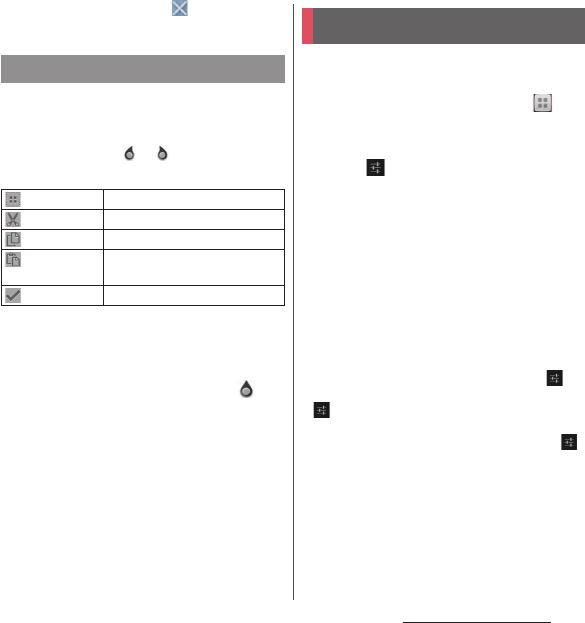
74
Before Using the Terminal
・
When entering characters, tap to delete entered
characters.
In the character entry screen such as mail,
phonebook, etc., double-tap text you want to
edit so that text edit menu appears at the top
of the screen. Drag or to change the
character string to select.
❖
Information
・
To paste a copied or cut character string, touch and
hold a position where you want to insert, then tap
[PASTE]. Alternatively, when texts are entered, tap a
position where you want to insert, then tap and
[PASTE].
・
Edit menu icons vary by applications.
・
In the landscape screen, editing menu may not be
displayed.
For each input method, you can make
settings related to character entry.
1
From the Home screen, tap ,
then tap [Settings]
u
[Language &
input].
2
Tap on "Google voice typing"/
"Moji-Henshu"/"Xperia
™
Chinese
keyboard"/"Xperia
™
Japanese
keyboard"/"Xperia
™
keyboard".
・
Settings screen for respective input
method appears. Tap an item displayed
on the screen to set.
❖
Information
・
The items vary depending on the input method.
・
Alternatively, while entering characters, drag the
status bar downwards and tap [Choose input
method]
u
[Set up input methods], then tap for
each input method to display.
・
on the "Xperia
™
Chinese keyboard" is not
available by default. To set Chinese keyboard, mark
"Xperia
™
Chinese keyboard" in Step 2, then tap .
Editing text
(Select all)
Select all entered text.
(Cut)
Cut a selected character string.
(Copy)
Copy a selected character string.
(Paste)
Paste a copied/cut character
string.
(Complete)
Close the edit menu.
Setting character entry
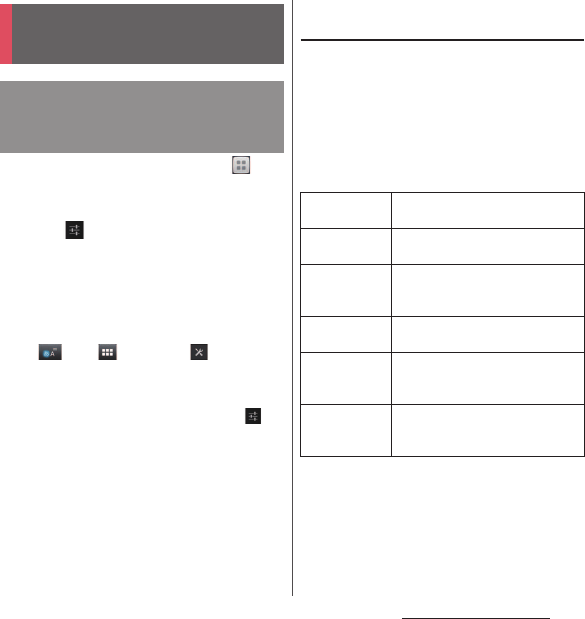
75
Before Using the Terminal
1
From the Home screen, tap ,
then tap [Settings]
u
[Language &
input].
2
Tap on "Xperia
™
Japanese
keyboard".
・
The setting screen for Xperia
™
Japanese keyboard appears.
❖
Information
・
Alternatively, on a character entry screen, touch and
hold or tap and then tap to display the
setting screen for Xperia
™
Japanese keyboard.
Alternatively, while entering characters, drag the
status bar downwards and tap [Choose input
method]
u
[Set up input methods], then tap for
"Xperia
™
Japanese keyboard" to display.
Common settings of software
keyboard
Make keyboard settings such as Key sound,
Vibrate, etc.
1
On the setting screen for Xperia
™
Japanese keyboard, tap [On-
screen keyboard settings].
・
Set items for "COMMON ON-SCREEN
KEYBOARD SETTINGS".
❖
Information
・
"Sound on keypress" volume is linked to "Ringtone &
notifications" (P.205) of volume in Volumes.
・
By default, conversion candidates are set to be
displayed in 2 lines in portrait/landscape screen.
Setting Xperia
™
Japanese
keyboard
Displaying the setting screen
for Xperia
™
Japanese
keyboard
Sound on
keypress
Set whether to sound at the time of
key tapping.
Vibration on
keypress
Set whether to vibrate at the time of
key tapping.
Vibration
intensity
When "Vibration on keypress" is set,
you can set vibration intensity by
dragging the slider left or right.
Pop-up on
keypress
Set whether to magnify tapped key
or display flick guide.
No. of lines
(portrait)
Set number of lines for conversion
candidates displayed in portrait
mode.
No. of lines
(landscape)
Set number of lines for conversion
candidates displayed in landscape
mode.
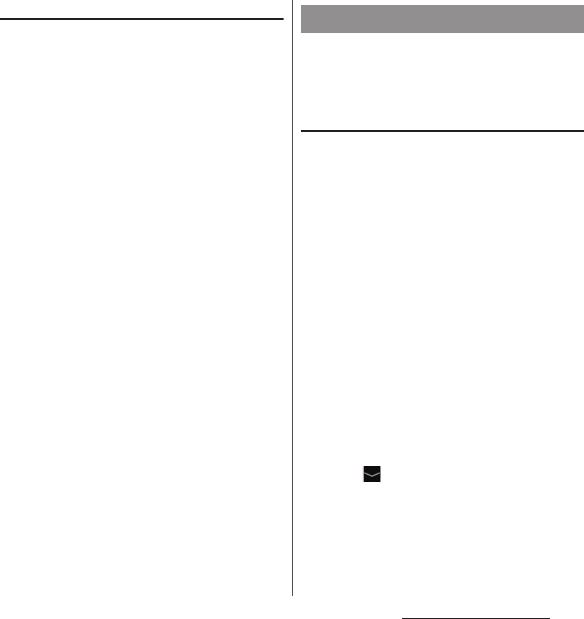
76
Before Using the Terminal
Keeping keyboard type
Set to stabilize the last status of keyboard
(phonepad/QWERTY/Japanese syllabary
keyboard/Kana handwriting input/Kanji
handwriting input) in the each portrait/
landscape screen in kana/alphabet/number
input mode.
1
On the setting screen for Xperia
™
Japanese keyboard, tap [On-
screen keyboard settings].
2
Mark [Keep keyboard type].
❖
Information
・
You can set to stabilize the last status of keyboard in
the each portrait/landscape screen without marking
"Keep keyboard type".
You can set support functions for character
input such as Word suggestion function,
Setting voice input.
Setting Word suggestion
The Word suggestion function shows
predicted conversion candidates when you
enter Japanese/English characters. Mark the
checkbox of Word suggestion checkbox to
set "Spell check" and "Auto space". That helps
you entering characters with ease.
1
On the setting screen for Xperia
™
Japanese keyboard, tap [Input
support].
2
Mark "Word suggestions".
❖
Information
・
Flick or drag downwards in the word suggestion field
to enlarge the word suggestion field and to hide the
keyboard. Tap [
前候補
(Previous suggestion)]/[
次候補
(Next suggestion)]/[
確定
(Fix)] shown below the
word suggestions to select/fix characters to be
entered. To show the software keyboard, tap [
戻る
(Back)] or .
・
In Hiragana/Kanji input mode (in inputting character
when using Kanji handwriting input), tap [
直変
(Direct conversion)]/[
予測
(Prediction)] in the word
suggestion field to display direct conversion
candidates/predicted conversion candidates.
Input support

77
Before Using the Terminal
Setting voice input
Set voice input to "docomo voice input" or
"Google voice typing".
1
On the setting screen for Xperia
™
Japanese keyboard, tap [Input
support]
u
[Voice typing].
2
Tap [docomo voice input]/[Google
voice typing].
❖
Information
・
"docomo voice input" is set by default.
・
When you tap on the software keyboard for the
first time, you can select whether to activate docomo
voice input or change to Google voice typing.
Auto capitalization
Set to capitalize automatically the top letter
you enter in one-byte alphabet entry mode
(except for Kana handwriting input and Kanji
handwriting input).
1
On the setting screen for Xperia
™
Japanese keyboard, tap [Input
support].
2
Mark "Auto capitalization".
❖
Information
・
The top letter may not always be capitalized
automatically in one-byte alphabet entry mode
when "Auto capitalization" is marked.
Setting Spell check
Spell check corrects mistyped characters and
shows conversion candidates before
conversion in one-byte alphabet input mode
when entering characters with QWERTY
keyboard or Japanese syllabary keyboard.
1
On the setting screen for Xperia
™
Japanese keyboard, tap [Input
support].
2
Mark "Spell check".
❖
Information
・
If Word suggestion function (P.76) is not set, Spell
check is not available.
Setting Auto space
When selecting English word suggestion,
Auto space enters next to the entered
character (Except for Kanji handwriting
input). However, space is not entered
automatically in the mail address or URL
input fields.
1
On the setting screen for Xperia
™
Japanese keyboard, tap [Input
support].
2
Mark "Auto space".
❖
Information
・
If Word suggestion function (P.76) is not set, Auto
space is not available.
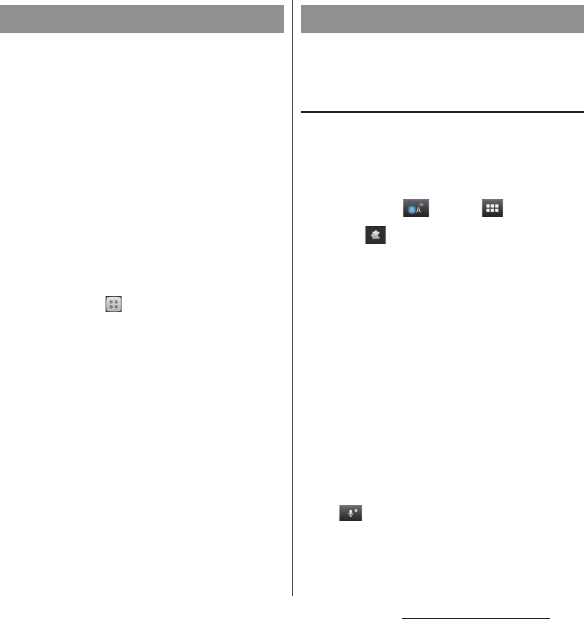
78
Before Using the Terminal
You can change software keyboard skin.
1
On the setting screen for Xperia
™
Japanese keyboard, tap [Keyboard
skin].
2
Select from keyboards displayed
by flicking left or right and tap [Set
skin].
❖
Information
・
To download and add keyboard skins from a website,
tap [Search for skin] in Step 2. Some keyboard skins
downloaded from website may not support the
terminal.
・
To delete the downloaded keyboard skin, from the
Home screen, tap , and tap
[Settings]
u
[Apps]
u
"Downloaded" tab, and tap the
keyboard skin you want to delete, and then tap
[Uninstall]
u
[OK]
u
[OK]. Also, tap [Uninstall] in Step 2
so that you can delete the keyboard skin that is not
compatible with the terminal.
You can use or add extensions when entering
characters.
Using Contact Picker 2.3
If contacts are registered to the Contacts, you
can use "Contact Picker 2.3" to enter contact
information when entering characters.
1
On a character entry screen, touch
and hold or tap .
2
Tap .
3
Tap [Contact Picker
2.3]
u
"Contacts" tab.
4
Tap the contact to pick up.
・
When you enter a name or reading in
the search box at the top of the screen,
a list of contacts appears accordingly.
5
Mark items you want to quote and
tap [OK].
・
If you want to select/deselect all items,
tap [Mark all]/[Unmark all].
❖
Information
・
Alternatively, on a character entry screen, touch and
hold to display the available extensions list
(except for Kana handwriting input).
・
"History" tab displays contacts that are picked up
when entering characters.
Setting keyboard skin Using extensions
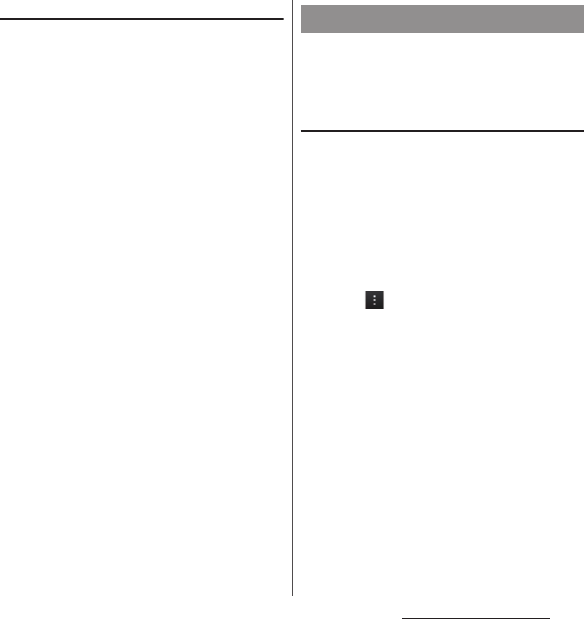
79
Before Using the Terminal
Adding an extension
You can install extensions to use when
entering characters.
1
On the setting screen for Xperia
™
Japanese keyboard, tap [Manage
extensions].
2
On the how to start extensions
screen, tap [OK].
・
Extensions settings screen appears.
3
Tap [Download new extensions].
・
Extensions list screen appears.
4
Select an application you want to
add.
・
After this step, follow the onscreen
instructions.
❖
Information
・
Marked extensions in the extensions settings screen
can be activated in the character entry screen. The
preinstalled extension "Contact Picker 2.3" is marked
by default.
To display the word as the preferred
candidate when entering characters, set the
user dictionary beforehand.
Registering words in user dictionaries
There are 2 types of user dictionaries: "My
words Japanese" and "My words English".
1
On the setting screen for Xperia
™
Japanese keyboard, tap
[Dictionaries].
2
Tap [My words Japanese]/[My
words English].
3
Tap and [Add].
4
Tap the character input box for
"Reading" and fill it out.
5
Enter a word in the input box for
"Word" and tap [
完了
(Done)] on
the software keyboard.
6
Tap [Save].
❖
Information
・
Words registered to My words Japanese are
displayed as conversion candidates when entering
Kanji in phonepad/QWERTY/Japanese syllabary/
Kana handwriting and Kanji handwriting input.
Setting dictionary
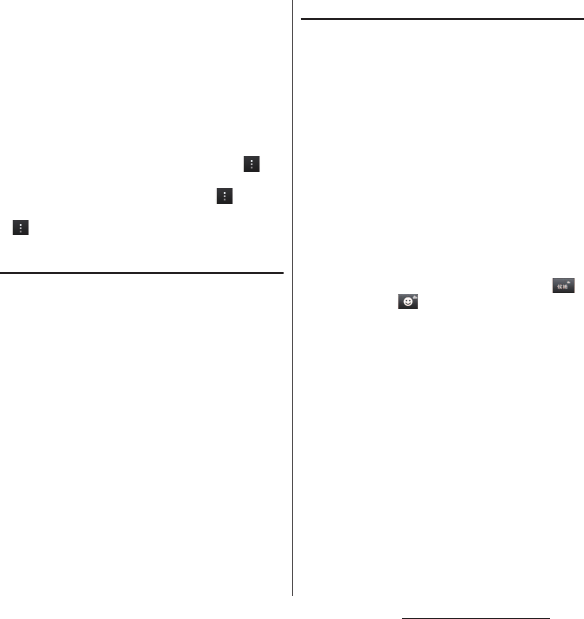
80
Before Using the Terminal
・
Words registered to My words English are displayed
as conversion candidates when entering alphabet in
phonepad/QWERTY/Japanese syllabary/Kana
handwriting. During Kanji handwriting input, they
are not displayed in the conversion candidates.
・
Up to 50 characters (regardless of one-byte or two-
byte characters) can be stored for a "Reading" and
"Word", and up to 500 items can be stored in the user
dictionary.
・
Added user dictionary can be edited or deleted. To
edit, select an added user dictionary and tap ,
then tap [Edit] for editing and tap [Save]. To delete,
select an added user dictionary and tap , then tap
[Delete]
u
[Delete]. To delete all user dictionary, tap
, then tap [Delete all]
u
[Delete].
Setting Words by learning
Learn words selected from the conversion
candidates to display as the preferred
candidate when entering characters.
1
On the setting screen for Xperia
™
Japanese keyboard, tap
[Dictionaries] then [Learn words].
2
Mark "Save words while typing".
・
To reset already learned words, tap
[Delete saved words]
u
[Delete].
❖
Information
・
To delete history for learned words individually,
touch and hold a word you want to delete and tap
[Delete].
Setting online dictionary
In Hiragana/Kanji input mode (in inputting
character when using Kanji handwriting
input), activate online dictionary to display in
conversion candidates.
1
On the setting screen for Xperia
™
Japanese keyboard, tap
[Dictionaries] then [Online
dictionary].
2
Tap [Online dictionary], then read
the note and tap [Agree].
・
"Online dictionary" is marked.
❖
Information
・
In Hiragana/Kanji input mode, touch and hold
(touch and hold in inputting character when
using Kanji handwriting input) to activate online
dictionary.
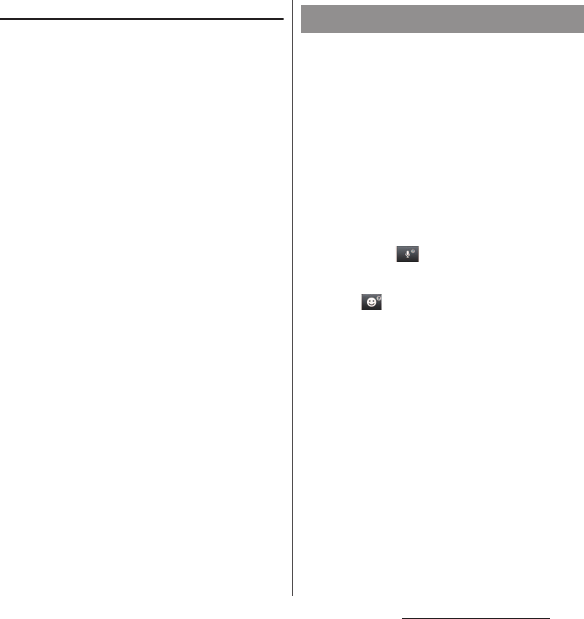
81
Before Using the Terminal
Backing up and restoring dictionary
User dictionary and Words by learning can be
backed up onto an internal storage and
restored when needed.
1
On the setting screen for Xperia
™
Japanese keyboard, tap
[Dictionaries] then [Backup &
restore].
2
Tap [Backup]/[Restore].
3
Mark a dictionary to back up/
restore.
・
Select "My words Japanese"/"My words
English"/"Learn words".
4
Tap [Go].
・
When backing up, a screen asking
whether to overwrite the user
dictionary on the internal storage
appears. When restoring, a screen
asking whether to overwrite the user
dictionary in the terminal appears.
5
Tap [OK]
u
[OK].
・
The data is backed up or restored.
❖
Information
・
If restoring data is failed, user dictionary in the
terminal restores to the default. Restore by operating
again.
・
User dictionary and Words by learning are not
backed up onto microSD card.
You can view the detailed explanations on
the high performance Xperia
™
Japanese
keyboard from the basic to application. The
latest information can be obtained from the
websites for extensions or keyboard skins.
1
On the setting screen for Xperia
™
Japanese keyboard, tap [POBox
Touch User Guide].
・
POBox Touch User Guide appears.
❖
Information
・
Touch and hold in the Kana handwriting input
screen to activate the Kana handwriting input guide
in the POBox Touch User Guide (Japanese), or touch
and hold in the Kanji handwriting input screen
to activate Kanji handwriting input guide with which
you can view the detailed explanations for the
handwriting input.
POBox Touch User Guide

82
Before Using the Terminal
Connect USB keyboard or Bluetooth
keyboard that supports HID (Human
Interface Device) profile with the terminal to
enter characters.
■
Using JIS keyboard
1
Connect a USB keyboard or
Bluetooth keyboard and drag the
status bar downwards, then tap
[Select keyboard layout].
・
If a notification does not appear on the
status bar, from the Home screen, tap
and [Settings]
u
[Language & input].
2
Tap a name of USB keyboard or
Bluetooth keyboard connected to
the terminal.
3
Tap [Set up keyboard
layouts]
u
[Japanese].
・
JIS keyboard is set. Tap
y
etc. to end
setting.
❖
Information
・
Some Bluetooth keyboards compatible with HID
profiles cannot be used or may not operate properly.
・
After is shown on the status bar of the terminal,
enter characters with USB keyboard or Bluetooth
keyboard. If the status icon does not appear, tap
character input field.
・
Press "
半角
/
全角
(one-byte/two-byte)" key on a USB
JIS keyboard or Bluetooth JIS keyboard to switch the
Roman alphabet kana input/Alphabet input on the
terminal. For English keyboards, pressing "
`
" key
(grave key) switches the input mode.
・
While displaying word suggestions, press "Tab" key/
"
↓
" key on the USB keyboard or the Bluetooth
keyboard to select a word in word suggestions.
・
While not selecting a word in word suggestions,
press "Space" key on the USB keyboard or the
Bluetooth keyboard to switch to direct conversion.
・
You can edit texts with connected USB keyboard or
the Bluetooth keyboard. For instructions on editing
texts on the terminal, see "Editing text" (P.74).
- Press "Ctrl" key and "A" key to select all entered text.
- Press "Shift" key and "
←
" key or "Shift" key and "
→
"
key to partly select entered text from cursor.
- Press "Ctrl" key and "X" key to cut a selected
character string.
- Press "Ctrl" key and "C" key to copy a selected
character string.
- Press "Ctrl" key and "V" key to paste a copied or cut
character string.
・
While displaying word suggestions, press "
無変換
(No
conversion)" key on the USB keyboard or the
Bluetooth keyboard to switch word suggestions to
alphanumeric conversion.
USB keyboard/Bluetooth
keyboard

83
Before Using the Terminal
・
While displaying word suggestions, press "Shift" key/
"Alt" key on the USB keyboard or the Bluetooth
keyboard to activate Online dictionary. You need to
mark "Online dictionary" checkbox in the Japanese
keyboard setting screen beforehand.
・
Current conversion candidate settings (word
prediction/direct conversion/alphanumeric
conversion/online dictionary) are displayed between
character input field and conversion candidate field
and selection method for conversion candidate is
displayed.
・
While displaying word suggestions, press "Function"
key on the USB keyboard or the Bluetooth keyboard
to convert to hiragana/katakana/alphabet.
- Press "F6" to convert to hiragana.
- Press "F7" to convert to two-byte katakana.
- Press "F8" to convert to one-byte katakana.
- Press "F9" to convert to two-byte alphabet.
- Press "F10" to convert to one-byte alphabet.
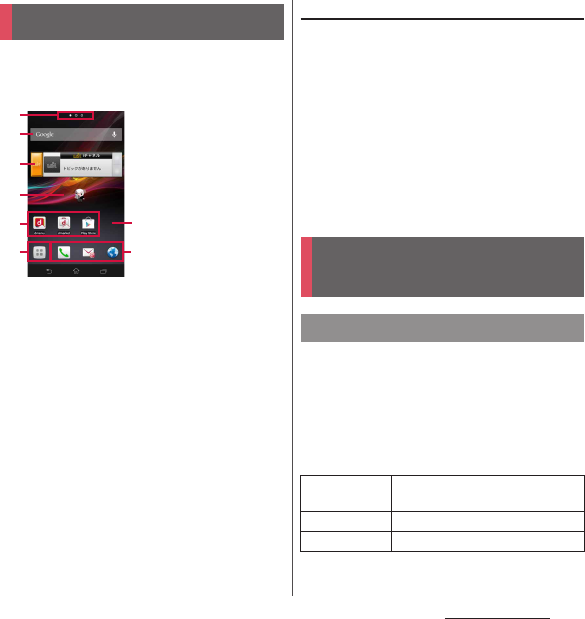
84
docomo Palette UI
docomo Palette UI
Tapping
y
displays Home screen which
consists of up to 12 screens you can use
flicking left and right.
a
Current home screen position
・
Flick the Home screen left or right to switch.
b
Widget : Google Search
c
Widget : i-channel
d
Widget : Machi-chara
e
Shortcuts (applications)
f
Applications button
g
Wallpaper
❖
Information
・
You can switch the home application between
"docomo" and "Xperia
™
" in the terminal. For
changing home application, see "Switching Home
application" (P.57).
・
When the instruction guide for the Home screen
appears, tap [Do not show this again]/[OK] to display
the Home screen.
Displaying a list of home screens
1
From the Home screen, pinch-in.
・
A home screen list appears.
❖
Information
・
Touch an hold an area of the Home screen where no
icons are displayed and tap [Home screens] to
display list of home screens.
・
When the instruction guide for the home screen list
appears, tap [Do not show this again]/[OK].
・
To return to the home screen, pinch-out, or tap
y
or
x
.
1
Touch and hold an area of the
Home screen where no icons are
displayed.
・
"Select an action" menu appears to
change the Home screen.
■
Select an action
Home screen
a
b
c
e
fe
g
d
©NTT DOCOMO
"ひつじのしつじくん®
(Butler Sheep)"
Managing the Home
screen
Adding to the Home screen
Shortcut
Add shortcuts of applications or
favorites (P.85).
Widget
Add widgets (P.85).
Folder
Create a new folder (P.87).
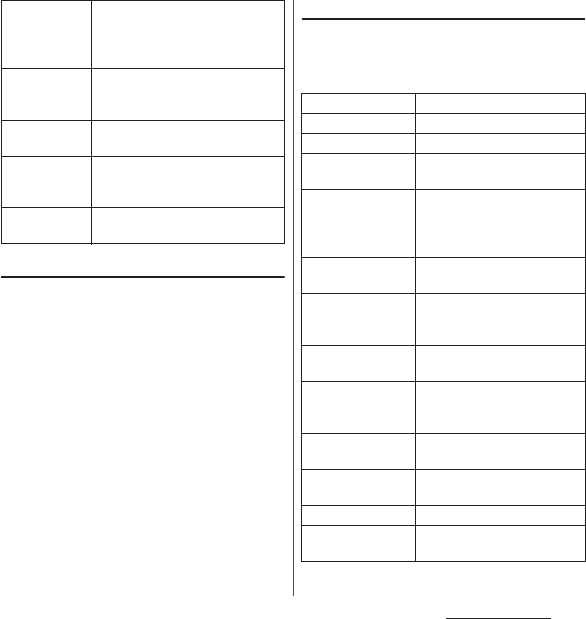
85
docomo Palette UI
Adding a shortcut to the Home screen
1
On "Select an action" menu screen
(P.84), tap [Shortcut].
2
Select an item you want to add.
・
The shortcut appears on the Home
screen.
❖
Information
・
Alternatively, on the Application screen (P.90), touch
and hold a group name and then tap [Add].
Adding a widget to the Home screen
1
On "Select an action" menu screen
(P.84), tap [Widget].
・
A list of widgets appears.
Kisekae
Change the background of the
Home screen or Application screen,
or download from website to add
(P.89).
Wallpaper
Select from "Album", "Live
Wallpapers", or "Xperia
™
wallpapers" to set wallpaper (P.89).
Group
Add group shortcut of Application
screen (P.87).
Home screens
Display a list of home screens and
then add, delete, or sort home
screens (P.84).
Wallpaper loop
settings
Set whether to loop wallpaper on
the Home screen.
Bookmarks
Display bookmarks of Browser.
Bookmarks
Display bookmarks of Chrome.
Calendar
Display events in calendar.
Contact
Display contacts using Contacts
application of Xperia
™
.
Contents Headline
Display recommended music,
videos, e-books and
applications information at the
dmarket.
docomo location
information
Activate docomo location
information application.
docomo Wi-Fi Easy
Connection
Connect/disconnect to Wi-Fi
with a one-touch operation in a
Wi-Fi area.
Email
Select Email account or folder
to display.
Facebook Buttons
Post your comments or select
and upload images to
Facebook.
Facebook Status
Show or post Facebook
comments.
Gmail
Select Gmail account or folder
to display.
Google Search
Display the Google search box.
Google+ posts
Display posted contents in
Google+.
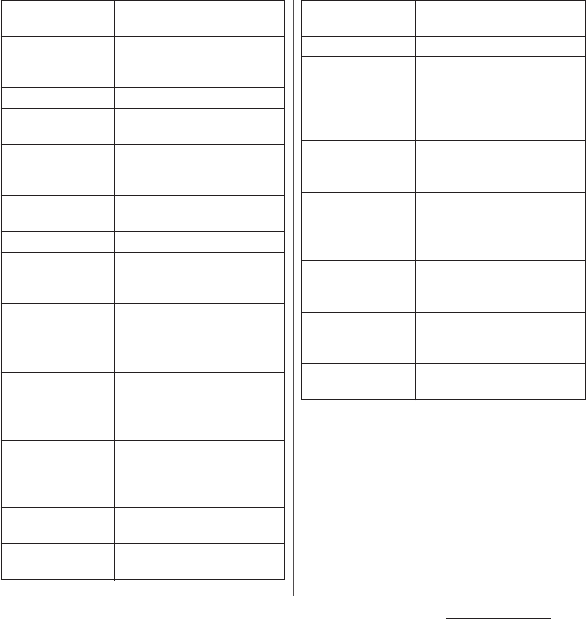
86
docomo Palette UI
2
Select an item.
❖
Information
・
If you install an application from Google Play, the
installed application may be added to the widget list.
・
"IC Tag/Barcode Reader" on the list of widgets can be
added to the Home screen, but it is not available for a
widget.
・
If the Home screen is set to "Xperia
™
", some widgets
is unavailable.
Infrared
Send your profile or receive a
file via infrared.
i
チャネルウィジェッ
ト
(i-channel
widget)
Display latest information such
as news or weather.
Music Unlimited
Display Music Unlimited.
NFC Quick Launch
Enable/disable NFC Reader/
Writer, P2P function.
NOTTV
ウィジェット
(NOTTV widget)
Watch programs, contents, etc.
of Mobacas (a broadcasting
service for smartphone).
OfficeSuite Recent
History
Display OfficeSuite recent
history.
Personal area
Display personal area.
Phonebook
Display contacts using
phonebook application
provided by DOCOMO.
Phonebook Select
members
Display history of calls or
message (SMS) of 3 contacts
selected from the phonebook
fixed/at random.
Play - My Library
Display videos or books
managed in Google Play by
selecting from "My Library", "My
Book" or "My Movie".
Play
Recommendations
Display applications
recommended by Google Play
by selecting from "All", "Apps",
"Books" or "Movies".
Play Store
Display applications
recommended by Google Play.
Schedule & Memo
Display memos or photo
memos on the calendar.
Screen mirroring
Enable/disable Screen
mirroring.
TrackID
™
Display TrackID.
Traffic
Enter a widget name and
destination to activate the
widget showing travel time to
the destination. Tap to check
supplied traffic information.
YouTube
Display the list of frequently
played videos and
recommended.
カテゴリナビ
(Category
navigation)
Display topics or search
information by selecting
category such as foodie and
transfer information.
スマホなるほどツ
アーズ
(Tips of
smartphone)
Display
スマホなるほどツアーズ
(Tips of smartphone).
マチキャラ
(Machi-
chara)
Display missed calls etc. or use
しゃべってコンシェル
(Shabette
concier).
診断ツールアプリ
(Diagnosis tool app)
Activate diagnosis tool.
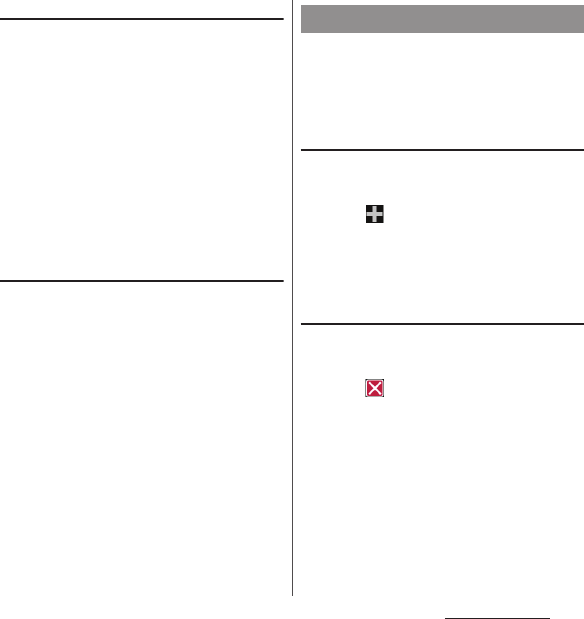
87
docomo Palette UI
Adding a folder to the Home screen
1
On "Select an action" menu screen
(P.84), tap [Folder].
・
A folder is added on the Home screen.
❖
Information
・
To rename a folder, tap a folder you want to rename
and tap the name entry field to enter a folder name,
then [
完了
(Done)] on the software keyboard and
then tap on the screen. Alternatively, touch and hold
a folder you want to rename and tap [Edit name],
then enter a folder name and then tap [OK].
・
To move a shortcut into a folder, touch and hold a
shortcut, then drag it onto any folder.
Adding a group to the Home screen
1
On "Select an action" menu screen
(P.84), tap [Group].
2
Select an item you want to add.
❖
Information
・
Alternatively, on the Application screen (P.90), touch
and hold a group name and then tap [Add].
You can add, delete, sort home screens while
the home screen list is displayed.
・
For details on the home screen list, see
"Displaying a list of home screens" (P.84).
Adding a home screen
1
From the Home screen, pinch-in.
・
A home screen list appears.
2
Tap .
❖
Information
・
There are 3 home screens by default. The terminal
can display up to 12 home screens.
Deleting a home screen
1
From the Home screen, pinch-in.
・
A home screen list appears.
2
Tap of thumbnail you want to
delete on the Home screen.
❖
Information
・
Alternatively, on the home screen list, touch and hold
a thumbnail of home screen you want to delete and
tap [Delete].
Changing the Home screen
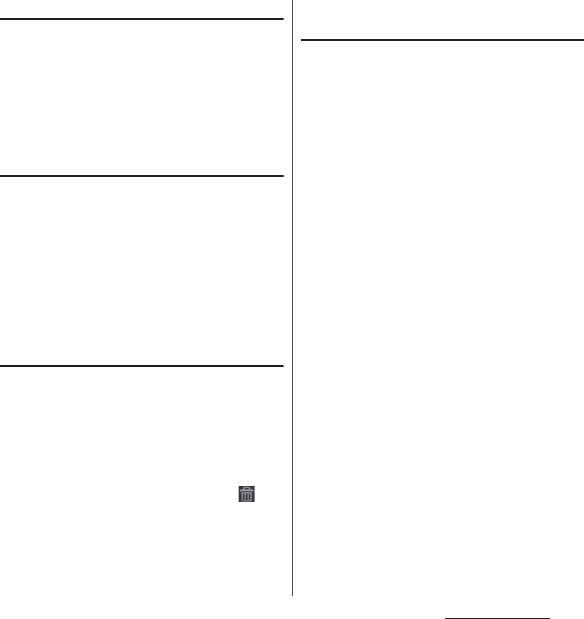
88
docomo Palette UI
Sorting home screens
1
From the Home screen, pinch-in.
・
A home screen list appears.
2
Touch and hold a home screen you
want to sort.
3
Drag it anywhere.
Moving an icon on the Home screen
1
From the Home screen, touch an
icon you want to move.
2
Drag it anywhere.
・
To move to another Home screen, keep
touching the icon and drag it to left or
right.
Deleting an icon from the Home
screen
1
From the Home screen, touch and
hold an icon you want to delete.
2
Tap [Delete].
❖
Information
・
Alternatively, touch and hold an icon you want to
delete from the Home screen and drag it to
displayed at the bottom of the screen.
Uninstalling a shortcut or widget on
the Home screen
・
Before uninstalling application, back up
contents related to the application or widget
that you want to save including data saved in
the application or widget.
・
Some applications or widgets may not be
uninstalled.
1
From the Home screen, touch and
hold a shortcut or widget you want
to uninstall.
2
Tap [Uninstall].
・
A confirmation screen appears for
uninstall.
3
Tap [OK]
u
[OK].
❖
Information
・
You can also uninstall application from the Settings
menu (P.193). For details, see "Deleting installed
application" (P.212).
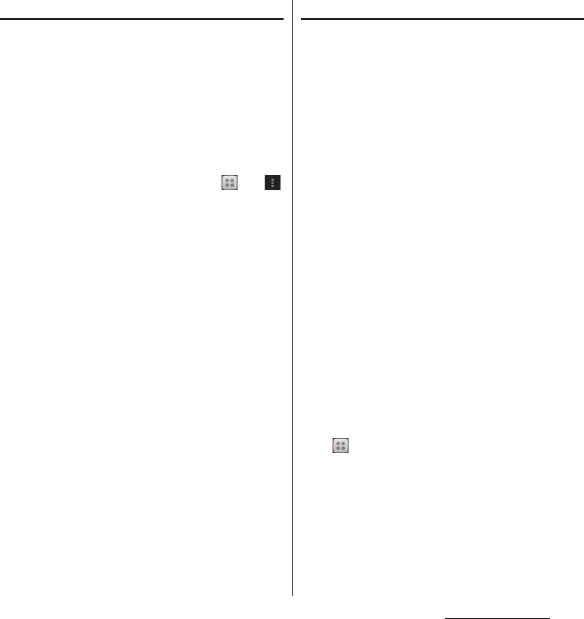
89
docomo Palette UI
Changing Kisekae
1
On "Select an action" menu screen
(P.84), tap [Kisekae].
2
Flick left or right and tap a Kisekae
you want to change to.
❖
Information
・
Alternatively, in Step 2, select Kisekae you want to
change to and tap [Set] to change Kisekae.
・
Alternatively, from the Home screen, tap and
then tap [Kisekae] to change.
・
You can add Kisekae contents by tapping [Search] to
download from website. To delete added Kisekae
contents, select the image and tap
[Delete]
u
[Delete].
Changing wallpaper
1
On "Select an action" menu screen
(P.84), tap [Wallpaper].
2
Tap any of [Album]/[Live
Wallpapers]/[Xperia
™
wallpapers].
・
When you tap [Album], select an image
and set range of the image by dragging
or pinching to adjust the cropping
frame, and then tap [Crop] to set
wallpaper.
・
When you tap [Live Wallpapers], select
a content and tap [Set wallpaper].
For some contents, you can change
type or contents displayed on the
wallpaper by tapping [Settings...].
・
When you tap [Xperia
™
wallpapers],
select an image and tap [Set wallpaper].
❖
Information
・
You can also download wallpapers from websites
and add it.
・
Alternatively, you can change from the Home screen,
tap and tap [Settings]
u
[Display]
u
[Wallpaper].
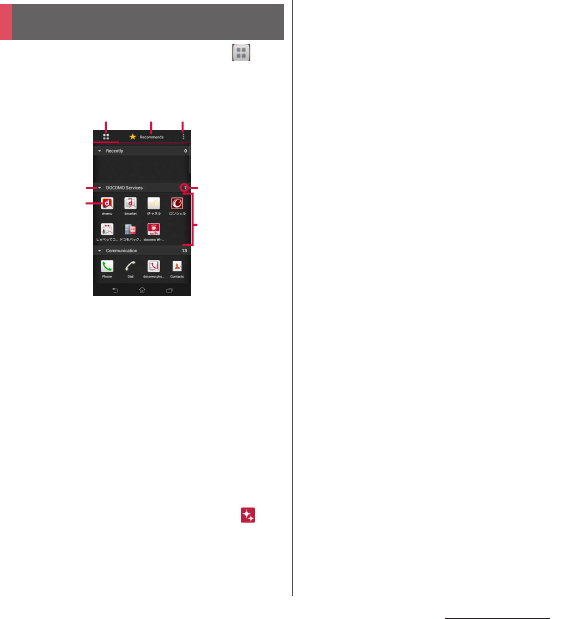
90
docomo Palette UI
1
From the Home screen, tap
(Applications button).
・
The Application screen appears.
a
Application tab
・
View Application screen.
b
Recommends tab
・
Install applications recommended by DOCOMO
(P.93).
c
Optional menu icon
・
View optional menu such as Settings.
d
Group name
・
You can manage applications by groups.
・
Tap a group name to show/hide applications in
the group.
e
Application icon
・
When you download an application from website
or a downloaded application is updated,
appears on the upper left of the application icon.
・
Some application icons are displayed with a
number of missed calls, unread mails, etc.
f
Number of applications in the group
g
Applications in the group
・
To display/hide applications in all groups, pinch-
out/in the Application screen.
❖
Information
・
When the instruction guide for the Application
screen appears, tap [Do not show this again]/[OK].
・
To close the Application screen, tap
x
or
y
.
・
Touch and hold an application icon, then tap [About]
to check the application information.
・
If you selected Japanese as a language in Initial
settings (P.38), some group names are displayed in
Japanese even after the language setting is changed.
These group names can be changed to English (P.92).
Application screen
df
g
e
abc

91
docomo Palette UI
From the Application screen, you can add or
move application icons, or uninstall
applications.
Adding an application shortcut to the
Home screen
1
From the Application screen, touch
and hold an icon you want to add
to the Home screen.
2
Tap [Add].
・
The application icon is added onto the
Home screen.
❖
Information
・
Touch and hold an area of the Home screen where
no icons are displayed and tap [Shortcut]
u
[Application] and select an application to add an
icon.
Moving application
1
On the Application screen, touch
and hold an icon to move.
2
Drag it anywhere.
・
The application icon is moved.
❖
Information
・
Touch and hold an application icon on the
Application screen, tap [Move] and select group, the
group of application icons is changed.
Uninstalling an application
Some application icons can be deleted from
the Application screen.
・
Before uninstalling application, back up
contents related to the application that you
want to save including data saved in the
application.
・
Some applications may not be uninstalled.
1
From the Application screen, touch
and hold an icon of application
you want to uninstall.
2
Tap [Uninstall].
・
A confirmation screen appears for
uninstall.
3
Tap [OK]
u
[OK].
❖
Information
・
You can also uninstall them from the Settings menu
(P.193). For details, see "Deleting installed application"
(P.212).
Managing applications
Changing the Application
screen

92
docomo Palette UI
Adding group to the Home screen
1
From the Application screen, touch
and hold an icon you want to add
to the Home screen.
2
Tap [Add].
・
Shortcuts to the group is added to the
Home screen.
❖
Information
・
Touch and hold an area of the Home screen where
no icons are displayed and tap [Group] and select a
group to add a shortcut.
Changing the color of group name
1
From the Application screen, touch
and hold a group you want to
change the color.
2
Tap [Edit label] and select label
color to change.
・
The color for group name is changed.
Deleting group
1
From the Application screen, touch
and hold a group you want to
delete.
2
Tap [Delete]
u
[OK].
・
Application icons belonged to the
deleted group move to the "Download
Application" group.
❖
Information
・
"Recently", "DOCOMO Services", and "Download
Application" groups cannot be deleted.
Changing group name
1
From the Application screen, touch
and hold a group you want to
rename.
2
Tap [Edit name].
3
Enter a group name and tap [OK].
・
The group is renamed.
❖
Information
・
"Recently", "DOCOMO Services", and "Download
Application" groups cannot be renamed.
Changing group
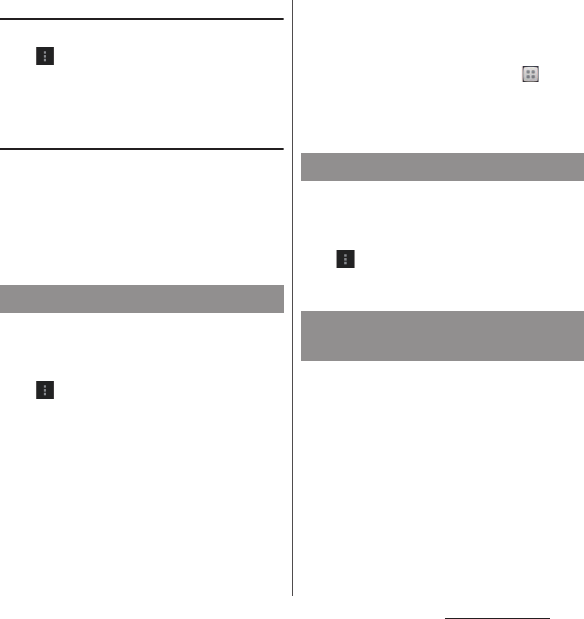
93
docomo Palette UI
Adding group
1
From the Application screen, tap
and tap [Add group].
2
Enter a group name and tap [OK].
・
A new group is added.
Sorting groups
1
From the Application screen, touch
and hold a group name you want
to sort.
2
Drag it anywhere.
・
The group is moved.
Search application installed into the terminal
to activate.
1
From the Application screen, tap
and then tap [Search].
・
The software keyboard appears.
2
Enter application name to search.
・
Search suggestions appear as you enter
a character.
3
Tap an application name.
・
The application activates.
❖
Information
・
If a Google account is set, the Google Now screen
appears in Step 1 in portrait view. Follow the
onscreen instructions.
・
Alternatively, from the Home screen, tap , then
tap [Google] to search application. For details, see
"Searching information in the terminal and web
pages" (P.57).
Icons on the Application screen can be
displayed in a list or tiles.
1
From the Application screen, tap
and then tap [List format]/[Tile
format].
The "Recommends" tab (P.90) in the
Application screen shows applications
recommended by DOCOMO.
1
From the Application screen, tap
"Recommends" tab.
2
Tap [
おすすめアプリを見る
(See
recommended applications)].
3
Select an application to use.
・
Download screen appears. Follow the
onscreen instructions.
Searching for an application
Switching application screens
Installing "Recommends"
applications
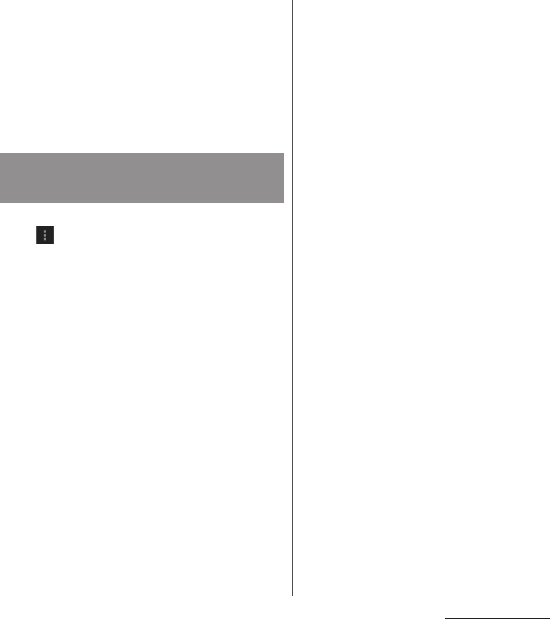
94
docomo Palette UI
❖
Information
・
If you tap [
おすすめアプリをすべて見る
(See all
recommended apps)] in Step 3, Browser activates
and applications recommended by DOCOMO are
displayed in a list.
・
Downloaded applications are displayed in
"Download Application" group in the Application
screen.
1
From the Application screen, tap
and then tap [Application info].
・
The home application information
appears.
Checking Home application
information
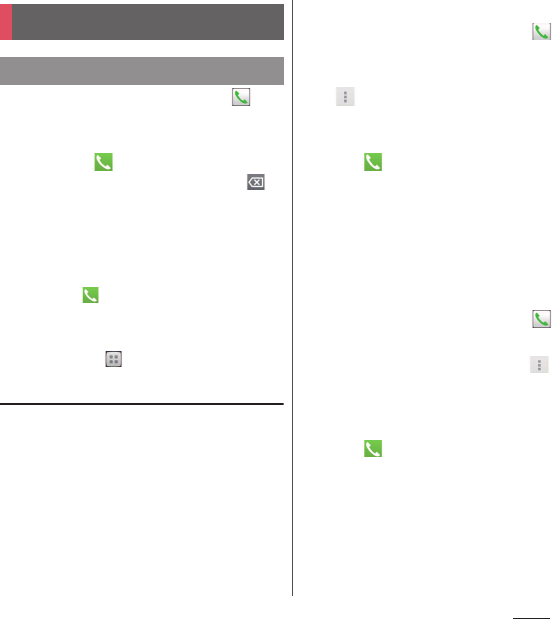
95
Phone
Phone
1
From the Home screen, tap ,
then tap "Dial" tab.
2
Enter the number of the recipient
and tap .
・
If a wrong number is entered, tap to
delete the number.
3
When the call is finished, tap [End
call].
❖
Information
・
In Step 2, tap without entering a phone number
to enter the phone number registered as the latest
call in Recent calls.
・
To activate Xperia
™
phone application, from the
Home screen, tap , then tap [Dial].
Entering pause (,), (;) to send
For using services requiring entry of number
during a call such as check of the balance of a
bank account, reservation of tickets, etc.,
enter an additional number to a phone
number beforehand and make a call.
■
Using 2-second pause (,)
1
From the Home screen, tap ,
then tap "Dial" tab.
2
Enter the phone number, then tap
and tap [Add 2–sec pause].
・
Pause (,) is entered.
3
Enter an additional number, then
tap .
・
Added number will automatically be
sent approximately 2 seconds after the
call is made.
4
When the call is finished, tap [End
call].
■
Using a wait (;)
1
From the Home screen, tap ,
then tap "Dial" tab.
2
Enter a phone number, tap and
tap [Add wait].
・
Pause (;) is entered.
3
Enter an additional number, then
tap .
・
When a call is received, a confirmation
screen asking if you send the added
number appears. Select "Yes" or "No".
4
When the call is finished, tap [End
call].
Making/Receiving a call
Making a call
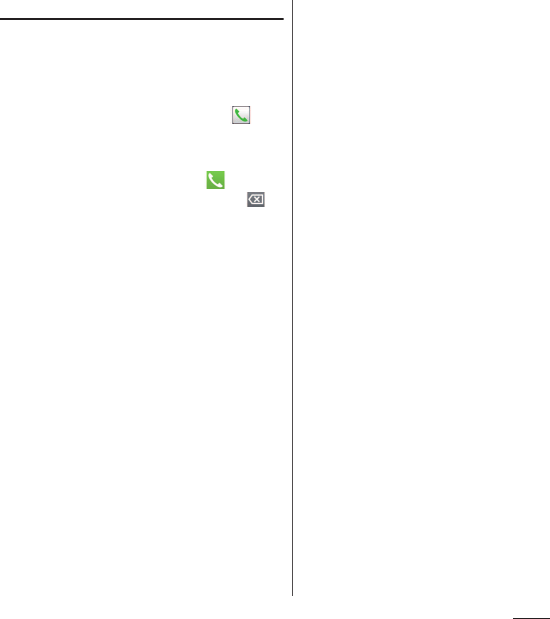
96
Phone
Emergency call
When the terminal is within range of the
service area, you can make an emergency call
of 110 (Police), 119 (Fire and ambulance), or
118 (Japan Coast Guard).
1
From the Home screen, tap ,
then tap "Dial" tab.
2
Enter the number of the
emergency call and tap .
・
If a wrong number is entered, tap to
delete the number.
3
When the call is finished, tap [End
call].
❖
Note
・
If docomo mini UIM card is not inserted to the
terminal, emergency calls (110, 119, 118) cannot be
made in Japan.
・
You can make an emergency call by tapping
[Emergency call] on the unlock screen. In Japan,
however, on the PIN code entry screen, while PIN
code locked or while PUK locked, emergency calls
(110, 119, 118) cannot be made.
・
This terminal supports "Emergency call location
information". If you use the terminal to place a call to
emergency numbers such as 110, 119, or 118, the
information of a location where you are calling from
(location information) is automatically notified to the
Emergency call acceptance organization such as the
Police Station.
The Emergency call acceptance organization may not
be able to figure out your exact location depending
on the location where you place a call or radio wave
condition.
If you make a call hiding your caller ID, such as by
entering a phone number with "184" for each call, the
location information and phone number are not
notified. However, the Emergency call acceptance
organization may decide to obtain the location
information and phone number regardless of your
settings when they consider it is necessary for
lifesaving, etc. Note that the areas/time for which the
"Emergency call location information" is ready to be
used vary depending on the preparatory state of each
Emergency call acceptance organization.
・
When calling 110, 119 or 118 for emergency from the
terminal, tell that you are calling from a mobile
phone, and give your phone number and your
current location precisely for checking callback from
the police/fire department. Also, make a point to call
in a stationary position to prevent the call from being
dropped. Do not power off the terminal for at least
10 minutes after the emergency call just in case the
Police or Fire/Ambulance may have to get in contact
with you.
・
Note that you may not connect to the local Fire
Department or Police Station depending on where
you are calling from. In this case, try to call from a
public phone or a land-line phone in the
neighborhood.
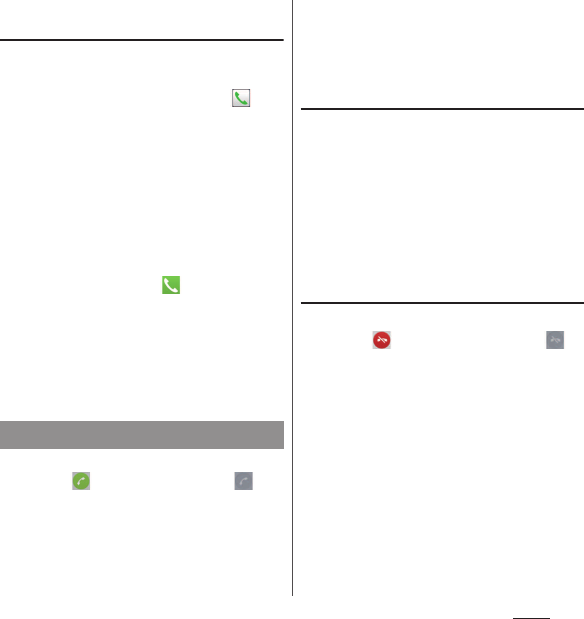
97
Phone
Making an international call (WORLD
CALL)
For details on WORLD CALL, refer to
DOCOMO International Services website.
1
From the Home screen, tap ,
then tap "Dial" tab.
2
Touch and hold [0] key until "+"
sign appears.
・
When making an international call, "+"
is replaced by an international access
code.
3
Enter Country code
u
Area code
(City code)
u
The number of the
recipient and tap .
・
If the area code begins with "0", omit "0".
However, "0" may be required to dial to
some countries or areas such as Italy.
4
When the call is finished, tap [End
call].
1
While receiving a call, touch and
hold (left) and drag it to
(right).
2
When the call is finished, tap [End
call].
❖
Information
・
Even if the screen lock is set, you can answer a call by
the same operation.
Muting the ringtone for an incoming
call
1
When receiving a call, press
m
/
P
.
❖
Information
・
You can stop vibration by pressing
m
/
P
when silent mode (vibration) is set.
・
On the Home screen etc., press upper or lower of
m
to adjust the ringtone volume. For silent
mode setting, see "Setting silent mode" (P.41).
Declining a call
1
While receiving a call, touch and
hold (right) and drag it to
(left).
❖
Information
・
Even if the screen lock is set you can reject a call by
the same operation.
・
If you reject an incoming call during use of Voice Mail
Service, the call is connected to the Voice Mail
service center.
Receiving a call
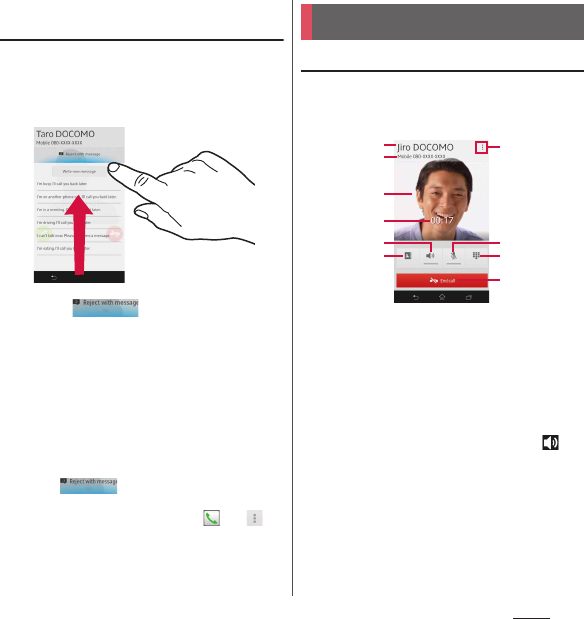
98
Phone
Declining an incoming call and
sending a message (SMS)
When you cannot answer a call, you can
reject the call and send a message (SMS).
Message to send is registered in advance, and
you can edit it if necessary.
1
Drag upwards when
receiving a call.
2
Tap a message to send.
・
The message (SMS) is sent to the caller.
❖
Information
・
While Voice Mail service is in use, a call is rejected and
a message (SMS) is sent then the caller is connected
to the Voice Mail service center.
・
To create a new message to send, when receiving a
call, drag up and tap [Write new
message] to create a message and send. To edit a
message, from the Home screen, tap and ,
then tap [Call settings]
u
[Reject call with message] to
select and edit an existing message, then tap [OK].
Calling screen
On the Calling screen, you can set
speakerphone or mute, or enter a phone
number to make a call to another party.
a
Name of the other party
b
Number of the other party
c
A photo saved in Phonebook
d
Call duration time
e
Speaker : Set speakerphone on/off.
・
Other party's voice can be heard from the speaker
and handsfree call can be made.
・
When you switch to the other screen such as the
Home screen with the speakerphone on,
appears in the status bar.
f
Phonebook : View phonebook entry list screen
(P.103).
g
Option menu : Set Hold during a call.
・
To cancel Hold, tap [Retrieve call] during Hold.
・
To set a call on hold, "Call waiting" subscription is
required (P.101).
Operations during a call
a
j
i
c
d
h
bg
e
f
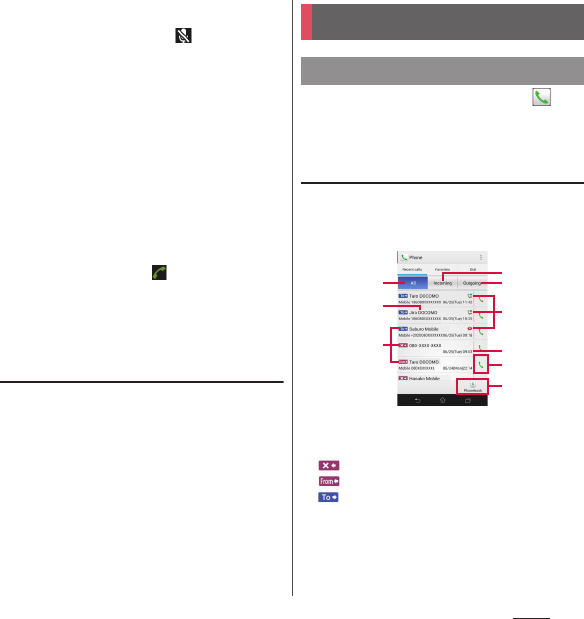
99
Phone
h
Mute : Turn the microphone on/off during a call.
・
When you switch to the other screen such as the
Home screen with Mute on, appears in the
status bar.
i
Dial key : Enter the phone number you want to add
to make a call.
・
The ongoing call is automatically on hold.
・
To add a call, "Call waiting" subscription is
required (P.101).
j
Ending a call
❖
Note
・
Do not bring the terminal close to your ear with the
speakerphone on to avoid from hearing damage.
❖
Information
・
When you switch to the other screen such as the
Home screen during a call, appears in the status
bar. Drag the status bar and tap [Ongoing call] to
display the calling screen. Tap [Mute] to set Mute to
on/off for the microphone, or tap [Hang up] to end
the call.
Adjusting the earpiece volume
1
During a call, press
m
to
adjust.
❖
Information
・
You can adjust the earpiece volume only during a
call.
1
From the Home screen, tap ,
then tap "Recent calls" tab.
・
Recent calls screen appears.
Recent calls screen
Incoming call and outgoing call are displayed
by chronological order in the Recent calls
screen.
a
All tab
b
Phone number/name
c
History icons
: Missed call
: Incoming call
: Outgoing call
d
Incoming tab
e
Outgoing tab
Call history
Showing call history
a
b
c
e
g
i
d
h
f
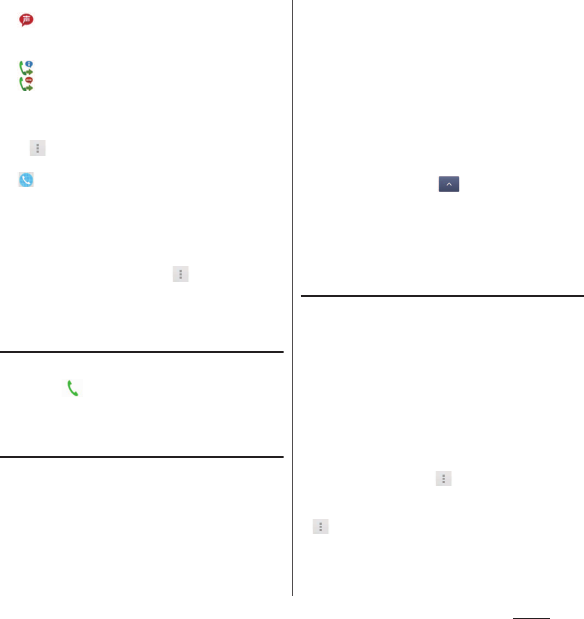
100
Phone
f
Call status icons
: Koe-no-Takuhaibin
・
For details on Koe-no-Takuhaibin, refer to "Koe-
no-Takuhaibin" (P.101) or NTT DOCOMO website.
: Caller ID notified
: Caller ID hidden
・
It appears when prefix "186" (Notify)/"184" (Not
notify) is entered to a phone number to make a
call, or when you enter a phone number and tap
, then tap [Caller ID notification]
u
Tap [Notify]/
[Not notify] to make a call.
: Incoming/outgoing international call
g
Date
h
Outgoing
i
Phonebook
❖
Information
・
On the Recent calls screen, tap and tap [Call
settings] to set/edit "Network service" or "Reject call
with message" (P.101).
Making a call from Recent calls
1
On the Recent calls screen (P.99),
tap .
Adding a number from the Recent
calls to Phonebook
1
On the Recent calls screen (P.99),
tap a phone number and tap [Add
Phonebook].
・
Alternatively, touch and hold a phone
number, tap [Edit number before
call]
u
[Add Phonebook].
2
Tap [Register new] or a phonebook
to add.
・
When you set a Google account etc.,
tap [Register new] so that you can
select that account as a registration
account.
3
On the Edit profile screen, enter
required items.
・
You can set a name, mail address,
group, etc. Tap in "Others", tap
[Add] of an item you want to register,
and then enter.
4
Tap [Save].
Deleting a call history
1
On the Recent calls screen (P.99),
touch and hold an item you want
to delete in outgoing call log/
incoming call log.
2
Tap [Delete from call log]
u
[OK].
❖
Information
・
To delete all items from Incoming log or Outgoing
log, on the Recent calls screen, tap "Incoming" tab/
"Outgoing" tab and tap , then [Delete all]
u
[OK].
・
To delete all items from Incoming log and Outgoing
log, on the Recent calls screen, tap "All" tab and tap
, then [Delete all]
u
[OK].
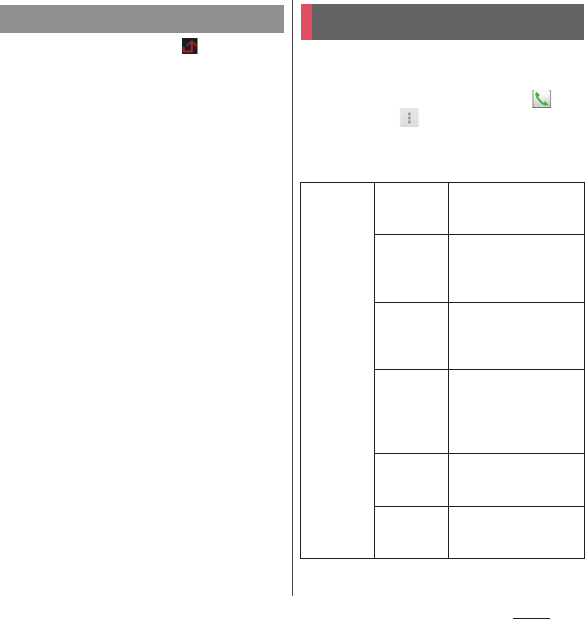
101
Phone
When you have missed calls, appears in
the status bar.
1
Drag the status bar downwards.
2
Tap [Missed call].
・
Recent calls screen appears.
❖
Information
・
For 1 missed call, drag the status bar, "Call back" and
"Message" are displayed below "Missed call". Tap [Call
back] to make a call to the party of the missed call, or
tap [Message] to compose message (SMS) to send to
the party. "Call back" and "Message" may not appear
depending on notifications in the Notification panel.
For multiple missed calls, number of calls appears
below "Missed call".
・
When you have missed calls, an icon appears on the
unlock screen to show that you have missed calls
and a number of those.
You can set the network services, register call
rejection or edit Reject call with message.
1
From the Home screen, tap ,
then tap .
2
Tap [Call settings].
・
You can set the following options.
Displaying missed calls
Call settings
Network
service
Koe-no-
Takuhaibin
Koe-no-Takuhaibin is a
service of taking voice
messages for you.
Voice mail
service
It is a service of taking
caller's message when
you cannot answer an
incoming call.
Call
forwarding
service
It is a service of
transferring call when
you cannot answer an
incoming call.
Call Waiting
It is a service of putting
the current call on hold
and answering an
incoming call or making
a call to another party.
Caller ID
notification
Notify the display of the
recipient phone of your
phone number.
Nuisance
call blocking
service
Register phone numbers
of nuisance call to reject.

102
Phone
Network
Service
Caller ID
display
request
service
Request number
notification for calls
without phone number
with guidance.
Second call
settings
Set action for a second
call.
Call
notification
Notify incoming calls by
message (SMS) while the
power is off or you are
out of service area.
English
guidance
Switch the voice
guidance to English or
Japanese.
Remote
operation
settings
Set to operate Voice Mail
Service or Call
forwarding Service using
land-line phone, public
phone or DOCOMO
mobile phone, etc.
Roaming
settings
Set to reject incoming calls overseas or
use roaming guidance (P.254).
Advanced
call settings
Sub address
settings
Set whether "*" in phone
number is identified as a
sub address separator.
Prefix
settings
Register a prefix number
added before phone
number when making a
call.
Reject
unregistered
call
Set whether to reject an
incoming call with
unregistered phone
number in the
phonebook
automatically.
Sound &
Vibration
settings
Phone
ringtone
Set ringtone (P.206).
Vibrate
when
ringing
Set whether to sound
ringtone and vibrate the
terminal when there is an
incoming call (P.206).
Dial pad
touch tones
Set whether to emit
dialpad operation sound
(P.206).
Reject call
with
message
Edit/set a message (SMS) to be sent
when rejecting an incoming call.
Microphone
noise
suppression
Make the voice clear to understand for
the other party during a call.
Accounts
Set Internet phone (SIP) account.
Use Internet
calling
Set Internet phone (SIP) call method.
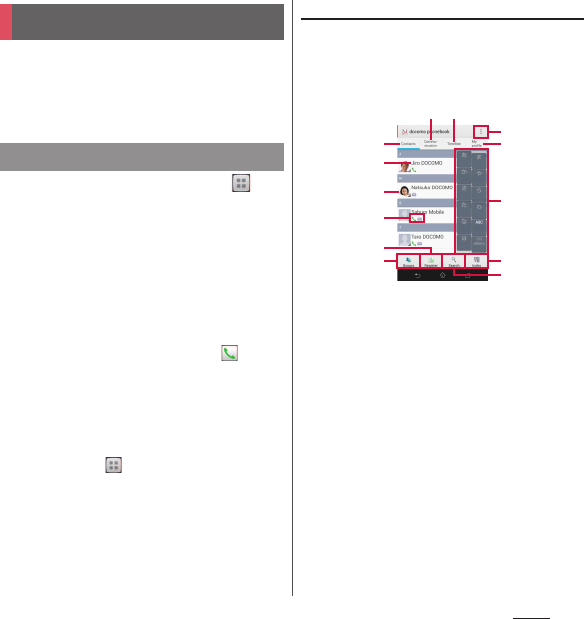
103
Phone
On the phonebook, you can enter various
information for contacts, for example, phone
numbers, mail addresses and various service
accounts.
1
From the Home screen, tap ,
then tap [docomo
phonebook]
u
"Contacts" tab.
・
The phonebook list screen appears.
❖
Information
・
When you use for the first time, "Use of Cloud" screen
appears. Tap [Start] to start using Cloud. Cloud
service in phonebook require DOCOMO's
phonebook application.
・
Alternatively, from the Home screen, tap and tap
[Phonebook] to display phonebook list screen.
・
Phonebook data can be backed up in a microSD card
using "
ドコモバックアップ
(docomo backup)"
application. For information on backing up, see "
ドコ
モバックアップ
(docomo backup)" (P.190).
・
To activate Xperia
™
phone application, from the
Home screen, tap , then tap [Contacts].
Phonebook list screen
On the phonebook list screen, you can view
details of your contacts. You can add a
picture to a phonebook entry, and display
phonebook entries by group.
a
Contacts tab
b
Name registered in the phonebook entry
c
Entry items
・
Icons indicate entry items.
d
Photo set in the phonebook entry
e
Register
f
Groups
・
Select a group to be displayed.
g
Communication tab
・
Call history or history of message (SMS), sp-mode
mail and SNS messages are displayed. SNS
messages are displayed only when using "My
SNS" function after using Cloud is started.
h
Timeline tab
・
Timeline of SNS/blog by "Friend NEWS" function
and "My SNS" function is displayed. To display,
start using Cloud.
i
Option menu
Phonebook
Displaying phonebook
l
a
g h
c
d
b
f
e
j
i
k
m
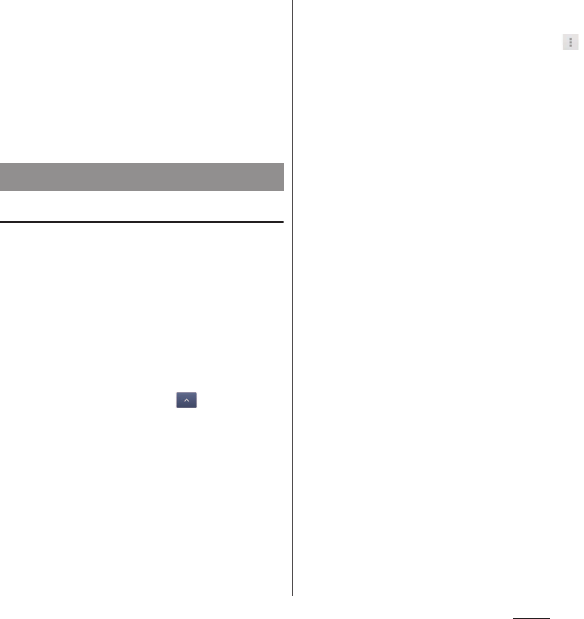
104
Phone
j
My profile tab
・
Check your own phone number.
k
Index character area
・
Tap index character to display phonebook entries
allocated to the index character.
l
Index
・
Display the index character to search entries in
the order of Japanese syllabary, alphabet, etc.
m
Search
Adding a new phonebook entry
1
On the phonebook list screen
(P.103), tap [Register].
・
When you set a Google account etc.,
you can select that account as a
registration account.
2
On the Edit profile screen, enter
required items.
・
You can set a name, phone number,
mail address, etc. Tap in "Others",
tap [Add] of an item you want to
register, and then enter.
3
Tap [Save].
❖
Information
・
To check the number of registered data in the
phonebook, from the phonebook list screen, tap ,
then tap [Others]
u
[About].
・
When you save "Phonetic name (first/last)",
phonebook list is displayed according to Japanese
syllabary order or alphabets order of "Phonetic
name". If you enter "First name/Last name" in Kanji
without entering "Phonetic name" to add
phonebook entry, the name appear in "ABC" field on
the phonebook list screen.
・
If "docomo" account is selected as saving location
when registering phonebook entries, SNS/Blog
accounts can be set.
・
To set default phone number or mail address from
multiple phone numbers or mail addresses, on the
Profile screen, touch and hold a phone number or
mail address, then tap [Make default number]/[Make
default address]. The phone number or mail address
is marked on the right. To cancel the setting, on the
Profile screen, touch and hold phone number or mail
address, then tap [Clear default number]/[Clear
default address].
Managing phonebook
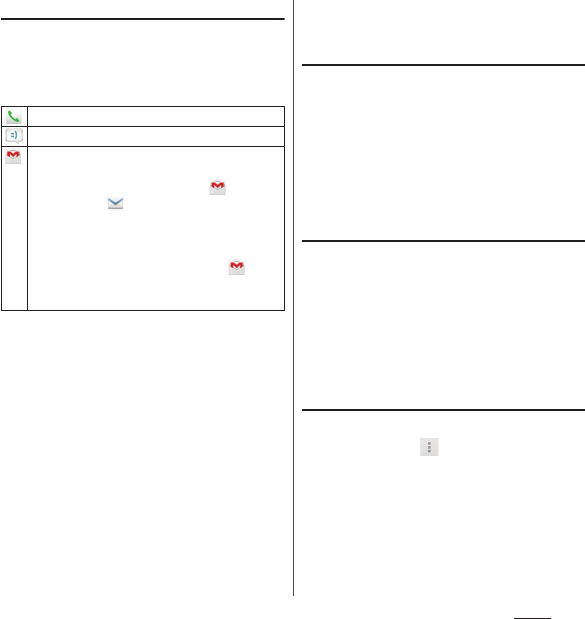
105
Phone
Using phonebook shortcuts
When you tap the photo (image) part on the
phonebook list screen (P.103), shortcuts for
phone, mail, etc. appear. Tap the shortcut to
make a call, or create and send a mail.
❖
Information
・
You can use other functions such as displaying a map
from the registered addresses with shortcut.
・
When multiple phone numbers or mail addresses are
saved, a selection screen appears by tapping a
shortcut. If you mark "Save this selection" and then
select a phone number, mail address, etc. the
selection screen does not appear next time you use
the shortcut.
・
When multiple phone numbers or mail addresses are
saved, if default phone number or mail address is set,
the selection screen does not appear by tapping a
shortcut.
・
When you tap a part other than photo (image) on
the phonebook list screen, profile screen of the
phonebook appears instead of shortcuts.
・
For a phonebook entry with only name, tapping
photo (image) does not display shortcuts.
Making a call using the phonebook
1
On the phonebook list screen
(P.103), tap a phonebook entry to
call.
2
On the Profile screen, tap a phone
number.
3
Tap [Call].
Searching for a phonebook entry
1
On the phonebook list screen
(P.103), tap [Search].
2
Enter name or reading to search.
・
All phonebook entries beginning with
those letters (First name/Last name)
appear.
Changing contacts display order
1
On the phonebook list screen
(P.103), tap , then tap
[Others]
u
[Contacts display order].
2
Tap any of [Japanese order]/
[Alphabetical order]/[Number
order].
Call to registered phone number.
Create and send message (SMS).
Select Email application to create and send an
email.
・
When you set an Email account, is
displayed as .
・
On the application selection screen, select
"Always" or "Just once" after selecting Email
application.
・
If you do not set Gmail account, tap to
display a setting wizard. After an account is set,
you can create and send mails.

106
Phone
Changing accounts to display
You can set registered phonebook entries to
be displayed in the phonebook list.
1
On the phonebook list screen
(P.103), tap , then tap
[Others]
u
[Accounts to display].
2
Tap [Display all accounts]/
[Customize…].
・
When you set a Google account etc.,
you can select docomo account,
Google account, etc. as an account to
display.
・
Tap [Customize...], select a checkbox for
each account, and then customize
display of the phonebook list screen.
Displaying phonebook entries by
group
1
On the phonebook list screen
(P.103), tap [Groups].
2
Select a group.
・
Phonebook entries are displayed by the
group set when the entry is registered.
・
To hide the group, tap [Close].
Setting group for phonebook entry
Set a group from phonebook list screen.
1
On the phonebook list screen
(P.103), tap [Groups].
2
Touch and hold a phonebook entry
to set a group, and then drag it to
any group.
❖
Information
・
To cancel group setting, touch and hold a
phonebook entry you want to cancel and then drag
it to the set group, or tap a phonebook entry you
want to cancel and from the profile screen, tap
[Edit]
u
[Setting] in Group
u
Unmark group and tap
[OK]
u
[Save].
・
When you set Google account etc., display groups by
account. You can set/cancel group in the same
account.
Creating a new group in Phonebook
1
On the phonebook list screen
(P.103), tap [Groups]
u
[Add].
・
When "Add" is not displayed, flick up
groups to display.
・
When you set a Google account etc.,
you can select that account for adding.
2
On the group addition screen,
enter color, icon, group name, and
tap [OK].
・
The items vary depending on the
account type.
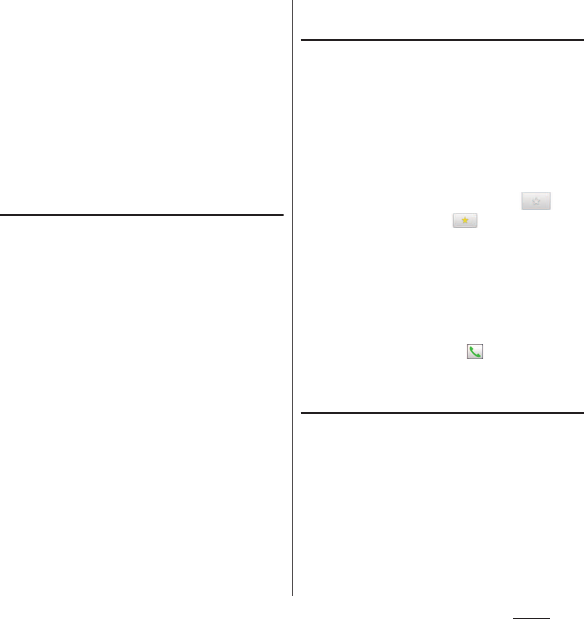
107
Phone
❖
Information
・
You can edit/delete newly created groups and
"Family"/"Friends"/"Company", which are saved by
default. To edit a group, touch and hold a group and
tap [Edit group], then enter editing content and tap
[OK]. To delete a group, touch and hold a group and
tap [Delete group]
u
[OK]. Phonebook entries
belonged to the deleted group move to the "No
group" tab.
・
For one account, you cannot add a group that has
the same name as existing groups.
Editing a phonebook entry
1
On the phonebook list screen
(P.103), tap a phonebook entry to
edit.
2
On the profile screen, tap [Edit].
3
Select a required item and edit.
・
Tap [Add] to set phone number or mail
address, or tap [Del] to delete the set
information.
4
Tap [Save].
❖
Information
・
You cannot edit contacts for the Facebook account.
Registering a phonebook entry to
Favorites
You can mark a phonebook entry as a
favorite. The favorite list provides quick
access to the phonebook entry you have
marked.
1
On the phonebook list screen
(P.103), tap a phonebook entry to
combine.
2
On the profile screen, tap .
・
The icon turns to and the entry is
registered to Favorites.
❖
Information
・
Phonebook entries saved to the docomo account/
Google account can be added to Favorites.
・
To display phonebook entries added to Favorites, on
the phonebook list screen, tap [Groups]
u
[Favorites],
or from the Home screen, tap and then tap
"Favorites" tab.
Setting photo in a phonebook entry
1
On the phonebook list screen
(P.103), tap a phonebook entry you
want to add a photo.
2
On the profile screen, tap [Edit].
3
Tap [Setting] for image.
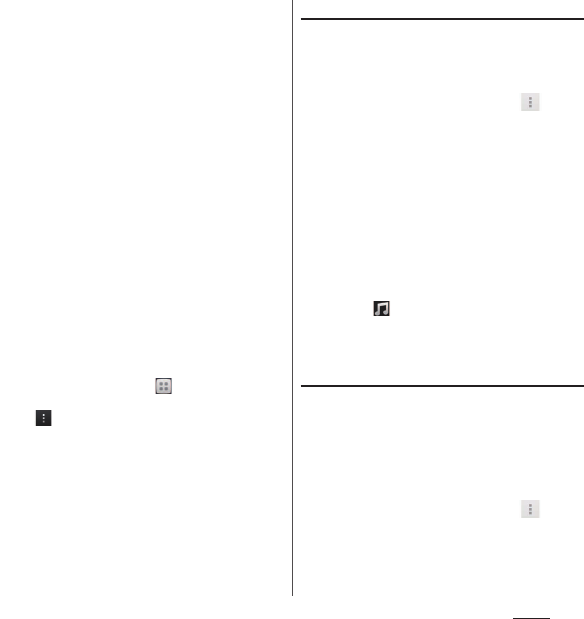
108
Phone
4
Tap [Take photo]/[Select picture].
・
When you tap [Take photo], select
"Camera" or "Picture effect" and then
select "Always" or "Just once" to take a
photo. For information on how to shoot
by "Picture effect", see "Picture effect"
(P.170).
・
When you tap [Select picture], select
"Album" or "File Commander" and then
to select "Always" or "Just once" to
select a picture.
5
Set image range to be displayed,
and then tap [Crop].
・
Drag or pinch to adjust cropping area
to set image range.
6
Tap [Save].
❖
Information
・
You can also set photo to a phonebook entry by the
following operation.
From the Home screen, tap , then tap [Album].
Select an image you want to set and tap the screen
and , then tap [Use as]
u
[Photo of phonebook].
Select a phonebook entry you want to register, set
image range to be displayed, and then tap [Crop].
Setting ringtone
1
On the phonebook list screen
(P.103), tap a phonebook entry to
set ringtone.
2
On the profile screen, tap and
[Set ringtone].
3
Select a ringtone and tap [Done].
❖
Information
・
For docomo account, you can set ringtone by
tapping [Setting] for Ringtone on the Edit profile
screen. For Google account, on Preferred apps
settings (P.214), you can also set "Set all to" or
"Contacts" to "Xperia
™
", then edit phonebook entry
using "Contacts" app to set ring tone.
・
To set a ringtone other than the ones stored by
default, tap .
・
Depending on the saving account, ringtone can be
set when saving a phonebook entry.
Combining phonebook entries
You can bind multiple phonebook entries
together into one.
1
On the phonebook list screen
(P.103), tap a phonebook entry to
combine.
2
On the profile screen, tap and
[Join/Separate].
・
Phonebook entries to be combined are
displayed.
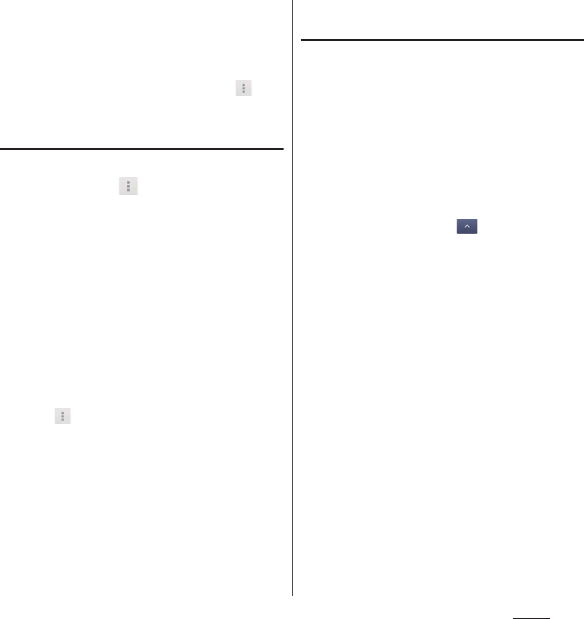
109
Phone
3
Tap the phonebook entry to
combine.
❖
Information
・
To cancel binding, on the profile screen of a
phonebook entry you want to separate, tap , then
tap [Join/Separate]
u
[Separate].
Deleting a phonebook entry
1
On the phonebook list screen
(P.103), tap , then tap [Delete].
2
Mark the phonebook entry you
want to delete.
・
If you want to delete all phonebook
entries, tap "Select all".
・
Tap [Index] to search phonebook to
delete.
3
Tap [Delete]
u
[OK].
❖
Information
・
To delete only a phonebook entry, in the phonebook
list screen, tap a phonebook entry you want to delete
and tap , then tap [Delete]
u
[OK].
Checking My profile and editing
information
1
On the phonebook list screen
(P.103), tap "My profile" tab.
2
Tap [Edit].
3
On the My profile screen, enter
necessary information such as
name.
・
Tap [Add] to set phone number or mail
address, and tap [Set] to add SNS or
Blog account. Tap in "Others", tap
[Add] of an item you want to register,
and then enter.
4
Tap [Save].
❖
Information
・
You can register multiple phone numbers, mail
addresses, SNS/Blog accounts, etc. in My profile.
・
Name card data created with name card creator
application can be saved to My profile and be
exchanged via network. When you use for the first
time, in the phonebook list screen, tap the "My
profile" tab, [Create new] and follow the onscreen
instructions.

110
Phone
Sending phonebook entries via
infrared communication
1
On the phonebook list screen
(P.103), tap , then tap
[Others]
u
[Send via Infrared].
・
To send an entry, tap [Send one], select
entry to send then tap [OK]
u
[OK].
・
To send all phonebook entries, tap
[Send all]
u
Tap [Start], enter docomo
apps password, tap [OK], then enter the
same authentication password as that
of the recipient and tap [OK]
u
[OK]
u
[OK].
❖
Information
・
When sending all phonebook entries via infrared
communication, you need to enter authentication
password an docomo apps password.
Authentication password is a 4-digit number fixed up
between you and other party in advance. For the
docomo apps password, see "docomo apps
password" (P.214).
・
To activate infrared communication in a selected
phonebook entry, tap in the profile screen,
[Infrared]
u
[OK]
u
[OK]. To send My profile, tap "My
profile" tab in the phonebook entry list screen, tap
, [Send via infrared]
u
[OK]
u
[OK]. If a name card is
stored in My profile, tapping [Send via infrared]
opens a screen to select "send my profile" or
"Exchange name card (via infrared)".
・
Phonebook entries can be sent using "Infrared" app.
For details, refer to "Sending data via infrared
communication" (P.233).
Sending phonebook via Bluetooth/
Email/Gmail
Registered phonebook and My profile
information can be sent using Bluetooth
function (P.235), or email attachment
function.
■
Sending phonebook
1
On the phonebook list screen
(P.103), tap a phonebook entry you
want to send.
2
On the profile screen, tap and
[Share].
3
Select a sending method.
・
After this step, follow the onscreen
instructions.
■
Sending phonebook entry currently
displayed
Send all entries displayed in the phonebook
list screen. For conditions for displaying
phonebook entries, see "Changing
accounts to display" (P.106).
1
On the phonebook list screen
(P.103), tap , then tap
[Others]
u
[Import/Export].
2
Tap [Share phonebook data].

111
Phone
3
Select a sending method and tap
[Always]/[Just once].
・
After this step, follow the onscreen
instructions.
■
Sending My profile
1
On the phonebook list screen
(P.103), tap "My profile" tab.
2
Tap and [Share].
3
Select a sending method.
・
After this step, follow the onscreen
instructions.
❖
Information
・
To use Bluetooth function, turn on Bluetooth
function (P.235) in advance, or select
[Bluetooth]
u
[Turn on] in Step 3.
・
To use email, you need to make settings of your
email account (P.117).
・
If you want to send it as an Email/Gmail attachment,
send from a mail composing screen in an account
you have set up. If you do not set a Gmail account, a
setting wizard appears. After an account is set, you
can create and send mails.
・
You cannot send some information such as name
card data set in the phonebook.
You can export/import phonebook entries
from/to a microSD card or docomo mini UIM
card. This is useful, for example, when you
want to move the contact information to
another phone.
❖
Information
・
You can also use a synchronization service for
synchronizing your phonebook. For details, refer to
"Setting Auto-sync" (P.225).
Exporting phonebook to microSD
card
・
Insert a microSD card in advance (P.229).
1
On the phonebook list screen
(P.103), tap , then tap
[Others]
u
[Import/Export].
2
Tap [Export to SD card].
3
Tap any of [Export one contact
data]/[Export some contact data]/
[Export all contact data], then tap
[OK].
・
When you tap [Export one contact
data]/[Export some contact data], mark
a contact to export and tap [OK].
4
Select [No]/[Yes] for attaching
name card.
Exporting/Importing
phonebook entries
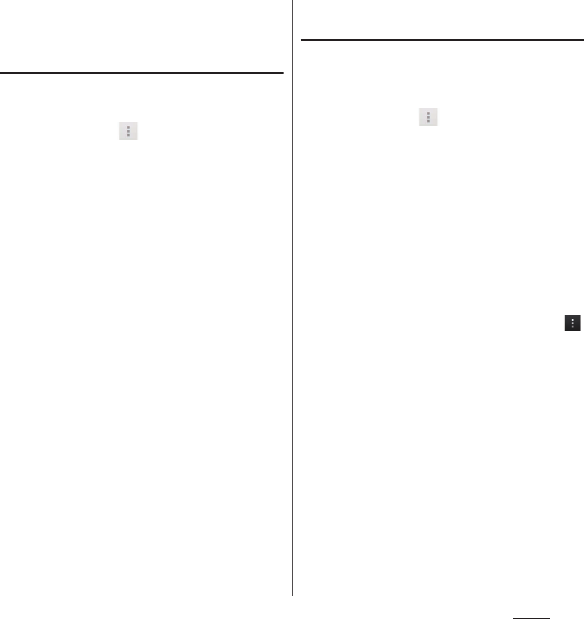
112
Phone
5
Tap [OK].
Importing phonebook from microSD
card
・
Insert a microSD card in advance (P.229).
1
On the phonebook list screen
(P.103), tap , then tap
[Others]
u
[Import/Export].
2
Tap [Import from SD card].
・
When you set a Google account etc.,
you can select that account as an
import account.
・
If there is only one vCard file, the file is
imported immediately.
3
Tap any of [Import one phonebook
data]/[Import multiple phonebook
data]/[Import all phonebook
data], then tap [OK].
・
If you tap [Import one phonebook
data]/[Import multiple phonebook
data], mark vCard files to import, then
tap [OK].
・
If a vCard file has multiple phonebook
entries, they are imported all at once.
❖
Information
・
For some phonebook entries, a part of data may not
be imported or exported.
Importing phonebook entries from
docomo mini UIM card
・
Insert a docomo mini UIM card in advance
(P.30).
1
On the phonebook list screen
(P.103), tap , then tap
[Others]
u
[Import/Export].
2
Tap [Import from SIM card].
・
When you set a Google account etc.,
you can select that account as an
import account.
3
Tap a phonebook entry to import.
・
Phonebook entries are imported.
・
Alternatively, touch and hold a contact
to be imported, tap [Import].
・
To import all phonebook entries, tap
and [Import all].
❖
Information
・
Names and phone numbers can be imported.
・
If there is a phonebook entry whose name is
matched with the imported entry, the entry is
imported as a separated one.
・
To export phonebook entries to docomo mini UIM
card, use "Contacts" app of Xperia
™
. Note that only
name and the first phone number can be saved
because of memory space of docomo mini UIM card.
For some phonebook entries, a part of data may not
be exported.
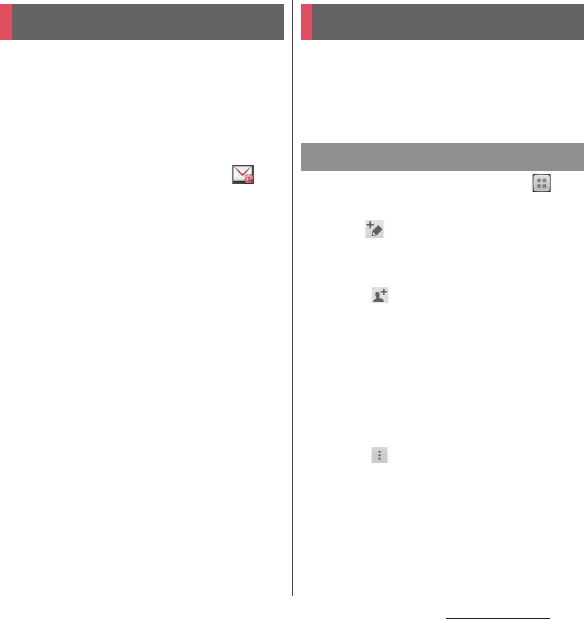
113
Mail/Web browser
Mail/Web browser
Send/receive mails using DOCOMO mail
address (@docomo.ne.jp).
You can use pictogram and Deco-mail. Mails
can be received automatically. For details on
sp-mode mail, refer to "Mobile Phone User’s
Guide [sp-mode]".
1
From the Home screen, tap .
・
After this step, follow the instructions
on the screen.
❖
Information
・
sp-mode mail data can be backed up in a microSD
card using "
ドコモバックアップ
(docomo backup)"
app. For information on backing up, see "
ドコモバッ
クアップ
(docomo backup)" (P.190).
You can send and receive text messages up
to 70 two-byte characters (up to 160 one-
byte characters) with a mobile phone
number as the destination.
1
From the Home screen, tap ,
then tap [Messaging].
2
Tap (New mail).
3
Enter the recipient's phone
number.
・
Tap to display the contacts list
screen to select from registered
contacts. When you enter a name or
phone number in the box at the top of
the screen, a list of contacts matching
the entered numbers or letters appears.
4
Tap [Write message] and enter a
message.
・
Tap and [Select message template]
to enter by selecting message template
registered in "Message template
settings" (P.115).
sp-mode mail Message (SMS)
Sending message (SMS)
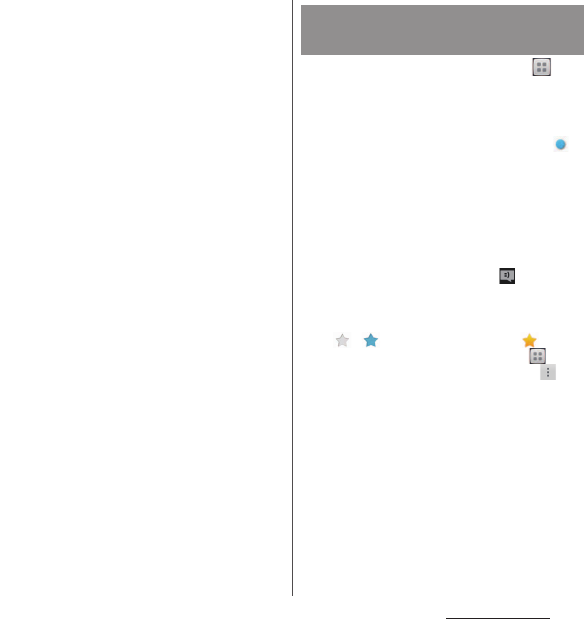
114
Mail/Web browser
・
When the number of entered
characters comes close to a limit, a
number of enterable characters
appears on the upper left of the text
box.
5
Tap [Send].
❖
Information
・
For the character entry, see "Character entry" (P.59).
・
You can also send/receive text messages to/from
customers of overseas network operators. For details,
see "Mobile Phone User’s Guide [International
Services]" or the DOCOMO International Services
website.
・
To send SMS to users of overseas network operators,
enter "+", "Country code" and then "the recipient
mobile phone number". Enter the phone number
without a leading "0", if any. Alternatively, enter "010",
"Country code" then "the recipient mobile phone
number" in order.
To reply to the received a message (SMS) overseas,
you need to create a new message (SMS). To send a
message, in Step 3, enter "010", "Country code" then
"the recipient mobile phone number" in order.
1
From the Home screen, tap ,
then tap [Messaging].
・
Messages (SMS) appear per sender.
Senders with unread messages (SMS)
left are displayed in bold font, and is
displayed to the left.
2
Select a sender whose messages
(SMS) you want to read.
・
A message (SMS) appears.
❖
Information
・
When you receive a message (SMS), appears on
the status bar. To read the message (SMS), drag the
status bar downward and tap a notification of
message (SMS).
・
Tap / in a message (SMS) to add star. To
check starred messages (SMS) in a list, tap from
the Home screen, tap [Messaging], then tap and
tap [Starred messages].
Receiving and reading message
(SMS)
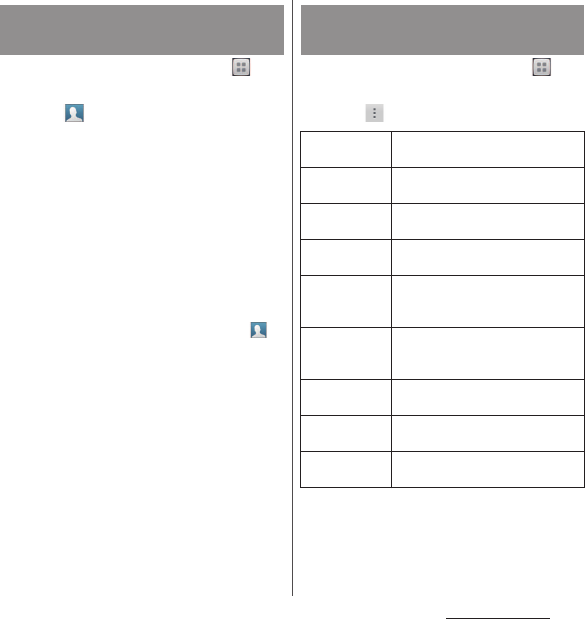
115
Mail/Web browser
1
From the Home screen, tap ,
then tap [Messaging].
2
Tap of phone number to save
and tap [Save].
3
Tap [Register new] or a phonebook
to add.
・
When you set Google account etc., tap
[Register new] to select the account as
a saving location.
4
Enter required items and tap
[Save].
❖
Information
・
For a sender registered to the phonebook, tap or
photo (image) in Step 2 to make a call or display the
phonebook entry.
1
From the Home screen, tap ,
then tap [Messaging].
2
Tap and [Settings].
* While the silent mode (mute) is set, the terminal does
not vibrate when receiving a message (SMS).
Saving phone number of
message (SMS) to phonebook
Changing settings for
Messaging (SMS)
Notification
tone
Set ringtone when receiving a
message (SMS).
Notifications
Set whether to show message (SMS)
arrival notification in the status bar.
Notification
vibration
*
Set whether to vibrate when
receiving a message (SMS).
Notification
light
Set whether to notify message
(SMS) reception by notification LED.
Delivery report
Set whether to mark a message
(SMS) you sent each time a recipient
receives the message (SMS).
Message
template
settings
Register phrase that can be inserted
when writing a text.
SIM messages
Manage messages (SMS) saved to
docomo mini UIM card.
Push settings
Set a message (SMS) sent from the
provider.
SMS center
number
Check SMS center number.
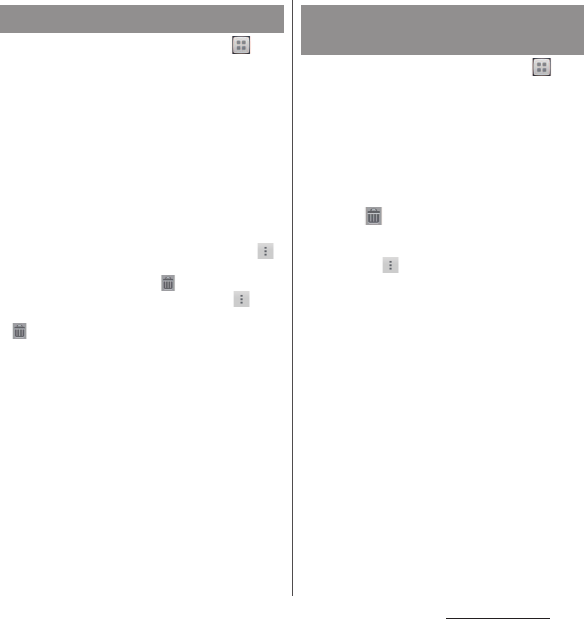
116
Mail/Web browser
1
From the Home screen, tap ,
then tap [Messaging].
2
Tap a sender/recipient whose
messages (SMS) you want to
delete.
3
Touch and hold a message (SMS)
you want to delete.
4
Tap [Delete message]
u
[Delete].
❖
Information
・
To delete several messages (SMS), in Step 3, tap ,
tap [Delete messages], and mark messages (SMS)
you want to delete, then tap and tap [Delete].
・
To delete all messages (SMS), in Step 3, tap and
[Delete messages]
u
[X selected]
u
[Mark all], then tap
and [Delete].
1
From the Home screen, tap ,
then tap [Messaging].
2
Touch and hold a sender/recipient
you want to delete.
・
The sender/recipient to be deleted is
marked. To mark all senders/recipients,
tap [X selected]
u
[Select all].
3
Tap and [Delete].
❖
Information
・
In Step 2, tap and tap [Delete conversations] to
select senders/recipients and delete their messages
(SMS) or to delete all senders'/recipients' messages
(SMS).
Deleting a message (SMS) Deleting messages (SMS) by
sender/recipient
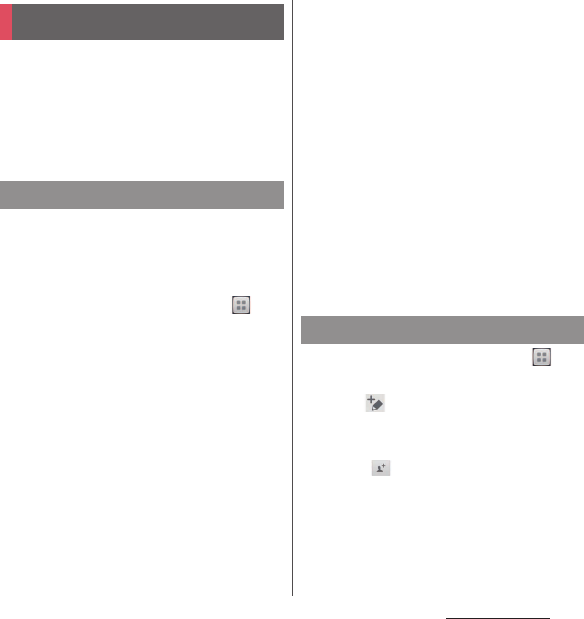
117
Mail/Web browser
You can create an email account provided by
mopera U mail, a POP3 or IMAP compatible
email account provided by general ISP
(provider), or an Exchange ActiveSync
account to send or receive email.
You can set multiple Email accounts.
Set an Email account following the onscreen
instructions.
For mopera U mail setting procedure, see
"Using mopera U Mail" (P.122).
1
From the Home screen, tap ,
then tap [Email].
2
Enter your email address and
password.
3
Tap [Next].
・
To set up an email account manually,
tap [Manual setup] and follow the
onscreen instructions.
4
Set Inbox check frequency, mark
required items and tap [Next].
・
If a screen for selecting type of account
appears, tap an email account type and
follow the onscreen instructions to set.
5
Enter account name and name
displayed on emails you send, and
tap [Next].
・
Inbox for set email account appears.
・
If you set an Exchange ActiveSync
account, a name displayed for email
cannot be set. Set up from "Your name"
(P.120) on email account settings after
email initial settings is complete.
❖
Information
・
If you need to make the settings manually, contact
your email service provider or system administrator
for the correct email account settings.
・
If you set an Exchange ActiveSync account as an
email account, and if server manager sets Remote
wipe, the data saved in the terminal may be deleted.
1
From the Home screen, tap ,
then tap [Email].
2
Tap (Compose).
3
Enter the email address of
recipient.
・
Tap to display the contacts list
screen to select from registered
contacts. When you enter a name or
email address in the search box at the
top of the screen, a list of contacts
matching the entered numbers or
letters appears.
Email
Making initial setting for Email
Creating and sending email
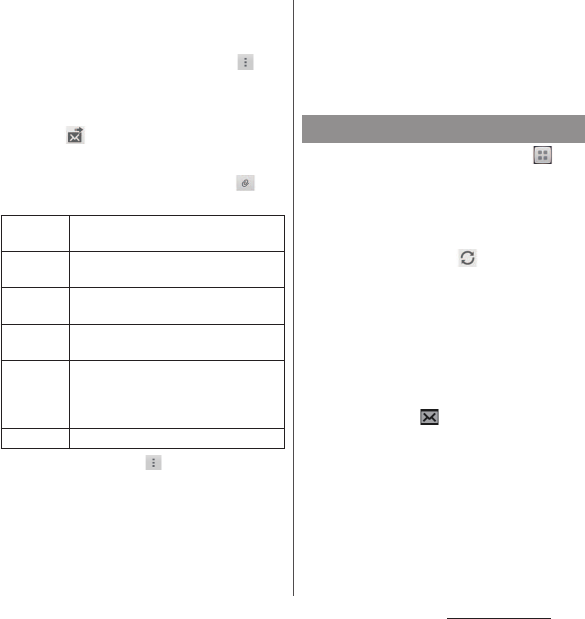
118
Mail/Web browser
・
To enter multiple email addresses
directly, separate with a comma (,) and
then enter the next email address.
・
To add Cc or Bcc recipients, tap and
tap [Show Cc/Bcc].
4
Enter a subject and message.
5
Tap (Send).
❖
Information
・
To attach a file, while creating an email, tap and
attach a file in the following step.
・
While creating a mail, tap and tap [Save draft] to
save a mail as a draft. Also, if you view another screen
while creating an email, the email is automatically
saved as a draft (for saving an email without recipient
or subject, or without message text or attachment as
a draft, tap
x
).
・
In sent/received emails, a communication data is also
included other than text and image displayed on the
screen and charges will apply to the data.
・
Email is handled as an email from a PC. Your email
cannot be received if rejecting emails from PCs is set
on a recipient terminal.
1
From the Home screen, tap ,
then tap [Email].
・
If you have already set an email
account, tap [Inbox] to select an email
account to receive.
2
In the Inbox, tap .
3
Tap an email you want to read.
・
Email message appears.
❖
Information
・
The sender name of a received email is the name set
on sender's terminal.
・
If you set "Email notifications" in Account settings
(P.120) and set "Inbox check frequency" to an item
other than "Manual", appears in the status bar
when you receive a new email. Drag the status bar
downwards to read the received email.
・
Tap an address of received email to register the
address to the phonebook. For addresses already
registered to the phonebook or Google Talk,
displaying the phonebook entries, selecting an
application to create mail, etc. are available.
Add
picture
Select a file from the saved image file list
to attach it.
Take photo
Start the camera to take a photo and
attach it.
Add video
Select a file from the saved video file list
to attach it.
Record
video
Start the camera to shoot a video and
attach it.
Add sound WALKMAN
: Select a file from the saved
music file list to attach it.
Sound Recorder
: Record a voice
message and attach it.
Add files
Select files from a saved file list to attach.
Receiving and reading email
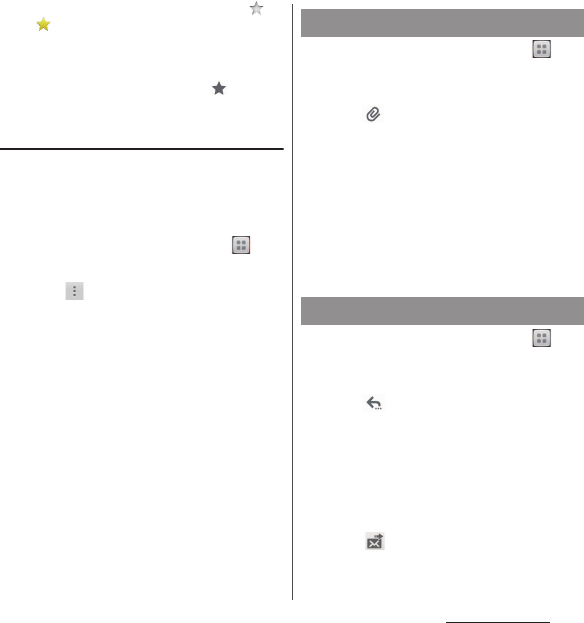
119
Mail/Web browser
・
In the Inbox or the email message screen, tap to
add star and the email is added to "Starred"
folder. To check starred emails in a list, in the Inbox,
[Inbox]
u
[Show all folders]
u
Tap [Starred].
・
To add star to multiple emails, in the Inbox, mark
emails you want to add stars, then tap at the
bottom right of the screen.
Changing Inbox view
Turn Preview pane on and turn the terminal
sideways to show preview of email message.
To switch to the landscape view, turn Auto-
rotate screen on beforehand (P.40).
1
From the Home screen, tap ,
then tap [Email].
2
Tap and
[Settings]
u
[General]
u
[Preview
pane].
3
Tap [Landscape].
❖
Information
・
If you have two or more accounts, change made in
any of the accounts applies to all accounts.
1
From the Home screen, tap ,
then tap [Email].
2
Tap email with attached files and
tap .
・
The attached file list is displayed. When
attached file is not loaded, tap [Load].
3
Tap [Save] of file you want to save.
・
Tap [View] or [Play] to view or play the
attached file.
❖
Information
・
The attached file is saved on the internal storage.
1
From the Home screen, tap ,
then tap [Email].
2
Tap email to reply or forward and
tap .
3
Tap any of [Reply]/[Reply all]/
[Forward].
・
When you tap [Forward], enter an email
address to forward.
4
Enter a message.
5
Tap (Send).
Saving attachment file of email
Replying/forwarding email
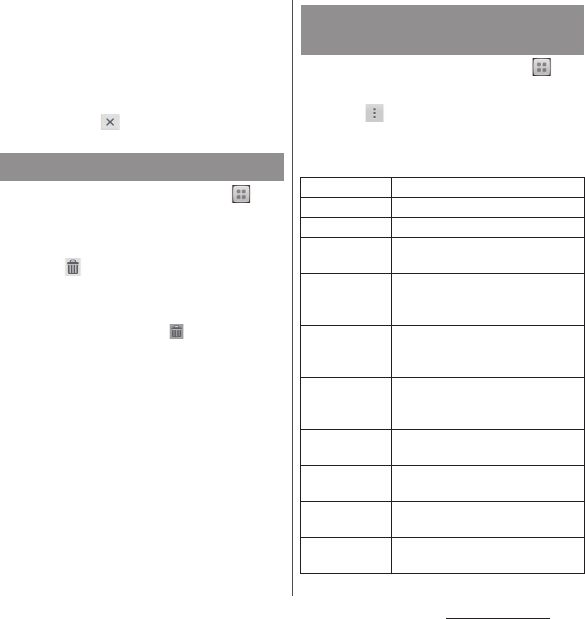
120
Mail/Web browser
❖
Information
・
When you reply or forward an email, the original
message contents for replying or forwarding is
quoted. To delete the quoted message text, unmark
"Include original text".
・
When you forward an email, the attachment file of
the original message is quoted. To cancel quoting
attached file, tap .
1
From the Home screen, tap ,
then tap [Email].
2
Tap an email to delete.
3
Tap and [Delete].
❖
Information
・
To select and delete several emails, in Inbox, mark
emails you want to delete, tap and [Delete]. Mark
at least 1 email and tap [X selected]
u
[Mark all] to
mark all emails.
1
From the Home screen, tap ,
then tap [Email].
2
Tap and [Settings].
3
Tap an Email account you want to
change the settings for.
Deleting email
Changing Email account
settings
Account name
Change account name.
Your name
Change your name (sender name).
Signature
Change your signature.
Quick reply
Register phrase that can be inserted
when creating an email.
Default
account
Set whether to send email by
default, if you set two or more email
accounts.
Inbox check
frequency
Set whether to check new messages
automatically and intervals of
automatic check.
Auto download
attachments
*1
Set whether to download attached
file automatically when connecting
via Wi-Fi.
Email
notifications
Set whether to show email arrival
notification in the status bar.
Select ringtone
Set ringtone when receiving an
email.
Vibrate
*2
Set whether to vibrate when
receiving an email.
Notification
light
Set whether to notify email
reception by notification LED.
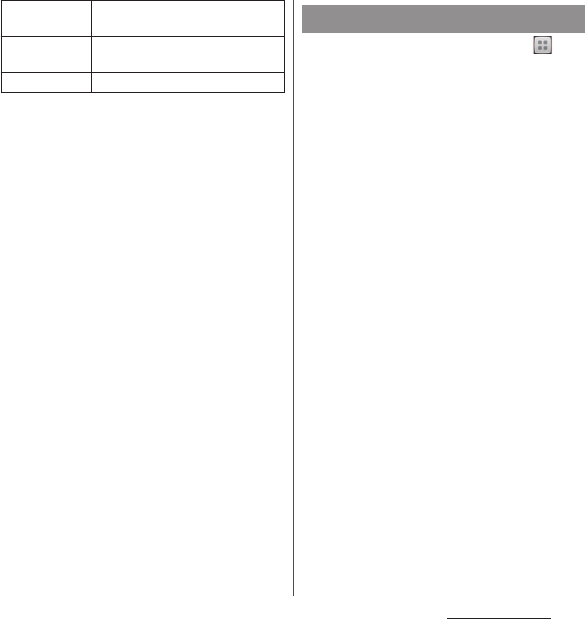
121
Mail/Web browser
*1 Appears when Gmail account (@gmail.com) is set.
*2 While the silent mode (mute) is set, the terminal
does not vibrate when receiving an email.
❖
Information
・
The items vary depending on the account type.
・
You can also set "Out of office", "Days to sync", "Sync
contacts", "Sync calendar", etc. for an Exchange
ActiveSync account. Setting for "Outgoing settings"
is not required.
・
If you set "Inbox check frequency" to an item other
than "Manual", and if you are using the pay-as-you-go
data communication, you may be charged every
time you check email.
・
If you tap [General] in Step 3, you can change whole
"Email" app settings.
1
From the Home screen, tap ,
then tap [Email].
2
Tap [Inbox]
u
[Add account].
3
Enter your email address and
password.
・
If required, mark "Send email from this
account by default.".
4
Tap [Next].
・
To set up an email account manually,
tap [Manual setup] and follow the
onscreen instructions.
5
Set Inbox check frequency, mark
required items and tap [Next].
・
If a screen for selecting type of account
appears, tap an email account type and
follow the onscreen instructions to set.
6
Enter account name and name
displayed on emails you send, and
tap [Next].
・
Inbox for set email account appears.
・
If you set an Exchange ActiveSync
account, a name displayed for email
cannot be set. Set up from "Your name"
(P.120) on email account settings after
email initial settings is complete.
Incoming
settings
Set mail server for receiving.
Outgoing
settings
Set mail server for sending.
Delete account
Delete Email account.
Setting another Email account
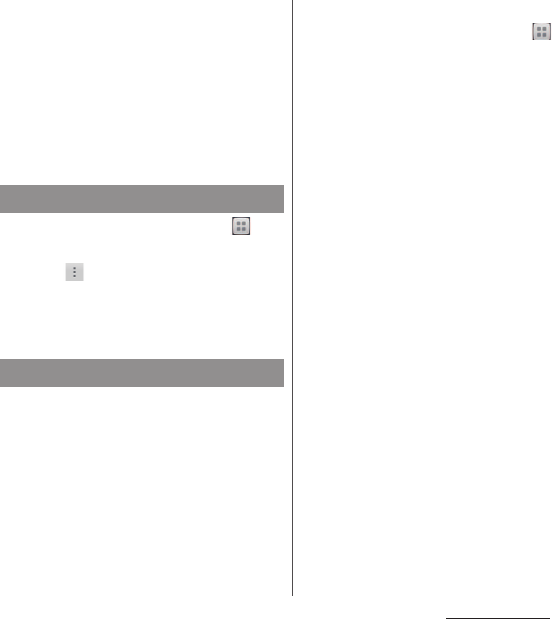
122
Mail/Web browser
❖
Information
・
If you need to make the settings manually, contact
your email service provider or system administrator
for the correct email account settings.
・
If you set an Exchange ActiveSync account as an
email account, and if server manager sets Remote
wipe, the data saved in the terminal may be deleted.
・
Tap [Inbox] to display a list of set accounts. Tap
[Combined view] to display combined Inbox for all
accounts.
1
From the Home screen, tap ,
then tap [Email].
2
Tap and [Settings].
3
Tap an account to delete.
4
Tap [Delete account]
u
[OK].
mopera U users can use mopera U Mail.
For mopera U setting procedure, see "Setting
mopera U" (P.204).
Mail box capacity of mopera U mail is 50 MB.
It supports both POP mail and IMAP mail.
Also, the Web mail system is available.
■
POP mail
1
From the Home screen, tap ,
then tap [Email].
・
If you already set an Email account, tap
[Inbox]
u
[Add account].
2
Enter mopera U mail address and
mopera U password, then tap
[Manual setup]/[Next].
・
If you tap [Next], it changes
automatically to POP3 account. Go to
Step 4.
3
Tap [POP3] from the type of the
mail account.
4
Check that you have entered "User
name" and "Password" for mopera
U correctly, and "mail.mopera.net"
for the POP3 server.
・
If you tap [Next] in Step 2,
"mail.mopera.net" is entered in the
POP3 server field.
5
Select the security type.
・
When you do not set security, select
"None".
6
Confirm the entry, then tap [Next].
Deleting Email account
Using mopera U Mail

123
Mail/Web browser
7
Enter "mail.mopera.net" for the
SMTP server and confirm the entry
of "User name" and "Password" for
mopera U.
・
If you tap [Next] in Step 2, you need to
mark "Require sign–in" to check
entered "User name", "Password" for
mopera U.
・
If you tap [Next] in Step 2,
"mail.mopera.net" is entered in the
SMTP server field. Set "587" in the Port
field.
8
Tap [Next].
9
On the account setting screen, set
Inbox check frequency, etc. and
tap [Next].
10
On the account setting screen,
enter a display name for sending
mail and tap [Next].
・
The mailer is displayed and the set mail
account is available.
❖
Information
・
When "Require sign-in." is unmarked on the SMTP
server setting screen, sending mails is not available.
Mark "Require sign-in.".
Set a Google account. You can use Gmail to
send and receive emails.
・
If you do not set a Google account, follow the
onscreen instructions to set one on the initial
setting screen. For details, refer to "Setting
Google account" (P.222).
・
If you do not synchronize Gmail after Google
account is set, "Account not synced" screen
appears. Follow the onscreen instructions.
❖
Information
・
For details on Gmail, tap , then tap [Help] to view
the Google help.
1
From the Home screen, tap ,
then tap [Gmail].
2
Tap (Compose).
3
Enter the email address of
recipient.
・
When you enter a name or email
address in the email address field,
contacts matched to the entered
numbers or letters are listed.
・
To add Cc or Bcc recipients, tap and
tap [Add Cc/Bcc].
4
Enter a subject and message.
Gmail
Sending Gmail
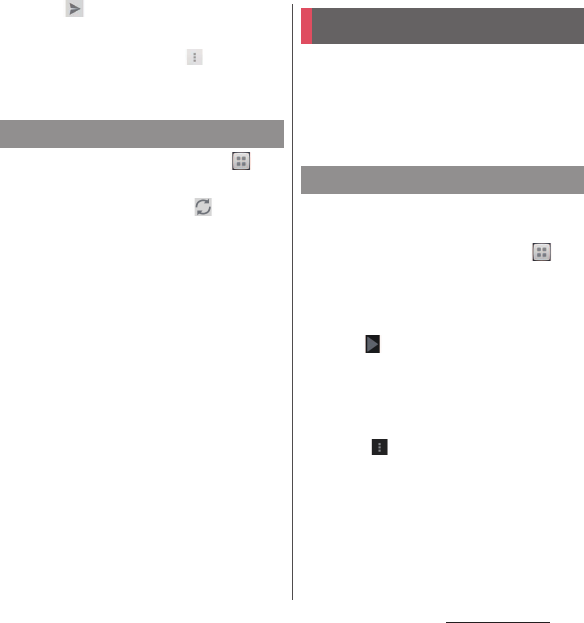
124
Mail/Web browser
5
Tap (Send).
❖
Information
・
To attach a picture or a video, tap and then tap
[Attach picture]/[Attach video] and select a video to
attach.
1
From the Home screen, tap ,
then tap [Gmail].
2
On the Inbox tray, tap .
・
Synchronizing "Gmail" app in the
terminal with your Gmail account starts,
and the Inbox is refreshed.
You can use Google Talk instant messaging to
chat with friends. To use Google Talk, you
need to make settings of your Google
account. For details, refer to "Setting Google
account" (P.222).
Signing in is unnecessary if you have already
set a Google account.
1
From the Home screen, tap ,
then tap [Talk].
2
Tap [Existing] and enter user name
and password.
3
Tap .
・
After this step, follow the onscreen
instructions.
❖
Information
・
For details on Google Talk, from the Google Talk
screen, tap and then tap [Help] to refer to.
Refreshing Gmail
Google Talk
Signing in Google Talk

125
Mail/Web browser
It is a service with which you can receive
earthquake early warning, etc. delivered by
the Meteorological Agency.
・
Area Mail is a free service for which
subscription is not required.
・
Area Mail cannot be received in the following
case.
-During a voice call
- Out of service area
- While power is off
- During International roaming
- During Airplane mode
- While updating software
- When a SIM other than by DOCOMO is
inserted
- While sending/receiving a message (SMS)
・
Area Mail may not be received when
tethering is set or during packet
communications.
・
Area Mail that could not be received cannot
be received later.
A notification content screen appears and
you are notified by buzzer sound or
dedicated ringtone and vibration.
1
Receive Area Mails automatically.
2
A dedicated ring tone sounds and
notification LED flashes when an
Area Mail is received.
・
Ringtone and ringtone volume cannot
be changed.
・
The notification LED blinks only when
backlight is off.
3
A message body of Area Mail
appears automatically.
View received Area Mail later
1
From the Home screen, tap ,
then tap [Disaster kit].
・
When you activate for the first time, "
ご
利用にあたって
(Terms of use)" appears.
Tap [Agree] to start using.
2
Tap [Early Warning "Area Mail"].
3
Select an Area Mail from the Area
Mail list.
・
You can view message of Area Mail.
Early Warning "Area Mail"
Receiving Early Warning "Area
Mail"
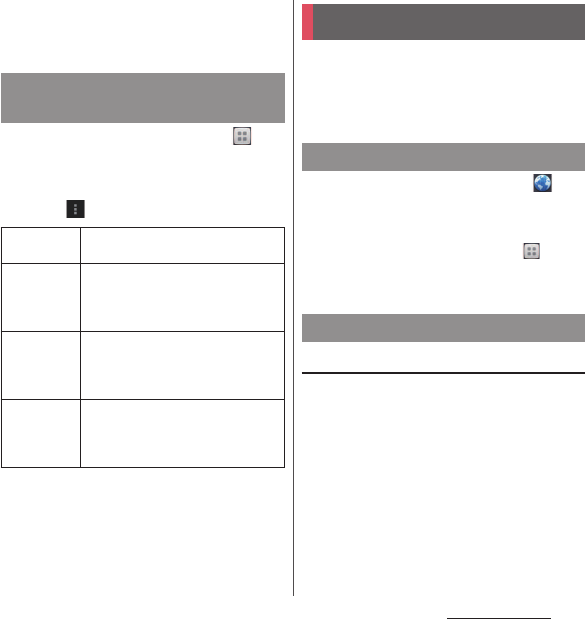
126
Mail/Web browser
❖
Information
・
If savable amount of Area Mail exceeds the limit of
maximum, the oldest one is deleted in order.
1
From the Home screen, tap ,
then tap [Disaster kit].
2
Tap [Early Warning "Area Mail"].
3
Tap and then [Settings].
❖
Information
・
Area Mail cannot be set when docomo mini UIM card
is not inserted.
You can view web pages using web browser
like on a PC.
Web browser can be used via packet
communication or Wi-Fi network.
1
From the Home screen, tap .
・
A browser screen appears.
❖
Information
・
Alternatively, from the Home screen, tap , then
tap [Chrome] to access the Internet to view web
pages.
Moving to a web page
1
Tap the address entry field on the
top of the web page in the Browser
screen.
・
If web page address entry field is not
displayed, flick down the screen to
display.
2
Enter a web page address or
keyword to search.
・
As you enter an address or characters,
retrieved web pages list appears.
Setting Early Warning "Area
Mail"
Receive
setting
Set whether to receive Area Mail.
Beep tone
Set sounding time for Area Mail
reception and whether to sound a
dedicated ringtone even in silent
mode.
Check screen
image and
beep tone
Check the ringtone and screen for
reception of earthquake early warning,
tsunami warning or disaster/
evacuation information.
Other
settings
Set receiving/deleting Area Mail other
than earthquake early warning,
tsunami warning and disaster/
evacuation information.
Web browser
Opening Browser
Displaying web pages
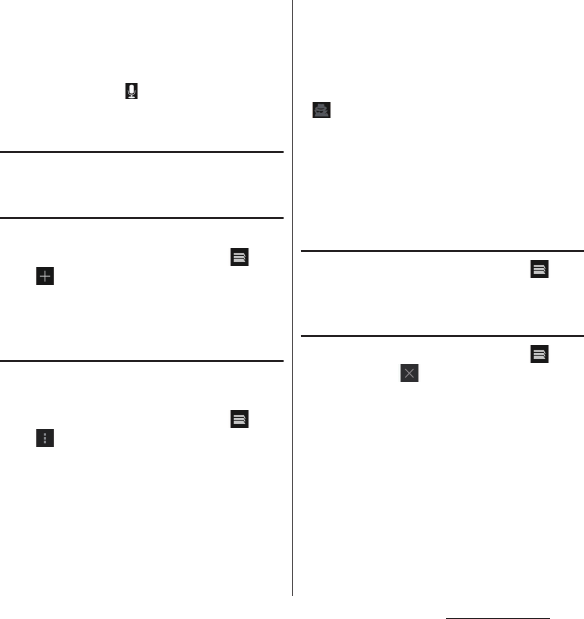
127
Mail/Web browser
3
Tap the displayed candidates list
or [Go] on the software keyboard.
・
You can move the web page.
❖
Information
・
In Step 2, you can tap in the address entry field to
enter search words by voice and search a web page.
Going back to the previous page
1
Tap
x
.
Adding a new tab
Open multiple tabs and view web pages.
1
On the Browser screen, tap and
.
・
A new tab opens in the default home
page.
Opening new incognito tab
You can view web pages without browser
history or search history.
1
On the Browser screen, tap and
.
2
Tap [New incognito tab].
・
A new tab opens and descriptions for
the incognito mode appear.
3
Display a web page.
・
For information on displaying web
page, see "Moving to a web page"
(P.126).
❖
Information
・
is displayed on the side of web page address
entry while viewing in the incognito tab.
・
Web pages you view in the incognito tab does not
appear in the history. When the tab is closed, the
record of Cookies etc. is erased. Downloaded files or
bookmarked web pages are saved even for the
incognito tab.
Switching tabs
1
On the Browser screen, tap and
then tap a tab you want to display.
Closing a tab
1
On the Browser screen, tap and
then tap of a tab to close.
・
Alternatively, flick a tab left or right to
close it.
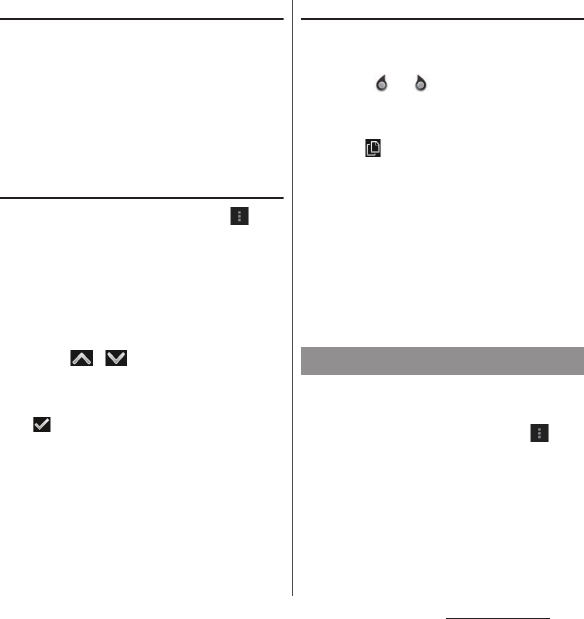
128
Mail/Web browser
Zooming in/out a web page
1
Pinch-in/-out on the Browser
screen.
❖
Information
・
Alternatively, double-tap the browser screen to
zoom in.
・
Web pages created to fit to the screen cannot be
zoomed in/out.
Searching text in a web page
1
On the Browser screen, tap and
tap [Find on page].
・
The search bar appears in the upper
part of the screen.
2
Enter a search word.
・
When you enter characters, matching
characters are emphasized.
・
Tap / to move to next/previous
matched item.
❖
Information
・
Tap to close the search bar.
Copying text in a web page
1
On the Browser screen, touch and
hold text you want to copy.
2
Drag or to select a range of
text to copy.
・
Selected text is highlighted in blue.
3
Tap (Copy).
・
A message "Text copied to clipboard."
appears.
4
Touch and hold the entry field on
the pasting location, and tap
[PASTE].
❖
Information
・
On some web pages, selecting characters may not
be available.
You can make settings for homepage, privacy
and security, page display, etc.
1
On the Browser screen, tap and
[Settings].
2
Select an item to change.
Changing Browser settings
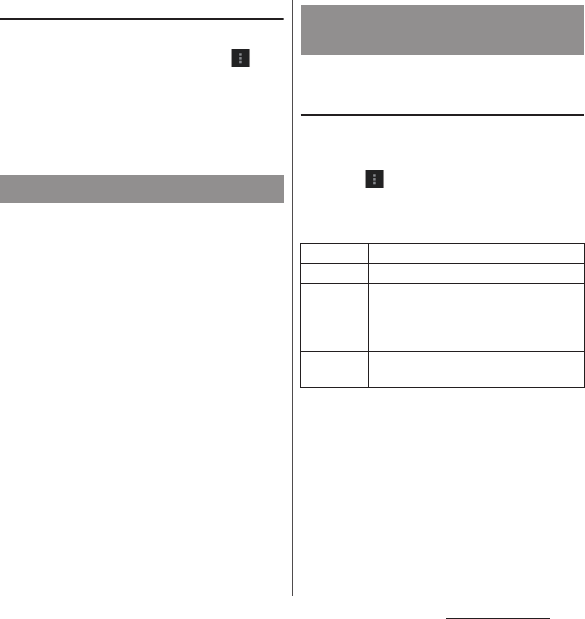
129
Mail/Web browser
Setting a home page
Set home page for opening new tab.
1
On the Browser screen, tap ,
then tap [Settings]
u
[General].
2
Tap [Set homepage] to select an
item you want to set as home
page.
1
Open the web page you want to
operate the links.
2
Tap a link.
・
Link is highlighted and move to linked
web page.
❖
Information
・
When you touch and hold a link including a link or
image, or image, "Open", "Open in new tab", "Save
link", "Copy link URL", "Select text", "Save image", "View
image", "Set as wallpaper" and "Share link" appear.
・
When you download a file by "Save link" from
websites which require Basic authentication or SSL
session, the downloading may be failed.
・
Browser recognizes some phone numbers that allow
you to call the phone number. Tap the phone
number to call.
You can check history, save bookmarks, etc.
Bookmarking a web page
1
On the Browser screen, display the
web page you want to bookmark.
2
Tap and [Save to bookmarks].
3
Set label etc. and tap [OK].
・
You can set the following options.
Operating links
Managing bookmarks and
history
Label
Set a name displayed to the bookmark.
Address
Set URL saved to the bookmark.
Account
When you set a Google account etc. and
sync with the browser, you can select
the account as a bookmark saving
location.
Add to
Add a shortcut of the bookmark on the
Home screen or create a folder.
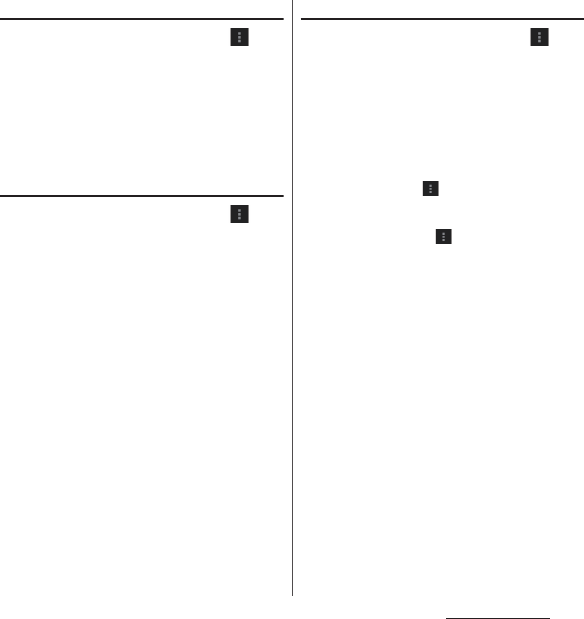
130
Mail/Web browser
Opening a bookmark
1
On the Browser screen, tap and
[Bookmarks].
2
Tap the bookmark you want to
open.
❖
Information
・
Touch and hold a bookmark to edit or delete it.
Checking history
1
On the Browser screen, tap and
tap [Bookmarks]
u
"History" tab.
2
Tap the time you browsed the web
page, such as [Today] or
[Yesterday].
・
To check your most visited web pages,
tap [Most visited].
・
Tap a history to open a web page.
❖
Information
・
On the Browser screen, touch and hold
x
to
check the history.
Clearing history
1
On the Browser screen, tap and
tap [Bookmarks]
u
"History" tab.
2
Tap a time when you viewed, touch
and hold a history you want to
delete, then tap [Remove from
history].
❖
Information
・
To delete history, tap on the browser screen and
[Settings]
u
[Privacy & security]
u
[Clear history]
u
[OK].
・
To delete temporary Internet files such as cache, on
the Browser screen, tap and tap
[Settings]
u
[Privacy & security] and set each item.

131
Apps
Apps
In dmenu, you can easily access sites
recommended by DOCOMO or convenient
applications.
1
From the Home screen, tap
[dmenu].
・
Browser activates to display "dmenu".
❖
Information
・
To use dmenu, Internet connection by packet
communication (LTE/3G/GPRS) or Wi-Fi is required.
・
For connecting dmenu and downloading
applications introduced in dmenu, packet
communication charge is applied separately. Some
applications automatically perform packet
communications.
・
Applications introduced by dmenu may include
charged ones.
You can obtain useful and interesting
contents which meet your needs at dmarket.
1
From the Home screen, tap
[dmarket].
・
When you activate for the first time, "d
マーケットソフトウェア使用許諾契約書
(License Agreement)" appears. Mark
"Agree" and tap [Start use].
❖
Information
・
For details on dmarket, refer to NTT DOCOMO
website.
dmenu
Opening dmenu
dmarket
Opening dmarket

132
Apps
With Google Play, you can directly access
useful applications or fun games which you
can download and install on the terminal.
And you can send feedback and comments
about an application, or report objectionable
application or incompatible application with
the terminal as an inappropriate content.
・
To use Google Play, you need to set a Google
account (P.222).
・
Some applications and games are free of
charge, and the others are paid. On the
applications list of Google Play, distinction
between free and paid is clearly specified. For
details on purchasing, returning and
refunding of paid applications, see "Help"
(P.133).
1
From the Home screen, tap [Play
Store].
・
When License agreement screen
appears, follow the onscreen
instructions.
2
Search applications and tap an
application you want to install.
・
Check the displayed contents carefully
and follow the onscreen instructions.
・
Be careful especially about applications
which access many functions or large
amount of data. Downloading an
application means that you are
responsible for the consequences of
using the application on the terminal.
❖
Information
・
Make sure the security of application, then install it at
your own risk. The terminal may be infected with a
virus and the data may be damaged.
・
NTT DOCOMO is not liable for malfunctions, if any,
caused by the application you installed. In such case,
the repair is charged even during the warranty
period.
・
NTT DOCOMO is not liable for any disadvantage
brought to you or any third party due to an
application you installed.
・
Some applications automatically perform packet
communications. Packet communication is kept
active unless you disconnect it or the time-out is
occurred. To disconnect packet communications
manually, drag the status bar downwards and tap
[Mobile data]. When packet communication is
disconnected, appears.
・
Some applications may be updated automatically.
Play Store
Installing applications

133
Apps
1
From the Home screen, tap [Play
Store].
2
Tap and [My apps].
3
Tap the applications you want to
delete, then tap [Uninstall]
u
[OK].
・
When you uninstall charged
applications, a screen for refund may
appear. For details, refer to "Help"
(P.133).
When you need help or have any questions
about Google Play, display the Google Play
screen, then tap and tap [Help] to open
Google Play help page.
This function allows you to use "
おサイフケー
タイ対応サービス
(Osaifu-Keitai compatible
service)" by which you can pay money or use
coupon, etc. or "
かざしてリンク対応サービス
(Kazashite-Link compatible service)" by
which you can access information by holding
the terminal over a home electric appliances
or smart poster.
Electronic money or point values can be
saved in the IC card or the docomo mini UIM
card.
You can check credit, payment or points of
electronic money by using the network. In
addition, you can lock your Osaifu-Keitai to
provide against loss or theft, and you can use
Osaifu-Keitai with safe.
For details on Osaifu-Keitai, refer to "Mobile
Phone User’s Guide [sp-mode]".
Deleting application
Help
Osaifu-Keitai

134
Apps
iC transfer service
The iC transfer service is a service which helps
you transfer all data in the IC card for Osaifu-
Keitai to your new Osaifu-Keitai when you
change Osaifu-Keitai for changing of the
model or repair. Data in the docomo mini
UIM card remains the same after using the iC
transfer service.
Visit a sales outlet such as docomo Shop to
use the iC transfer service.
For details on iC transfer service, refer to
"Mobile Phone User’s Guide [sp-mode]".
Precautions on using the Osaifu-
Keitai compatible terminal
・
The data in the IC card
*1
or the docomo mini
UIM card
*2
may be lost or modified because of
the malfunction of the terminal (When we
take your terminal for repair etc., as we cannot
take it with data remained, you are required to
erase the data by yourself ). For support such
as reissuance, restoration, temporary
preservation or transfer of data, contact
Osaifu-Keitai compatible service providers.
For important data, be sure to use a service
with backup service.
・
If the data in the IC card or the docomo mini
UIM card is lost, modified or damaged by any
means related to Osaifu-Keitai compatible
service such as malfunction or model change,
DOCOMO assumes no responsibility for the
loss of data.
・
If the terminal is stolen or misplaced,
immediately contact Osaifu-Keitai
compatible service provider for an advice.
*1 Data saved in the IC card built in the Osaifu-
Keitai compatible terminal (including
electronic money or point values)
*2 Data saved in the docomo mini UIM card
(including electronic money or point values,
and excluding phonebook data and SMS
data)
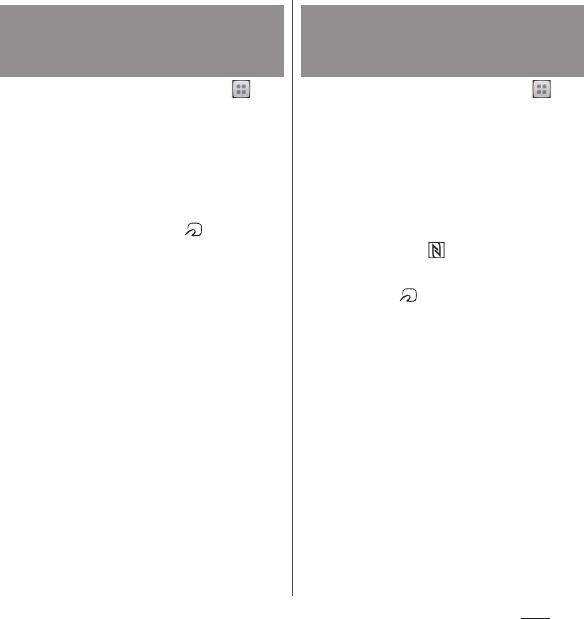
135
Apps
1
From the Home screen, tap
then tap [Osaifu-Keitai].
2
Select a service you want to use
from a service list.
・
Download an application compatible
with service site or service.
・
You can exchange data with an IC card
reader only by holding mark over
the card reader.
❖
Information
・
If you do not make the initial setting for Osaifu-Keitai
in the initial setting for DOCOMO services (P.38), the
initial setting screen appears in Step 2. Follow the
onscreen instructions.
・
You can scan and write data to or from an IC card
reader without activating Osaifu-Keitai compatible
application.
・
The function is available even if the terminal is off,
but it is not available when the battery is not
attached. Even if the battery is attached, it may not
be available if the terminal is off for a long while or
battery is low.
・
You can use Osaifu-Keitai compatible service even
when the PIN code cannot be unlocked or PIN
locked.
・
Note that when you do not subscribe sp-mode,
some functions of Osaifu-Keitai compatible service
may not be available.
1
From the Home screen, tap ,
then tap [Settings]
u
[More...].
2
[NFC/Osaifu-Keitai
settings]
u
[Reader/Writer,
P2P]
u
[OK].
・
"Reader/Writer, P2P" and "Android
Beam" are marked.
・
NFC Reader/Writer, P2P function is
enabled, and appears in the status
bar.
3
Hold the mark over a device
with the NFC module or a smart
poster.
Using "
おサイフケータイ対応サー
ビス
(Osaifu-Keitai compatible
service)"
Using "
かざしてリンク対応サービ
ス
(Kazashite-Link compatible
service)"
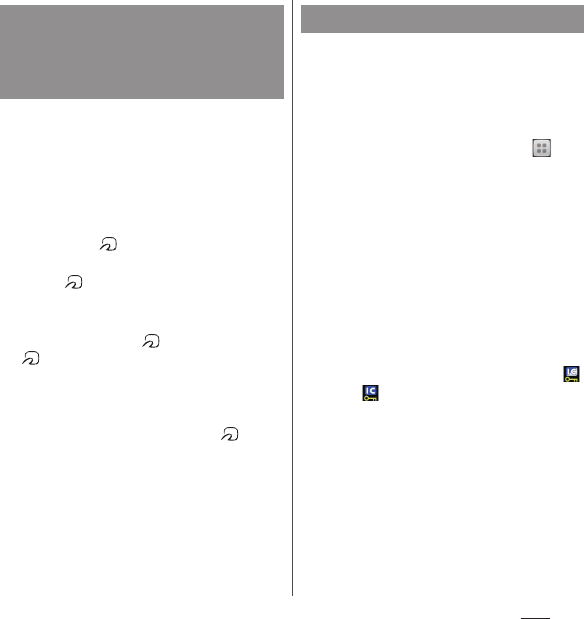
136
Apps
・
When holding mark over the other device,
make sure not to hit the terminal strongly.
・
Hold the mark over parallel to the center of
the other device.
・
Slowly put the terminal close to the other
device when holding mark.
・
If mark is not recognized even when
holding over the device, try lifting the
terminal slightly, or moving the terminal back,
forth and around.
・
If there are metal objects between mark
and the other device, scanning may be failed.
And note that putting the terminal in a case or
cover may affect communication
performance.
Use "NFC/Osaifu-Keitai lock" settings to
restrict the use of Osaifu-Keitai function and
related services.
・
NFC/Osaifu-Keitai lock is different from screen
lock for the terminal, SIM card lock.
1
From the Home screen, tap ,
then tap [Settings]
u
[More...].
2
Tap [NFC/Osaifu-Keitai
settings]
u
[NFC/Osaifu-Keitai
lock].
3
Enter a password, then tap [Next].
・
When using "NFC/Osaifu-Keitai lock" for
the first time, enter a password to set.
Set security question and answer in
case you forget the pattern following
the onscreen instructions.
・
Osaifu-Keitai function is locked, and
or is displayed in the status bar.
❖
Information
・
Note that you cannot cancel "NFC/Osaifu-Keitai lock",
if the battery runs out while "NFC/Osaifu-Keitai lock"
is set. Be careful about remaining battery level. If you
cancel "NFC/Osaifu-Keitai lock", charge the terminal
before canceling.
・
You need to unlock to use Osaifu-Keitai menu while
"NFC/Osaifu-Keitai lock" is set.
・
"NFC/Osaifu-Keitai lock" password is not be deleted
even if you reset the terminal.
Notes on holding the mark over
the other device such as a
reader or device with the NFC
module
Locking Osaifu-Keitai function

137
Apps
・
If you forget the password for "NFC/Osaifu-Keitai
lock", tap in the "NFC/Osaifu-Keitai settings"
screen and tap [Forget password?], then answer the
secret question that you set when setting the
password.
・
When unlocking "NFC/Osaifu-Keitai lock", insert the
same docomo mini UIM card as the one inserted
when "NFC/Osaifu-Keitai lock" was set, then unlock.
■
NFC
NFC is an abbreviation for Near Field
Communication and a short range wireless
communication method of international standard
defined by ISO (International Organization for
Standardization). You can use a contactless IC card
function, Reader/Writer function (R/W), Peer-to-
Peer communications function (P2P), etc.
"iD" is a convenient electronic money by
credit clearance scheme. You can enjoy
shopping simply and conveniently only by
holding Osaifu-Keitai with credit information
set or the iD-compatible card over the IC card
reader in stores. Because up to 2 types of
credit information can be registered in
Osaifu-Keitai, you can use them according to
the benefits, etc. It also supports cashing,
depending on the card issuer.
・
To use iD with Osaifu-Keitai, subscribing to a
card issuer that supports iD, settings for iD
application are required.
・
The charges required for iD service (including
the annual charge) vary by card issuer.
・
For using the application, a packet
communication charge is applied.
・
A packet communication charge for oversea
use differs from the one in Japan.
・
For details on iD, refer to iD website.
http://id-credit.com/ (In Japanese only)
ToruCa is an electronic card that can be
obtained to mobile phones. It can be
obtained from the IC card reader or site as
store information, coupon ticket, etc.
Obtained ToruCa is saved to the "ToruCa"
app. Use the "ToruCa" app to display, search
or update.
For details on ToruCa, refer to "Mobile Phone
User’s Guide [sp-mode]".
❖
Information
・
For obtaining, displaying or updating ToruCa, a
packet communication charge may be applied.
・
Some ToruCa provided to i-mode terminal may not
be obtained/displayed/updated.
・
Depending on the settings of IP (Information
Provider), the following functions may not be
available.
- Obtaining/Updating from the IC card reader,
sharing ToruCa, moving to microSD card, copying/
displaying map
iD
アプリ
(iD application)
ToruCa

138
Apps
・
Some ToruCa which can be displayed in a map from
ToruCa (details) may not be displayed in a map from
the ToruCa list depending on the IP settings.
・
While "NFC/Osaifu-Keitai lock" is set, you cannot
obtain ToruCa with an IC card reader.
・
If you mark
重複チェック
(Duplication check),
obtaining the same ToruCa redundantly is not
available. To obtain the same ToruCa redundantly,
unmark
重複チェック
(Duplication check).
・
When you send ToruCa attaching to email, it is sent
in the condition before obtaining ToruCa (details).
・
Depending on email application, ToruCa received via
the emails may not be saved.
・
Depending on browser, ToruCa cannot be obtained.
・
When ToruCa is moved/copied to the microSD card,
it is moved/copied in the condition before obtaining
ToruCa (details).
・
You may not be able to obtain ToruCa with an IC card
reader, if you do not make initial setting for Osaifu-
Keitai.
Mobacas is a broadcasting service for
smartphones. You can use 2 watching styles :
"Real Time" (broadcasting in real time style)
that allows you to watch programs in real
time and "Shift Time" (broadcasting in
storage style) that allows you to enjoy comic,
novels, music, games, etc. as well as movies
and dramas anytime and anywhere. Also, you
can enjoy new broadcasting services
including social service collaborated services
using the communication function of the
terminal.
For details on Mobacas, refer to the Mobacas
broadcast station (NOTTV) website.
NOTTV
http://www.nottv.jp/ (in Japanese
only)
Using Mobacas
・
A separate pay-TV subscription to the
Mobacas broadcast station (NOTTV) is
required to use Mobacas.
・
You cannot receive and watch broadcasts
without the docomo mini UIM card being
attached the terminal.
・
Mobacas is a broadcasting service provided in
Japan.
・
Using Shift Time mode requires sufficient
memory in the internal storage.
Mobacas

139
Apps
Broadcast wave and service area
The radio wave received via Mobacas differs
from that of received via Xi/FOMA service
and 1Seg. For this reason, the signal cannot
be received at places where the Mobacas
broadcast does not reach or while
broadcasting is out of service, regardless of
whether the terminal is outside or inside the
Xi/FOMA service area.
Also, in the following places, the signal status
may become weak or the signal may not be
received even if the terminal is inside the area
of Mobacas broadcasting service.
・
Places that are far from the base station that
sends signal
・
Mountain-ringed regions or a place between
buildings where airwaves are interrupted by
geography or buildings
・
Tunnel, underground or far back from a
building where airwaves are weak or do not
reach
Mobacas/1Seg antenna
・
Pull out the Mobacas/1Seg antenna
thoroughly until it fixed.
・
Mobacas/1Seg antenna can be rotated 360
degrees. Rotate it toward a direction for good
signal reception.
❖
Information
・
To operate Mobacas/1Seg antenna, be careful about
the followings.
- To change the direction of Mobacas/1Seg
antenna, hold around the root of Mobacas/1Seg
antenna and confirm the direction.
- For stowing, shorten Mobacas/1Seg antenna and
direct it straight and then stow it with careful
attention to the orientation of top of Mobacas/
1Seg antenna.
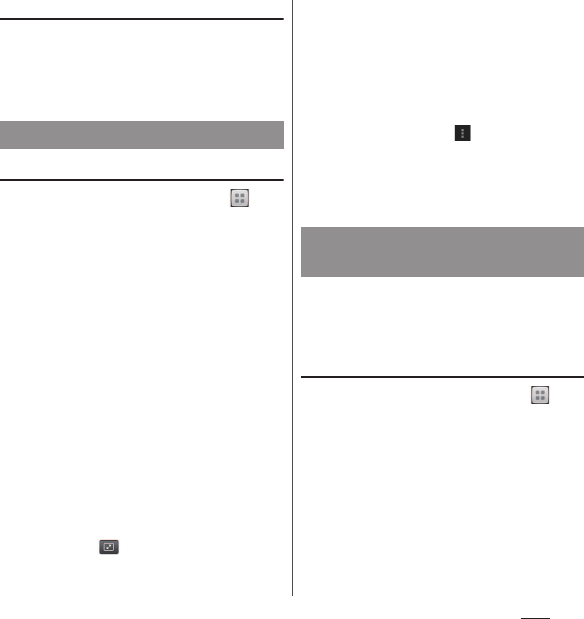
140
Apps
Improving reception status
・
Fully extending the Mobacas/1Seg antenna
and changing the antenna direction or
moving to other location may improve signal
reception.
Watching programs/contents
1
From the Home screen, tap and
[NOTTV].
・
A home screen of NOTTV appears.
・
When you activate for the first time, a
terms for use appears. Tap [
同意する
(Agree)] to perform initial settings
automatically. Perform the initial
settings in a place with good
communication environment.
・
When a guidance etc. appears, follow
the onscreen instructions.
2
Tap a thumbnail of program/
content.
❖
Information
・
When watching Real Time program, you can select
channels by flicking the screen left or right.
・
To view in full-screen, turn the terminal sideways or
on the portrait screen, tap an image of program/
content and tap .
* Viewing structure of content differs depending on
program/content.
・
Tap [
データ
(Data)] to display a data broadcasting
window (only in portrait view).
・
Tap [
ソーシャル
(Social)] to display timeline related to
program/content (only in portrait screen).
・
Tap [
インフォ
(Info)] to display program details (only
in portrait view).
・
While watching, press
m
to adjust sound
volume.
・
To set subtitle or audio, tap and [
設定
(Settings)]
u
[
表示・音声
(Display/audio)].
・
Some Mobacas programs/contents can be output to
TV by MHL connection. For connecting, see
"Connecting to other devices" (P.246).
There are various methods for searching for
programs/contents in the application.
Searching from program table (Real
Time)
1
From the Home screen, tap and
[NOTTV].
2
Tap [Program guide].
・
Real Time program guide appears. To
display Shift Time program guide, tap [
シフトタイム
(Shift Time)].
・
Tap a current broadcasting program to
switch to a watching screen of selected
program.
Watching Mobacas
Searching for a program/
content
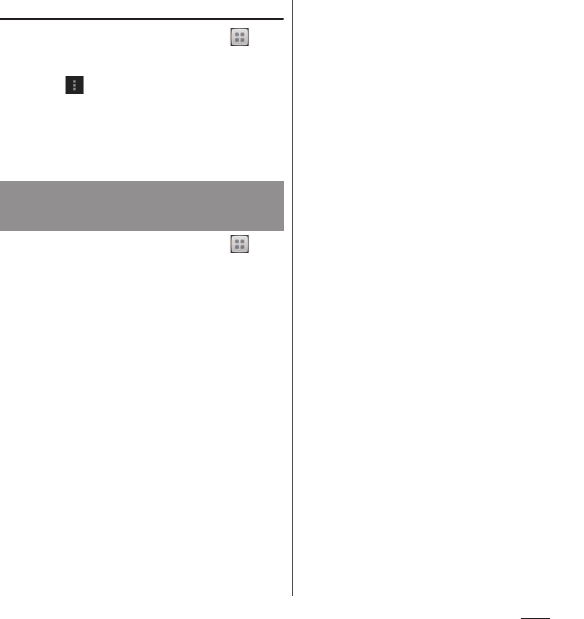
141
Apps
Searching by conditions
1
From the Home screen, tap and
[NOTTV].
2
Tap and tap [
検索・ジャンル別
(Search/by genre)].
3
Enter a keyword to search or tap a
genre you want to search for.
1
From the Home screen, tap and
[NOTTV].
2
Tap [
番組表
(Program guide)]
u
[
シフ
トタイム
(Shift Time)].
・
A list of programs/contents to be
broadcasted appears.
3
Tap a program/content you want
to reserve.
・
A detail screen of program/content
appears.
4
Tap [
予約する
(Reserve)].
❖
Information
・
Programs/contents may not be received in the
following cases : when the power is off while a
program/content is broadcasted, when the battery is
low, when the terminal is in a poor reception area
such as out of the Mobacas service area etc.,
available memory space in the internal storage is low.
・
Programs/contents temporarily saved in the internal
storage can be watched/used only on the terminal.
・
When expiration date has passed for programs/
contents, they are automatically deleted from the
internal storage. You can also delete programs/
contents manually before the expiration date.
・
Programs/contents may be automatically reserved
even when you have not reserved (
自動受信
(Automatic reservation)).
・
You can disable the automatic reservation function.
・
Depending on the signal reception, content data
may not be received. In that case, packet
communication is automatically used to compliment
data (
自動コンテンツ補完
(Auto contents
complement)).
・
You can disable the auto contents complement
function.
Reserving receiving a program/
content (Shift Time)
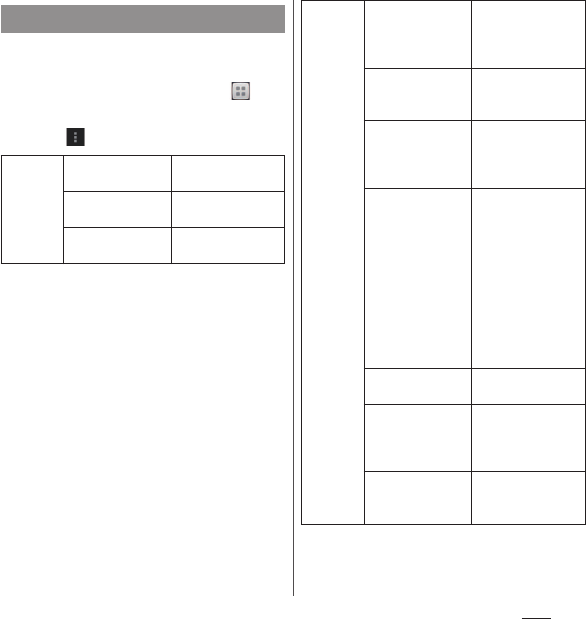
142
Apps
You can set for view, audio, content
reception, etc.
1
From the Home screen, tap and
[NOTTV].
2
Tap and [Settings].
Settings Mobacas
表示・音声
(Display/
audio)
字幕表示
(Display
subtitles)
Set display subtitles.
文字スーパー表示
(Telop display)
Set the telop display
to on/off.
音声
(Audio)
Switch main/sub
audio sound.
自動処理
(Auto
process)
自動受信
(Auto
reception)
Set the automatic
reception of content
or program guide to
on/off.
おすすめのリセット
(Reset
recommendation)
Reset
recommendation.
番組・コンテンツ情
報取得
(Acquire
program/content
information)
Set a time zone for
acquiring programs/
contents list
information.
自動コンテンツ補完
(Auto contents
complement)
Set whether to
automatically
complement data
using packet
communication
when contents are
not completely
received because of
the reception status
of broadcast wave
etc.
利用ログ送信
(Send
log)
Set log sending to
on/off.
自動ライセンス取得
(Auto license
acquisition)
Set whether to
automatically
acquire licenses of
contents.
ペアレンタルコント
ロール
(Parental
control)
Restrict usage of
programs/contents
according to age.
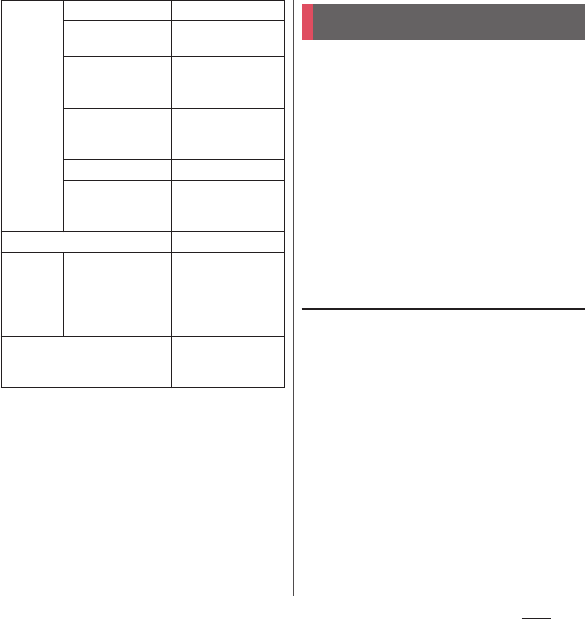
143
Apps
1Seg is a terrestrial digital TV broadcasting
service that allows mobile devices to receive
broadcasted data along with images and
sounds. In addition, interactive service using
communication function of mobile devices
and receiving detailed information are
available.
For details on "1Seg" service, refer to the
following website.
The Association for Promotion of Digital
Broadcasting
http://www.dpa.or.jp/english/
Using 1Seg
1Seg is a service provided by TV
broadcasting enterprises (stations), etc. A
communication fee for receiving video
picture and sound is not required. Contact
NHK for details on your NHK viewing fees.
There are 2 types of information displayed in
the data broadcasting area: "Data
broadcasting" and "Data broadcasting site".
"Data broadcasting" is displayed using
airwave along with images and sounds; while
"Data broadcasting site" is displayed by
connecting to a site provided by TV
broadcasting enterprises (stations), etc.,
using information of data broadcasting.
ブラウザ
(Browser)
Cookie
Set Cookie to on/off.
Cookie
を削除
(Clear Cookie)
Delete saved Cookie.
放送用保存領域消去
(Delete saved
broadcast data)
Delete received
broadcast data in
the saving area.
データ放送表示
(Display data
broadcasting)
Enable/disable
display of data
broadcasting.
再読込
(Reloading)
Reload data.
文字コード変換
(Character code
conversion)
Convert character
codes.
履歴
(History)
Display history.
ステータス
バー
(Status
bar)
放送中番組を表示
(Display
broadcasting
program)
Set whether to
display a
broadcasting
program on the
status bar.
機種変更
(Model change)
Make necessary
settings in case of
model change.
1Seg
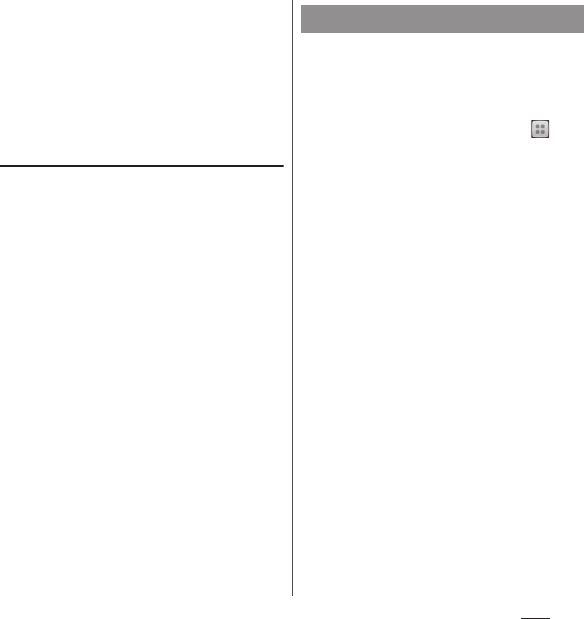
144
Apps
For viewing "Data broadcasting site", etc.,
packet communication fees are charged.
・
Some sites require information fees.
・
ToruCa may be automatically saved while
watching 1Seg program. For acquiring
detailed information of saved ToruCa, packet
communication charge is applied.
Airwaves
1Seg is one of the broadcast services and a
different type of radio waves (airwaves) from
that of FOMA service is received. Therefore,
regardless of whether you are in or out of Xi
service or FOMA service area, it cannot be
received where airwaves do not reach or
during broadcasting interruptions.
Also, even in a terrestrial digital TV
broadcasting service area, reception
condition may be poor or reception may be
unavailable in the following places:
・
A place far from the tower that the airwaves
are sent from
・
Mountain-ringed regions or a place between
buildings where airwaves are interrupted by
geography or buildings
・
Tunnel, underground or far back from a
building where airwaves are weak or do not
reach
Fully extending the Mobacas/1Seg antenna
and moving to other location may improve
signal reception.
When you use 1Seg for the first time, select
an area to make channel setting. After
channel setting is done, 1Seg programs can
be received.
1
From the Home screen, tap and
tap [1Seg].
2
Tap [Area Select] to select region,
prefecture and locality.
・
The terminal searches for available
channels. When the searching is
complete, a channel list appears.
3
Tap a channel you want to watch.
・
1Seg watching screen appears.
❖
Information
・
Alternatively, tap [Auto] in Step 2 to set channels.
Initial settings for 1Seg
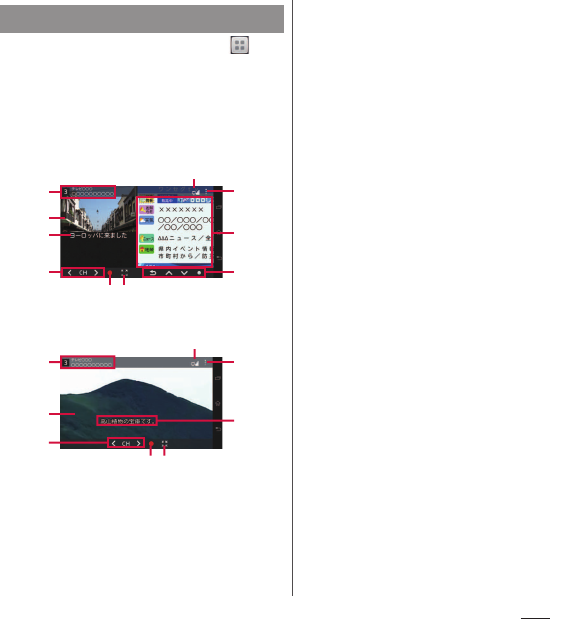
145
Apps
1
From the Home screen, tap and
tap [1Seg].
・
1Seg watching screen appears. Tap an
image or subtitle to temporarily view
information such as program name.
■
1Seg watching screen
a
Remote control number, broadcasting station and
program information
b
Image
c
Subtitle
d
Channel selection key : Select channel, display
operation key to display channel list etc.
e
Reception signal level
f
View optional menu
g
Data broadcasting : Display data broadcasting
content.
h
Remote control for data broadcasting : Display
operation keys for data broadcasting such as Back,
Move focus, Select focus, etc.
i
Record icon
j
Switch of screen view (full-screen/with data
broadcasting)
❖
Information
・
While watching 1Seg, press
m
to adjust
volume.
・
You can watch 1Seg program in the portrait view or
landscape view. To set the screen orientation to
switch between landscape and portrait view
automatically according to the terminal orientation,
drag the status bar downwards and tap [Auto rotate].
・
To switch channels for watching, operate any of the
followings.
- Tap the channel selection key
- On the 1Seg watching screen, flick an image or
subtitle left or right.
- On the 1Seg watching screen, touch and hold an
image or subtitle to display the channel list and
then select a channel
・
On the portrait view screen, tap a data broadcasting
to display the remote control for data broadcasting.
To display the channel selection key or recording
icon again, tap an image or subtitle.
・
You cannot exit 1Seg even if you tap
y
to return
to the Home screen. If 1Seg remains activated, the
battery may be consumed quickly. To exit 1Seg, tap
x
while watching 1Seg.
Watching 1Seg program
g
d
a
b
c
e
f
h
ij
1Seg watching screen
(with data broadcasting)
d
a
bc
e
ij
f
1Seg watching screen (full screen)
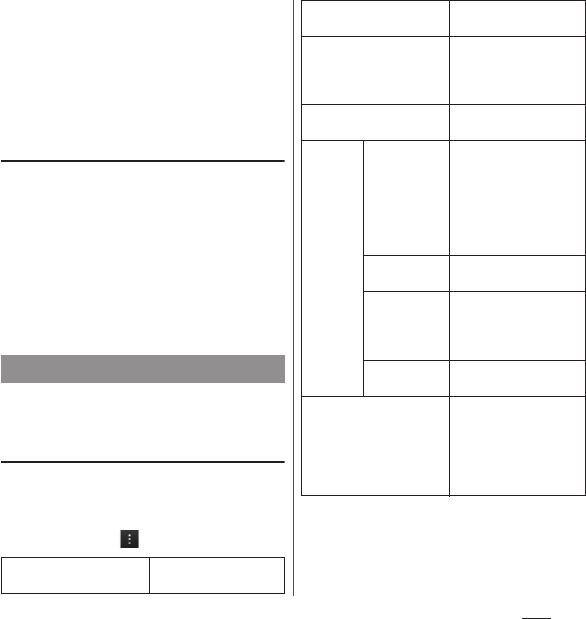
146
Apps
・
It may take a time to acquire image data or
broadcasted data when you activate 1Seg or change
channels due to characteristic of digital
broadcasting.
・
According to the airwave condition, image or sound
may be interrupted or stopped.
・
If the terminal receives a call while watching 1Seg,
1Seg is interrupted and resumes after the call ends.
Watching data broadcasting
For data broadcasting, you can view various
information by following the onscreen
instructions.
❖
Information
・
To watch data broadcasting, call charge or packet
communication charge is not required. If you use
additional services of data broadcasting, etc. via
packet communication, packet communication
charge is applied.
You can set 1Seg watching screen, data
broadcasting and initialize.
Using optional menu
You can record 1Seg, switch caption display,
etc.
1
On the 1Seg watching screen
(P.145), tap .
Setting 1Seg
Program guide
Display a program guide
(P.149).
Recorded programs
Display recorded file list
(P.149).
Reservation list
Reserve recording or
watching programs or
display failed reservation
list (P.148).
TV Link
Display a TV link list
screen (P.148).
Settings Data
Broadcasting
settings
Set whether to check
communication or to use
the location information
or the terminal
information, or clear the
broadcasting station
memory.
Sleep Timer
Make a timer setting to
end 1Seg watching.
Subtitle/
Sound
Enable/disable subtitle
display and set subtitle
language and main/sub
sound.
Change area
Change broadcasting
area.
Tune service
You can select a sub-
channel when several
programs (services) are
broadcasted for
separated sub-channels
in a channel.

147
Apps
Saving channels in the current
location
Available channels vary depending on the
area (broadcasting service area) you are
using in.
1
On the 1Seg watching screen
(P.145), tap .
2
Tap [Settings]
u
[Change
area]
u
[Empty].
3
Tap [Auto].
・
The terminal searches for available
channels. When the searching is
complete, a channel list appears.
4
Tap a channel you want to watch.
・
1Seg watching screen appears.
❖
Information
・
Alternatively, tap [Area Select] in Step 3 then select
your area to save channels.
Changing a broadcasting area
1
On the 1Seg watching screen
(P.145), tap .
2
Tap [Settings]
u
[Change area].
3
Select a registered area.
・
Channels are switched to the ones for
the selected area.
❖
Information
・
By touching and holding the area registered in Step
3, you can display details, set area information,
refresh channels, rename area or clear settings.
Changing numbers for TV remote
Change TV remote number assigned to each
broadcasting station. Each broadcasting
station can be called up via the
corresponding TV remote number.
1
On the 1Seg watching screen
(P.145), touch and hold an image.
・
A channel list appears.
2
Tap a broadcasting station to
change the remote control
number.
3
Touch and hold a number of
remote control you want to set to.
4
Tap [Register channel].
・
If you select a number of remote
control which is already assigned to
another broadcasting station, tap [YES].
❖
Information
・
To delete set broadcasting stations, touch and hold a
broadcasting station to delete in Step 2, then [Delete
channel]
u
Tap [ YES].
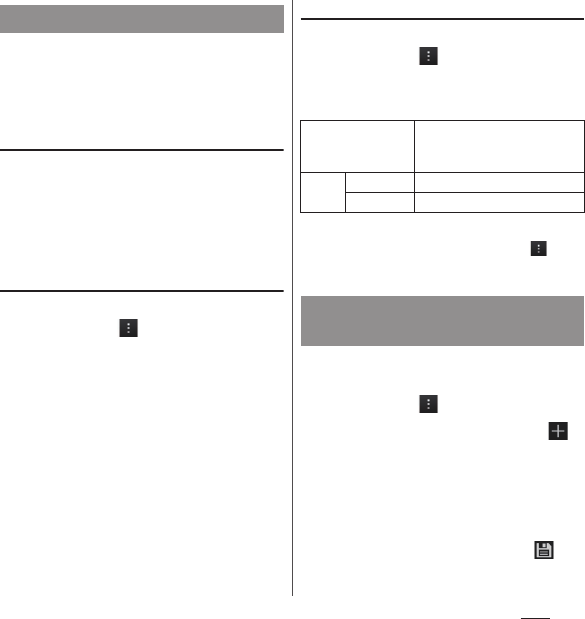
148
Apps
For some data broadcasting programs, link
information to related websites (TV link) is
displayed. Save TV links to connect to related
websites later.
Saving TV links
1
On the 1Seg watching screen (with
data broadcasting) (P.145), select
TV link to store.
・
After this step, follow the onscreen
instructions.
Displaying TV links
1
On the 1Seg watching screen
(P.145), tap .
2
Tap [TV Link].
・
A TV link list screen appears.
3
Select a TV link.
・
When selecting a link content or HTML
content, tap [Yes].
❖
Information
・
Some TV links have period of validity. Out of date TV
links are no longer available.
Viewing/Deleting details of TV link
1
On the 1Seg watching screen
(P.145), tap .
2
Tap [TV Link] and touch and hold a
TV link.
❖
Information
・
Alternatively, on the TV link list screen, tap to
delete all.
Reserve recording/viewing TV program.
1
On the 1Seg watching screen
(P.145), tap .
2
Tap [Reservation list] and tap .
3
Tap [Manual].
4
Tap [Viewing reservation]/
[Recording reservation].
5
Set a program name, channel, start
time, end time, etc. and tap ,
then tap [YES].
Using TV link
Property
Display details for registered
information such as title,
description, expiration date, etc.
Delete Delete one
Delete a stored TV link.
Delete all
Delete all stored TV links.
Reservation of recording/
viewing TV program
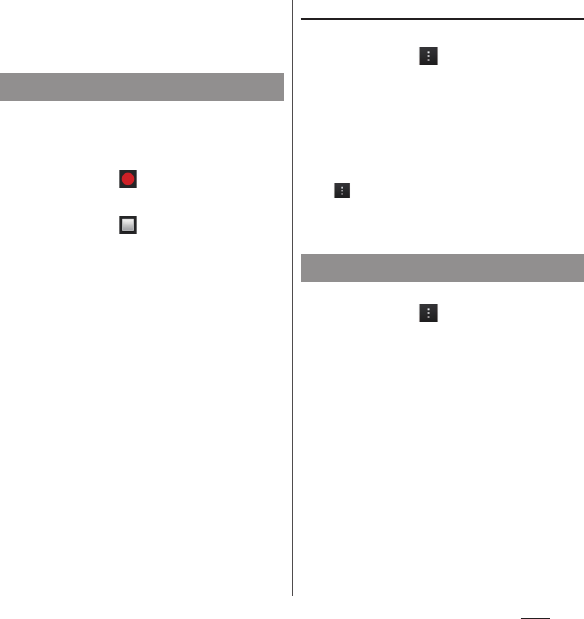
149
Apps
❖
Information
・
Alternatively, tap [From Program guide] in Step 3, you
can reserve recording/watching.
Record images, sound, captions or data
broadcasting while displaying.
1
On the 1Seg watching screen
(P.145), tap to start recording.
2
On the 1Seg watching screen
(P.145), tap to end recording.
❖
Information
・
Maximum savable recorded data file size is 2GB, and
maximum recordable time is approximately 640
minutes in a row.
Items can be saved up to 99.
・
Recorded data is saved on a microSD card. Recording
is not available if a microSD card is not attached.
・
When you use the microSD card from another
application while recording, recording may fail.
Playing a recorded program.
1
On the 1Seg watching screen
(P.145), tap .
2
Tap [Recorded programs].
3
Tap a program you want to play.
❖
Information
・
Touch and hold a program to change or delete title
etc.
・
Tap on the recorded file list screen to set play
mode, select/delete all, display remaining memory
space, etc.
1
On the 1Seg watching screen
(P.145), tap .
2
Tap [Program guide].
・
After this step, follow the onscreen
instructions.
Recording 1Seg
Using program guide
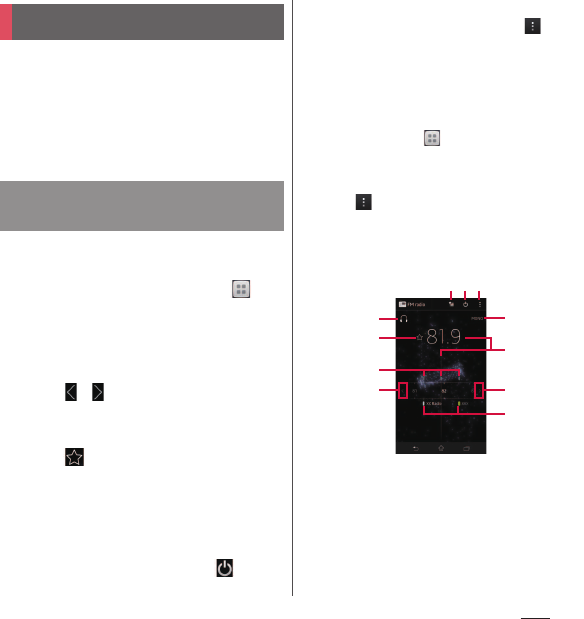
150
Apps
You can listen to the FM radio with the
terminal. Tuning can be made automatically
or manually, and you can register your
favorite channels to Favorites. To use FM
radio, use a commercially available earphone
set or headphone. They work as antenna.
1
Connect an earphone set or
headphone to the terminal.
2
From the Home screen, tap ,
then tap [FM radio].
・
FM radio screen appears and selecting
channel starts automatically. The search
ends when radio waves are received.
3
Tap / to select channel.
・
You can select channel by flicking the
screen left and right.
4
Tap .
5
Enter a name, select a color, then
tap [Save].
・
The frequency bands of selected
channels are registered to Favorites.
6
To stop the FM radio, tap .
❖
Information
・
Alternatively, on the FM radio screen, tap and
[Search for channels] to search.
・
Up to 8 one-byte or two-byte characters can be
entered as a favorite name.
・
You can return to the Home screen to perform
another operation while listening to FM radio in the
background. To return to the FM radio screen, from
the Home screen, tap then tap [FM radio], or drag
the status bar downward and tap [FM radio].
・
If you cannot receive Japanese FM radio programs
because the docomo mini UIM card is not inserted
etc., tap on the FM radio screen, then tap [Set
radio region]
u
[Japan]. For using FM radio, check
your area.
■
FM radio screen
a
Play in speaker/Play in handsfree
b
Save/edit Favorites
c
Channel point displayed in a good radio wave
condition
d
Search channels to the left
e
Show Favorites
f
On/Off of FM radio
g
View optional menu
FM radio
Searching and registering
channels
c
i
h
j
k
a
d
b
fg
e
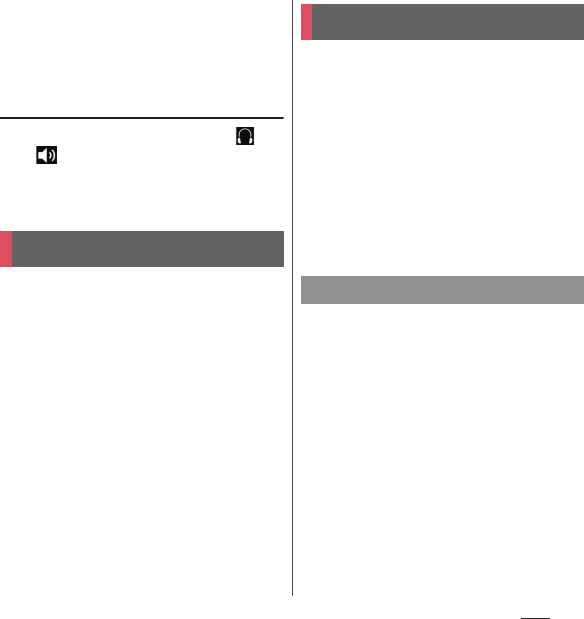
151
Apps
h
Monaural/stereo effect
i
Broadcasting station now listening
j
Search channels to the right
k
Channel assigned to favorite
Switching the speaker and handsfree
device
1
On the FM radio screen, tap /
.
・
The sound output is switched to the
speaker/handsfree device.
Use a commercially available earphone set,
stereo earphone with microphone or
headphone connecting to the terminal.
1
Connect an earphone set or
headphone to the headset jack of
the terminal.
・
Some earphones with microphone are
not available.
You can shoot still pictures and videos by
tapping the shutter icon (start shooting icon/
stop icon) or shooting screen or using the
camera key (
k
). Shooting still pictures is
available in the portrait and landscape
screen. Landscape screen is good for
shooting videos. For shooting with Sweep
Panorama, always hold the camera
horizontally. Still pictures and videos are
saved automatically in the internal storage or
a microSD card.
・
All pictures or videos that you capture on the
terminal are stored into the internal storage or
a microSD card. When saving to a microSD
card, attach a microSD card before using the
camera.
・
If you use microSD card with an i-mode
compatible terminal, photos and videos shot
by the terminal cannot be shown.
Using earphone set
Camera
Before using the camera

152
Apps
・
Avoid copyright infringements when you
handle photos, videos, or sound recorded
using the terminal, e.g. copy/edit. In addition,
avoid rights infringements of portraits by
using these photos without consent, altering
them or by other means. Note that capturing
or recording a stage performance,
entertainment or exhibition may be
prohibited even if for personal use.
■
About the Copyright and Portrait rights
Objects, such as movies, still images, and sounds,
recorded using the terminal are prohibited by the
copyright law from use without consent of the
copyright holders, unless intended for personal use
or any other purpose permitted by law. Also, using
or transformation of other person's portrait or
name without his or her permission may violate the
portrait right. When you present recorded images
or sounds in a public place such as on an Internet
home page, make sure to be aware of the copyright
and portrait right. Note that some performances,
shows, and exhibitions may not allow
photography, movie shooting, or sound recording
even for personal use. Transmission of images
related to copyright or beyond the scope provided
in the copyright law is not available.
Please be considerate of the privacy of
individuals around you when taking and
sending photos using camera-equipped
mobile phones.
If you cause the public any trouble using the
terminal, you may be punished under law or
regulations (for example, nuisance
prevention ordinance).
Note on Sweep Panorama
・
In the following cases, Sweep Panorama does
not work properly.
- Shooting a moving object
- Shooting the main object that is too close to
the camera
- Shooting an object with repetition of the
same pattern such as a sky, beach, grass, etc.
- Shooting a big object
- Shooting an object with constantly
changing pattern such as a wave, waterfall,
etc.
・
If shooting angle does not reach the required
value for Sweep Panorama within a certain
period of time, the part which was not taken
is recorded in gray.
To avoid this, move the camera faster when
shooting.
・
Because two or more images are joined
together, joints may not recorded smoothly.
・
Images may be blurred or may not be taken in
a dark scene.
・
Under the flickering light source such as a
fluorescent light, you may not be able to
shoot properly since brightness or color
balance of joined image may be unstable.
・
If brightness, color balance, focus point of
whole image, etc. to be shot with Sweep
Panorama are extremely different from those
of the focused image, image may not be shot
properly.
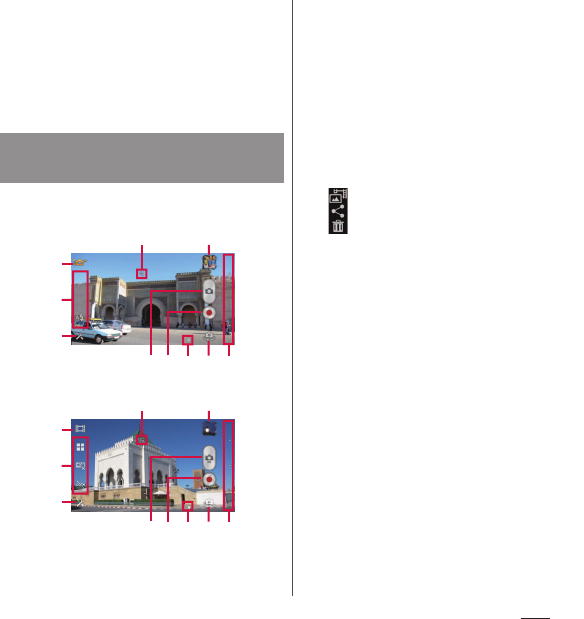
153
Apps
・
In the following cases, Sweep Panorama
shooting may be interrupted.
- Moved the camera too fast/too slow
- Blurred too much
- Moved the camera in the opposite direction
of the shooting
■
Still picture shooting screen/video
recording screen
a
Capturing mode icon (P.154)
b
Display area of icons showing selected settings
c
Icons showing set items
d
Display area of status icons showing selected
settings
e
Recent shooting history
・
Flick a thumbnail of shooting history on the
shooting screen to the left of the screen (up when
in vertical screen mode) to display the last 5
items.
・
Tap a thumbnail to open viewing/playback
screen for still pictures and videos.
・
Touch and hold a thumbnail to display the
following icons (except for continuous shoot).
: View playback screen of photos and videos
: Share
: Delete
・
For thumbnails of pictures continuously taken,
number of pictures continuously taken is also
indicated. Tap to open the list screen for pictures
continuously taken.
f
Shutter icon (still picture)
g
Start/Stop recording icon (video)
h
Switching to the front camera icon
i
Navigation bar
❖
Information
・
Press and hold
k
for over a second to shake the
terminal and activate the camera.
・
On the shooting screen, pinch-out/in or press
m
to zoom in/out. When capturing mode
(P.154) is set to "Sweep Panorama", "Front camera" or
"Front video", zoom is not available.
・
To end the camera, tap Navigation bar, then tap
x
.
Shooting screen and key
operation
a
b
c
e
fhdg i
d
Still picture shooting screen
a
b
c
e
fhdg i
d
Video recording screen
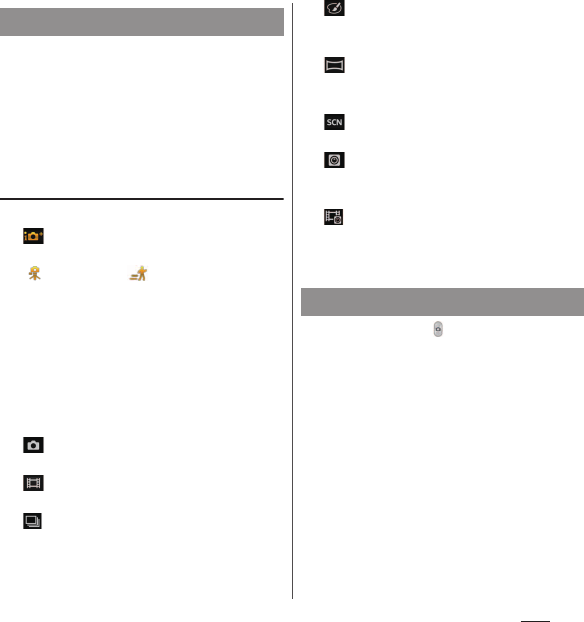
154
Apps
1
Press and hold
k
for over a
second.
・
The shooting screen (P.153) appears.
2
On the shooting screen, tap the
capturing mode icon (P.154), then
select capturing mode.
Capturing mode icon
■
Capturing mode
Superior auto
The camera detects its state such as fixed
( ) and moving ( ) and determines most
suitable scene effect. When the state is
detected, an icon appears. When scene is
recognized, scene icon and scene name
appear.
"Superior auto", "Normal", "Video camera",
"Burst", "Picture effect", "Sweep Panorama",
"Scene selection", "Front camera", or "Front
video" is recognized.
Normal
A standard shooting mode.
Video camera
Record videos (P.162).
Burst
Pictures can be shot continuously (P.171).
Picture effect
Apply various picture effects to pictures
(P.170).
Sweep Panorama
Shoot panoramic image with wide angle
(P.171).
Scene selection
Set programmed scenes (P.156).
Front camera
Shoot pictures using the front camera
(P.168).
Front video
Record videos using the front camera
(P.168).
Tap the shutter icon ( ) or shooting screen,
or use the camera key (
k
) to shoot still
pictures. Shot still pictures are automatically
saved in the internal storage or a microSD
card.
1
Press and hold
k
for over a
second.
・
The shooting screen (P.153) appears.
Changing capturing mode
Shooting still pictures
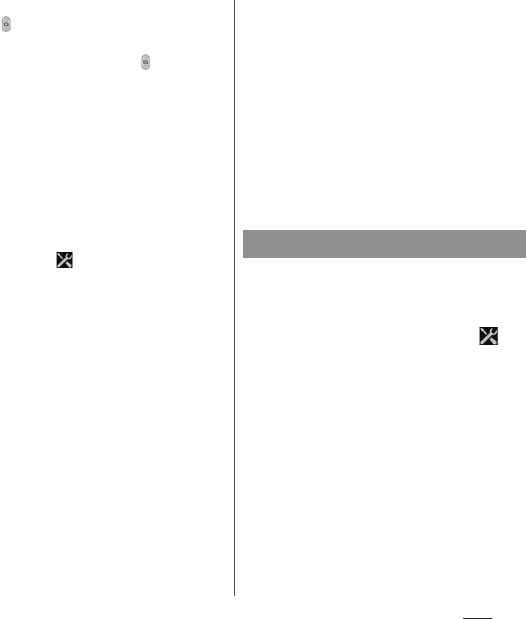
155
Apps
■
Shooting with the shutter icon
Tap on the shooting/recording screen.
・
To shoot still pictures using auto-focus
function, touch and hold and release
your finger when the focus frame turns
blue and sound beeps. A picture is shot
as soon as you release the finger. If the
focus frame does not appear, auto-
focus does not operate correctly.
■
Shooting with "Touch capture"
Set "Touch capture", then tap around a
displayed frame on the shooting screen.
・
To set "Touch capture", on the recording
screen, tap , then tap [Touch
capture]
u
[On].
・
To shoot still pictures using auto-focus
function, tap the screen and release
your finger, and then the focus frame
turns blue and a picture is shot. If the
focus frame does not appear, auto-
focus does not operate correctly.
■
Using the camera key (
k
)
Press
k
on the shooting screen
・
Even when "Touch capture" (P.161) is
set to "On", pressing
k
shoots a
picture.
・
To shoot still pictures using auto-focus
function, press
k
halfway and when
the focus frame turns blue and sound
beeps, press
k
all the way until it
stops. If the focus frame does not
appear, auto-focus does not operate
correctly.
❖
Information
・
When you connect a commercially available
earphone set or other Bluetooth device, shutter
sound may be softer.
1
Press and hold
k
for over a
second.
・
The shooting screen (P.153) appears.
2
On the shooting screen, tap ,
then tap item to set.
・
Several setting icons are displayed on
the shooting screen in advance. The
displayed setting icons change
depending on the setting conditions.
・
When capturing mode (P.154) is set to
"Burst", "Picture effect" or "Sweep
Panorama", tap the setting item icon
displayed on the shooting screen to
change the setting.
・
For setting items and icons, see "Still
camera setting" (P.156).
Changing the shooting settings
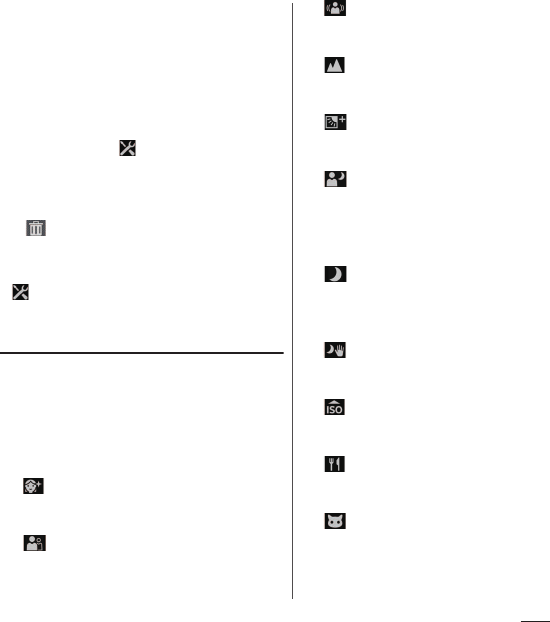
156
Apps
3
Tap an option in the selected
setting.
・
If you change setting options, icons
displayed on the shooting screen
change to the set items.
❖
Information
・
To replace setting item icons displayed on the
shooting screen, tap on the shooting screen and
touch and hold a setting item and drag it to a dotted
frame.
・
To delete a setting item icon displayed on the
shooting screen, touch and hold an icon and drag it
to displayed in the center of the screen.
・
When capturing mode (P.154) is set to "Burst", "Picture
effect" or "Sweep Panorama", a setting item icon
cannot be replaced or deleted.
・
or capturing mode icons (P.154) displayed on the
shooting screen cannot be moved or deleted.
Still camera setting
■
Scenes
Use Scenes to quickly set up the camera for
various scene conditions.
The setting is available only when the
capturing mode (P.154) is set to "Scene
selection".
Soft skin
Shoot a picture making human skin look
smoother.
Soft snap
Settings are optimized to give brighter and
warmer skin tones.
Anti motion blur
Reduce blur without flash when taking
portraits indoors.
Landscape
Shoot landscape depicting trees with vivid
color and focusing on distant objects.
Backlight correction HDR
Correct backlight with the high dynamic
range imaging function.
Night portrait
Suitable for shooting persons against the
nightscape background. Due to long
exposure time, be careful not to shake
camera.
Night scene
Shoot a crisp and clear night scene. Due to
long exposure time, be careful not to shake
camera.
Hand-held twilight
Shoot a crisp and clear night scene
reducing noise.
High sensitivity
Reduce blur without flash even when
shooting under poor lighting condition.
Gourmet
Shoot clear images making food look
delicious.
Pet
Suitable for shooting pets.
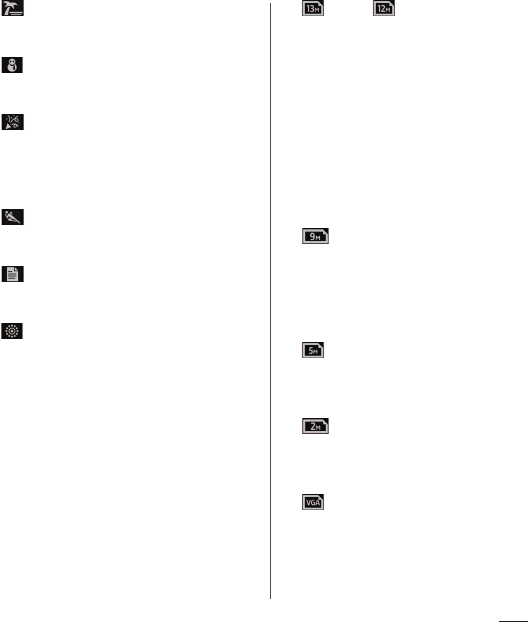
157
Apps
Beach
Reconstruct beach scene brightly and
vividly.
Snow
Reconstruct snow scene brightly and
vividly.
Party
Shoot an indoor picture creating good
atmosphere of indoor lighting. Due to long
exposure time, be careful not to shake
camera.
Sports
To shoot fast-moving object, shorten
exposure time to minimize motion blurring.
Document
Use for shooting text or graphics. It allows to
capture a clear, bright, and easy to read text.
Fireworks
Shoot a crisp and clear images of fireworks.
Due to long exposure time, be careful not to
shake camera.
■
Resolution
Set the resolution for shooting. An image
with a higher resolution requires more
memory.
13MP
/
12MP
13 megapixel (4128
u
3096) or 12 megapixel
(3920
u
2940) image size with 4:3 aspect
ratio. Suitable for viewing on a normal size
screen or printing in high resolution.
When you set the capturing mode (P.154) to
any of the followings, the resolution is set to
12MP.
・
Superior auto
・
Normal (when "HDR" is set to "On")
・
Scene selection (when "Backlight
correction HDR" is set)
9MP
9 megapixel (3920
u
2204) image size with
16:9 aspect ratio. A high resolution wide-
screen format. Suitable for viewing on a
normal size screen or printing in high
resolution.
5MP
5 megapixel (2592
u
1944) image size with
4:3 aspect ratio. Suitable for viewing on
normal size screen.
2MP
2 megapixel (1920
u
1080) image size with
16:9 aspect ratio. Suitable for viewing on
wide-screen.
VGA
VGA format (640
u
480) with 4:3 aspect ratio.
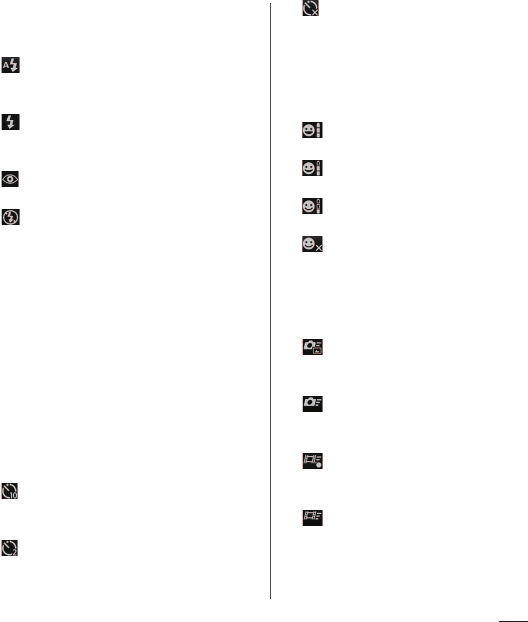
158
Apps
■
Flash
Set the flash to light or not when lighting
conditions are poor or in backlight.
Auto
Turn on the flash automatically according to
the brightness.
Fill flash
Always turn on the flash regardless of the
brightness.
Red-eye reduction
Reduce red-eye effect caused by the flash.
Off
The flash does not turn on.
・
Sometimes still picture quality can be
better without flash. When you do not
turn on the flash, use the self-timer to
avoid blurring still picture.
■
Self-timer
Shoot when a set time elapses after the
shutter icon or shooting screen is tapped or
k
is pressed.
Use it to shoot self-portraits, or group
pictures where everyone can be in the
picture. You can also use the self-timer to
avoid camera shake.
On (10 sec.)
Shutter clicks 10 seconds after tapping or
pressing
k
.
On (2 sec.)
Shutter clicks 2 seconds after tapping or
pressing
k
.
Off
Shutter clicks right after tapping or pressing
k
.
■
Smile Shutter
Shoot faces at the moment they smile
(P.169).
Big smile
Shoot when a big smile is detected.
Average smile
Shoot when a smile is detected.
Small smile
Shoot when even a tiny smile is detected.
Off
Cancel smile detection function.
■
Quick launch
Set behavior when using Quick launch
(P.168).
Launch and capture
Activate the camera to shoot a picture
immediately.
Launch only (still camera)
Activate the camera to display shooting
screen.
Launch and record movie
Activate the camera to record a video
immediately.
Launch only (movie camera)
Activate the camera to display recording
video screen.
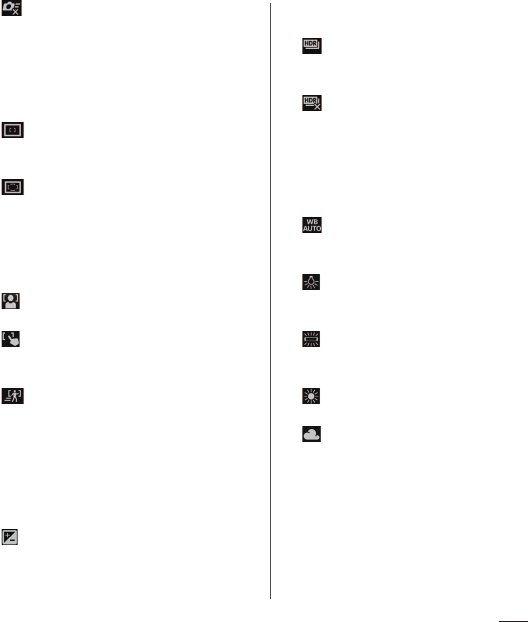
159
Apps
Off
Do not use Quick launch.
■
Focus mode
Set focus controls.
The setting is available only when the
capturing mode (P.154) is set to "Normal".
Single autofocus
The camera automatically focuses on the
center of the shooting screen.
Multi autofocus
The camera automatically focuses on
several points on the shooting screen. For
places which are focused on by tapping the
shutter icon or shooting screen, or pressing
k
, white focus frames turn to blue.
Face detection
Detect a face to focus (P.169).
Touch focus
Tap an object on the shooting screen. The
focus frame moves onto the tapped place.
Object tracking
The camera chases an object and focuses
on it.
■
Exposure value
Adjusting brightness with exposure value.
The setting is available only when the
capturing mode (P.154) is set to "Normal".
Exposure value
Drag the bar to adjust the exposure value.
■
HDR
Set the high dynamic range function.
On
Shoot with the high dynamic range
imaging function.
Off
Cancel the high dynamic range function.
■
White balance
Adjust the color balance to the light source.
The setting is available only when the
capturing mode (P.154) is set to "Normal".
Auto
Adjust the color balance automatically to
the light source.
Incandescent
Adjust the color balance for lighting like
incandescent bulb.
Fluorescent
Adjust the color balance for lighting like
fluorescent.
Daylight
Adjust the color balance for a sunny place.
Cloudy
Adjust the color balance for a cloudy sky or
shaded area.
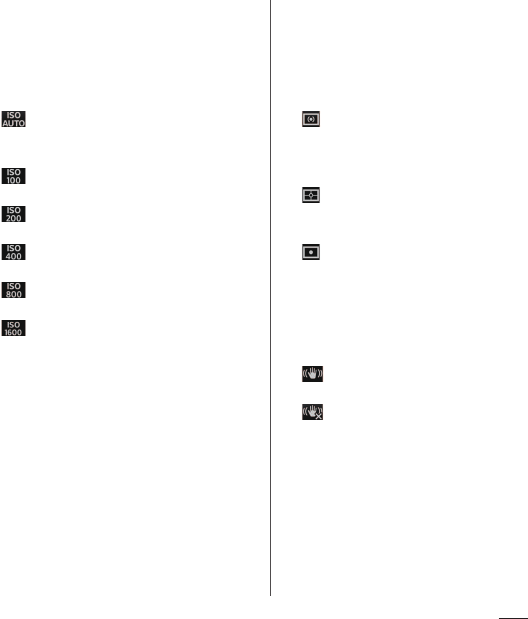
160
Apps
■
ISO
Set ISO sensitivity. Shoot clear picture
reducing blur even in a place where
lightning is poor.
The setting is available only when the
capturing mode (P.154) is set to "Normal".
Auto
Set to the appropriate sensitivity from "100"
to "1600".
100
Set sensitivity to 100.
200
Set sensitivity to 200.
400
Set sensitivity to 400.
800
Set sensitivity to 800.
1600
Set sensitivity to 1600.
■
Metering
Measure the brightness on the shooting
screen to determine a well-balanced
exposure automatically.
The setting is available only when the
capturing mode (P.154) is set to "Normal".
Center
Put emphasis at the center of the shooting
screen and measure photometry at whole
view finder to adjust the exposure.
Average
Adjust the exposure based on the
brightness of the whole shooting screen.
Spot
Measure photometry only at the center of
the shooting screen to adjust the exposure.
■
Image stabilizer
Compensate for photo blur caused by small
movements of the hand when shooting.
On
Reduce blur.
Off
The stabilizer is not used.
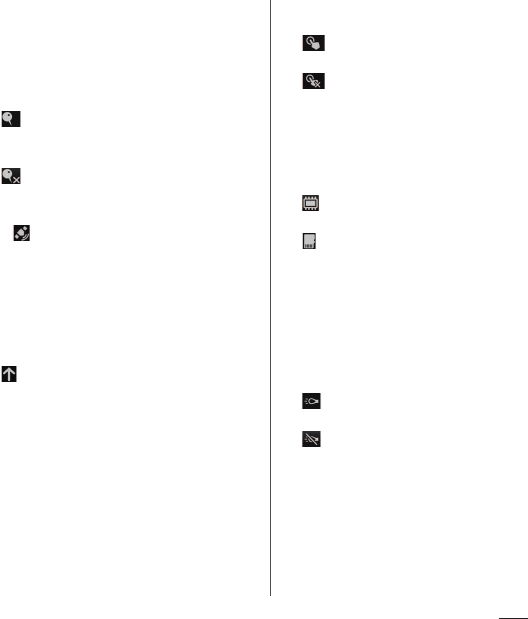
161
Apps
■
Geotagging
Tag photos location information (geotag)
for the shooting spot. Enable the location
information service setting to add Geotag.
For details on location information service,
see "Location services" (P.180).
On
Geotag (location information) is added to
specify the shooting spot of the photo.
Off
Shooting location cannot be viewed on a
map.
・
appears while acquiring location
information. To pictures shot while
acquiring location information, geotags
are not added.
■
Auto upload
Automatically upload shot pictures to
PlayMemories Online.
Auto upload
Shot images are automatically uploaded.
Tapping the icon opens the setting screen.
Mark "PlayMemories Online" and follow the
onscreen instructions.
■
Touch capture
Tap the shooting screen to shoot an image.
On
Tap the shooting screen to shoot an image.
Off
Tap the shutter icon to shoot.
・
Even when "Touch capture" is set to "ON",
pressing
k
shoots a picture.
■
Data storage
Set the saving location for shot pictures.
Internal storage
Save shot pictures in the internal storage.
SD card
Save shot pictures in a microSD card.
■
Photo light
Use the photo light to shoot when lighting
conditions are poor or in backlight.
The setting is available only when the
capturing mode (P.154) is set to "Burst" or
"Sweep Panorama".
On
The photo light turns on.
Off
The photo light does not turn on.
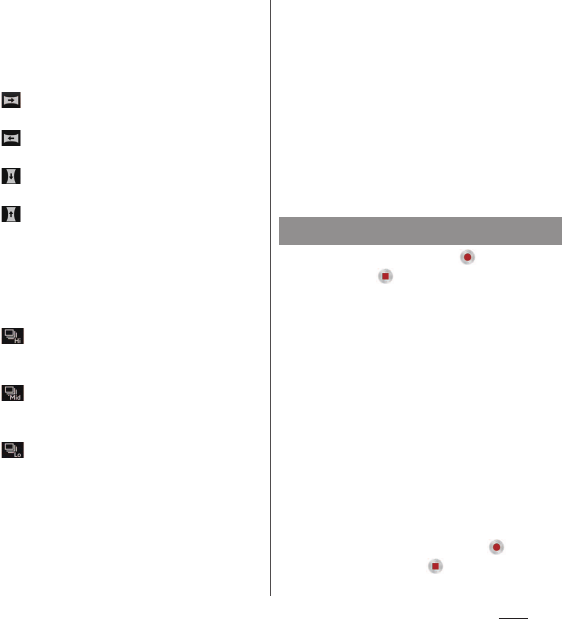
162
Apps
■
Shooting direction
Set shooting direction for Sweep Panorama.
The setting is available only when the
capturing mode (P.154) is set to "Sweep
Panorama".
Right
Shoot moving the camera from left to right.
Left
Shoot moving the camera from right to left.
Down
Shoot moving the camera downward.
Up
Shoot moving the camera upward.
■
Burst speed
Set continuous shooting speed.
The setting is available only when the
capturing mode (P.154) is set to "Burst".
High
Shoot at high speed and 1280
u
720 image
size with 16:9 aspect ratio.
Middle
Shoot at medium speed and 3920
u
2204
image size with 16:9 aspect ratio.
Low
Shoot at low speed and 1920
u
1080 image
size with 16:9 aspect ratio.
❖
Information
・
For available setting items when the capturing mode
(P.154) is set to "Front camera", see "Front camera"
(P.168).
・
Some settings cannot be used in combination with
one another.
・
If you shoot pictures continuously with "Data
storage" set to "SD card", dropping frames may occur
depending on the writing speed of microSD card. For
fully using the performance of continuous shooting
with "High" or "Middle", set "Data storage" to "Internal
storage".
Tap the start recording icon ( )/stop
recording icon ( ), tap the recording screen,
or press
k
to start/stop recording a video.
Recorded videos are automatically saved in
the internal storage or a microSD card.
1
Press and hold
k
for over a
second.
2
On the shooting screen, tap the
capturing mode icon (P.154), then
tap [Video camera].
・
The video recording screen (P.153)
appears.
■
Recording with the start recording
icon/stop recording icon
On the recording screen, tap to start
recording, and tap to stop recording.
Recording videos
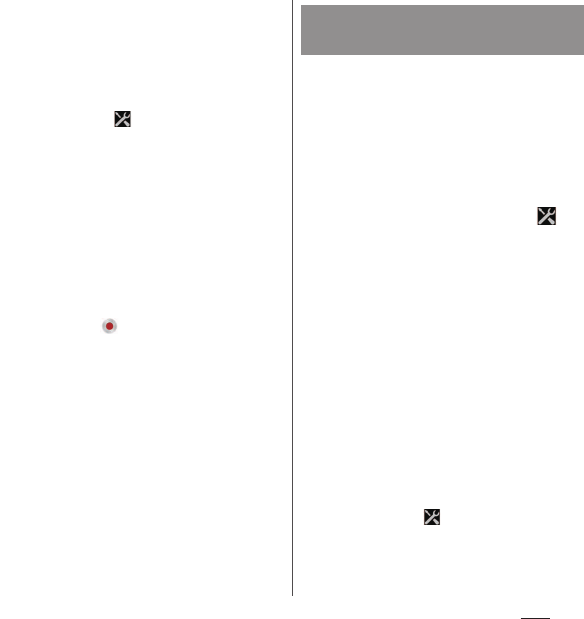
163
Apps
■
Shooting with "Touch capture"
Set "Touch capture", then tap around a
displayed frame on the recording screen
to start recording, and tap the recording
screen to stop recording.
・
To set "Touch capture", on the recording
screen, tap , then tap [Touch
capture]
u
[On].
■
Using the camera key (
k
)
On the recording screen, tap
k
to
start recording, and tap
k
to stop
recording.
・
Even when "Touch capture" (P.167) is
set to "On", pressing
k
starts/stops
recording a video.
❖
Information
・
Alternatively, tap in Step 2 to start recording.
・
Do not cover the microphone with fingers etc. when
recording videos.
・
When you connect a commercially available
earphone set or other Bluetooth device, shutter
sound may be softer.
・
On the video recording screen (P.153) or while
recording video, tap shutter icon to shoot still
pictures.
Shot image size varies by video resolution setting.
Full HD/HD : 1 megapixel (1280
u
720) with 16:9
aspect ratio
VGA : VGA (640
u
480) with 4:3 aspect ratio
QVGA : QVGA (320
u
240) with 4:3 aspect ratio
1
Press and hold
k
for over a
second.
2
On the shooting screen, tap the
capturing mode icon (P.154), then
tap [Video camera].
・
The video recording screen (P.153)
appears.
3
On the shooting screen, tap ,
then tap item to set.
・
Several setting icons are displayed on
the shooting screen in advance. The
displayed setting icons change
depending on the setting conditions.
・
For setting items and icons, see "Video
camera setting" (P.164).
4
Tap an option in the selected
setting.
・
If you change setting options, icons
displayed on the shooting screen
change to the set items.
❖
Information
・
To replace setting item icons displayed on the
recording screen, tap on the recording screen
and touch and hold a setting item and drag it to a
dotted frame.
Changing the recording
settings
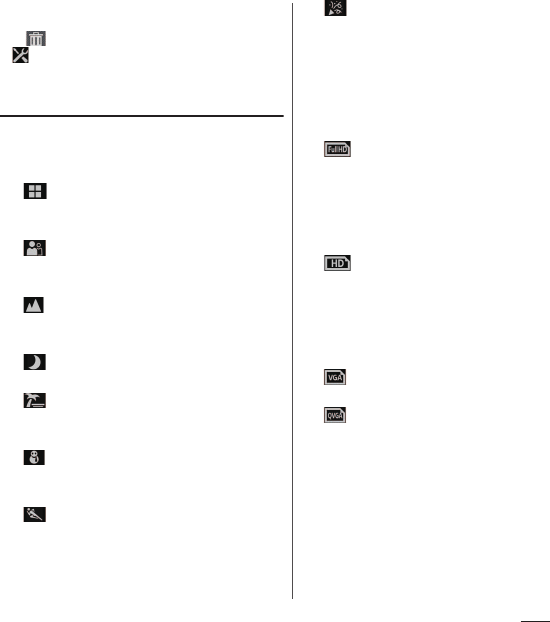
164
Apps
・
To delete a setting item icon displayed on the
shooting screen, touch and hold an icon and drag it
to displayed in the center of the screen.
・
or capturing mode icons (P.154) displayed on the
recording screen cannot be moved or deleted.
Video camera setting
■
Scenes
Use Scenes to quickly set up the camera for
various scene conditions.
Off
Adjust color shade or brightness
automatically.
Soft snap
Settings are optimized to give brighter and
warmer skin tones.
Landscape
Shoot landscape depicting trees with vivid
color and focusing on distant objects.
Night
Shoot a crisp and clear night scene.
Beach
Reconstruct beach scene brightly and
vividly.
Snow
Reconstruct snow scene brightly and
vividly.
Sports
To shoot fast-moving object, shorten
exposure time to minimize motion blurring.
Party
Shoot an indoor picture creating good
atmosphere of indoor lighting.
■
Video resolution
Set the resolution for recording. An image
with a higher resolution requires more
memory.
Full HD
Full HD format (1920
u
1080) with 16:9
aspect ratio.
The setting is available only when the
capturing mode (P.154) is set to "Video
camera".
HD
HD 720p format (1280
u
720) with 16:9
aspect ratio.
The setting is available only when the
capturing mode (P.154) is set to "Video
camera".
VGA
VGA format (640
u
480) with 4:3 aspect ratio.
QVGA
QVGA format (320
u
240) with 4:3 aspect
ratio.
The setting is available only when the
capturing mode (P.154) is set to "Front
video".
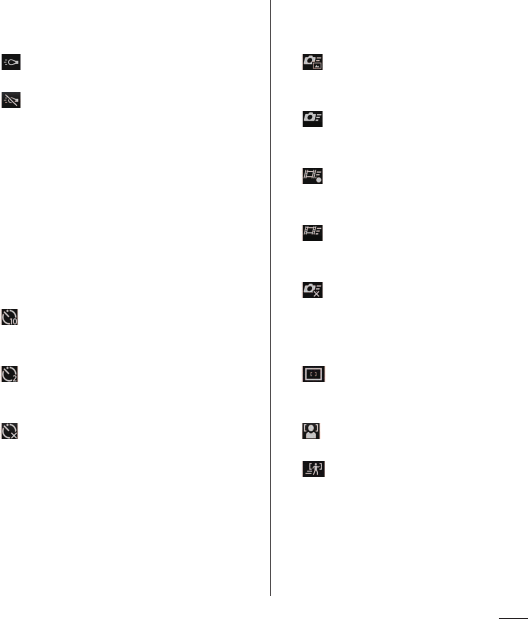
165
Apps
■
Photo light
Use the photo light to shoot when lighting
conditions are poor or in backlight.
On
The photo light turns on.
Off
The photo light does not turn on.
Sometimes the video quality can be better
without a photo light, even if lighting
conditions are poor. Recording a good
video without using the photo light
requires a steady hand.
■
Self-timer
Start recording when a set time elapses
after the start recording icon or shooting
screen is tapped or
k
is pressed.
On (10 sec.)
Recording starts 10 seconds after tapping or
pressing
k
.
On (2 sec.)
Recording starts 2 seconds after tapping or
pressing
k
.
Off
Recording starts right after tapping or
pressing
k
.
■
Quick launch
Set behavior when using Quick launch
(P.168).
Launch and capture
Activate the camera to shoot a picture
immediately.
Launch only (still camera)
Activate the camera to display shooting
screen.
Launch and record movie
Activate the camera to record a video
immediately.
Launch only (movie camera)
Activate the camera to display recording
video screen.
Off
Do not use Quick launch.
■
Focus mode
Set focus controls.
Single autofocus
The camera automatically focuses on the
center of the shooting screen.
Face detection
Detect a face to focus (P.169).
Object tracking
The camera chases an object and focuses
on it.
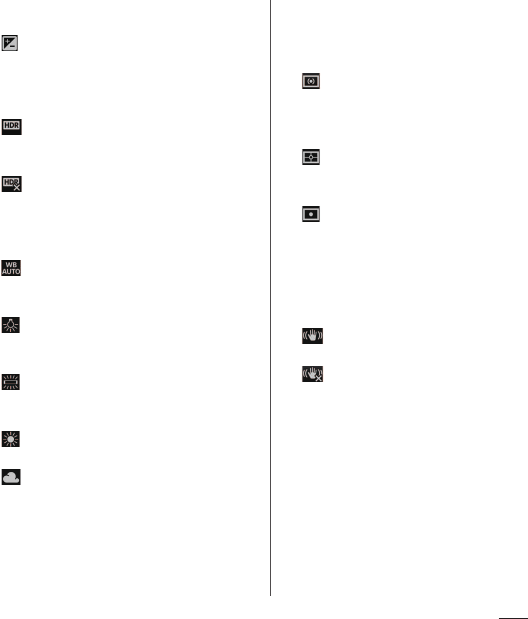
166
Apps
■
Exposure value
Adjust brightness with Exposure value.
Exposure value
Drag the bar to adjust the exposure value.
■
HDR Video
Set the high dynamic range function.
On
Shoot with the high dynamic range
imaging function.
Off
Cancel the high dynamic range function.
■
White balance
Adjust the color balance to the light source.
Auto
Adjust the color balance automatically to
the light source.
Incandescent
Adjust the color balance for lighting like
incandescent bulb.
Fluorescent
Adjust the color balance for lighting like
fluorescent.
Daylight
Adjust the color balance for a sunny place.
Cloudy
Adjust the color balance for a cloudy sky or
shaded area.
■
Metering
Measure the brightness on the shooting
screen to determine a well-balanced
exposure automatically.
Center
Put emphasis at the center of the shooting
screen and measure photometry at whole
view finder to adjust the exposure.
Average
Adjust the exposure based on the
brightness of the whole shooting screen.
Spot
Measure photometry only at the center of
the shooting screen to adjust the exposure.
■
Image stabilizer
Compensate for movements of the camera
while recording a video.
On
Reduce blur.
Off
The stabilizer is not used.
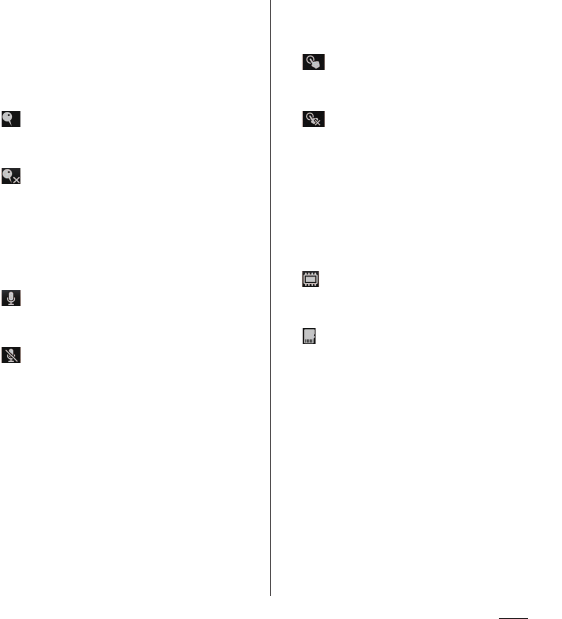
167
Apps
■
Geotagging
Tag videos location information (geotag) for
the recording spot. Enable the location
information service setting to add Geotag.
For details on location information service,
see "Location services" (P.180).
On
Geotag (location information) is added to
specify the recording spot of the video.
Off
Recording location cannot be viewed on a
map.
■
Microphone
Set whether to pick up the surrounding
sound when recording videos.
On
Pick up the surrounding sound when
recording videos.
Off
Do not pick up the surrounding sound
when recording videos.
■
Touch capture
Tap the recording screen to start/stop
recording a video.
On
Tap the recording screen to start/stop
recording a video.
Off
Tap the start recording icon/stop recording
icon to start/stop recording a video.
・
Even when "Touch capture" is set to "On",
pressing
k
starts/stops recording a
video.
■
Data storage
Set the saving location for recorded videos.
Internal storage
Save recorded videos in the internal
storage.
SD card
Save recorded videos in a microSD card.
❖
Information
・
For available setting items when the capturing mode
(P.154) is set to "Front video", see "Front camera"
(P.168).
・
Some settings cannot be used in combination with
one another.
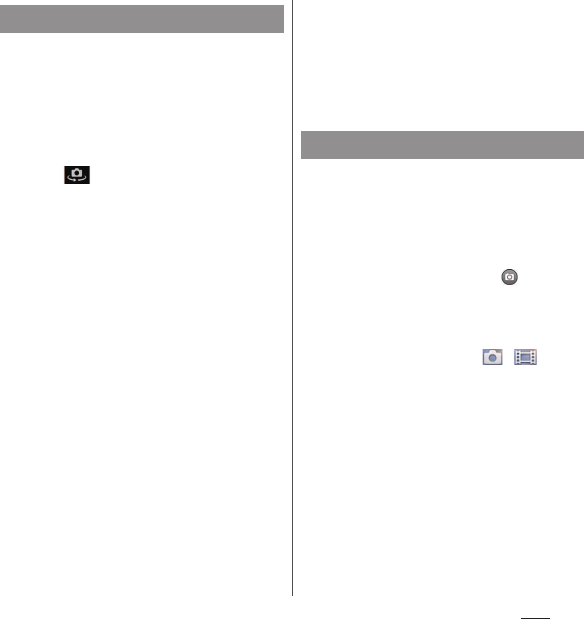
168
Apps
Front camera allows you to shoot your own
picture or video while watching the shooting
screen.
1
Press and hold
k
for over a
second.
・
The shooting screen (P.153) appears.
2
Tap on the shooting/recording
screen.
3
Shoot photo/video.
・
For information on how to shoot, see
"Shooting still pictures" (P.154) or
"Recording videos" (P.162).
❖
Information
・
Alternatively, on the shooting screen, tap the
capturing mode icon (P.154), then tap [Front
camera]/[Front video] to switch to the Front camera/
Front video camera.
・
For using Front camera, "Self-timer", "Smile Shutter",
"Geotagging", "Auto upload", "Touch capture", "Data
storage" can be set. Other "Still camera setting"
(P.156) are not supported by Front camera.
- Resolution for Front camera is "VGA". The resolution
cannot be changed.
- Some settings take over the camera settings set at
the time when switching.
・
For using Front video camera, "Video resolution",
"Self-timer", "Geotagging", "Microphone", "Touch
capture", "Data storage" can be set. Other "Video
camera setting" (P.164) are not supported by Front
video camera.
- Some settings take over the camera settings set at
the time when switching.
Quick launch allows you to activate camera
to shoot when using other application, or
from the the unlock screen, the Home screen,
etc.
❖
Information
・
By default, on the unlock screen, tap to activate
camera.
・
Only when "Set all to" or "Lock screen" in Preferred
apps settings (P.214) to "Xperia
™
", and set the screen
unlock method (P.218) to "Swipe/Touch", you can also
activate the camera by dragging / left on
the unlock screen.
1
Press and hold
k
for over a
second.
・
"Launch only (still camera)" to activate
the camera is set by default.
・
For behavior when using Quick launch,
make setting from the shooting screen.
For details, see "Quick launch" (P.158).
Front camera
Quick launch
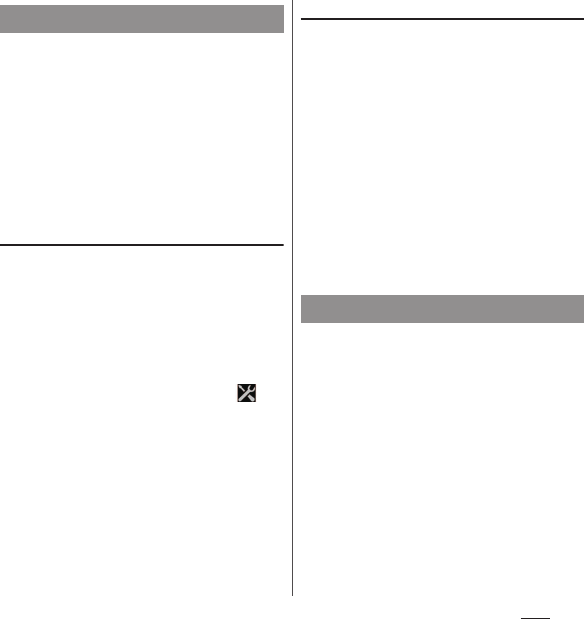
169
Apps
Use Face detection to focus on a face located
away from the center. The camera detects up
to 5 faces and selects 1 face for auto focus.
The camera determines the most suitable
face according to the balance of distance
from the camera and from the center. A
selected face is surrounded with a yellow
frame and automatically focused on. You can
select a face to focus on by tapping a frame.
Setting face detection
1
Press and hold
k
for over a
second.
・
The shooting screen (P.153) appears.
2
On the shooting screen, tap the
capturing mode icon (P.154), then
tap [Normal]/[Video camera].
3
On the shooting screen, tap
and [Focus mode]
u
[Face
detection].
Shooting using face detection
1
With Face detection set, point the
camera at the object.
・
Each detected face is framed (up to 5
faces).
2
Tap the frame you want to focus on
or let the camera select which face
to focus on without tapping.
・
A yellow frame shows the face in focus.
3
Shoot photo/video.
・
For information on how to shoot, see
"Shooting still pictures" (P.154) or
"Recording videos" (P.162).
Smile shutter allows you to capture a face just
as it smiles. The camera detects up to 5 faces
and selects 1 face for smile shutter and auto
focus. A selected face is surrounded with a
yellow frame and when the selected face
smiles, the frame turns to blue and the
camera automatically takes a photo.
Face detection
Smile Shutter
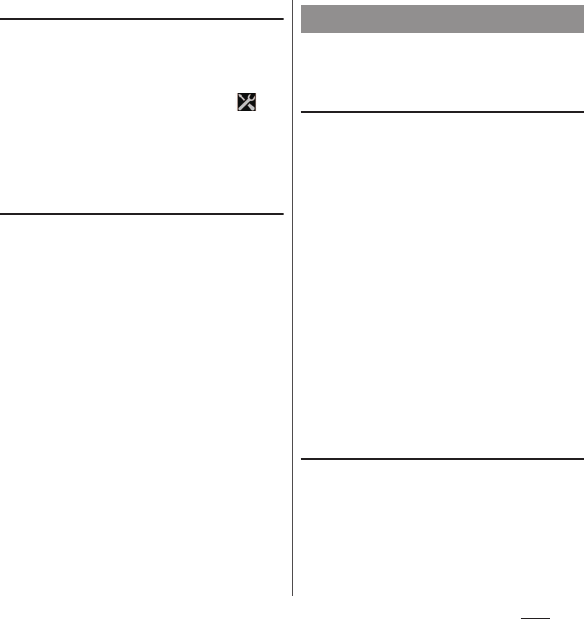
170
Apps
Setting smile shutter
1
Press and hold
k
for over a
second.
・
The shooting screen (P.153) appears.
2
On the shooting screen, tap ,
then tap [Smile Shutter].
3
Select smile level for the smile
shutter.
Taking a photo using smile shutter
1
Set smile shutter, and point the
camera at the object.
・
Each detected face is framed (up to 5
faces).
・
The camera selects which face to focus
on. A yellow frame shows the face in
focus.
2
The camera automatically takes
the photo when a face in focus
smiles.
・
Shot pictures are automatically saved in
the internal storage or a microSD card.
・
If no smile is detected, operate the
steps in "Shooting still pictures" (P.154)
to shoot a picture.
Picture effect allows you to shoot pictures
with various picture effects.
Setting picture effects
1
Press and hold
k
for over a
second.
・
The shooting screen (P.153) appears.
2
On the shooting screen, tap the
capturing mode icon (P.154), then
tap [Picture effect].
3
Select a picture effect.
・
Select from "Nostalgic", "Miniature",
"Vivid", "Filter", "Fisheye", "Sketch", "Partial
color", "Harris shutter" or "Kaleidoscope".
❖
Information
・
On the screen for selecting a picture effect, press
m
to capture a screenshot.
・
Resolution for the picture effect is "2MP". The
resolution cannot be changed.
Taking a picture using picture effect
1
Set picture effect, and point the
camera at the object.
・
Tap or pinch to change the picture
effect setting.
Picture effect

171
Apps
2
Press
k
.
・
Alternatively, tap the shutter icon to
shoot.
・
Shot pictures are automatically saved in
the internal storage or a microSD card.
❖
Information
・
When you shoot a picture using picture effect,
"Touch capture" (P.155) is not available.
Use Sweep Panorama to shoot panoramic
image with wide angle.
Aligning the white frame on the screen with
the black frame, move the camera slowly
toward the set shooting direction to shoot.
Setting Sweep Panorama
1
Press and hold
k
for over a
second.
・
The shooting screen (P.153) appears.
2
On the shooting screen, tap the
capturing mode icon (P.154), then
tap [Sweep Panorama].
・
Tap / to set "Shooting direction"
(P.162) or "Photo light" (P.161).
Shooting Sweep Panorama
1
Set Sweep Panorama, point the
camera at the object.
2
Shoot a still picture.
・
For information on how to shoot
pictures, see "Shooting still pictures"
(P.154).
・
A white frame and big black frame
appear on the shooting screen.
3
Aligning the white frame with the
black frame, slowly move the
camera from left to right.
・
If you change shooting direction, slowly
move the camera in the set direction.
・
Shot pictures are saved automatically in
the internal storage or a microSD card.
❖
Information
・
For shooting with Sweep Panorama, always hold the
camera horizontally.
Use Burst to shoot a series of images.
Setting continuous shoot
1
Press and hold
k
for over a
second.
・
The shooting screen (P.153) appears.
Sweep Panorama
Continuous shooting
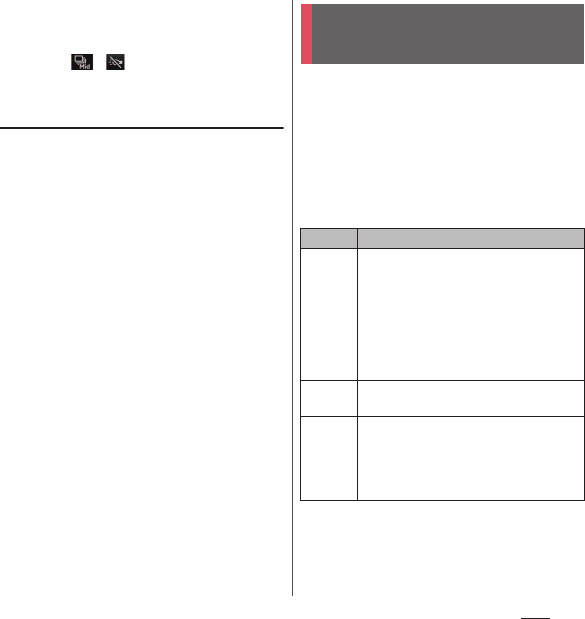
172
Apps
2
On the shooting screen, tap the
capturing mode icon (P.154), then
tap [Burst].
・
Tap / to set "Burst speed"
(P.162) or "Photo light" (P.161).
Shooting continuously
1
Set Burst and point the camera to
an object.
2
Press and hold
k
for over a
second.
・
Pictures are continuously shot while
k
is pressed.
・
Alternatively, touch and hold the
shutter icon to operate. Pictures are
continuously shot while the shutter
icon is touched and held.
・
Shot pictures are automatically saved in
the internal storage or a microSD card.
❖
Information
・
"Touch capture" (P.155) is not available while Burst is
set.
Photos or videos that you took with the
terminal or multimedia contents (music,
photos, videos, etc.) saved in the internal
storage or microSD card are viewed/played in
applications such as "Media Player",
"WALKMAN", "Album".
The terminal can play the following
multimedia contents:
Playing multimedia
content
Type File format
Sound
WAV (PCM, G.711) (.wav), AAC (.3gp, .m4a,
.mp4), AAC+ (.3gp, .m4a, .mp4), eAAC+
(.3gp, .m4a, .mp4), MP3 (.mp3), AMR-NB
(.3gp), AMR-WB (.3gp), MIDI (SP-MIDI/GM/
GML (.mid), XMF (.xmf), Mobile XMF 1.0
(.mxmf ), RTTTL/RTX (.rtttl, .rtx), OTA (.ota),
iMelody (.imy)), Ogg Vorbis (.ogg), FLAC
(.flac), PIFF (.isma)
Still
image
JPEG (.jpeg, .jpg), GIF (.gif ), PNG (.png), BMP
(.bmp), WEBP (.webp)
Video
H263 (.3gp, .3gpp, .mp4, .m4v), H264 (.3gp,
.3gpp, .mp4, .m4v), MPEG4 (.3gp, .3gpp,
.mp4, .m4v), VP8 (.webm, .mkv), Xvid (.avi,
.xvid, .mkv, .3gp, .3gpp, .mp4, .m4v), WebM
(.webm), AVI (.avi), PIFF (.ismv)
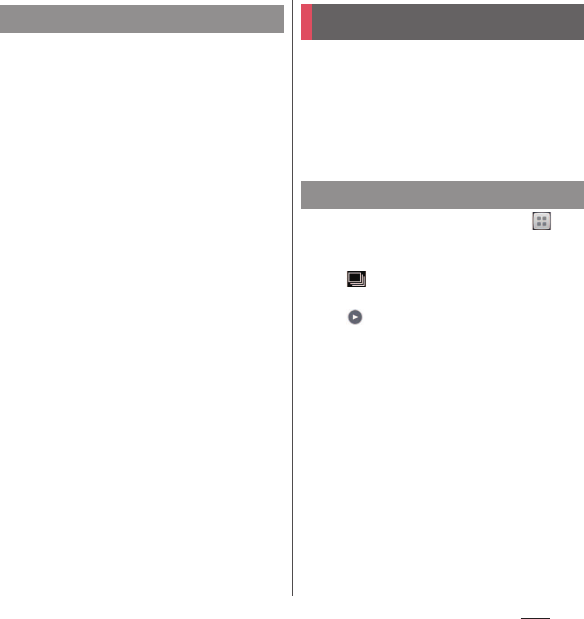
173
Apps
Avoid copyright infringements when you
handle photos, videos, or sound recorded
using the terminal, e.g. copy/edit. In addition,
avoid rights infringements of portraits by
using these photos without consent, altering
them or by other means. Note that capturing
or recording a stage performance,
entertainment or exhibition may be
prohibited even if for personal use.
Please be considerate of the privacy of
individuals around you when taking and
sending photos using camera-equipped
mobile phones.
Images, photos and videos you took can be
viewed and played. Also, use Media Go to
transfer content to the terminal and to take
content from an external device. For details,
refer to "Connecting to a PC with microUSB
cable" (P.241).
1
From the Home screen, tap ,
then tap [Album].
・
Album screen appears.
・
is displayed for files of pictures
continuously shot.
・
is displayed for video files.
❖
Information
・
Depending on the number of saved images, it may
take some times to load images.
Copyright protected content
Album
Viewing picture/video
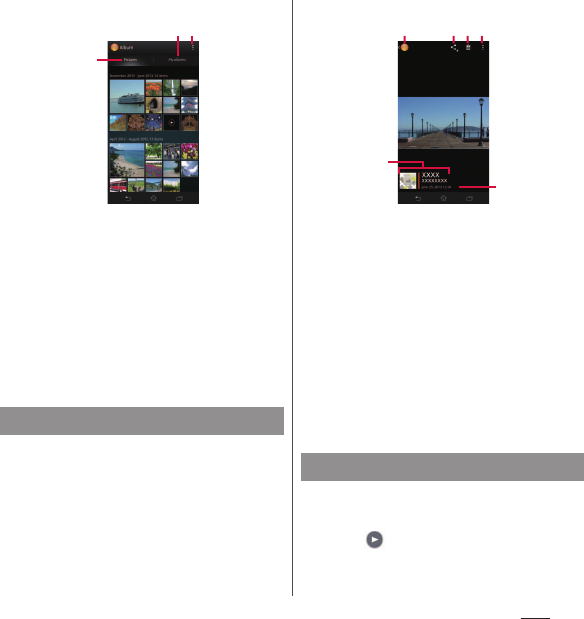
174
Apps
■
Album screen
a
Pictures tab
・
Pictures are displayed in a list of chronological
order. Pinch-out/in on the screen to zoom in/out
image.
b
My albums tab
・
You can view albums in a list. You can view
images with Geotagging attached on a map,
saved images, pictures shot by the camera,
albums synchronized on an online service, and
images on a device registered in the Media server.
c
View optional menu
1
Tap a picture on the Album screen.
・
The still picture viewing screen appears.
・
Tap the screen to display information
such as shooting date, option menu
icons, etc.
・
When you tap a file for pictures
continuously taken, tap a picture in a
row.
■
Still picture viewing screen
a
Location information
・
For a geotagged image, a country name and a
region name appear, and tap the icon to view the
image on the map.
b
Go back to the album screen
c
View share menu (P.175)
d
Delete image (P.175)
e
View optional menu (P.175)
f
Shooting date and time
❖
Information
・
Pinch-out/in on the picture viewing screen to zoom
in/out image.
・
The items vary depending on the selected file.
1
Tap a video on the Album screen.
・
Video playback screen appears.
2
Tap .
・
Video is played.
Viewing pictures
a
bc
Playing video
f
a
b c d e
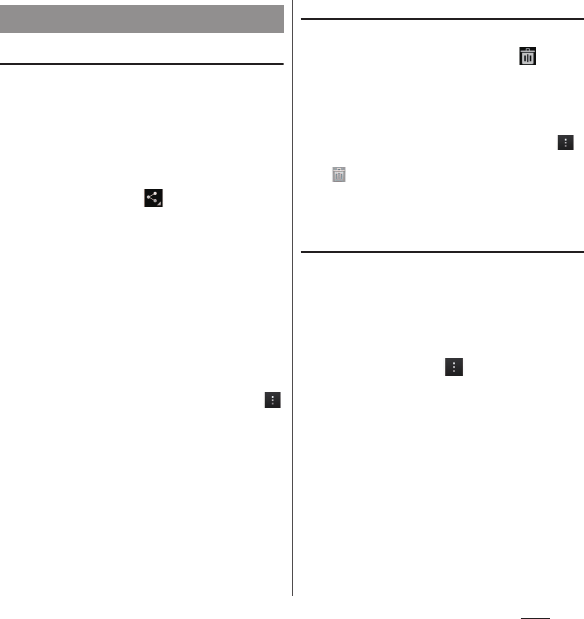
175
Apps
Sharing image files
You can share image files by attaching to
Gmail or Email, uploading to Picasa or
Google+, or sending to other devices via
Bluetooth or infrared communication.
1
On the picture viewing screen/
video playing screen, tap the
screen and tap .
・
Menu for sharing image file appears.
・
Tap [See all] to display all share menus.
2
Select sharing method for image
file.
・
After this step, follow the onscreen
instructions.
❖
Information
・
Different options may be shown or some items
cannot be operated in some image files.
・
To operate several files, on the album screen, tap
and [Select items] to select image files.
・
When you select "Infrared" in Step 2, the Send via
infrared message appears. Tap [OK] to start sending.
For details on infrared communication, see "Using
infrared communication" (P.232).
・
For shared files, file sizes and file types are not
particularly limited, but may be limited by the
application to transfer. DRM content cannot be
shared.
Deleting image files
1
On the picture viewing screen/
video playing screen, tap and
tap [Delete].
・
Image file is deleted.
❖
Information
・
To delete several files, on the album screen, tap
and [Select items], then select image files to delete,
tap and tap [Delete]. When a file contains pictures
continuously taken, tap [Delete cover]/[Delete
burst]
u
[Delete].
Using optional menu
View slideshow, edit image, set image to
phonebook entry or as wallpaper, check
shooting date and time, etc.
1
On the picture viewing screen/
video playing screen, tap the
screen and tap .
2
From the displayed menu, select
item you want to use.
・
After this step, follow the onscreen
instructions.
Operating image files
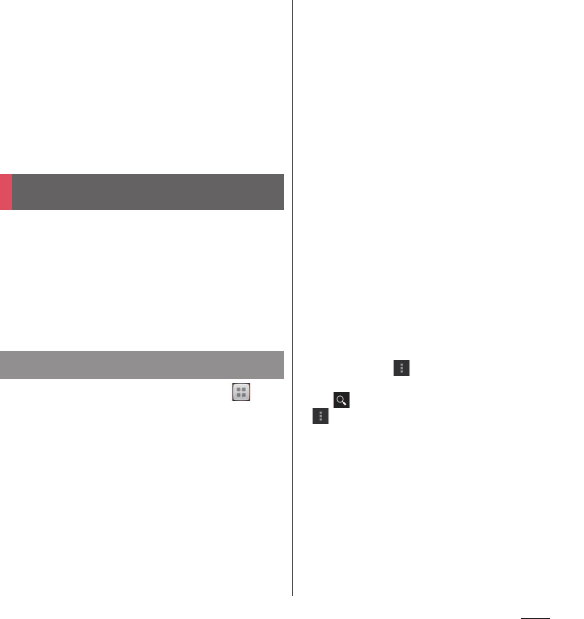
176
Apps
❖
Information
・
Different options may be shown or some items
cannot be operated in some image files.
・
In Step 2, tap "Throw" to display the connection
device selection screen (if no devices are found, tap
[Add new device] to make the setting). Select a
device on the connection device selection screen to
share files between a DLNA device, Bluetooth device,
or screen mirroring device and the terminal.
YouTube is a free online video streaming
service. You can play, search for and upload
videos.
・
A packet communication charge is applied
when downloading or uploading video
content using mobile networks.
1
From the Home screen, tap ,
then tap [YouTube].
・
If you do not set Google account, the
Google account setting screen appears.
Follow the onscreen instructions.
・
When a message appears, follow the
onscreen instructions.
・
A list of videos appears. You can select
from categories.
2
Tap a video to play it.
・
Tap the screen to display play/pause
icon or progress bar. Drag the marker
left or right on the progress to change
playing point.
・
Turn the terminal sideways to switch to
the landscape view.
・
Tap
x
to stop playing and return to
the video list screen.
・
To quit YouTube, tap
y
.
❖
Information
・
For movies with caption function which can display
subtitles, "CC" appears by tapping the screen while
playing in the landscape screen. Tap [CC] to set the
caption function.
・
When "HD" or "HQ" appears by tapping the screen
while playing in the landscape screen mode, tap
[HD]/[HQ] to play in high quality. A video plays in
high quality when Wi-Fi is connected. To always play
video in high quality even when mobile network is
connected, tap , then tap [Settings]
u
[General]
then mark "High quality on mobile" checkbox.
・
Tap to search videos. To delete search history, tap
and [Settings]
u
[Search]
u
[Clear search
history]
u
[OK].
You Tube
Playing YouTube video
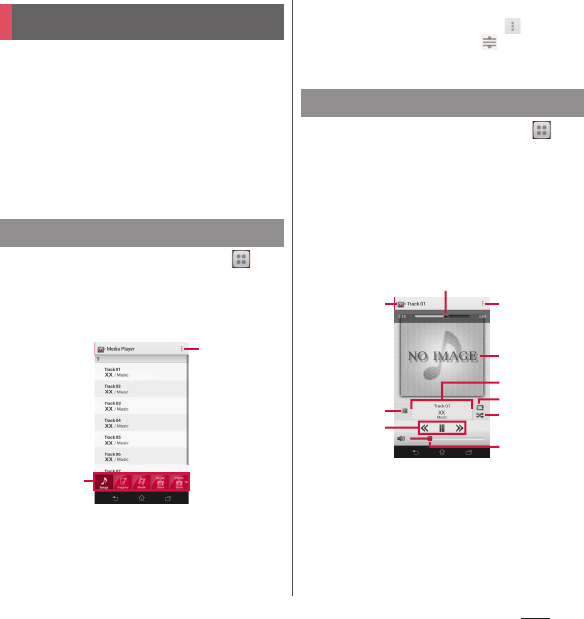
177
Apps
Play back music and videos stored on the
internal storage or a microSD card using
Media Player.
・
For information on how to copy music and
video data from a PC, see "Connecting to a PC
with microUSB cable" (P.241).
・
For information on file formats of playable
data, see "Playing multimedia content" (P.172).
1
From the Home screen, tap ,
then tap [Media Player].
・
Media Player screen appears.
■
Media Player screen
a
Tab
・
Change displayed information.
・
Flick left or right.
b
View optional menu
❖
Information
・
To change the order of tab icons, tap and tap
[Settings]
u
[Arrange icons], drag up and down
on the item to change then tap [Apply].
1
From the Home screen, tap ,
then tap [Media Player].
・
Tap [Movie] tab at the bottom of the
screen to display video list.
2
Tap a song/video.
・
Song/video is played.
■
Music playback screen
a
Back to song list
b
Go back to the beginning of the track or to the
previous track/Play or pause/Skip to the next track
c
Playback point
d
View optional menu
e
Album art
f
Song information
g
Repeat OFF/Repeat ON/1 track repeat
Media Player
Activating Media Player
a
b
Playing music/video
a
a
c
g
e
f
d
i
b
h
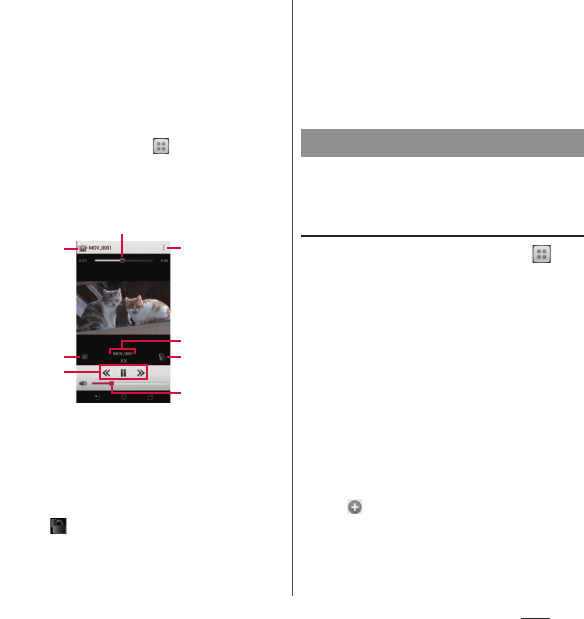
178
Apps
h
Shuffle OFF/Shuffle ON
i
Volume control
・
Alternatively, press
m
during playback to
adjust volume.
❖
Information
・
You can return to the Home screen to perform
another operation while listening to music in the
background. To return to the music playback screen,
from the Home screen, tap then tap [Media
Player], or drag the status bar downward to tap the
name of song that is being played.
■
Video playback screen
a
Back to video list
b
Go back to the beginning of the video or to the
previous video/Play or pause/Skip to the next video
c
Playback point
d
View optional menu
e
Video information
f
Auto-rotate screen ON/OFF
・
Tap to turn red and disable Auto-rotate
screen.
g
Volume control
・
Alternatively, press
m
during playback to
adjust volume.
❖
Information
・
While in landscape view, tap the screen to display
option menu icons etc.
You can play back songs in the order you
decided using playlist.
Creating a playlist
1
From the Home screen, tap ,
then tap [Media Player].
2
Flick left and right on tabs at the
bottom of the screen and tap [Play
list].
・
Play list screen appears.
3
Tap [Create new] and enter the
access point name and tap [OK].
4
Tap [Add songs to playlist] and
select songs you want to add.
・
You can also select songs from "Artists"
and "Albums".
・
on the selected song turns red and
the song is added to Play list by each
tap.
5
Tap [Apply]
u
[Save]
u
[OK].
c
b
a
a
f
d
e
g
Playlist
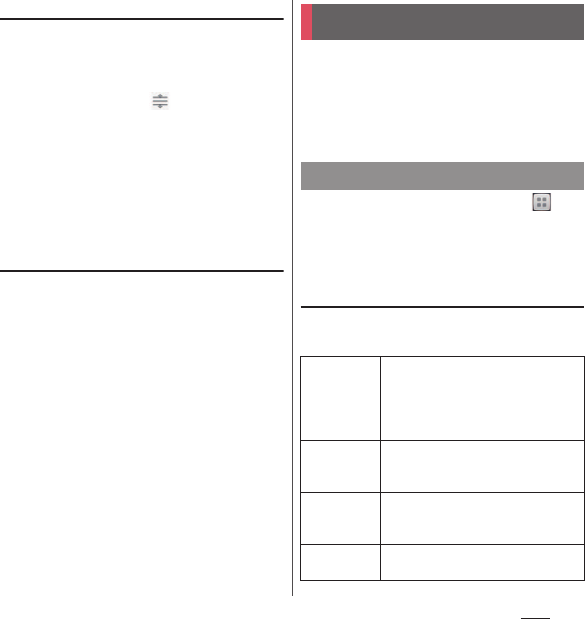
179
Apps
Editing songs in playlist
1
On the play list screen, select a
playlist to edit and tap [Edit].
■
Changing order of the songs
Drag up and down in song to change
order and tap [Save]
u
[OK].
■
Deleting songs from playlist
Select a song to delete and tap
[Save]
u
[OK].
・
Tapping [Delete all songs] toggles
select all/deselect all.
Deleting playlist
1
On the play list screen, tap [Edit].
2
Select a playlist you want to
delete.
3
Tap [Save]
u
[OK].
・
Tapping [Delete all playlists] toggles
select all/deselect all.
❖
Information
・
"Recently added songs", "Recently played songs", and
"Most played songs" playlists cannot be deleted.
Socialife is an application with which you can
view or manage SNS such as Facebook,
Twitter, etc. or news websites etc. collectively.
・
To use Socialife, an account for Facebook or
Sony Entertainment Network is needed.
1
From the Home screen, tap ,
then tap [Socialife].
・
After this step, follow the onscreen
instructions.
Menu
Various operations can be done from the
following menu.
Socialife
Activating Socialife
My Stream
Display timelines of registered
network services and news sites as
one. Also, displaying them by category
such as Facebook, Twitter, news, etc. is
available.
Favorites
Display SNS messages, news articles,
etc. registered to Favorites in My
stream.
Discovery
Display popular news sites among
Socialife users, recommended news
sites, etc.
Settings
Register news site, manage sign-in IDs,
or display help or information, etc.

180
Apps
Your current location can be positioned using
GPS, Wi-Fi, or mobile network. If you use GPS
technology it may take a little longer, but it
will find your position with high precision. If
you use Wi-Fi or mobile network, your
position is found shortly but accuracy may
decrease. Use GPS, Wi-Fi, and mobile network
in combination to quickly find your position
with high precision.
The terminal has a GPS receiver that uses
satellite signals to calculate your location.
Some GPS features use the Internet. Data
rates and charges may apply.
When you use GPS function to find your
location, make sure you have a clear view of
the sky. If GPS does not find your location
after several minutes, move to another
location. To help the search, stand still and do
not cover the GPS antenna section (P.29). The
first time you use the GPS, it may take about
10 minutes to find your location.
・
Use the GPS system with great care. DOCOMO
is not liable for any damage caused by
abnormality of the system.
・
Note that DOCOMO shall have no liabilities for
any purely economic loss including those due
to missing a chance to check the
measurement (communication) results
because of external factors (including the
running out of the battery), such as a failure,
malfunction, or any other problems of the
terminal or the power failure.
・
You cannot use the terminal as a navigation
device for an aircraft, vehicle, and person.
Note that DOCOMO shall have no liabilities
whatsoever even if you suffer damage or loss
while performing a navigation using the
location information.
・
You cannot use the terminal as a high-
accuracy measurement GPS. Note that
DOCOMO shall have no liabilities whatsoever
even if you suffer damage or loss due to a
deviation of the location information.
・
The GPS signals cannot be easily received
near a vehicle's sun visor with metal parts.
・
GPS is operated by the U.S. Department of
Defense. The department controls the
accuracy of the system, and manages the
system. Therefore, GPS radio wave condition
may be controlled (degradation of accuracy,
suspension of radio wave transmission, etc.) at
the discretion of the U.S. Department of
Defense.
Location services
GPS function

181
Apps
・
Some wireless communications products
(mobile phone, data detectors and some
others) block satellite signals and also causes
instability of signal reception.
・
Some map displays based on location
information (latitude/longitude information)
may be not accurate due to some countries'
or regions' regulations.
■
Where radio waves are difficult to
receive
Note that radio waves may not be received
or it may be difficult to receive radio waves
in the following conditions, since GPS uses
radio waves from a satellite.
・
Inside or immediately under a building
・
Inside a bag or box
・
Inside or under a thick covering of trees
・
In a car, inside a train compartment
・
When there are obstructions (people or
objects) near the terminal
・
Inside a basement or tunnel, and below
the ground or water
・
In buildings-clustered or residential area
・
Near a high-voltage cable
・
Bad weather such as heavy rain or snow
❖
Note
・
If some of the GPS functions are not available, or if
none of them are, check that your contract includes
the use of the Internet, and see "Wireless & networks"
(P.193).
・
NTT DOCOMO is not liable for navigation services or
for the accuracy of location services.
Activating GPS/Location services
You can position current location using GPS,
Wi-Fi or information sent from base stations
of mobile network.
1
From the Home screen, tap ,
then tap [Settings].
2
Tap [Location services].
3
Tap or drag right for Access
to my location.
4
Read note on GPS location services
and tap [Agree], then read
Location consent and tap [Agree].
・
"GPS satellites" and "Google's location
service" are marked.
❖
Information
・
The note for location information may appear in Step
4.
・
Alternatively, drag the status bar downwards and tap
[GPS] to turn on/off GPS. To activate, read the note on
GPS location services and tap [Agree].
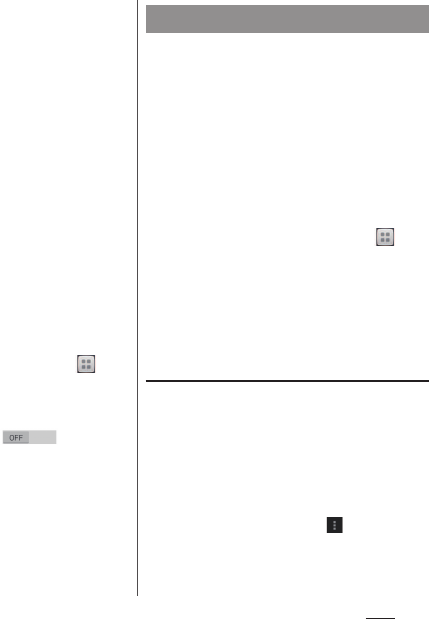
182
Apps
・
Your location information is sent to Google without
specifying who you are. Your location information
may be sent even when the application is not
running.
・
"GPS satellites" and "Google's location service" can be
set individually.
■
Using My location info in Google
application
To identify your location with a Google
application such as Google Maps, you need
to allow the Google application to access
location information.
When you set a Google account, set the
location information settings from Privacy
in the account. For details on Google
account, see "Setting Google account"
(P.222).
・
Turn on the location information service
setting beforehand (P.181).
1
From the Home screen, tap ,
then tap [Settings].
2
Tap [Google]
u
[Location settings].
3
Tap or drag right of Access
to my location.
The Google Maps application allows you to
view your current location, find other
locations and search routes.
❖
Information
・
To use Google Maps, enable data traffic (LTE/3G/
GPRS) or connect to Wi-Fi.
・
Google Maps does not cover the whole world.
・
Only using LTE/3G/Wi-Fi connection may not detect
some locations.
・
Google may provide updated service or function.
1
From the Home screen, tap and
[Maps].
・
When a message appears, follow the
onscreen instructions.
・
A map screen appears.
Finding the current location on the
map
You can detect your current location using
location information service.
❖
Information
・
To detect current location, enable the location
information service (P.181) beforehand, then allow
Google application to access the location
information (P.182). If you do not set a Google
account, on the map screen, tap and
[Settings]
u
[Location settings].
Using Google Maps
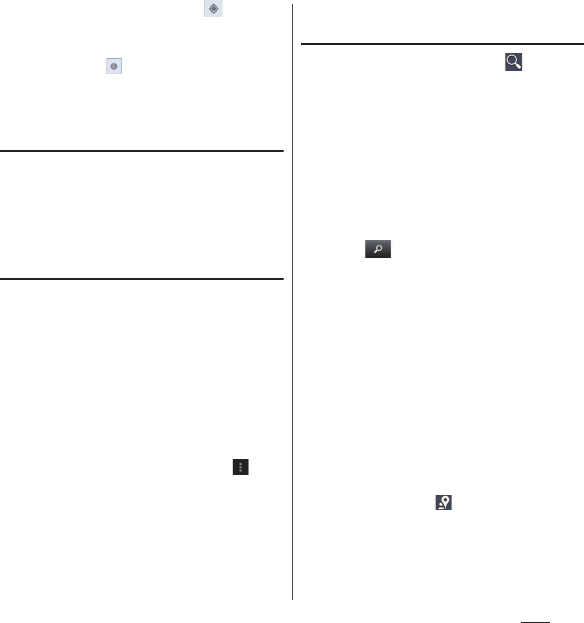
183
Apps
1
On the map screen, tap .
・
The blinking blue mark shows the
current location.
・
If you tap , the terminal's
geomagnetic compass links the
direction displayed on the map.
Zooming in/out on a map
1
Pinch-in/-out on the Maps screen.
❖
Information
・
Alternatively, double-tap the screen to zoom in.
・
Tapping the screen with 2 fingers also zooms out.
Viewing Street View
Street View does not cover some areas. For
uncovered area, Street View icon appears in
light gray.
1
Touch and hold a spot on the map
that you are going to look at in
Street View.
2
Tap the displayed call-out.
3
Tap [Street view]
u
[OK].
・
On the Street View display, tap and
tap [Compass mode]. The compass in
Street View shows the same direction
as the terminal's geomagnetic
compass.
Searching for a location you want to
look at
1
On the map screen, tap .
2
Fill out the search bar.
・
You can enter addresses, city names,
business types and institution names
(for example, London and art museum).
・
When a list of places matched to the
entered letters appears on the screen,
tap a place in the list to check the
location on the map.
3
Tap on the software keyboard.
・
Search result appears on the map.
・
When "Did you mean:" appears at the
top of the map or "RESULT LIST"
appears at the bottom of the map, tap
to select the place to view.
4
Tap a destination.
・
A detailed information screen appears.
❖
Information
・
On the detailed information screen, you can check
the route or phone number for the searched
location. The items displayed vary depending on the
location.
・
On the map screen, tap to select a category such
as "Restaurants", "Cafes" and show it on the map.
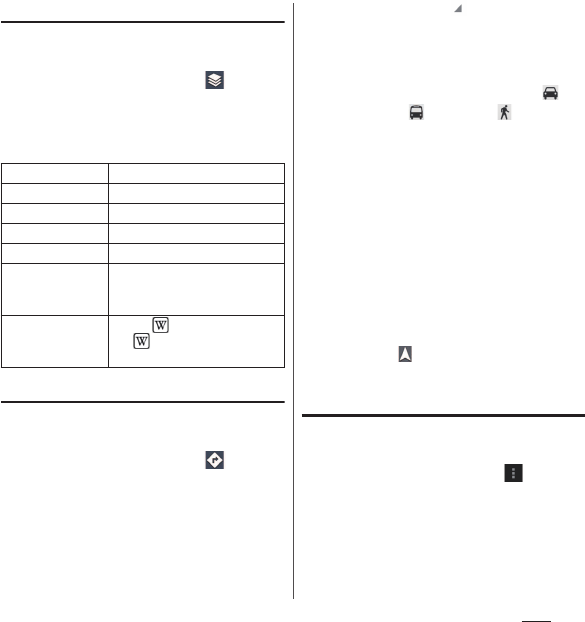
184
Apps
Changing the layers
You can select information to overlay on the
map.
1
On the map screen, tap .
2
Tap information to display.
・
Traffic information and routes are not
available in all locations.
Getting direction
You can receive detailed guides for your
destination.
1
On the map screen, tap .
2
Enter a start point in the upper
entry field, and an end point in the
lower entry field.
・
Alternatively, tap at the right of the
input field to select a Start point and
End point from "My current location"/
"Contacts"/"Point on map"/"My Places".
3
Select a transportation from
(Driving)/ (Transit)/
(Walking).
・
When you select transit, you can select
preferred transit or conditions.
4
Tap [GET DIRECTIONS].
■
Going by car/on foot
Direction is shown on a map.
■
Going by public transport
Trip list appears. Select a route to check
details.
❖
Information
・
After Step 4, tap to use easy route search with My
Location as Start point.
Clearing the Maps
Clear displayed layers, route search results
and some others.
1
On the map screen, tap and tap
[Clear Map].
Traffic
Show traffic condition.
Satellite
Display satellite photo.
Terrain
Display geological formation.
Transit Lines
Show route information.
Latitude
Join Latitude.
My Maps
View My Maps that you create on
a PC. Only viewing : You cannot
create My Maps on the terminal.
Wikipedia
Display .
Tap to display a Wikipedia
article related to the location.
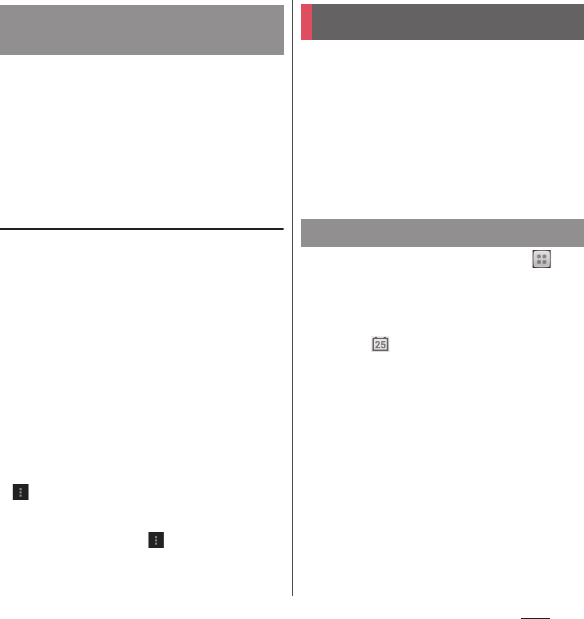
185
Apps
Google Latitude enables you to share
location information with your friends on the
map.
You need to set up a Google account (P.222)
and join Latitude and invite a friend who
gives his or her location information, or to
receive an invitation from him or her.
Joining Latitude
You need to turn on the location information
service setting beforehand. For details, see
"Activating GPS/Location services" (P.181).
1
On the map screen, tap [Maps]
u
[Latitude].
・
If you do not set Google account, tap
[Join Latitude] to display the Google
account setting screen. Follow the
onscreen instructions.
2
Tap [MAP VIEW].
❖
Information
・
To set Latitude, cancel sharing location data, etc., tap
on the map screen, then tap
[Settings]
u
[Location settings] to display a screen for
the operation.
・
For details of Latitude, tap on the map screen,
then tap [Help]
u
[How to]
u
[Additional Maps
features]
u
[Latitude] to view the help.
The terminal has a built-in calendar for the
schedule. If you have a Google account etc.,
you can synchronize the terminal's calendar
and web calendar. For details, see "Setting an
account" (P.222).
・
When a Google account is set, tap [Sync
Calendar] in the Sync items of Google
account (P.223).
1
From the Home screen, tap ,
then tap [Calendar].
・
A calendar screen appears.
2
Tap any of [Month]/[Week]/[Day].
・
Tap to move the cursor to date and
time set on the terminal. Number
displayed on the icon shows the
current date.
・
Flick the calendar left or right to display
the next or previous month/week/day
according to the view mode.
・
Pinch out/in on the weekly or daily
schedule screen to zoom in/out
calendar.
Checking where a friend is by
Google Latitude
Calendar
Displaying calendar
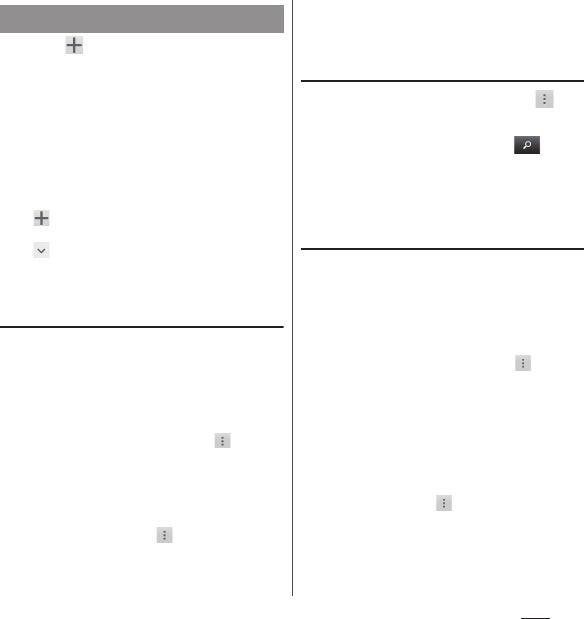
186
Apps
1
Tap on the calendar screen.
2
Enter a name, date and time,
location, and description for
event.
3
Tap [Done].
❖
Information
・
When you set a Google account, you can select an
account to create schedule to in Step 2.
・
Tap beside "Add reminder" to add a new
notification.
・
Tap in "More" and flick up the screen to set
"Repetition", "Attendees", "Time zone", "Show me as:",
and "Privacy".
Displaying events in Calendar
1
On the calendar screen, display
date or time when event is
scheduled.
・
On the month display screen, tap a date
in which event is scheduled.
・
On the calendar screen, tap and
[Agenda] to display a list of events.
2
Tap an event to view description.
❖
Information
・
On the calendar screen, tap and [My calendars]
to synchronize with the docomo account. You can
view the events created in "Schedule" app in the
Calendar.
・
If you log in to Facebook, tap [Sync Calendar] in
"Xperia
™
with Facebook" (P.224) to display events in
Facebook in the Calendar.
Searching events in Calendar
1
On the calendar screen, tap ,
then tap [Search].
2
Enter a keyword and tap on
the software keyboard.
・
Search results appear. Tap an event to
view details.
Deleting events from Calendar
1
On the calendar screen, display
date or time when event is
scheduled.
・
On the month display screen, tap a date
in which event is scheduled.
・
On the calendar screen, tap and
[Agenda] to display a list of events.
2
Touch and hold an event you want
to delete.
3
Tap [Delete event]
u
[Delete].
❖
Information
・
To delete all events, tap on the Calendar screen,
then tap [Settings]
u
[Delete all events]
u
[Delete].
Creating a schedule in Calendar
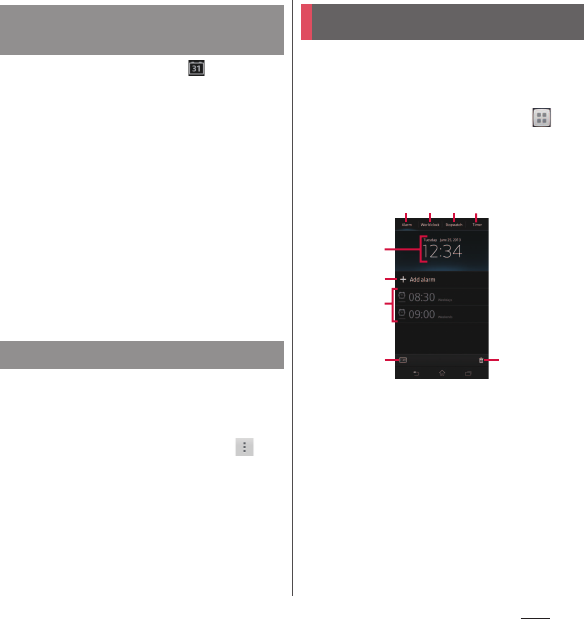
187
Apps
When scheduled time arrives, appears on
the status bar.
1
Drag the status bar downwards.
2
Tap [Snooze]/[Dismiss].
・
Tap [Snooze] to show pop-up menu
and select snooze interval. After set
time elapses, notification appears again.
❖
Information
・
Snooze means a function with which reminder once
dismissed reactivates after a while.
・
For an event set attendee by selecting Google
account, tap [Respond] displayed on the Notification
panel to create and send a mail to the participant.
Set Calendar view, way to notify, Default
reminder time, phrases for quick responses,
etc.
1
On the calendar screen, tap ,
then tap [Settings].
2
Select an item to change.
With "Alarm & clock" app, you can set an
alarm and use world clock, stopwatch and
timer.
1
From the Home screen, tap ,
then [Alarm & clock].
・
Alarm screen appears.
■
Alarm screen
a
Clock display
・
Tap to view date and time (P.225) setting screen.
b
Add alarm (P.188)
c
Alarm list
d
Display clock in full screen
e
View alarm screen
f
View world clock (P.189)
g
View stop watch (P.189)
h
View timer (P.190)
i
Deleting alarms (P.188)
Canceling reminder or setting
snooze
Changing calendar settings
Alarm & clock
a
d
b
c
e
i
f g h
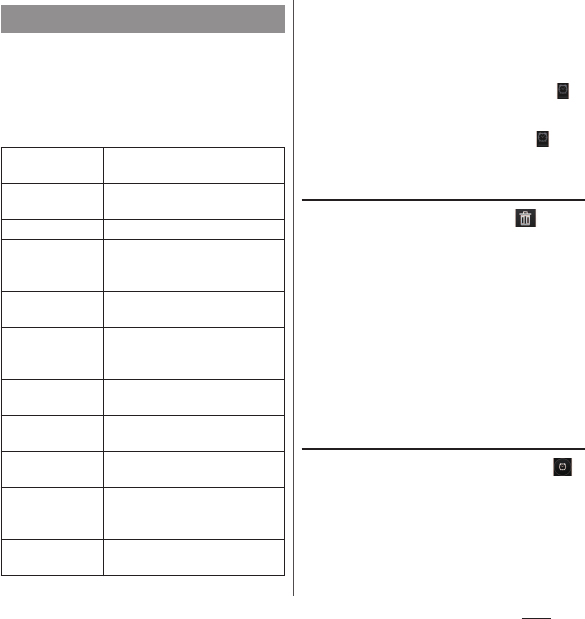
188
Apps
1
On the alarm screen, tap [Add
alarm].
2
Set time etc. and tap [Done].
・
Tap [Advanced alarm settings] to view
all setting items.
* If "Style settings" is marked, this setting is
disabled. To set "Alarm sound", unmark "Style
settings".
❖
Information
・
To switch on/off alarm, on the alarm screen, tap or
touch and hold an alarm
u
Tap [Turn alarm on]/[Turn
alarm off].
・
When an alarm is turned on, the line under lights
blue.
Deleting the alarm
1
On the alarm screen, tap and
mark alarm to delete.
2
Tap [Delete]
u
[Yes].
・
The number of marked alarms appears
on the right of "Delete".
❖
Information
・
Alternatively, on the alarm screen, touch and hold an
alarm you want to delete, then tap [Delete
alarm]
u
[Yes] to delete the alarm.
Stopping an alarm while the alarm is
sounding
1
While alarm is sounding, drag
to the right.
❖
Information
・
If you tap [Snooze], the alarm sounds again when the
time set in "Snooze duration" (P.188) has passed.
Setting alarm
Time
Flick up and down on numbers to
set time.
Repeat
Set a day of the week for the
alarm.
Alarm sound
*
Set alarm sound.
Snooze duration
Set time interval to sound the
ringtone again after stopping the
ringtone.
Alarm text
Enter texts that appear while
alarm is sounding.
Style settings
Mark the checkbox and tap to set
displayed image and sounded
alarm while sounding alarm.
Vibrate
Set whether to vibrate at the
alarm time.
Alarm volume
Drag the slider left or right to
adjust the volume level.
Alarm in silent
mode
Set whether to sound alarm even
in silent mode.
Side keys
behavior
Set behavior when pressing
m
/
k
while alarm is
sounding.
Auto silent time
Set time interval until alarm
automatically stops.
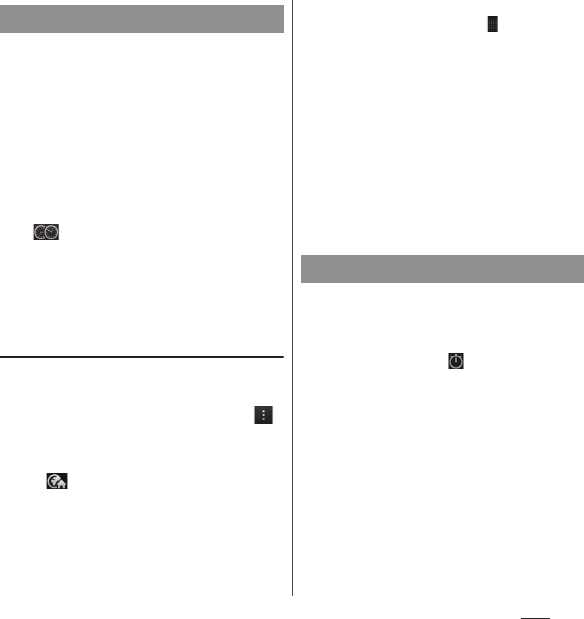
189
Apps
Display the date and time in cities around the
world.
1
On the alarm screen, tap "World
clock" tab.
・
World clock screen appears.
2
Tap [Add city].
3
Select a city.
❖
Information
・
Tap , then flick the city list left or right to check
date and time corresponding to the cities.
・
Time display in cities during day-light saving time
may differ from time difference to standard time
(GMT) displayed on the screen when adding a city in
Step 2.
Changing World clock
You can switch, sort or delete Celsius/
Fahrenheit displayed on World clock.
1
On the world clock screen, tap .
■
Setting home city
Tap [Set home city] and select a city.
・
is displayed on the city set to home
city.
■
Switching Celsius/Fahrenheit
Tap [Celsius]/[Fahrenheit].
■
Sorting
Tap [Rearrange] and drag up and down
beside added cities, then tap [Done].
■
Deleting
Tap [Delete] and mark cities you want to
delete, then tap [Delete]
u
[Yes].
・
The number of the marked cities
appears on the right of "Delete".
・
Alternatively, on the world clock screen,
touch and hold a city you want to
delete, then tap [Delete city]
u
[Yes] to
delete.
1
On the alarm screen, tap
"Stopwatch" tab.
2
Tap [Start].
・
Timer starts, and appears in the
status bar.
・
Tap [Lap] to measure elapsed time.
3
Tap [Stop].
・
Tap [Start] to resume measuring.
・
Tap [Reset] to delete measured time
and lap time.
Using World clock
Using Stopwatch
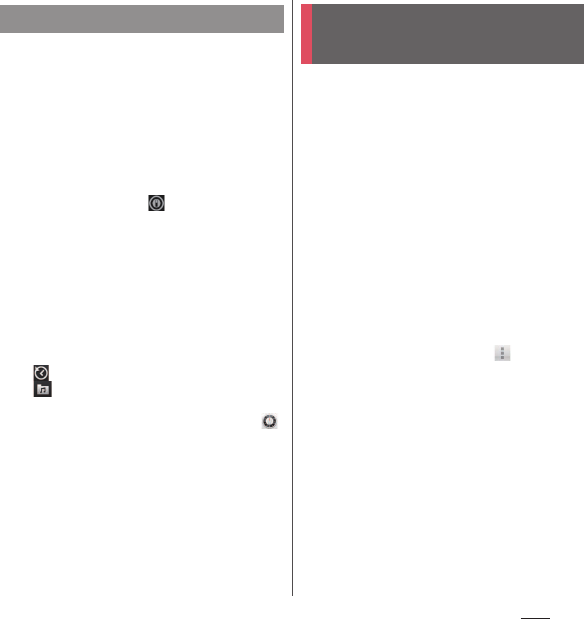
190
Apps
1
On the alarm screen, tap "Timer"
tab.
2
Tap [Set time].
3
Flick up and down on numbers to
adjust the time and then tap
[Done].
4
Tap [Start].
・
Timer starts, and appears in the
status bar.
5
Tap [Stop].
・
Stop sounding alarm after a set time
has elapsed.
・
Tap [Stop] within a set time duration to
pause timer. Tap [Start] to resume timer.
❖
Information
・
Tap to set time from Timer history.
・
Tap and select an alarm sound, then tap [Done]
to change the alarm sound.
・
While using a desired application, tap
r
and
to use the timer of "Small apps" (P.56).
Move or back up data such as phonebook
entries, sp-mode mails, bookmarks, etc. using
external memory such as microSD card.
・
Do not remove the battery or microSD card
during backup or restoring. Doing so may
damage the terminal data.
・
If the batter y is low, backup or restore may not
be done. In that case, charge the terminal and
retry to back up or restore.
・
docomo apps password is required to back
up or restore. For details on docomo apps
password, see "docomo apps password"
(P.214).
❖
Information
・
For details on docomo backup, tap , then tap
[Help] to view the help.
Using Timer
ドコモバックアップ
(docomo
backup)
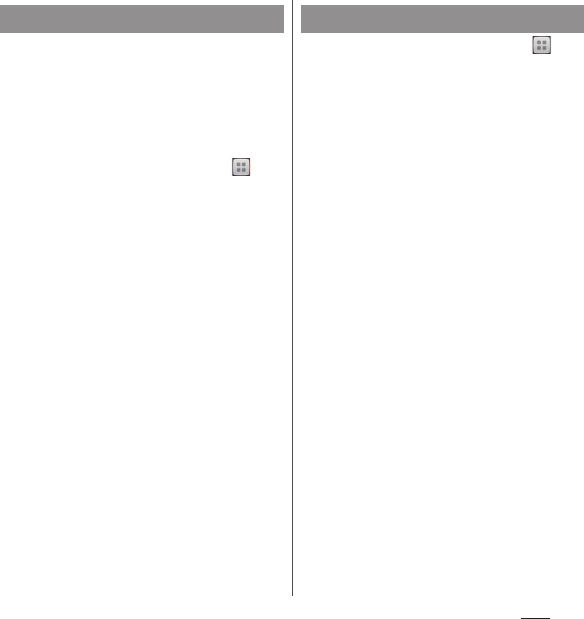
191
Apps
If microSD card is not installed, data such as
images and movies are saved to the internal
storage. You can back up only data such as
images and movies stored in the internal
storage. Data stored in microSD card cannot
be backed up.
1
From the Home screen, tap ,
then tap [
ドコモバックアップ
(docomo backup)].
2
Tap [microSD
カードへ保存
(save to
microSD card)].
・
When you use for the first time, agree to
"License agreement".
3
Tap [Backup].
4
Mark the data to back up.
・
Tap [Select all] to mark all data. Tap
[Deselect] to unmark all marked data.
5
Tap [Start backup]
u
[OK].
6
Enter docomo apps password and
tap [OK].
・
Data is backed up in a microSD card.
1
From the Home screen, tap ,
then tap [
ドコモバックアップ
(docomo backup)].
2
Tap [microSD
カードへ保存
(save to
microSD card)].
・
When you use for the first time, agree to
"License agreement".
3
Tap [Restore].
4
Tap [Select] on data type to restore
and mark data to restore, and tap
[Select].
・
Tap [Select latest data] to select the
latest data for each data type.
5
Tap [Add]/[Overwrite] to select
restore method and tap [Start
restore]
u
[OK].
6
Enter docomo apps password and
tap [OK].
・
Backed up data is restored.
Backing up Restoring
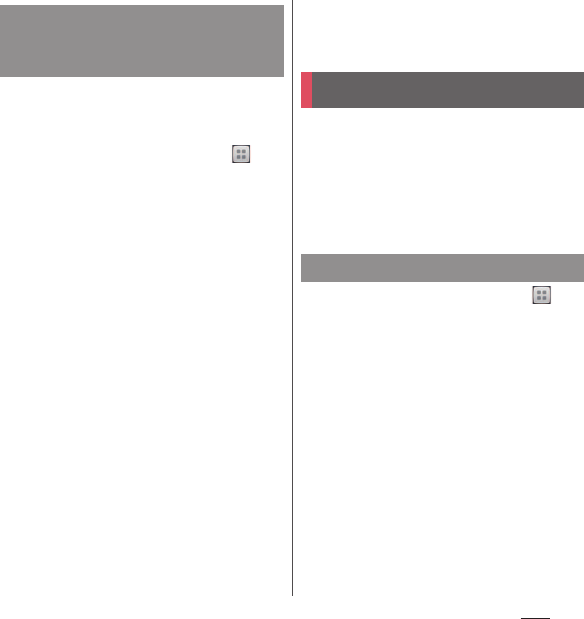
192
Apps
You can copy contacts data registered in
Google account and in the terminal to
docomo account.
1
From the Home screen, tap ,
then tap [
ドコモバックアップ
(docomo backup)].
2
Tap [microSD
カードへ保存
(save to
microSD card)].
・
When you use for the first time, agree to
"License agreement".
3
Tap [Phonebook account copy],
tap [Select] on Google account
contacts you want to copy.
4
Tap [Overwrite]/[Add].
・
Phonebook data is copied to docomo
account.
❖
Information
・
If phonebook item names (e.g. Phone number, etc.)
of the other terminal are different from ones of your
terminal, the item names may be changed or
deleted. Also, some text may be deleted in copied
destination, because savable characters in a
phonebook entry vary by terminal.
・
When backing up phonebook entries to microSD
card, data without Name cannot be copied.
・
If microSD card is low on memory, backup may not
be done. In that case, delete unnecessary files to
make available space.
With OfficeSuite, you can view files of Word,
Excel, etc. from the terminal or a microSD
card.
❖
Information
・
Some files may not be viewed properly due to
corrupted layouts.
1
From the Home screen, tap ,
then tap [OfficeSuite].
・
When a registration screen appears,
follow the onscreen instructions.
・
OfficeSuite starts.
Copying phonebook entries
registered in Google account to
docomo account
OfficeSuite
Starting OfficeSuite
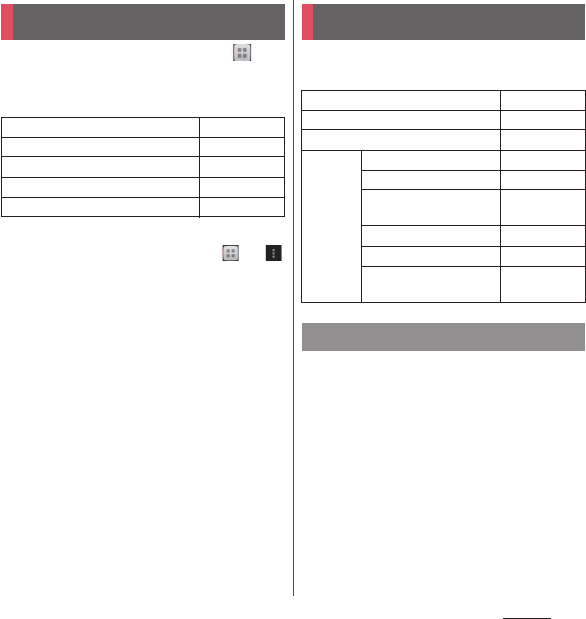
193
Settings
Settings
1
From the Home screen, tap ,
then tap [Settings].
■
Setting menu
❖
Information
・
Alternatively, from the Home screen, tap and
then tap [Settings], or drag the status bar downwards
and tap [Settings] to display the Settings screen.
You can make settings related to networks
such as Wi-Fi, Bluetooth function.
Using the Wi-Fi function, you can connect to
an access point for your home, company
network or public wireless LAN services to
use mail and Internet.
・
Even when Wi-Fi is on, packet communication
is available. However, while you connect Wi-Fi
network, Wi-Fi comes first.
・
When a Wi-Fi network is disconnected,
connection is automatically switched to a
LTE/WCDMA/GSM network mode. Note that
packet communication charge may be
applied if network connection stays switched.
Viewing the setting menu
WIRELESS & NETWORKS
P. 1 9 3
DEVICE
P. 2 0 5
PERSONAL
P. 2 1 4
ACCOUNTS
P. 2 2 2
SYSTEM
P. 2 2 5
Wireless & networks
Wi-Fi
P. 1 9 3
Bluetooth
P.198, P.235
Data usage
P. 1 9 8
More... Airplane mode
P. 1 9 9
VPN
P. 2 0 0
Tethering & portable
hotspot
P. 2 0 1
Media server settings
P. 2 4 5
Mobile networks
P.203, P.251
NFC/Osaifu-Keitai
settings
P. 1 3 3
Wi-Fi

194
Settings
・
Turn the Wi-Fi function to off when you do
not use Wi-Fi to cut battery power
consumption.
・
If you start Wi-Fi connection while using Wi-Fi
Direct function (P.197) or during Screen
mirroring (P.213), Wi-Fi Direct function/Screen
mirroring is terminated.
Before using Wi-Fi
To use Wi-Fi function, turn on Wi-Fi and
search available Wi-Fi network, then connect
it.
・
To access the Internet using Wi-Fi function,
connect to Wi-Fi network in advance.
❖
Information
・
Make sure to receive signal strong enough for using
Wi-Fi function. The signal strength of the Wi-Fi
network varies by the location of the terminal.
Moving closer to the Wi-Fi router might improve the
signal reception.
■
Reception interference caused by
Bluetooth devices
Bluetooth devices and wireless LAN
(IEEE802.11b/g/n) devices use the same
frequency band (2.4GHz). If you use
Bluetooth devices near a wireless LAN
device, reception interference may occur or
the communications speed may lower.
Also, you may hear noise or have a
connection problem. Communication may
be interrupted or sound may be lost while
streaming data, etc. In these cases, do the
following:
・
Keep the terminal and Bluetooth device
to be connected wirelessly 10 or more
meters away from a wireless LAN device.
・
Within 10 meters, turn off the Bluetooth
device to be connected.
Turning on Wi-Fi
1
From the Settings screen (P.193),
tap of Wi-Fi or drag it to the
right.
❖
Information
・
It may take a few seconds before the Wi-Fi
connection is on.
・
Alternatively, drag the status bar downwards and tap
[Wi-Fi] to turn on/off Wi-Fi function.
Connecting to a Wi-Fi network
1
From the Settings screen (P.193),
tap [Wi-Fi].
・
Available Wi-Fi networks or secured Wi-
Fi networks are displayed.
2
Select a Wi-Fi network to connect.
・
To connect to a protected Wi-Fi
network, enter the password and tap
[Connect].
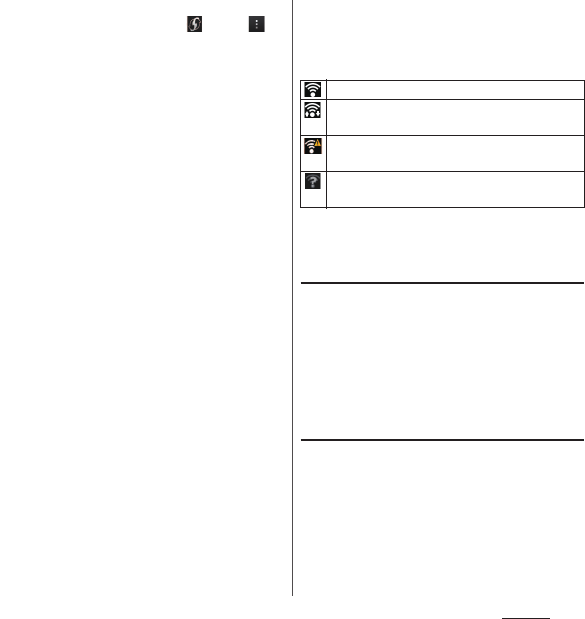
195
Settings
・
To connect Wi-Fi network with WPS
compatible device, tap , or tap ,
then tap [WPS Pin Entry]. Follow the
onscreen instructions.
❖
Information
・
The next time you connect to a Wi-Fi network, the
password is saved in the terminal.
・
If you enter a wrong password (security key) when
selecting an access point to connect, any of the
following appears.
-Saved, Secured with WEP
- Saved, Secured with WPA/WPA2
- Saved, Secured with 802.1x
- Avoided poor Internet connection
*
- Authentication problem
- Limited connectivity
* It may take 5 minutes or more to display the
message after [Connect] is tapped.
Check a password (security key).
When any of above messages appears even if you
enter a correct password (security key), the correct IP
address may not have been acquired. Check the
signal status and reconnect.
・
To use docomo service via Wi-Fi, setting "Wi-Fi option
password" is required. To set, from the Settings
screen (P.193), tap [docomo service]
u
[Wi-Fi settings
for docomo apps]
u
[Wi-Fi option password].
■
Wi-Fi network status icons on status
bar
The following icons appear according to the
Wi-Fi network connection status.
* Without connected to Wi-Fi network, you need to set
Wi-Fi Network notification to on beforehand (P.196).
Disconnecting a Wi-Fi network
1
From the Settings screen (P.193),
tap [Wi-Fi].
2
Tap the Wi-Fi network that is
currently connected.
3
Tap [Forget].
Wi-Fi network status
When you are connected to a Wi-Fi network
or when there are Wi-Fi networks available in
your vicinity, you can see the status of these
Wi-Fi networks. You can also set the terminal
to notify you when an unsecured Wi-Fi
network is detected.
Appears when connected to Wi-Fi network.
Appears when communicating via Wi-Fi
network.
Appears when connected to Wi-Fi network using
Auto IP function.
Appears when any open network within the
service area is detected.
*
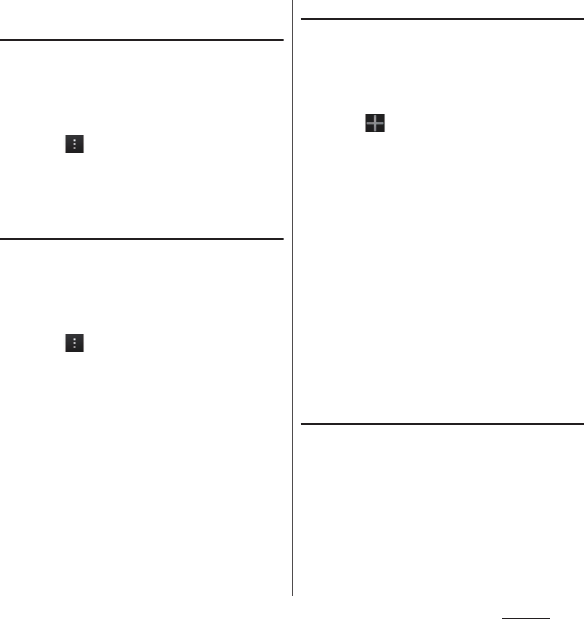
196
Settings
Setting the Wi-Fi open network
notification to ON
・
You need to turn on the Wi-Fi setting
beforehand (P.194).
1
From the Settings screen (P.193),
tap [Wi-Fi].
2
Tap and [Advanced].
3
Mark "Network notification".
Scanning for Wi-Fi networks
manually
・
You need to turn on the Wi-Fi setting
beforehand (P.194).
1
From the Settings screen (P.193),
tap [Wi-Fi].
2
Tap and [Scan].
・
Scanning Wi-Fi networks starts.
3
Tap a Wi-Fi network in the list to
connect.
Adding a Wi-Fi network manually
・
You need to turn on the Wi-Fi setting
beforehand (P.194).
1
From the Settings screen (P.193),
tap [Wi-Fi].
2
Tap and enter a network SSID
of the Wi-Fi network you want to
add.
3
Tap "Security" setting item and tap
a security type of the Wi-Fi
network you want to add.
・
4 options, "None", "WEP", "WPA/WPA2
PSK", or "802.1x EAP", appear.
4
If required, enter security
information for the Wi-Fi network
you want to add.
5
Tap [Save].
Viewing detailed information on a
connected Wi-Fi network
1
From the Settings screen (P.193),
tap [Wi-Fi].
2
Tap the Wi-Fi network that is
currently connected.
・
The detailed network information is
displayed.
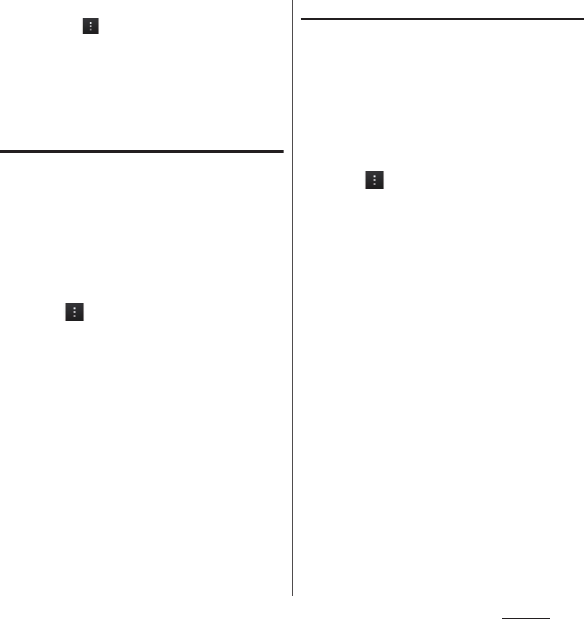
197
Settings
❖
Information
・
In Step 1, tap , then tap [Advanced] to enable/
disable Auto IP support or check "MAC address" and
"IP address".
Mark "Avoid poor connections" to use LTE/WCDMA/
GSM network mode when Wi-Fi radio waves are
weak.
Changing Wi-Fi sleep policy
You can choose to disable the Wi-Fi function
in the terminal when the screen backlight
turns off. You can also set the terminal to
always turn on the Wi-Fi function or to always
turn it on when the terminal is charged.
1
From the Settings screen (P.193),
tap [Wi-Fi].
2
Tap and [Advanced].
3
Tap [Keep Wi-Fi on during sleep].
4
Tap any of [Always]/[Only when
plugged in]/[Never (increases data
usage)].
❖
Information
・
When a Wi-Fi network is disconnected, connection is
automatically switched to a LTE/WCDMA/GSM
network mode.
Using Wi-Fi Direct compatible device
You can connect among the devices
compatible with Wi-Fi Direct via Wi-Fi even
without configuring access point.
・
You need to turn on the Wi-Fi setting
beforehand (P.194).
1
From the Settings screen (P.193),
tap [Wi-Fi].
2
Tap and [ Wi-Fi Direct].
・
A list of detected Wi-Fi Direct devices
appears.
3
Select a Wi-Fi Direct compatible
device name to connect.
・
If a note appears, tap [OK].
・
Tap [Search for devices] to refresh the
detection list.
・
To change the terminal name displayed
on the detected Wi-Fi Direct
compatible device, tap [Rename
device].
❖
Information
・
To use the Wi-Fi Direct function, you need an
application compatible with Wi-Fi Direct function.
The function becomes available when you install a
compatible application.
・
If you start Wi-Fi Direct connection during Wi-Fi
connection, Wi-Fi connection is disconnected and
switched to packet communication (LTE/WCDMA/
GSM).
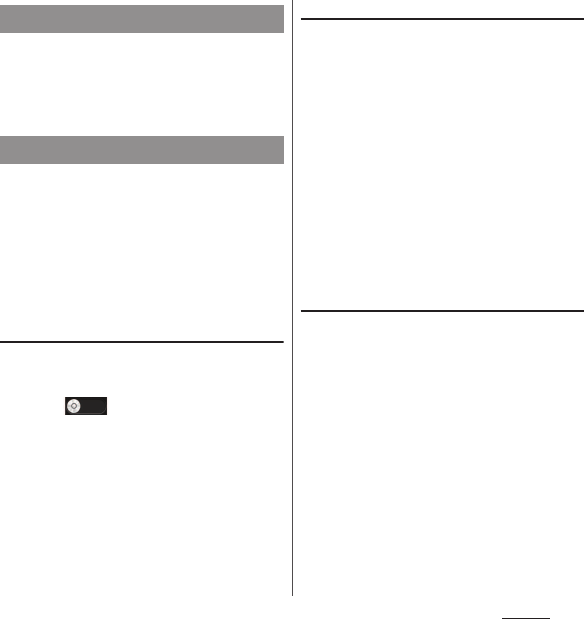
198
Settings
Connect Bluetooth device wirelessly using
Bluetooth function. For details on Bluetooth
communication, see "Using Bluetooth
function" (P.235).
Enable/Disable mobile data communication
or set data usage limit.
❖
Information
・
You can check communication volume for each
application. For some applications, the settings can
be displayed.
Enabling mobile data
communication
1
From the Settings screen (P.193),
tap [Data usage].
2
Tap of Mobile data
communication or drag it to the
right.
3
Read the note and tap [Yes].
❖
Information
・
Alternatively, drag the status bar downwards and tap
[Mobile data] to turn on/off mobile data
communication.
Setting data usage limit
1
From the Settings screen (P.193),
tap [Data usage].
2
Tap [Set mobile data limit] and
read the notes, and then tap [OK].
・
"Set mobile data limit" is marked.
❖
Information
・
Note that mobile data communication will be
disabled when data usage volume reaches to the
limit.
・
Change the setting value for data usage limit and the
value for alert by dragging the right end of each bar
in the graph. Alternatively, tap each bar, drag value
and tap [Set] to change it.
Setting Data usage cycle
1
From the Settings screen (P.193),
tap [Data usage].
2
Tap "Data usage cycle" setting
item and tap the set period/
[Change cycle...].
・
When you tap [Change cycle...], select
reset date and tap [Set].
Bluetooth
Data usage
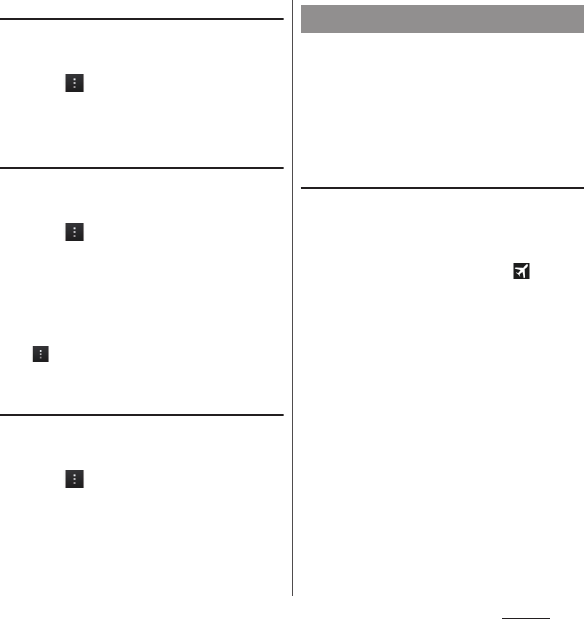
199
Settings
Permitting data roaming
1
From the Settings screen (P.193),
tap [Data usage].
2
Tap and [Data roaming], then
read the notes and then tap [OK].
・
"Data roaming" is marked.
Restricting background data
1
From the Settings screen (P.193),
tap [Data usage].
2
Tap and [Restrict background
data], then read the notes and
then tap [OK].
・
"Restrict background data" is marked.
❖
Information
・
To restrict use of specified Wi-Fi network, in Step 2,
tap and tap [Mobile hotspots], then mark a Wi-Fi
network you want to restrict.
Displaying Wi-Fi usage status
1
From the Settings screen (P.193),
tap [Data usage].
2
Tap and mark "Show Wi-Fi
usage".
・
"Wi-Fi" tab is displayed and tap it to
check Wi-Fi usage condition.
In this mode, the functions of using radio
wave transmissions such as calling, accessing
to the Internet (including sending/receiving
mails), etc. are disabled. It is useful when you
want to operate the terminal with no
interruption of incoming calls or mails.
Turning on Airplane mode
1
From the Settings screen (P.193),
tap [More...].
2
Mark [Airplane mode].
・
When Airplane mode is set, appears
on the status bar.
・
When you unmark "Airplane mode", the
Airplane mode turns off.
❖
Information
・
Alternatively, press and hold
P
for over a second
and then tap [Airplane mode] in the pop-up screen,
or drag the status bar downward and tap [Airplane]
to set Airplane mode to on/off.
・
Even if Airplane mode is on, Wi-Fi, Bluetooth function
and NFC Reader/Writer, P2P function can be turned
on. Be careful not to use Wi-Fi, Bluetooth, NFC
Reader/Writer, P2P functions in a place where the use
is prohibited such as in a airplane or hospital.
Airplane mode
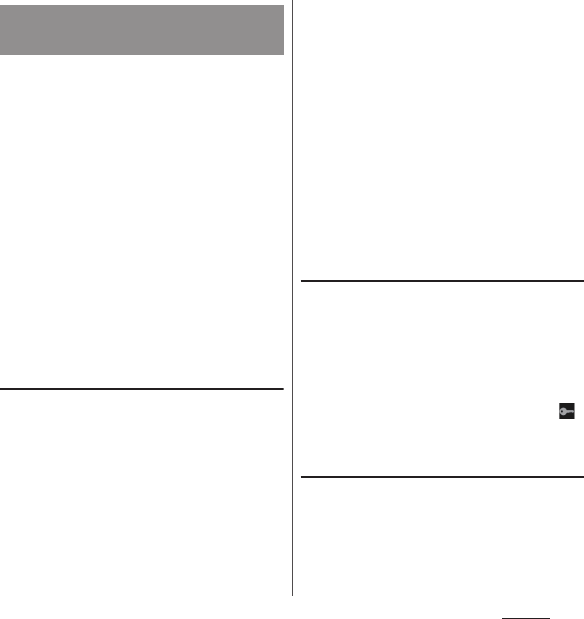
200
Settings
Virtual Private Network (VPN) is a technology
to connect to the information in a protected
local network from another network.
Generally, VPNs are provided to companies,
schools and other facilities. A user can access
to the information in the local network from
outside of the premises.
To set up a VPN access from the terminal, you
need to retrieve the information related to
security from your network administrator. For
details, see the following website.
http://www.sonymobile.co.jp/support/ (In
Japanese only)
❖
Information
・
If you set sp-mode as an ISP, you cannot use PPTP.
Adding a VPN
1
From the Settings screen (P.193),
tap [More...]
u
[VPN].
・
When the note appears, follow the
onscreen instructions to set unlocking
method of screen lock. For details, see
"Setting screen unlock method" (P.218).
2
Tap [Add VPN profile].
3
When an editing screen is
displayed, follow the instruction of
the network administrator to
enter/set required items of VPN
settings.
4
Tap [Save].
❖
Information
・
Added VPNs can be edited/deleted.
To edit VPNs, touch and hold a VPN you want to
change, then tap [Edit profile]. Change the VPN
settings as required and tap [Save]. To delete, touch
and hold a VPN you want to delete, then tap [Delete
profile].
Connecting to a VPN
1
From the Settings screen (P.193),
tap [More...]
u
[VPN].
2
Tap a VPN to connect to.
3
Enter required authentication
information and tap [Connect].
・
When you are connected to a VPN,
appears in the status bar.
Disconnecting a VPN
1
Drag the status bar downwards.
2
Tap a notification that indicates
VPN connected.
3
Tap [Disconnect].
Connecting to a VPN (Virtual
Private Network)

201
Settings
❖
Information
・
Alternatively, from the Settings screen (P.193), tap
[More...]
u
[VPN], tap a indication of a connected
VPN
u
[Disconnect] to disconnect VPN.
Tethering stands for using mobile devices
such as smartphone as modem to allow USB
compatible devices or wireless LAN devices
to access the Internet.
❖
Information
・
Packet communication charge when using tethering
varies depending on the charging plan you use.
Subscription of packet flat-rate service is highly
recommended.
・
For details on usage charge, see the following
website.
http://www.nttdocomo.co.jp/english/
・
When the docomo mini UIM card is not inserted,
mobile data communication is disabled, or out of
service area, USB tethering or Wi-Fi tethering is not
available.
Setting USB tethering
Connecting the terminal to a USB compatible
PC with Micro USB Cable 01 (optional), and
using the terminal as a modem, you can
connect the PC to the Internet.
1
From the Settings screen (P.193),
tap [More...]
u
[Tethering &
portable hotspot].
2
Connect the terminal to a PC using
a microUSB cable (P.35).
・
When you connect microUSB cable for
the first time, the driver software for the
terminal is installed to a PC. Wait for a
while until installation is completed.
・
When "PC Companion software" screen
appears on the terminal, tap [Skip].
3
Tap [USB tethering].
4
Confirm "Details", then tap [OK].
・
"USB tethering" is marked.
❖
Information
・
System requirements (OS) for USB tethering are as
follows.
- Microsoft Windows 8
- Microsoft Windows 7
- Microsoft Windows Vista
- Microsoft Windows XP
*
-Linux
* For Microsoft Windows XP, installation of PC
Companion is required.
・
During USB tethering, the terminal storage cannot
be mounted with a PC.
・
For details such as method of USB tethering for other
OS, see the following website.
http://www.android.com/tether#usb (In Japanese
only)
Using tethering function

202
Settings
Setting Wi-Fi tethering
1
From the Settings screen (P.193),
tap [More...]
u
[Tethering &
portable hotspot].
2
Tap [Portable Wi-Fi hotspot].
3
Confirm "Details", then tap [OK].
・
"Portable Wi-Fi hotspot" is marked.
❖
Information
・
If Wi-Fi tethering starts while connecting to Wi-Fi
network, Wi-Fi network is disconnected and
automatically connected when Wi-Fi tethering ends.
Alternatively, when the terminal and DLNA device
are connected via Wi-Fi network, starting/ending Wi-
Fi tethering affects Wi-Fi connection.
・
USB tethering and Wi-Fi tethering can be used at the
same time.
・
Alternatively, drag the status bar downwards to open
the Notification panel and tap [Hotspot] to set Wi-Fi
tethering function to on/off. When Wi-Fi tethering is
ended on the Notification panel, Wi-Fi connection is
not automatically connected.
・
For details on Wi-Fi tethering, see the following
website.
http://www.android.com/tether#wifi
Setting up a portable Wi-Fi hotspot
You can use the terminal as a Wi-Fi access
point to connect up to 10 wireless LAN
devices to the Internet simultaneously.
1
From the Settings screen (P.193),
tap [More...]
u
[Tethering &
portable hotspot].
2
Tap [Portable Wi-Fi hotspot
settings]
u
[Configure Wi-Fi
hotspot].
3
Enter a network SSID of the Wi-Fi
access point to set.
・
"Xperia
●
_XXXX" is set by default.
4
Tap "Security" setting item and tap
a security type of the Wi-Fi
network to set.
・
"None" and "WPA2 PSK" appear.
5
Enter security information of the
Wi-Fi access point to set as
required.
6
Tap [Save].
❖
Information
・
By default, the password is set at random. You can
change the password as desired.
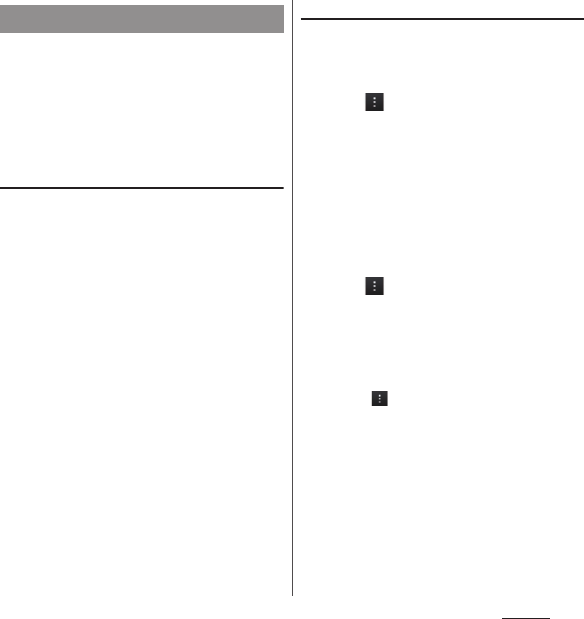
203
Settings
An access point for connecting to the
Internet (sp-mode, mopera U) is already
registered. You can add or change it if
necessary.
By default, sp-mode (P.204) is set for the usual
access point.
Checking the access point in use
1
From the Settings screen (P.193),
tap [More...]
u
[Mobile
networks]
u
[Access Point Names].
・
Available access points (APN) appear.
・
It is recommended that you use the
displayed access point without editing.
❖
Information
・
If you have several available connections, a marked
radio button to the right indicates the active network
connection.
Setting an access point additionally
1
From the Settings screen (P.193),
tap [More...]
u
[Mobile
networks]
u
[Access Point Names].
2
Tap and [New APN].
3
Tap [Name], enter a name and tap
[OK].
4
Tap [APN] and enter the access
point name and tap [OK].
5
Tap and enter all other
information required by your
network operator.
6
Tap and [Save].
❖
Information
・
Do not change the MCC/MNC. If you change MCC/
MNC to other than the default value (440/10), the set
new APN does not appear on the APNs screen. When
the set new APN does not appear on the APNs
screen, tap to make APN settings with "Reset to
default" or "New APN" again.
・
Note that, when using the prediction conversion by
one-byte alphabet entry mode (English mode) with
mark in "Auto space" (P.77) on Japanese keyboard
settings screen, spaces may be entered automatically
when the prediction option is confirmed. In this case,
delete spaces.
Setting an access point
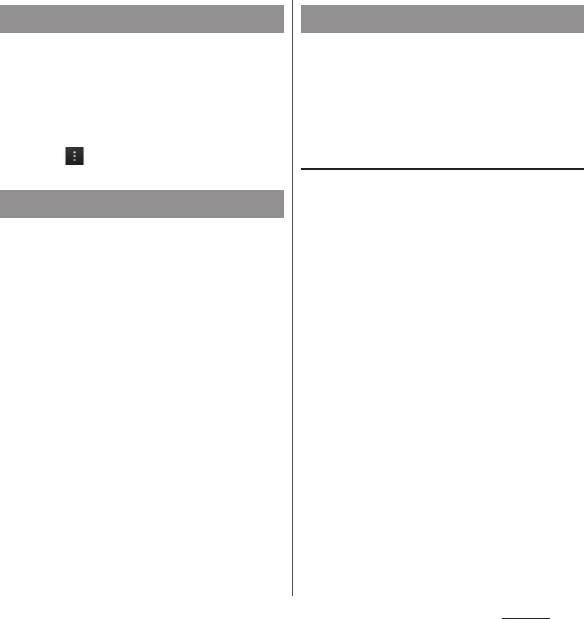
204
Settings
By initializing an access point, the default
state is restored.
1
From the Settings screen (P.193),
tap [More...]
u
[Mobile
networks]
u
[Access Point Names].
2
Tap and tap [Reset to default].
sp-mode is ISP for NTT DOCOMO
smartphone. In addition to accessing
Internet, you can use the mail service using
the same address as imode mail
(@docomo.ne.jp), etc. sp-mode is a service
requiring subscription. For details on sp-
mode, refer to NTT DOCOMO website.
mopera U is ISP of NTT DOCOMO's Internet
connection. If you have subscribed to
mopera U, you can use Internet after making
the simple settings. mopera U is a service
requiring subscription.
Setting mopera U
1
From the Settings screen (P.193),
tap [More...]
u
[Mobile
networks]
u
[Access Point Names].
2
Mark "mopera U" or "mopera U
設定
(mopera U settings)" radio button.
・
Return to the Home screen and open
the Browser. You can enjoy the nice
Internet access.
❖
Information
・
"mopera U
設定
(mopera U settings)" is an access
point for setting mopera U. When you use the access
point for setting mopera U, packet communication
charges for setting do not apply. Note that you can
set only the initial setting screen or the change
setting screen. For details on mopera U settings, refer
to mopera U website.
Initializing an access point
sp-mode
mopera U
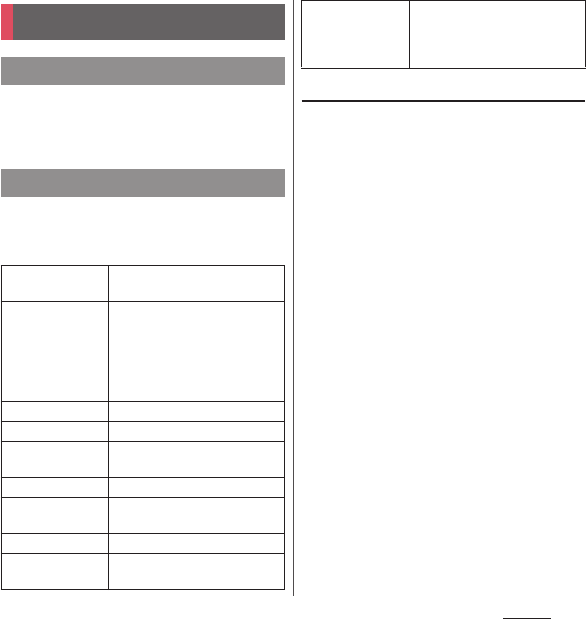
205
Settings
You can use the network services and search
for available networks. For Call settings, see
"Call settings" (P.101).
Set ringtones, operation sound, vibrator, etc.
・
For silent mode, see "Setting silent mode"
(P.41).
Adjusting each sound volume
1
From the Settings screen (P.193),
tap [Sound]
u
[Volumes].
・
Adjust the volume of following items.
- Music, video, games & other media
- Ringtone & notifications
-Alarms
2
Drag the slider to the right or left.
・
Drag the slider to the left for volume
down, or to the right for volume up.
3
Tap [OK].
❖
Information
・
Even if alarm volume is set in Volumes, "Alarm
volume" (P.188) set in "Alarm & clock" app is given
priority.
Device
Call settings
Sound
Clear Phase
™
Set sound quality optimized for
the built-in speaker.
xLOUD
™
Set audio playback level
enhancement technology
("xLOUD") to enjoy powerful
sounds with the built-in speaker
when playing WALKMAN,
YouTube, Album, etc.
Volumes
P. 2 0 5
Phone ringtone
P. 2 0 6
Vibrate when
ringing
P. 2 0 6
Notification sound
P. 2 0 6
Dial pad touch
tones
P. 2 0 6
Touch sounds
P. 2 0 6
Screen lock sound
Set whether to emit sound for
unlocking the screen lock.
Vibrate on touch
Set whether to vibrate the
terminal for some operations
such as specified software key
operation.
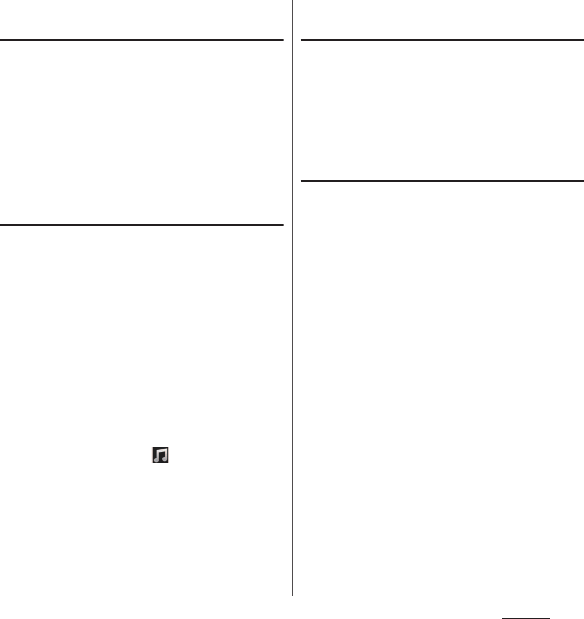
206
Settings
Adjusting the ringtone volume with
the volume key
1
From the Home screen, press up or
down of
m
.
・
The volume adjustment bar appears,
you can adjust the volume up or down.
❖
Information
・
You can also press
m
or
P
to mute the
ringtone for an incoming call.
Setting a ringtone/notification sound
1
From the Settings screen (P.193),
tap [Sound]
u
[Phone ringtone]/
[Notification sound].
2
Select a ringtone or notification
sound and tap [Done].
❖
Information
・
You can set voice file in ".wav"/".m4a" or in other
format which is transferred from Media Go (P.243) or
downloaded from the Internet as a ringtone or
notification sound.
・
To set a ringtone or notification sound other than the
ones stored by default, tap .
・
When volume of "Music, video, games & other
media" is muted (Volume 0), ringtone or notification
sound cannot be heard.
Setting vibration when receiving a
call
1
From the Settings screen (P.193),
tap [Sound] and mark "Vibrate
when ringing".
・
Ringtone sounds and the terminal
vibrates when there is an incoming call.
Setting touch tones to ON
1
From the Settings screen (P.193),
tap [Sound].
2
Mark "Dial pad touch tones"/
"Touch sounds".
・
If you unmark them, any operation
tones do not sound when you tap.
❖
Information
・
"Dial pad touch tones" is a sound for operations on
the dial pad. "Touch sounds" is a sound for selecting
menu.
・
To set the key sound of software keyboard, set from
"Setting character entry" (P.74).
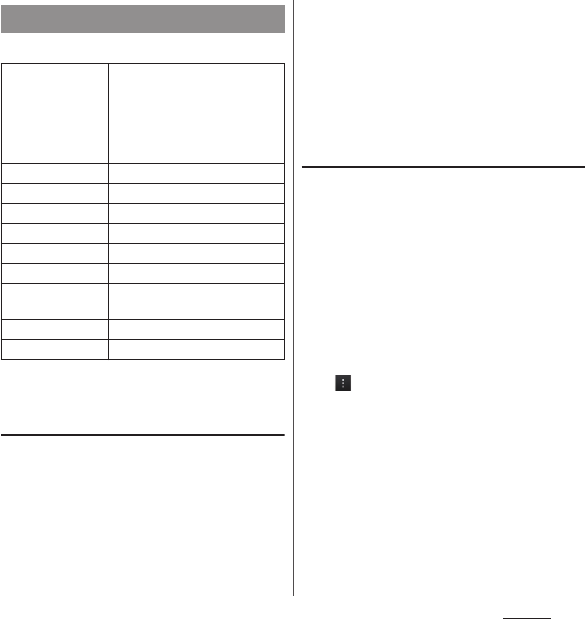
207
Settings
Set brightness, orientation of the screen, etc.
* Image quality improving procedure for still pictures is
effective only for viewing in the album application.
Adjusting the screen brightness
1
From the Settings screen (P.193),
tap [Display]
u
[Brightness].
2
Drag the slider to the right or left.
・
Drag the slider to the left for dimmer
screen, or to the right for brighter
screen.
3
Tap [OK].
❖
Information
・
Mark "Adapt to lighting conditions" to adjust
brightness automatically according to the ambient
brightness with reference to the manually set
brightness.
・
Drag the status bar downwards and tap [Backlight] to
switch the screen brightness to the maximum/dim
(approx. 30 % of the maximum brightness).
Adjusting white balance
1
From the Settings screen (P.193),
tap [Display]
u
[White balance].
2
Drag the slider of "Saturation" or
"Hue" to the right or left.
・
Touch and hold the area displays "Press
and hold here to see previous setting"
to check the previous setting.
3
Tap [Done].
❖
Information
・
Tap in Step 2 and tap [Default values] to initialize
setting.
Display
Mobile BRAVIA
Engine 2
To view photos or movies
colorfully and beautifully, set
image quality improving
procedure (Mobile BRAVIA
Engine 2). It adjusts contrast,
color shade, etc.
*
Brightness
P. 2 0 7
White balance
P. 2 0 7
Wallpaper
P. 8 9
Auto-rotate screen
P. 4 0
Sleep
P. 2 0 8
Font size
Set font size.
Themes
Set an image for the Home
screen, unlock screen, etc.
Quick settings
P. 2 0 8
Lock screen
P. 2 0 8
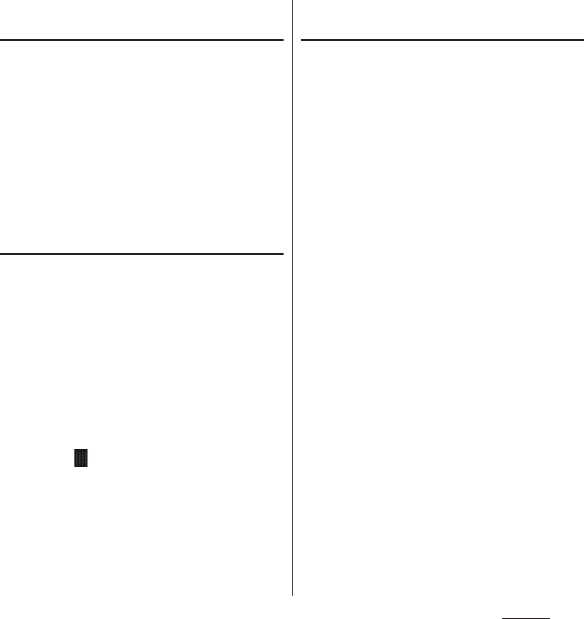
208
Settings
Adjusting the idle time before the
screen turns off
1
From the Settings screen (P.193),
tap [Display]
u
[Sleep].
2
Select a time option before the
screen back light turns off.
❖
Information
・
To turn the screen back light off immediately, press
P
.
Editing quick settings on the
Notification panel
You can edit number of quick settings (P.46)
or sort the order.
1
From the Settings screen (P.193),
tap [Display]
u
[Quick settings].
■
To select quick settings to be displayed
1
Mark tools you want to display.
・
Up to 10 items can be displayed.
■
To change order of quick settings
1
Drag off the quick setting you
want to change the order up or
down.
Changing wallpaper of the unlock
screen
・
Only when "Set all to" or "Lock screen" in
Preferred apps settings (P.214) to "Xperia
™
",
and set the screen unlock method (P.218) to
"Swipe/Touch", you can change the wallpaper.
1
From the Settings screen (P.193),
tap [Display]
u
[Lock screen].
2
Tap [Wallpaper]
u
[Album]/
[Xperia
™
wallpapers].
・
For details on setting procedure, see
Step 2 in "Changing wallpaper" (P.89).
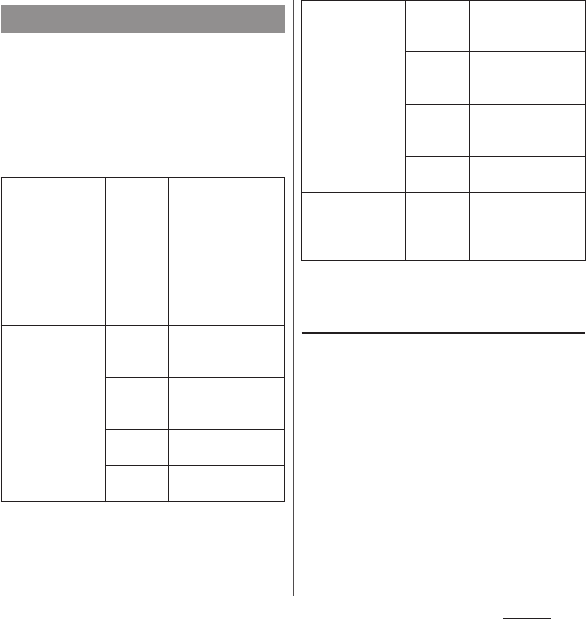
209
Settings
Check memory volume of internal storage,
microSD card, and USB storage. And you can
delete data in the microSD card and USB
storage and format. USB storage is an
external memory such as a microSD card
connected to the terminal using
commercially available reader/writer cable.
* Displayed items vary depending on condition of
microSD card or USB storage recognition.
Formatting microSD card
1
From the Settings screen (P.193),
tap [Storage].
2
Tap [Erase SD card]
u
[Erase SD
card].
・
Enter your screen unlock method as
required.
3
Tap [Erase everything].
❖
Information
・
Formatting microSD card deletes all the data in it.
Storage
INTERNAL
STORAGE
Total
space
Check memory
space for Apps,
Pictures, videos,
Audio (music,
ringtones, etc.),
Downloads, Misc.
and available space
in the internal
storage.
SD CARD Total
space
Check available
memory space etc.
of microSD card.
Unmount
SD card
*
Cancel connection of
microSD card to
remove it safely.
Mount SD
card
*
Have microSD card
recognized.
Erase SD
card
*
P. 2 0 9
EXTERNAL USB
STORAGE
Total
space
Check available
memory space of
USB storage.
Unmount
USB
storage
*
Cancel connection of
USB storage to
remove it safely.
Mount
USB
storage
*
Have USB storage
recognized.
Clear USB
storage
*
P. 2 1 0
MISCELLANEOUS Transfer
data to SD
card
Transfer images,
videos, music data in
the internal storage
to the microSD card.
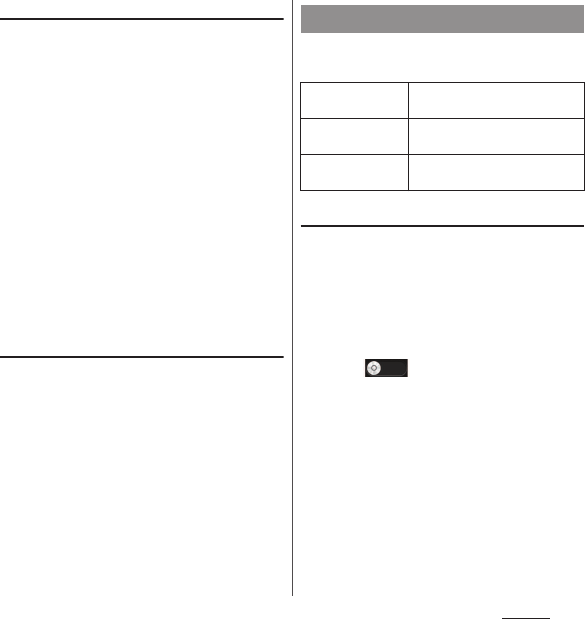
210
Settings
Formatting USB storage
・
Insert external memory such as a microSD
card into commercially available reader/writer
cable and connect the cable to the terminal in
advance.
1
From the Settings screen (P.193),
tap [Storage].
2
Tap [Clear USB storage]
u
[Erase].
・
Enter your screen unlock method as
required.
3
Tap [Erase everything].
❖
Information
・
Formatting USB storage (external memory such as
microSD card) deletes all the data in it.
Increasing the available memory of
the terminal
If the terminal has a small memory, you can
perform the following operations to increase
available memory.
・
In the browser, you can clear all temporary
Internet files and browser history information.
For details, see "Clearing history" (P.130).
・
Uninstall programs that you no longer use. For
details, see "Deleting installed application"
(P.212).
You can check battery consumption and set
Power Saver or Location-based Wi-Fi.
Using Location-based Wi-Fi
When entering to the registered Wi-Fi
network area, the terminal connects the Wi-Fi
network automatically to reduce the battery
power consumption.
1
From the Settings screen (P.193),
tap [Power management].
2
Tap of Location-based Wi-Fi
or drag it to the right.
・
When Wi-Fi network is not registered,
tap [Location-based Wi-Fi]
u
[Set up Wi-
Fi] to connect to Wi-Fi (P.194).
Power management
Power Saver
Set Power Saver to reduce
battery power consumption.
Location-based
Wi-Fi
P. 2 1 0
Battery
Display battery consumption,
remaining battery level, etc.

211
Settings
Manage and delete installed applications,
display memory usage condition, etc. or
change the settings.
Viewing permitted operation of the
applications in the terminal
You can check functions which are permitted
to access to each application in the progress
of performing, such as network
communication function or location
information function of the terminal.
1
From the Settings screen (P.193),
tap [Apps].
2
Tap an application to view.
3
Flick the screen up to view
permitted operations.
・
If all permitted operations do not
appear, tap [Show all].
Force-quitting an application
If a pop-up window appears to indicate the
application does not reply, you can force-quit
the application.
1
From the Settings screen (P.193),
tap [Apps].
2
Tap an application to force-quit.
3
Tap [Force stop].
4
Read the notes and then tap [OK].
❖
Information
・
When you do not want to force-quite the
application, tap [Cancel] and wait for a reply of the
application.
Deleting all data of the application
・
Before deleting all installed application data,
back up contents related to the application
that you want to save including data saved in
the application.
1
From the Settings screen (P.193),
tap [Apps].
2
Tap an application to delete the
data.
3
Tap [Clear data].
4
Read the notes and then tap [OK].
Apps

212
Settings
Deleting installed application
・
Before deleting installed application, back up
contents related to the application that you
want to save including data saved in the
application.
・
Some applications cannot be deleted.
1
From the Settings screen (P.193),
tap [Apps].
2
Tap an application to be deleted.
3
Tap [Uninstall].
4
Tap [OK].
5
When uninstallation is completed,
tap [OK].
❖
Information
・
Some applications pre-installed in the terminal
cannot be uninstalled. For some applications which
cannot be uninstalled, disabling is possible (P.212).
・
Applications downloaded from Play Store are
recommended to be deleted from the Google Play
screen (P.133).
・
Applications can be deleted from the Application
screen. For details, see "Uninstalling an application"
(P.91).
Disabling application
You can disable some applications which
cannot be uninstalled or services. Disabled
applications are not displayed on the
Application screen and you cannot execute
them, but they are not uninstalled.
1
From the Settings screen (P.193),
tap [Apps].
2
Flick the screen to the left to
display "All" tab.
3
Tap an application to be disabled.
4
Tap [Disable].
5
Read the notes and then tap [OK].
・
To enable again, tap [Enable].
❖
Information
・
When you disabled an application, some other
applications linked to the disabled application may
not be operated correctly. Enable the disabled
application again to operate them correctly.
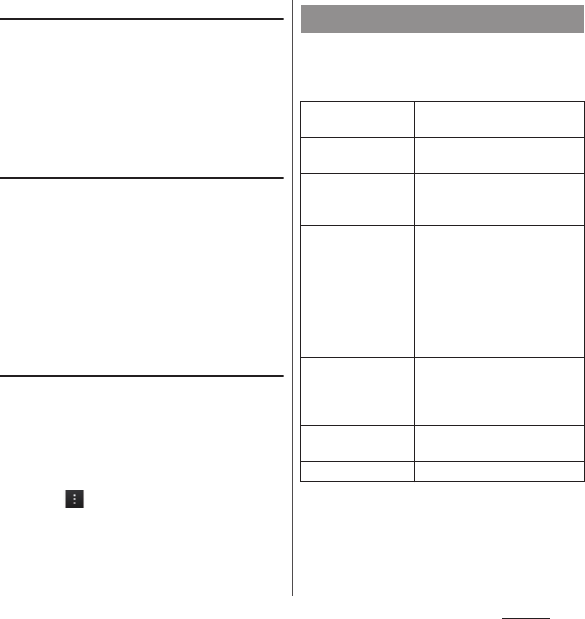
213
Settings
Deleting cache of the application
1
From the Settings screen (P.193),
tap [Apps].
2
Tap an application to delete cache.
3
Tap [Clear cache].
Deleting settings for activating the
application
You can delete settings for activating the
application and restore to the default.
1
From the Settings screen (P.193),
tap [Apps].
2
Tap an application to delete its
settings.
3
Tap [Clear defaults].
Resetting application
You can reset disabling applications (P.212),
settings for activating application (P.213), or
restricting background data.
1
From the Settings screen (P.193),
tap [Apps].
2
Tap and tap [Reset app
preferences].
3
Tap [Reset apps].
Set preferred application in the terminal. You
can also make settings for USB connection or
Wi-Fi connection to a PC or other devices.
Xperia
™
About PlayStation
Certified
Check trademarks of
PlayStation.
Preferred apps
settings
P. 2 1 4
Screen mirroring
*1
Connect to a TV that supports
Screen mirroring
*2
to display
the screen of the terminal.
Smart Connect
Set to activate applications
automatically when you
connect a commercially
available earphone, the AC
adapter for charging, etc. Also,
set how applications operate
when activating or
deactivating.
Start MirrorLink
™
Set to allow a device
compatible with MirrorLink
™
to operate the terminal using
microUSB cable.
Throw settings
Play various contents in the
terminal with other device.
USB Connectivity
P. 2 4 2

214
Settings
*1 Data with copyright protection cannot displayed.
Depending on usage environment, image or sound
may be interrupted or stopped.
Covering around the Wi-Fi antenna with your hand
may affect the quality of communications.
If you start Screen mirroring during Wi-Fi
connection, Wi-Fi connection is disconnected and
switched to packet communication (LTE/WCDMA/
GSM).
*2 Connection is available only with a device that
supports HDCP.
Setting preferred apps
You can set for applications (Home app,
unlock screen, phonebook app, application
for play back videos or music) used in the
terminal all at once or individually.
1
From the Settings screen (P.193),
tap [Xperia
™
].
2
[Preferred apps settings]
u
Tap any
of [Set all to]/[Home screen]/[Lock
screen]/[Contacts]/[Player(music
and video)].
3
Tap [docomo]/[Xperia
™
].
・
"docomo" or "Xperia
™
" is set as a using
application.
❖
Information
・
To set preferred apps all at once, from the Home
screen, tap [Preferred apps settings]
u
[OK].
You can set passwords for applications
provided by docomo or to use the services
supporting AUTO-GPS.
PERSONAL
docomo service
Application
manager
Set to check update for
applications regularly.
Wi-Fi settings for
docomo apps
Set to use docomo service
when connecting Wi-Fi.
docomo apps
password
Set a password for applications
provided by docomo. docomo
apps password is set "0000" by
default.
AUTO-GPS
Set to use the services
supporting AUTO-GPS.
docomo location
information
Set location information
function for imadoco search,
imadocokantan search and
Keitai-Osagashi Service.
docomo Wi-Fi Easy
Connection
Set the terminal for using
docomo Wi-Fi or home Wi-Fi.
データ量確認アプリ
(Check data volume
application)
Set totaling cycle or starting/
stopping measuring for
データ
量確認アプリ
(Check data
volume application).
Open source
licenses
View open source licenses.
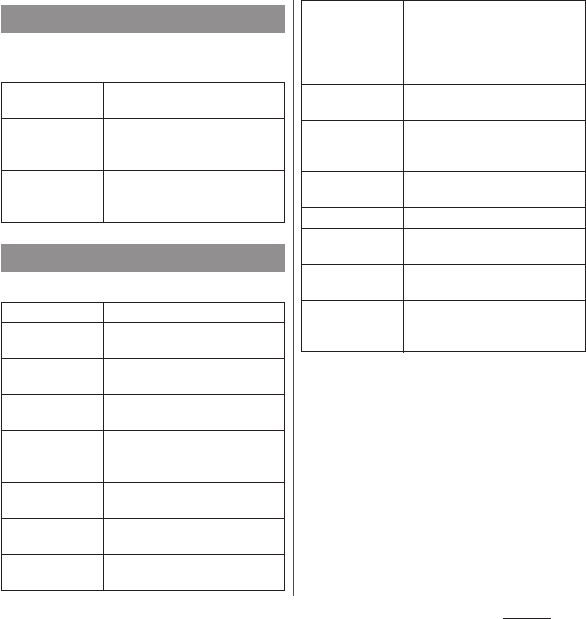
215
Settings
Set whether to permit the location
information service.
Set options related to security.
*1 Displayed items vary depending on "Screen lock"
settings.
*2 Recording is not available if a docomo mini UIM
card is not attached.
*3 Save certificates and credential information in the
credential storage.
❖
Information
・
To decrypt the terminal, reset (P.222) to the default
status.
Location services
Access to my
location
P. 1 8 1
GPS satellites
Set whether to permit
applications to identify your
current location using GPS.
Google's location
service
Set whether to permit Google to
use location information using
result etc. of Google search.
Security
Screen lock
P. 2 1 8
Improve face
matching
*1
Improve face lock accuracy.
Liveness check
*1
Set whether to require blinking for
unlocking by Face Unlock.
Make pattern
visible
*1
Set whether to show pattern
when entering pattern.
Automatically
lock
*1
Set interval time before locking
automatically when turning off
the screen.
Power button
instantly locks
*1
Set whether to enable screen lock
by pressing
P
.
Vibrate on
touch
*1
Set whether to vibrate when
unlocking operation.
Owner info
Set text to be displayed on the
unlock screen.
Encrypt phone
Encrypt the internal storage. If you
encrypt the phone, entering a
security code or password is
required each time you turn on
the power.
Set up SIM card
lock
*2
P. 2 1 7
Make passwords
visible
Set whether to show the input
character before "
・
" appears on
the password entry screen.
Device
administrators
Set whether to enable device
administrator.
Unknown sources
P. 2 2 0
Trusted
credentials
Display trusted CA credentials.
Install from
internal storage
Install encrypted certificates from
internal storage.
Clear credentials
Clear all certificates or credential
information from the credential
storage
*3
.

216
Settings
Protecting docomo mini UIM card
Some functions provided for convenient use
of the terminal require the security code to
use them. Besides the security code for
locking the terminal, the network security
code necessary for the network services etc.
are available. Make use of the terminal using
an appropriate security code according to
the purpose.
■
Notes on the security codes
・
Avoid using a number that is easy to
guess, such as "birth date", "part of your
phone number", "street address number
or room number", "1111", and "1234".
Make sure to make a note of the security
code you set lest you should forget it.
・
Be very careful not to let others know your
security code. If your security code is
known by anyone else, DOCOMO shall
have no liability for any loss due to any
unauthorized use of it.
・
If you forget your security codes, you must
bring your official identification (such as
drivers license), the terminal, and docomo
mini UIM card with you to the nearest
docomo Shop. For details, contact the
"General Inquiries" on the last page.
・
The PUK code is written on the
subscription form (copy for customer)
handed at the subscription in the
docomo Shop. If you subscribed other
than docomo Shop, you must bring your
official identification (such as drivers
license), the docomo mini UIM card with
you to the nearest docomo Shop or
contact the "General Inquiries" on the last
page.
Network security code
The network security code is a 4-digit
number necessary for identification or using
the docomo Network Services at reception of
your request in docomo Shop or at docomo
Information Center. It can be set any number
at the subscription and also changed later by
yourself.
You can change your network security code
to new one using a PC if you have "docomo
ID"/"Password" for "My docomo", the General
support site for PC.
Alternatively, from the Home screen, tap
[dmenu] and [
お客様サポート
(Customer
support)]
u
[
各種お申込・お手続き
(Various
applications/procedures)] to change the
security code yourself.
* For information on "My docomo" and "
お客様
サポート
(Customer support)", see the
previous page of the last page.

217
Settings
PIN code
You can set security code which named PIN
code to docomo mini UIM card. It is set
"0000" at the subscription. They can be
changed by yourself.
PIN code is a 4- to 8-digit security number
(code) that must be entered for user
confirmation to prevent unauthorized use by
a third party every time you insert the
docomo mini UIM card into the terminal or
when the terminal is powered on. Entering
the PIN code enables making/receiving calls
and terminal operation.
・
If you use a newly purchased terminal with
docomo mini UIM card you have been using,
use the PIN code set on the former terminal. If
you did not change the setting, the code is
"0000".
・
If you enter a wrong PIN code 3 times
consecutively, the PIN code is locked and
cannot be used anymore. In this case, unlock
with "Personal Unblocking Key (PUK code)"
(P.217).
Personal Unblocking Key (PUK code)
The PUK code is an 8-digit number for
canceling the locked PIN code. The PUK code
cannot be changed by yourself.
・
If you failed to enter PUK code 10 times
consecutively, the docomo mini UIM card is
locked. Please contact a docomo Shop.
Enabling SIM card lock
By setting PIN (security code) and entering
PIN code when powered on, you can protect
the docomo mini UIM card from improper
use.
1
From the Settings screen (P.193),
tap [Security]
u
[Set up SIM card
lock]
u
[Lock SIM card].
2
Enter PIN code and tap [OK].
・
"Lock SIM card" is marked.
❖
Information
・
You can unlock SIM card lock by the same operation.
Entering the PIN code when powered
on
1
On the PIN code entry screen,
enter the PIN code.
2
Tap [OK].

218
Settings
Changing the PIN code
・
You can change only when you activate the
SIM card lock.
1
From the Settings screen (P.193),
tap [Security]
u
[Set up SIM card
lock]
u
[Change SIM PIN].
2
Enter the current PIN code and tap
[OK].
3
Enter a new PIN code and tap [OK].
4
Enter a new PIN code again and
tap [OK].
Unlocking PIN lock
1
Tap [PUK code] field and enter PUK
code.
2
Tap the [New PIN Code] field and
enter a new PIN code and tap [OK].
3
Enter a new PIN code again and
tap [OK].
Screen lock
You can secure your data by requiring a
screen unlock pattern every time the
terminal is turned on or every time it is
activated from sleep mode.
There are 5 types of screen lock settings:
"Swipe/Touch", "Face Unlock", "Pattern", "PIN"
and "Password" (P.218).
Setting screen unlock method
1
From the Settings screen (P.193),
tap [Security]
u
[Screen lock].
2
Tap any of [Swipe/Touch]/[Face
Unlock]/[Pattern]/[PIN]/
[Password].
・
When you tap [Face Unlock], follow the
onscreen instructions to set face
authentication. For unlocking when the
Face Unlock cannot be unlocked,
"Pattern" or "PIN" is required to select to
set.
・
When you tap [Pattern], follow the
onscreen instructions to enter unlock
pattern.
Set security question and answer in case
you forget the pattern.

219
Settings
・
When you tap [PIN], follow the
onscreen instructions to enter 4 - 16
digit numbers. This "PIN" code is
different from a PIN code to be set to
docomo mini UIM card (P.217).
・
When you tap [Password], follow the
onscreen instructions to enter 4 - 16
digit characters including alphabets.
Changing screen unlock method
1
From the Settings screen (P.193),
tap [Security]
u
[Screen lock].
2
Enter the current unlock pattern/
PIN/password.
3
Select a new unlock method.
・
For details, see Step 2 in "Setting screen
unlock method" (P.218).
Locking the screen
Once screen unlock method (P.218) is set, the
screen is locked when the sleep mode is set
or
P
is pressed.
Unlocking the screen lock
1
Press
P
to turn the backlight on.
2
Enter unlock screen method.
・
Enter the set unlock method (Flick or
Tap/Face Unlock/Pattern/PIN/
Password).
If you forget how to unlock
■
If you set "Pattern"
"Incorrect pattern" appears when you enter
incorrect unlock pattern 5 times
consecutively.
・
Tap [Next] and "Security question" screen
appears. Answer the security question
that you set for the unlock pattern setting,
and tap [Unlock] to unlock the screen
lock.
・
If you set Google account, on the
"Incorrect pattern" screen, tap [Next] to
display "Unlock screen" screen.
- Mark "Answer question" and tap [Next],
and answer the security question, then
tap [Unlock] to unlock the screen lock.
- Mark "Enter Google account details", tap
[Next], and enter Google account and
password, then tap [Sign in] to unlock
the screen lock.
・
When setting new unlock pattern after
unlocking screen lock, "Screen unlocked"
appears. Tap [Yes] to reset unlock pattern.

220
Settings
❖
Information
・
Tap [Try again] to retry entering pattern in 30
seconds.
・
When you tap [Try again]
u
[Forgot pattern?],
"Security question" screen or "Unlock screen" screen
appears.
・
If you set multiple Google accounts, enter one of
those accounts and password to unlock the screen.
■
If you set "PIN" or "Password"
Please contact a docomo Shop.
Canceling screen lock
You can cancel screen lock pattern after you
set.
1
From the Settings screen (P.193),
tap [Security]
u
[Screen lock].
2
Enter the current unlock pattern/
PIN/password.
3
Tap [None].
Permitting downloading unknown
sources application
・
Before you can download unknown source's
applications, set the terminal to enable
downloading.
Applications you download may be of
unknown origin. To protect your terminal and
personal data, only download applications
from trusted sources such as the Google Play
etc.
1
From the Settings screen (P.193),
tap [Security].
2
Tap [Unknown sources].
3
Read the notes and then tap [OK].
・
"Unknown sources" is marked.
You can select language and input method.
Language & input
Language
P. 2 2 1
Spell checker
Set spell checker.
Personal dictionary
Register words.
Default
Set input method.
Google voice typing
P. 7 4
Moji-Henshu
Xperia
™
Chinese
keyboard
Xperia
™
Japanese
keyboard
Xperia
™
keyboard
Voice Search
P. 2 2 1
Text-to-speech output
P. 2 2 1
Pointer speed
Set pointer speed of
mouse etc.
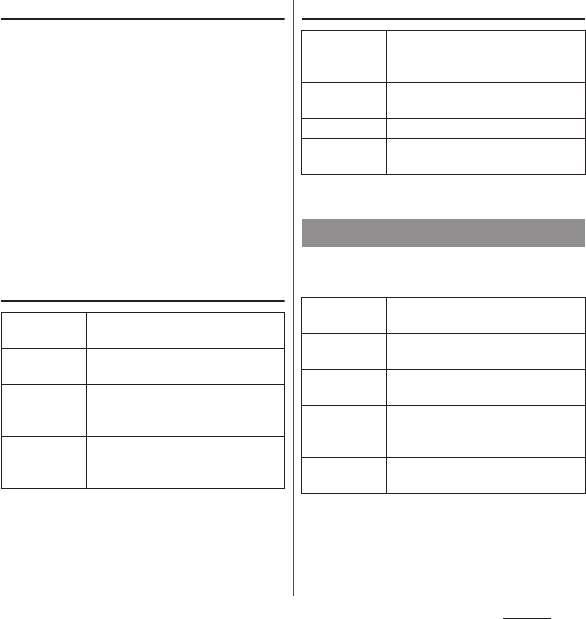
221
Settings
Changing phone language
1
From the Settings screen (P.193),
tap [Language &
input]
u
[Language].
2
Select a language and tap [OK].
・
When you select Japanese, "OK" is
displayed, but its display varies by the
language you selected.
❖
Information
・
If you choose the wrong language and cannot read
the menu texts, see the FAQ of the following website.
http://www.sonymobile.co.jp/so-01f/faq.html (In
Japanese only)
Setting Voice Search
* If the phone language is set to "English (United
States)", "Hotword detection" appears in the list.
Text-to-speech settings
* Japanese is not supported.
Set backup of application etc. or restore the
terminal to default by using Google account.
Language
Select language used for Google
voice search.
Speech
output
Set voice input as always used or for
handsfree use only.
Block
offensive
words
Set whether to display recognized
offensive voice results.
Download
offline speech
recognition
Download voice recognition data for
offline use.
Google Text-
to-speech
Engine
*
Set language for text-to speech and
audio synthesis engine to read out
text.
Pico TTS
*
Make settings for installed voice
synthesis engine.
Speech rate
Set speed at reading out text.
Listen to an
example
Playback sample of audio synthesis.
Backup & reset
Back up my
data
Set to backup applications, settings,
data, etc. to Google server.
Backup
account
Set an account for backup to Google
server.
Automatic
restore
Set to restore backup settings or data
when re-installing application.
Data transfer
mode
Set to the mode to transfer the data
in the terminal using the docomo
shop terminal.
Factory data
reset
P. 2 2 2

222
Settings
Resetting the terminal
Resetting the terminal deletes all data,
including downloaded applications and
accounts, and resets the terminal back to the
initial (default) state. Make sure to back up
important data you have on the terminal
before you reset the terminal.
For the initial settings, see "Initial settings"
(P.38).
1
From the Settings screen (P.193),
tap [Backup & reset]
u
[Factory
data reset]
u
[Reset phone].
・
Mark "Erase internal storage" to delete
all contents (music, photos, videos, etc.)
on the internal storage.
・
Enter your screen unlock method as
required.
2
Tap [Erase everything].
・
The terminal restarts automatically and
the initial setting screen appears.
❖
Information
・
While the terminal is restarting or resetting, wait for a
while. If the battery pack is removed while restarting
or resetting, the terminal may malfunction.
Display Setup guide and make the terminal
settings.
・
For details, see "Initial settings" (P.38).
You can manage (add or delete) online
service accounts or synchronize contacts,
messages, etc. saved in online services with
the terminal.
Setting Google account
You can create a Google account on your
terminal and use Google services such as
Gmail, Google Talk, Google Calendar, Google
Play, etc.
You can set multiple Google accounts on the
terminal.
1
From the Settings screen (P.193),
tap [Add account]
u
[Google].
2
Follow the registration wizard, set
a Google account.
・
If you have no Google account, create
an account.
・
If you have already the Google account,
sign in.
Setup guide
ACCOUNTS
Setting an account
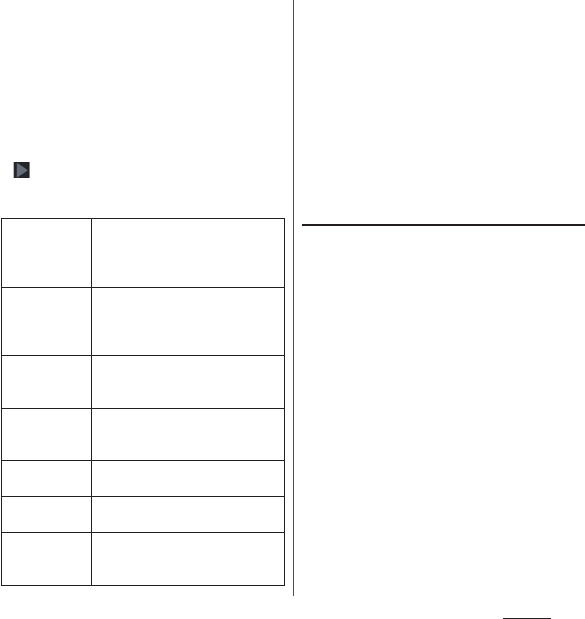
223
Settings
❖
Information
・
You can use the terminal without creating your
Google account, however the services such as
Google Talk, Gmail, Google Play, etc. are not available.
・
To log in, you need a Google account and a
password.
・
When you sign in, "Backup and restore" screen may
appear. To back up applications, bookmark settings,
etc. using a Google account, mark "Keep this phone
backed up with my Google Account" and then tap
.
・
Tap set Google account and synchronize each data
from the following items manually.
* If a lot of photos are included to Picasa web album
used in Google account or web album uploaded
by Google+, it may consume a lot of battery power
or increase data communication volume during
the synchronization.
・
If you set a Google account and use Google+ in it,
"Sync Google+" appears. Tap it to synchronize and
display instant upload photos in the Album in the
terminal.
・
Make sure to check if the data connection is available
before sign in to the Google account. For checking
the data connection status, see "Status icon" (P.43).
Setting Facebook account
When you register or sign in Facebook, you
can display profile information published by
online "Friends" to the phonebook.
❖
Information
・
If you do not have a Facebook account, you can also
create a new account in the following website.
http://www.facebook.com
1
From the Settings screen (P.193),
tap [Add account]
u
[Facebook].
・
If you already have a Facebook account
and set account from the phonebook
etc. of the terminal, you need not add a
new account.
2
Enter your sign in information.
・
If you have no Facebook account,
register an account.
・
If you have Facebook account, sign in.
Sync Browser
Synchronize browser settings saved
in Google account such as
bookmarks with web function of the
terminal.
Sync Calendar
Synchronize calendar information
such as schedule, etc., stored in
Google account with Calendar in the
terminal.
Sync Contacts
Synchronize contacts stored in
Gmail with the phonebook stored in
the terminal.
Sync Gmail
Synchronize contacts stored in
Gmail with the Email history stored
in the terminal.
Sync Google
Photos
*
Synchronize web album Google
Photos with album in the terminal.
Sync Google
Play Books
Synchronize with Google Play Books.
Sync Google
Play Movies &
TV
Synchronize with Google Play
movies.
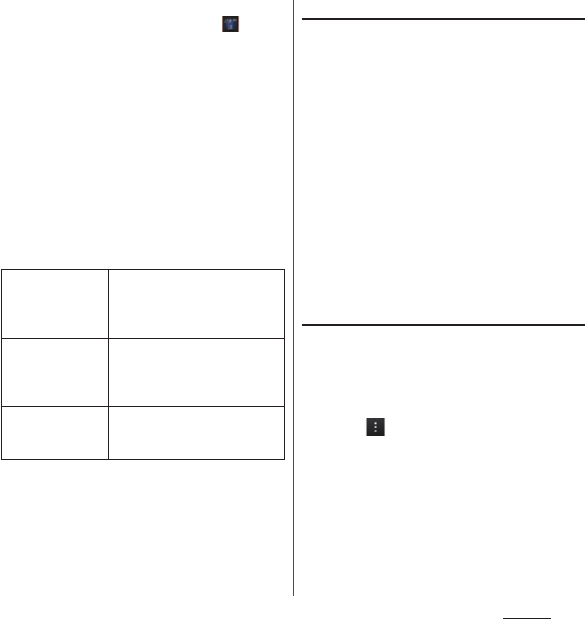
224
Settings
■
Setting Xperia
™
with Facebook
Set Facebook account to display in the
status bar. Drag the status bar downwards
and set "Xperia
™
with Facebook" to
synchronize functions of applications in the
terminal.
1
Drag the status bar downwards
and tap [Xperia
™
with Facebook].
2
Tap [Done].
❖
Information
・
Alternatively, from the Settings screen (P.193), tap
[Add account]
u
[Xperia
™
with Facebook].
・
Tap the set account to set the following items.
・
Tap "Xperia
™
with Facebook" account and
[Application control settings], then mark each
function to synchronize applications in the terminal
and Facebook.
Setting other account
You can set docomo account, Email,
Corporate (Exchange ActiveSync), etc. other
than Google account (P.222) or Facebook
account (
P. 2 2 3
).
1
From the Settings screen (P.193),
tap [Add account].
2
Tap an account type.
・
After this step, follow the onscreen
instructions.
❖
Information
・
Use docomo account when you use "
ドコモバック
アップ
(docomo backup)" app (P.190) provided by
NTT DOCOMO. docomo account is set by default.
Removing account
1
From the Settings screen (P.193),
select an account type and then
select an account you want to
delete.
2
Tap , then tap [Remove
account]
u
[Remove account].
❖
Information
・
A Google account registered by marking "Keep this
phone backed up with my Google Account" on the
"Backup and restore" screen is registered as a backup
account. When a backup account is removed,
caution appears on the status bar.
・
docomo account cannot be deleted.
Sync Calendar
Synchronize events such as
Friends' birthdays, etc., stored in
Facebook with Calendar in the
terminal.
Sync Contacts
Synchronize profile of Friends
stored in Facebook with the
phonebook stored in the
terminal.
Sync Friends'
music
Synchronize music that Friends
specified "Like" in Facebook with
WALKMAN in the terminal.
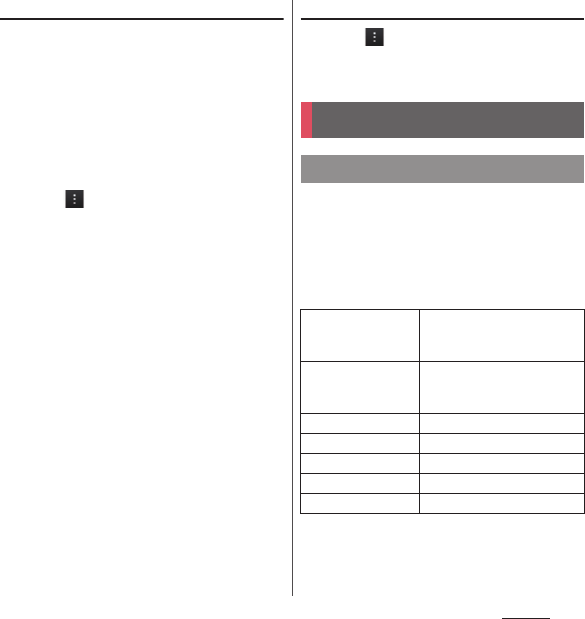
225
Settings
Setting Auto-sync
Synchronize information of online service
with the terminal. You can display and edit
information on the terminal or a PC.
・
You need to set your online service account
(Google account, Facebook account, etc.) in
the terminal to synchronize in advance.
1
From the Settings screen (P.193),
tap [Data usage].
2
Tap and [Auto-sync data], then
read the notes and then tap [OK].
・
"Auto-sync data" is marked.
❖
Information
・
To change online service items for synchronizing,
from the Settings screen (P.193), select an account
type. Select an account to change and mark items to
be synchronized.
❖
Note
・
Setting Auto-sync permits to synchronize data of
Gmail, calendar, contacts, etc. in the Google account
and profile information published by "Friends" etc.
set in the online service automatically. These
communications may cause you to pay packet
communications charges.
・
When Auto-sync is not set, synchronize manually.
From the Settings screen (P.193), select an account
type. Select an account and tap items to be
synchronized.
Canceling synchronization
1
Tap during a synchronization.
2
Tap [Cancel sync].
You can change the date and time in the
terminal.
・
To set date/time or time zone manually,
unmark "Automatic date & time" or
"Automatic time zone" to disable network-
provided time/time zone in advance.
SYSTEM
Date & time
Automatic date &
time
Adjust date and time
automatically by using
network-provided information.
Automatic time zone
Adjust time zone
automatically by using
network-provided information.
Set date
P. 2 2 6
Set time
P. 2 2 6
Select time zone
P. 2 2 6
Use 24-hour format
P. 2 2 6
Choose date format
P. 2 2 6

226
Settings
❖
Information
・
Correction of the time differences may not be
performed correctly depending on the overseas
network operator. In that case, set time zone
manually (P.226).
Setting the date
1
From the Settings screen (P.193),
tap [Date & time]
u
[Set date].
2
Drag number to adjust date.
3
Tap [Done].
Setting the time
1
From the Settings screen (P.193),
tap [Date & time]
u
[Set time].
2
Drag number to adjust hour and
minute.
・
When you unmark "Use 24-hour
format", drag "am" or "pm" to switch
AM/PM.
3
Tap [Done].
Setting the time zone
1
From the Settings screen (P.193),
tap [Date & time]
u
[Select time
zone].
2
Select time zone you want to set.
Setting the time format
1
From the Settings screen (P.193),
tap [Date & time].
2
Mark/unmark "Use 24-hour
format".
・
Mark the checkbox to shift to 24-hour
format, and unmark to shift to 12-hour
format.
Setting the date format
1
From the Settings screen (P.193),
tap [Date & time]
u
[Choose date
format].
2
Select date format you want to set.
You can set user support service which
sounds or vibrates according to users
operation and call end operation.
Accessibility
TalkBack
Set user support service
(TalkBack).
Large text
Enlarge text size.
Power button ends call
Set to end a call by
pressing
P
.
Auto-rotate screen
P. 4 0
Speak passwords
Output password by voice
sound.
Text-to-speech output
P. 2 2 1
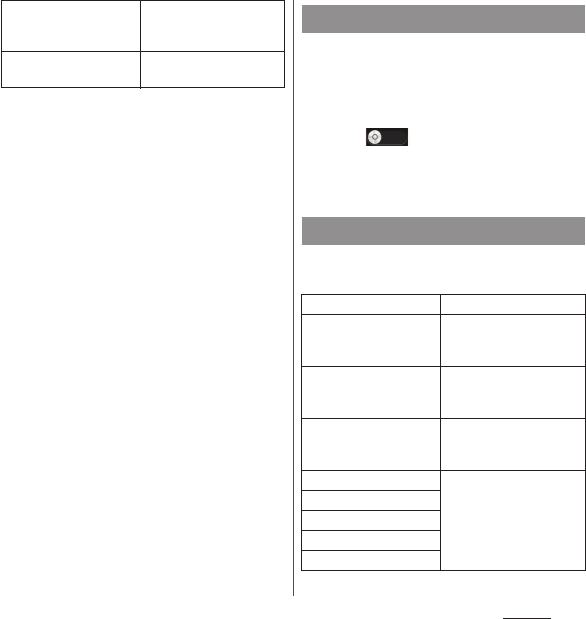
227
Settings
❖
Information
・
When TalkBack is turned on for the first time, a
message asking if touch exploration function feature
is enabled appears.
Touch exploration is a function that reads or displays
an explanation for the item you tapped.
When touch exploration feature is enabled, you can
operate the terminal in the different way from the
usual one. To select an item, tap it once and then
double-tap it. To drag, trace the screen to desired
orientation with 2 fingers.
To turn off only Touch exploration, from the Settings
menu screen (P.193), tap [Accessibility]
u
[TalkBack]
u
[Settings], then unmark "Explore by touch".
Make settings for developing applications or
set whether to use debug function.
1
From the Settings screen (P.193),
tap [Developer options].
2
Tap in Developer options or
drag it right.
3
Read the notes and then tap [OK].
You can check your own phone number,
battery status, legal information, etc.
Touch & hold delay
Set response time for
operation of touching and
holding the screen.
Enhance web
accessibility
Set whether to install
script from Google.
Developer options
About phone
Software Update
P. 2 6 9
Application update
Download new
applications or update
applications.
Status
Check your own phone
number, battery status,
battery level, etc.
Legal information
Check open source license
or Google terms of use,
etc.
Model number
Check version and
number.
Android version
Baseband version
Kernel version
Build number

228
File management
File management
Folders in the internal storage by default are
as follows.
・
Displayed folders may differ depending on
the terminal operations.
You can save data in the terminal to microSD
card or import data from the microSD card to
the terminal. You can use microSD card for
any other compatible devices.
・
The terminal supports microSD card of up to
2GB, and microSDHC card of up to 32GB,
microSDXC card of up to 64GB (As of April,
2013).
・
For compatible microSD cards, contact
manufacturers of microSD cards.
・
A microSDXC card can be used only on a
compatible device. Inserting a microSDXC
card into a non-microSDXC-compatible
device may damage or destroy data saved on
the microSDXC card. Do not insert one.
・
If you want to reuse a microSDXC card on
which data is destroyed, format microSDXC
card (all data will be erased) on an SDXC-
compatible device.
・
When copying data to/from a non-SDXC-
compatible device, use a card (microSDHC
card or microSD card) complying with
standards of device to share data.
Storage structure
Phone (Internal storage)
Android
Stores setting data for system or
each application, temporary files,
etc.
Notifications
Stores notification files used by
Google+. Also, stores music data
etc. you want to set as
notification sound.
com.sonyericsson.
notes
Stores a part of information of
"Notes" application. If you delete
this folder, the data may not be
displayed correctly.
image
Stores still image data.
Music
Stores music data.
video
Stores video data.
microSD card (External
storage)

229
File management
・
When installing/removing the microSD card,
make sure to power off the terminal (P.37). Do
not attach an AC adapter.
・
For removing/attaching the back cover, see
"To ensure waterproofness/dustproofness"
(P.24, P.25).
Inserting microSD card
1
Hook the groove on the bottom of
the terminal with your fingertip
and lift up the back cover to
remove.
2
Remove the battery pack, check
the orientation of the microSD
card, then slowly insert it straight
into the holder.
・
Insert the microSD card with metal
contacts side down.
3
Install the battery pack and attach
the back cover, then make sure
that there are no gaps between the
terminal and the back cover.
Removing microSD card
1
Hook the groove on the bottom of
the terminal with your fingertip
and lift up the back cover to
remove.
2
Remove the battery pack, press
the microSD card with your
fingertip, then slip it out to
remove.
3
Install the battery pack and attach
the back cover, then make sure
that there are no gaps between the
terminal and the back cover.

230
File management
Use "File Commander" application to display
or manage various data such as still images,
videos, music, etc. saved to the terminal or
the microSD card.
❖
Information
・
When you activate for the first time, a screen for
registering name etc. appears. Select "Register later"
or "Register now".
When you select [Register later] and register to File
Commander later, from the Home screen, tap ,
then [File Commander]
u
[Help]
u
[Register].
Displaying/Playing file
1
From the Home screen, tap ,
then tap [File Commander].
・
Item list appears.
・
By default, "Downloads", "Pictures",
"Music", "Videos", "Internal storage",
"Remote files" are displayed.
・
When a microSD card is attached,
"Sdcard1" appears.
2
Select an item, then tap a folder as
required.
3
Tap a file you want to use.
・
The file is displayed/played.
Creating new folder
1
From the Home screen, tap ,
then tap [File Commander].
2
Select an item, then tap a folder as
required.
3
Tap [New]
u
[Folder].
4
Enter a folder name, then tap [OK].
Renaming folder or file
1
From the Home screen, tap ,
then tap [File Commander].
2
Touch and hold a folder or file you
want to rename.
3
Tap [Rename], then enter a folder
name or file name.
4
Tap [OK].
File operations
Operating files or folders
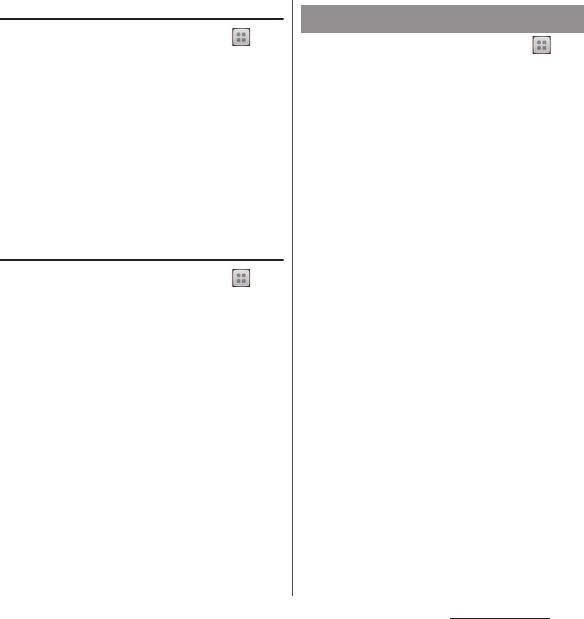
231
File management
Deleting folder or file
1
From the Home screen, tap ,
then tap [File Commander].
2
Select an item, then tap a folder as
required.
3
Mark a folder or file you want to
delete.
4
Tap [Delete]
u
[OK].
・
Alternatively, touch and hold a folder or
file, then tap [Delete]
u
[OK].
Moving/Copying folder or file
1
From the Home screen, tap ,
then tap [File Commander].
2
Select an item, then tap a folder as
required.
3
Mark a folder or file to move/copy,
then tap [Cut]/[Copy].
4
Tap
x
until the File Commander
screen appears.
5
Tap [Edit]
u
[Paste] anywhere.
1
From the Home screen, tap ,
then tap [File Commander].
2
Tap [Find] and enter a folder name
or file name.
・
Search suggestions appear as you enter
a character.
Searching for data

232
Data communication
Data communication
You can send/receive data to/from a device
with infrared communication function such
as a mobile phone.
・
The communication range for infrared
communication is 20 cm or less. Keep the
devices pointing at the infrared data port
each other, and do not move them until data
exchange completes.
・
If the infrared data port is soiled, clean the
data port with a dry soft cloth to prevent from
scratching. Performing infrared
communication with the data port soiled or
scratched may cause communication failure.
・
Infrared communication may not be
performed in areas exposed to direct sunlight,
directly under fluorescent lights or near
infrared devices.
・
Depending on the terminal of the other party,
it may be difficult to exchange data.
❖
Information
・
Do not cover the infrared data port with the fingers,
etc. while performing infrared communication.
・
Infrared communication for the terminal conforms to
IrMC version 1.1. However, some data cannot be sent
or received even if the receiver's phone conforms
IrMC version 1.1.
・
Authentication password and docomo apps
password may be required while sending or
receiving infrared data. Authentication password is a
4-digit number fixed up between you and other
party in advance. The same number string must be
entered by the sender and receiver. For the docomo
apps password, see "docomo apps password" (P.214).
・
If the terminal receives a call during infrared
communication, data exchange is interrupted and
the incoming call screen appears.
・
If the set alarm time comes during infrared
communication, data exchange is interrupted and
the alarm starts to sound.
・
is displayed in the status bar during infrared
communication.
Using infrared
communication
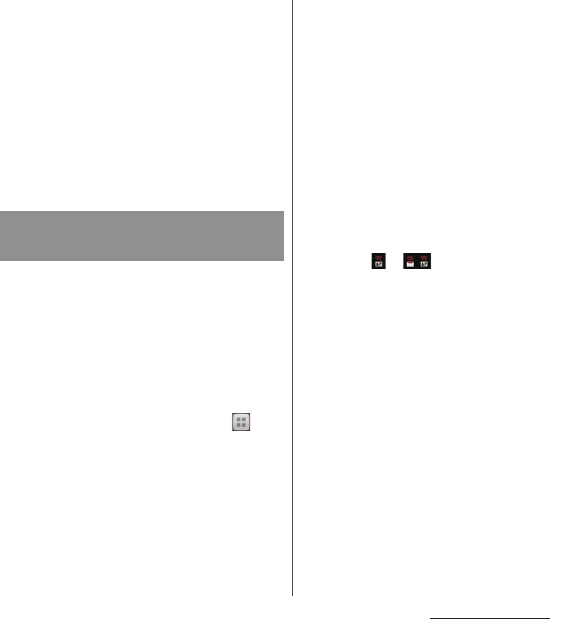
233
Data communication
・
You can send and receive Phonebook entries, My
profile, name card, sp-mode mail, Schedule & memo,
still images (.jpeg, .png, .gif, .bmp), videos (.mp4, .3gp)
and ToruCa. It may take a time to exchange data
depending on the data amount or device of other
party.
・
Some data, such as data with copyright protection,
etc., cannot be played back on other devices.
・
Received data cannot be played back or saved
depending on the sender's device, data type or data
amount.
・
The received data is saved on the internal storage.
Use the "Infrared" application to send all data
of "Phonebook", "sp-mode mail" or
"Schedule&Memo". You can also send data
one by one or send a still image or a video
using the sharing menu of applications such
as "docomo phonebook", "Album".
■
Sending with "Infrared" application
1
From the Home screen, tap ,
then tap [Infrared].
2
Tap [Send all].
3
Tap [Phonebook]/[sp-mode mail]/
[Schedule&Memo].
・
When you tap [sp-mode mail], select
any of "Inbox"/"Sent"/"Unsent".
4
Tap [Start].
5
Enter docomo apps password and
tap [OK].
6
Enter the same authentication
password as that of the recipient
and tap [OK]
u
[OK]
u
[OK].
■
Sending with sharing menu of
function
1
Select "Infrared" from the sharing
menu of each application.
❖
Information
・
My profile (excluding name card) can be sent using
infrared communication widget. From the Home
screen, tap of (infrared communication
widget) and follow the onscreen instructions.
・
For instructions on sending from the "docomo
phonebook" application, see "Sending phonebook
entries via infrared communication" (P.110).
・
For instructions on sending from "Album"
application, see "Sharing image files" (P.175).
・
You cannot send two or more items of My profile,
name card, still image, video or ToruCa at a time.
Sending data via infrared
communication
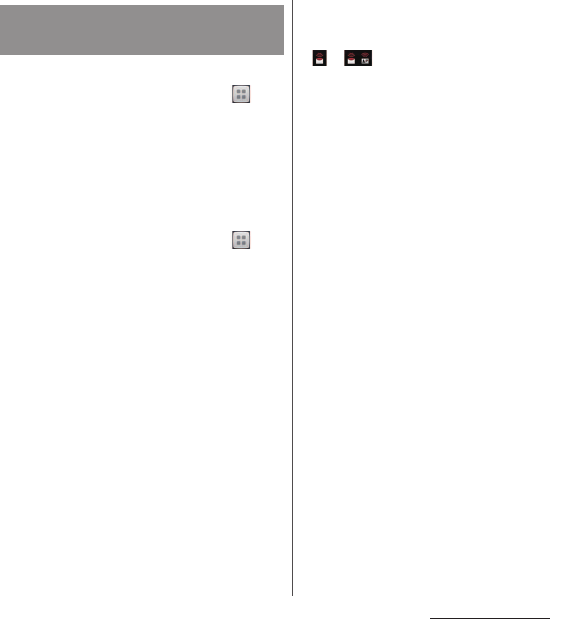
234
Data communication
■
Receiving 1 item
1
From the Home screen, tap ,
then tap [Infrared].
2
Tap [Receive]
u
[OK].
3
When receiving is complete, tap
[OK]
u
[OK].
■
Receiving all items
1
From the Home screen, tap ,
then tap [Infrared].
2
Tap [Receive all].
3
Enter docomo apps password and
tap [OK].
4
Enter the same authentication
password as that of the sender and
tap [OK]
u
[OK]
u
[OK]
u
[OK].
❖
Information
・
1 item of data can be received using infrared
communication widget. From the Home screen, tap
of (infrared communication widget) and
follow the onscreen instructions.
・
When phonebook entries, sp-mode mail and
schedule
&
memo are received, data on the terminal
is deleted before saved.
・
You cannot receive two or more videos at a time.
・
You may not save received data if the phone
memory is full.
・
A file name may be changed when saving. A file
named with 127 characters or more (Unicode) may
not be saved properly.
Receiving data via infrared
communication
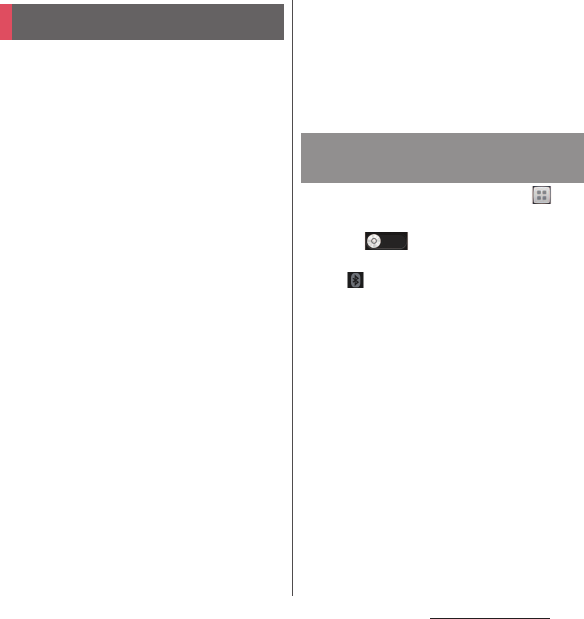
235
Data communication
Bluetooth function is a technology which
enables to connect with Bluetooth device
such as PC, handsfree headset wirelessly.
To communicate with Bluetooth device, turn
Bluetooth function on and pair or connect
the terminal and the Bluetooth device.
❖
Information
・
By default, Bluetooth function is off. If you turn
Bluetooth on and then turn off the terminal,
Bluetooth function turns off. When you turn on the
terminal again, Bluetooth function turns on
automatically.
・
When you do not use Bluetooth function, turn it off
to save the battery.
■
Reception interference caused by
wireless LAN devices
The terminal's Bluetooth function and
wireless LAN devices use the same
frequency band (2.4GHz). If you use the
terminal near a wireless LAN device,
reception interference may occur or the
communications speed may lower. Also,
you may hear noise or have a connection
problem. In these cases, do the following:
・
Keep the Bluetooth device 10 meters or
more away from a wireless LAN device.
・
Within 10 meters, turn off either the
Bluetooth device or the wireless LAN
device.
* The terminal does not communicate
wirelessly with all types of Bluetooth
devices. Bluetooth DUN is not supported.
1
From the Home screen, tap ,
then tap [Settings].
2
Tap in Bluetooth or drag it
right.
・
appears on the status bar and
Bluetooth function turns on.
3
Tap [Bluetooth].
4
Tap [Xperia
●
].
・
The terminal becomes detectable by
other Bluetooth devices for 2 minutes.
❖
Information
・
Alternatively, drag the status bar downwards and tap
[Bluetooth] to set Bluetooth function to on/off.
Using Bluetooth function
Making the terminal detectable
with the Bluetooth function on
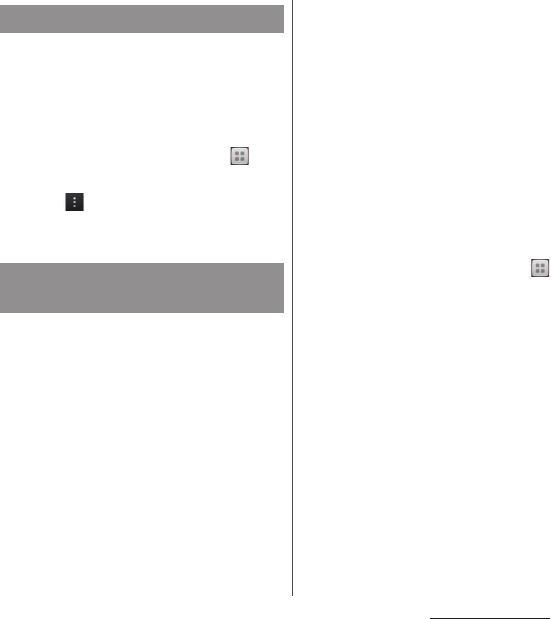
236
Data communication
You can name the terminal. The name
appears on Bluetooth devices when you use
the Bluetooth function.
1
Make sure that the Bluetooth
function is on.
2
From the Home screen, tap and
tap [Settings]
u
[Bluetooth].
3
Tap and tap [Rename phone].
4
Enter a name and tap [Rename].
To connect the terminal and Bluetooth
device, make pair setting for Bluetooth
device. When paired and connected, you can
make/receive a call with handsfree headset
etc., or send/receive data such as image
between the terminal and the Bluetooth
device.
・
Once you have made pair setting for the
terminal and a Bluetooth device, the setting is
saved.
・
For make pair setting, entering passcode (PIN)
may be required. Passcode (PIN) of the
terminal is "0000". If you cannot make pair
setting when you enter "0000", see the
documentation of your Bluetooth device.
・
Once you made pair settings by entering
passcode (PIN), you do not need to enter the
passcode (PIN) when connecting with the
paired Bluetooth device next time.
・
For Bluetooth profiles compatible with the
terminal, see "Main specification" (P.275).
1
Make sure that the Bluetooth
function is on.
2
From the Home screen, tap and
tap [Settings]
u
[Bluetooth].
3
Tap [Search for devices].
・
A list of detected Bluetooth devices
appears.
4
Tap a Bluetooth device name to
pair with the terminal.
Entering the terminal name
Making pair setting for the
terminal and Bluetooth device
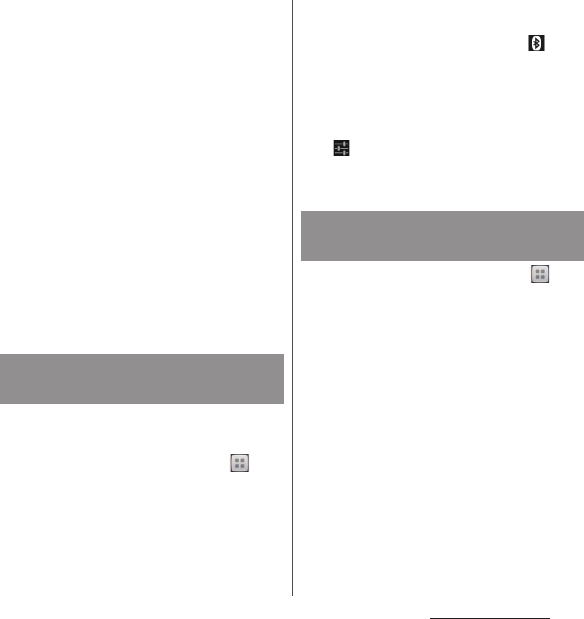
237
Data communication
5
Check a passkey on the "Bluetooth
pairing request" screen, then tap
[Pair].
・
You can use the Bluetooth device that
has been paired.
・
Some Bluetooth devices make
connections continuously after making
pair setting.
・
Authentication passcode (PIN) may be
required on the "Bluetooth pairing
request" screen.
❖
Information
・
Make sure that the Bluetooth function and Bluetooth
detection function of the target device are on.
・
When you make pair setting with the Bluetooth
device supporting Secure Simple Pairing (SSP)
function, a passkey appears on the screen. Check the
passkey and make the pair setting.
1
Make sure that the Bluetooth
function is on.
2
From the Home screen, tap and
tap [Settings]
u
[Bluetooth].
3
Tap [Search for devices].
・
A list of detected Bluetooth devices
appears.
・
Pair with Bluetooth device as required.
4
Tap the name of Bluetooth device
you want to connect.
・
While connecting to a device,
appears in the status bar and the
connection status appears under the
device name.
❖
Information
・
Tap on the name of connected Bluetooth device
to check the status of that Bluetooth device or
change the settings.
1
From the Home screen, tap and
tap [Settings]
u
[Bluetooth].
2
Tap the connected Bluetooth
device name.
3
Tap [OK].
・
To reconnect, tap the device name.
Connecting the terminal with
Bluetooth device
Disconnecting a Bluetooth
device
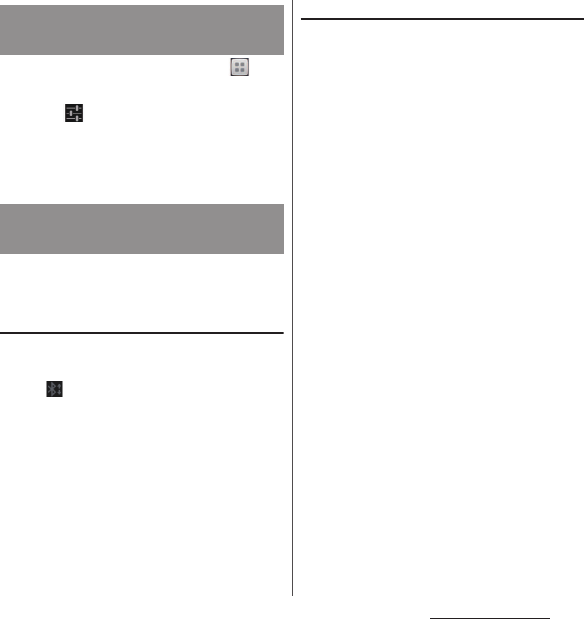
238
Data communication
1
From the Home screen, tap and
tap [Settings]
u
[Bluetooth].
2
Tap in a Bluetooth device name
to unpair and tap [Unpair].
・
Connection disconnects and the pair
setting is canceled.
・
Turn the Bluetooth function on before pairing
with the other party's Bluetooth device.
Receiving data via Bluetooth function
1
Send data from a Bluetooth
device.
・
appears on the status bar.
2
Drag the status bar downwards
and tap [Bluetooth share:
Incoming file]
u
[Accept].
・
When receiving is complete, a message
indicating that the data is received
appears.
Sending data via Bluetooth function
1
Select "Bluetooth" from the
sharing menu of each application.
2
Tap the other party's Bluetooth
device.
・
When sending is complete, a message
indicating that the data is sent appears.
❖
Information
・
For instructions on sending from the "docomo
phonebook" application, see "Sending phonebook
via Bluetooth/Email/Gmail" (P.110).
・
For instructions on sending from "Album"
application, see "Sharing image files" (P.175).
Canceling the pair setting of a
Bluetooth device
Sending/receiving data using
Bluetooth function
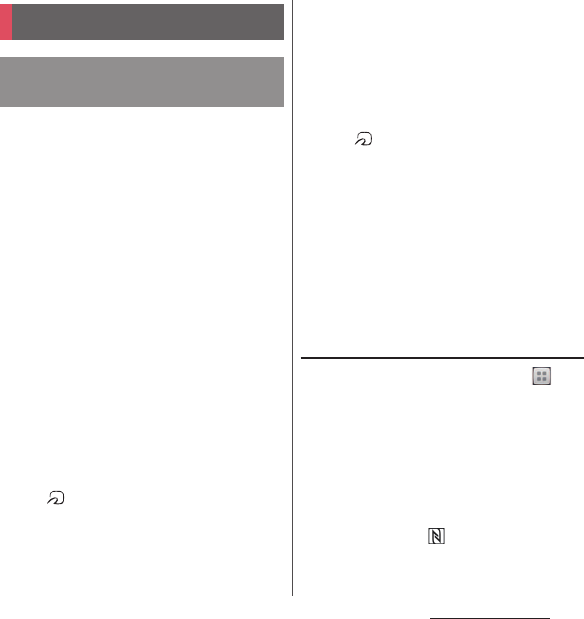
239
Data communication
You can send/receive data to/from a device
with NFC such as a mobile phone. If you use
the one-touch function with a Sony product
with NFC, simple operations allow you to
send or receive images, music, photos or
videos taken with the terminal.
・
Enable NFC Reader/Writer, P2P function in
advance (P.239).
・
Place 2 mobile phones in parallel position and
point marks to each other. Do not move
them until sending/receiving is complete.
・
Operations to send/receive and available data
to send/receive depend on the compatible
applications. Follow the onscreen
instructions.
・
If the License agreement screen appears
when sending/receiving data, read the
content and follow the onscreen instructions.
・
Even if marks are pointed to each other,
sending/receiving may fail. If failed, perform
operations of sending/receiving again.
・
The terminal does not communicate with all
NFC devices.
・
For notes when holding over the other
device, see "Notes on holding the mark over
the other device such as a reader or device
with the NFC module" (P.136).
Enabling NFC Reader/Writer, P2P
function
1
From the Home screen, tap ,
then tap [Settings]
u
[More...].
2
[NFC / Osaifu-Keitai
settings]
u
[Reader/Writer,
P2P]
u
[OK].
・
"Reader/Writer, P2P" and "Android
Beam" are marked.
・
NFC Reader/Writer, P2P function is
enabled, and appears in the status
bar.
Using NFC communication
Sending/receiving data by one-
touch function
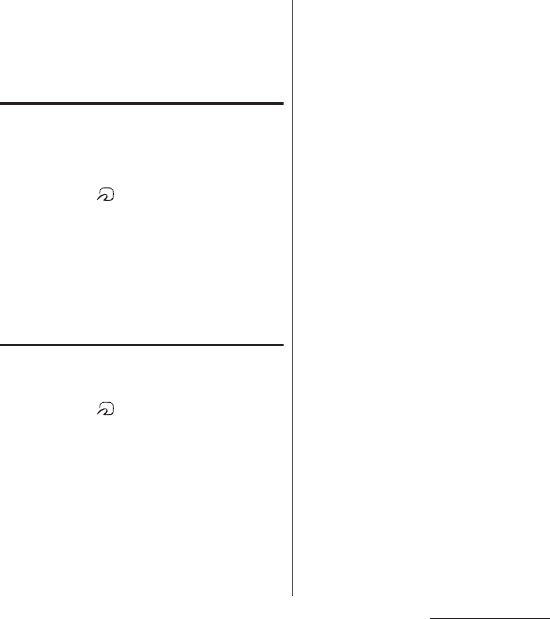
240
Data communication
❖
Information
・
Alternatively, from the Home screen, use NFC Quick
Launch to enable/disable NFC Reader/Writer, P2P
function.
Sending data
1
Make sure that the NFC Reader/
Writer, P2P function is enabled.
2
Display data to send on the screen.
3
Face the marks on the terminal
and the receiver’s terminal each
other.
・
The displayed screen becomes small,
and "Touch to beam" appears.
4
Tap the screen.
Receiving data
1
Make sure that the NFC Reader/
Writer, P2P function is enabled.
2
Face the marks on the terminal
and the receiver’s terminal each
other.
・
When data is received, an application
that supports the data opens. Follow
the onscreen instructions.

241
External device connection
External device connection
By connecting the terminal and a PC with the
Micro USB Cable 01 (optional), the internal
storage and a microSD card in the terminal
are recognized by the PC and you can
operate such as copying, moving, deleting
the data.
・
You may not be able to copy, move, delete,
etc. copyrighted data of images, music, etc.
❖
Information
・
The following operating systems (OS) are supported.
- Microsoft Windows 8
- Microsoft Windows 7
- Microsoft Windows Vista
- Microsoft Windows XP
・
The terminal is connected by "Media transfer mode
(MTP)" which is set by default.
Connecting the terminal and a PC
using a microUSB cable
・
For using Mass storage mode (MSC) etc.,
attach a microSD card to the terminal (P.229).
1
Connect the terminal to a PC using
a microUSB cable (P.35).
・
When you connect microUSB cable for
the first time, the driver software for the
terminal is installed to a PC. Wait for a
while until installation is completed.
・
When "PC Companion software" screen
appears on the terminal, tap [Skip].
■
Media transfer mode (MTP)
"Internal storage & SD card" appears in
the status bar of the terminal. The
terminal is displayed on the PC screen as
a portable device.
You can access the internal storage and a
microSD card in the terminal.
■
Mass storage mode (MSC)
"SD card connected" appears in the status
bar of the terminal. The terminal is
displayed on the PC screen as a
removable disc.
You can access the microSD card.
Connecting to PC
Connecting to a PC with
microUSB cable
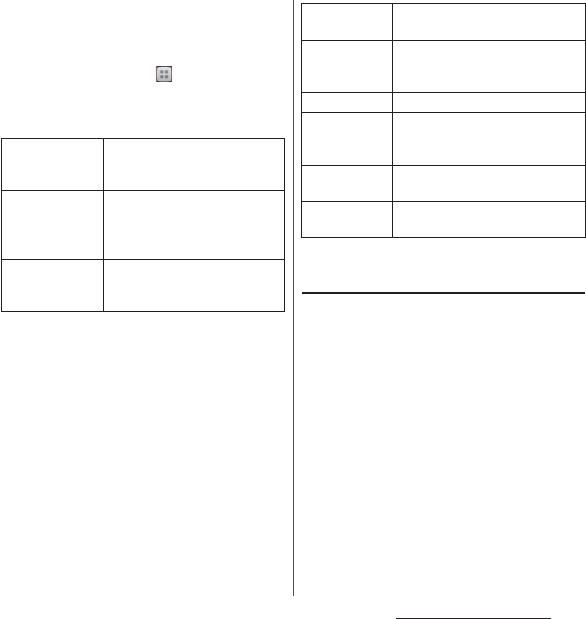
242
External device connection
❖
Information
・
Screen that appears when connecting to a PC may
vary depending on the operating system (OS) of a
PC.
・
From the Home screen, tap and tap
[Settings]
u
[Xperia
™
]
u
[USB Connectivity] to check
connection mode and change the settings as
follows.
・
When you connect the terminal to a PC switching
USB connection mode to "Mass storage mode
(MSC)", you cannot access the microSD card on the
terminal. Some functions using microSD card for the
applications such as "Camera" or "Album" may not be
available.
・
When the terminal is connected to a PC, charging
starts automatically. For details, see "Charging with a
PC" (P.35).
・
Install PC Companion by tapping [Install] on the "PC
Companion software" screen to perform software
update of the terminal on the connected PC (P.272).
Also, you can use the following applications for
managing media files, making backup files, etc. by
connecting to a PC. For details, check PC Companion
screen after installation.
Disconnecting the microUSB cable
safely
・
Do not disconnect the microUSB cable during
data transferring. Data may be damaged.
■
Media transfer mode (MTP)
1
Confirm that it is not transferring
data, disconnect the microUSB
cable.
■
Mass storage mode (MSC)
1
Drag the status bar downwards.
2
Tap [SD card connected].
・
"SD card disconnected" appears in the
status bar.
3
Disconnect the microUSB cable.
Install PC
Companion
Display PC Companion installation
wizard when connected to a PC
(P.272).
USB connection
mode
Switch USB connection mode to
"Media transfer mode (MTP)"/
"Mass storage mode (MSC)" when
connecting to a PC.
TRUSTED
DEVICES
Connect the terminal and a host
device in a pair via Wi-Fi network
(P.243).
Support Zone
Update software of the terminal by
connecting to a PC (P.272).
Contacts Setup
Copy the contacts data of the
mobile phone previously used to the
terminal.
Media Go
P.243
Sync Zone
Synchronize phonebook or calendar
between a PC or Google and the
terminal.
Back up &
Restore
Back up the terminal data or move
the data to another terminal.
File Manager
Check file type, update time,
location, etc. on the terminal.

243
External device connection
The Media Go computer application helps
you transfer and manage media content in
the terminal and PC.
With Media Go, you can load music from a CD
to a PC and transfer to the terminal.
・
You can install Media Go from PC Companion.
Activate PC Companion installed in a PC and
install Media Go with "Sony PC Companion"
screen. For information on how to install PC
Companion, see "When PC Companion is not
installed on your PC" (P.272).
・
To learn more about how to use the Media Go
application, click "Help" on the Media Go
window on a PC and then click "Media Go
Help".
❖
Information
・
You can also download Media Go from the following
website.
http://mediago.sony.com/enu/features
If the terminal and a PC
*
are connected in a
pair on a Wi-Fi network, automatic
connection/disconnection of internal storage
of the terminal with a PC is enabled when the
terminal user comes in and out of the Wi-Fi
area. You can easily access to files in the
internal storage of the terminal from a
connected PC.
* Use Microsoft Windows 7 or Microsoft
Windows 8 to make a pair setting. Pair setting
cannot be made under Microsoft Windows
XP, Microsoft Windows Vista or other OS.
1
Connect a PC you want to set in a
pair to a Wi-Fi network.
2
Connect the terminal to a Wi-Fi
network (P.194).
3
Connect the terminal to a PC using
a microUSB cable.
・
When "PC Companion software" screen
appears on the terminal, tap [Skip].
4
Make sure that the terminal is
displayed as a portable device on "
コンピュータ
(Computer of the PC
screen)".
Using Media Go Connecting the terminal to a PC
on a Wi-Fi network

244
External device connection
5
Right-click the portable device
icon, then click "
ネットワーク構成
(Network composition)".
6
Click "
次へ
(Next)".
7
On the pop-up screen of the
terminal, tap [Pair].
8
On the "
ポータブルデバイスのネット
ワーク構成
(Network composition of
the portable device)" screen of the
PC, click "
完了
(Done)".
9
Disconnect the microUSB cable.
10
From the Home screen, tap and
tap [Settings]
u
[Xperia
™
]
u
[USB Connectivity]
u
"Host name"
(PC name) in the "TRUSTED
DEVICES" field.
11
Tap [Connect].
・
The terminal and the PC are connected
in "Media transfer mode (MTP)" on a Wi-
Fi network, and you can exchange data
files.
❖
Information
・
From the Home screen, tap and tap
[Settings]
u
[Xperia
™
]
u
[USB Connectivity] to display
"Host name" (PC name) in the "TRUSTED DEVICES"
field. To cancel connection setting, tap the host
name and [Forget]. Until "Forget" is tapped, the
connection setting retains even if you connect/
disconnect repeatedly by coming in and out of a Wi-
Fi area.
・
If the privacy separator function for Wi-Fi network
(access point) is enabled, pair setting cannot be
made.
Using Wi-Fi function, you can share media
files with other client (DLNA : Digital Living
Network Alliance) devices.
Set Wi-Fi connection (P.194) with another
client device in advance.
Connecting to DLNA device
Sharing a file with DLNA device
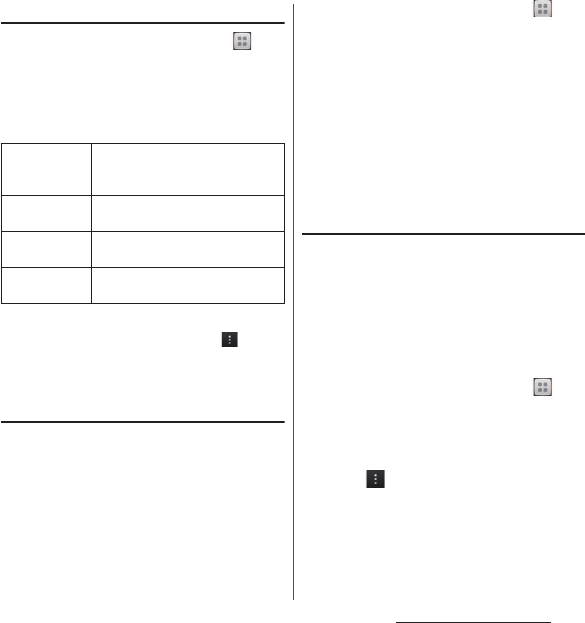
245
External device connection
Setting Media server
1
From the Home screen, tap ,
then tap [Settings]
u
[More...].
2
Tap [Media server settings].
・
Media server settings screen appears.
You can set the following items.
❖
Information
・
On the Media server settings screen, tap and [Wi-
Fi settings] to set Wi-Fi connection.
Playing media files in the DLNA
device with the terminal
You can share media files on the terminal and
DLNA device using Media server function.
・
Connect a DLNA device and the terminal via
the same Wi-Fi network, and set the
permission of access from the terminal for the
device in advance.
1
From the Home screen, tap ,
then tap [Album]/[Movies]/
[WALKMAN].
2
Tap [My albums]/[Devices]/[My
music].
3
Select a device name to connect,
and select a folder.
4
Tap a media file to play it.
Playing a media file in the terminal
with a DLNA device
You can play a media file in the terminal with
a DLNA device using Throw function.
・
Connect a DLNA device and the terminal via
the same Wi-Fi network in advance.
・
Setting a permission of access from the
terminal in advance may be required on a
DLNA device.
1
From the Home screen, tap ,
then tap [Album]/[Movies]/
[WALKMAN].
2
Tap a file you want to play.
3
Tap and [ Throw].
・
A device list appears.
4
Tap a device on the device list.
・
The file is played by a DLNA device.
SO-01F
Change server
name
Rename the terminal (server)
displayed on a client device.
Share content
Set to connect from a client device
to the terminal via Wi-Fi.
PENDING
DEVICES
Manage client devices waiting
access permissions.
REGISTERED
DEVICES
Manage client devices registered to
the terminal.

246
External device connection
This terminal supports MHL connection. To
connect to an MHL compatible TV, insert a
commercially available MHL cable into the
microUSB jack of the terminal and the MHL
jack of the TV.
To connect to an HDMI compatible TV, use a
commercially available HDMI connector
(MHL adapter) and an HDMI cable etc. to
connect to the terminal.
Connect to a TV to display photos and videos
on the TV screen.
1
Connect the terminal with the
Home screen or Application screen
displayed to a TV using an MHL
cable.
■
When the Home screen is displayed
・
Activate TV launcher automatically.
■
When Application screen is displayed
・
, appears on the status bar. Also,
drag the status bar downwards and tap
[TV launcher] to activate TV launcher.
2
Switch the TV to MHL input mode.
・
The screen of the terminal is shown on
the TV screen.
3
Flick an icon left or right to select
application you want to use.
❖
Information
・
While MHL is connected, drag the status bar
downwards and tap [MHL connected] to make
output settings or check using a TV remote control
etc.
・
On the TV launcher screen, select an album art in
WALKMAN at the upper left to display WALKMAN
screen.
・
On the TV launcher screen, Tap [Home] to display the
Home screen of the terminal.
・
On the TV launcher screen, tap [Add] or and tap
[Add], then select the desired shortcut to add to the
TV launcher screen.
・
On the TV launcher screen, tap and [Rearrange]
to rearrange shortcuts on the TV launcher screen.
・
On the TV launcher screen, tap and [Delete] to
delete shortcuts on the TV launcher screen.
・
Removing the MHL cable from the terminal severs
connection, however, TV may remain to MHL input
mode or HDMI input mode. Follow the instructions
on the TV to switch to digital terrestrial television
mode, etc.
・
When you do not use MHL connection, remove the
MHL cable or HDMI adapter and cancel MHL
connection. If the HDMI cable remains connected,
the battery may be consumed quickly.
・
The terminal does not support resolution 720
u
576p
(50Hz) for MHL output to TV.
Connecting to other
devices
Connecting TV and activating
application from TV launcher

247
External device connection
・
You can operate the TV Launcher screen, the Home
screen or applications using a TV remote controller if
connecting the following devices.
- MHL compatible TV supporting Remote Control
Protocol (RCP)
-HDMI compatible TV supporting Consumer
Electronic Control (CEC)
To connect to an HDMI compatible TV, a
commercially available HDMI connector (MHL
adapter) compatible with RCP is required.
Some applications may not support remote control
operations.
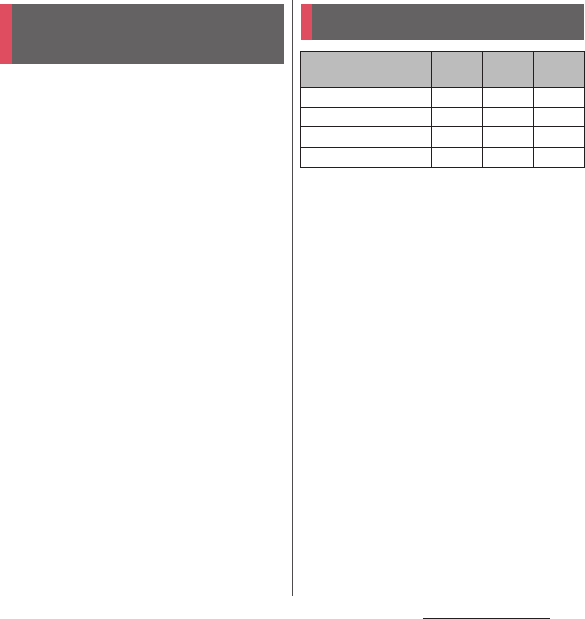
248
International roaming
International roaming
With the international roaming (WORLD
WING), you can use the terminal without
changing phone number or mail address in
the service area of the overseas network
operator affiliated with DOCOMO. You do not
need to change the settings of call and SMS.
■
Supporting networks
The terminal is Class 4. The terminal works in
a 3G roaming area and GSM/GPRS service
area. Services are also available in countries
and areas supporting 3G 850MHz/GSM
850MHz. Check available areas. Use 3G
network or GSM/GPRS network overseas
because Xi is not available overseas.
■
Before using the terminal overseas,
refer to the followings.
・
"Mobile Phone User's Guide [International
Services]"
・
DOCOMO International Services website
❖
Information
・
For Country codes, International call access codes,
Universal number international prefix, supported
countries/areas and network operators, refer to
"Mobile Phone User's Guide [International Services]"
or DOCOMO International Services Website.
* To use data communication during roaming, mark
"Data roaming" checkbox in Mobile network settings
(P.251).
❖
Information
・
Some services are not available depending on the
overseas network operator or network.
Overview of International
roaming (WORLD WING)
Available services
Main communication
services 3G 3G 850 GSM
(GPRS)
Phone
○○○
Message (SMS)
○○○
Email
*
○○○
Browser
*
○○○

249
International roaming
To use the terminal overseas, check the
following in Japan.
■
Subscription
・
Check if you subscribe WORLD WING. For
details, contact "General Inquiries" on the
last page.
■
Charging
・
For AC adapter for charging overseas
travel, use optional "AC Adapter 03" or "AC
Adapter 04".
■
Usage charge
・
Overseas usage charges (call and packet
communication) differ from those in
Japan.
・
Some applications perform
communication automatically. Packet
communication charge may be higher.
For operations for each application, ask
the application provider.
Network service settings
If you subscribe to network services, you can
use network services such as Voice Mail
Service, Call Forwarding Service, Caller ID
Display Request Service, etc., even overseas.
However, some network services cannot be
used.
・
To use network services overseas, you need to
set "Remote operation settings" to activate
(P.102). You can set Remote operation settings
in the country you stay (P.256).
・
Even if the setting/canceling operation is
available, some network services cannot be
used depending on overseas network
operators.
Before using
Before leaving Japan
Advance preparation
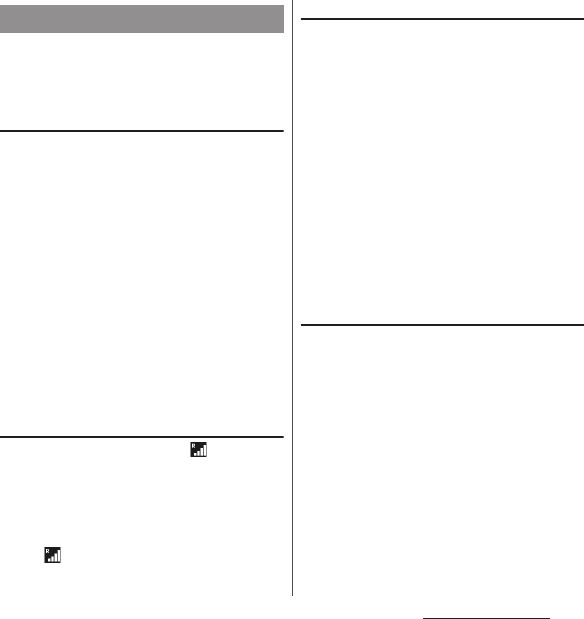
250
International roaming
When you arrive overseas and turn on the
terminal, an available network is
automatically set.
Connectivity
When you have set "Search mode" to
"Automatic" in "Service providers" settings,
optimized network is automatically selected
(P.251).
When you use a network operator of a
country/region covered by the flat-rate
service, you can use the service with flat-rate
packet communication charges overseas up
to the specified upper limit per day. To use
this service, subscription of packet flat-rate
service in Japan is required. For details, refer
to "Mobile Phone User's Guide [International
Services]" or DOCOMO International Services
Website.
Display
During international roaming, appears on
the status bar.
・
You can confirm the name of the connected
network operator on the Notification panel.
❖
Note
・
While appears on the status bar, packet
communication is available. Note that packet
communication charge may become high.
Date & time settings
When "Automatic date & time", "Automatic
time zone" in "Date & time" are marked, the
date, time and time differences of the
terminal clock are corrected by receiving the
information related to time and time
differences from the network of overseas
network operator you connect to.
・
Correction of the time/time differences may
not be performed correctly depending on the
network of overseas network operator. In that
case, set time zone manually.
・
Timing of correction varies by the overseas
network operator.
・
Date & time (P.225)
About inquiries
・
For loss or theft of the terminal or docomo
mini UIM card, immediately contact
DOCOMO from the spot to take the necessary
steps for suspending the use. For inquiries,
refer to the last page. Note that you are still
liable for the call and communication charge
incurred after the loss or theft occurred.
・
For using from land-line phone, entering
"International call access code" or "Universal
number international prefix" for the country is
needed.
After arriving overseas
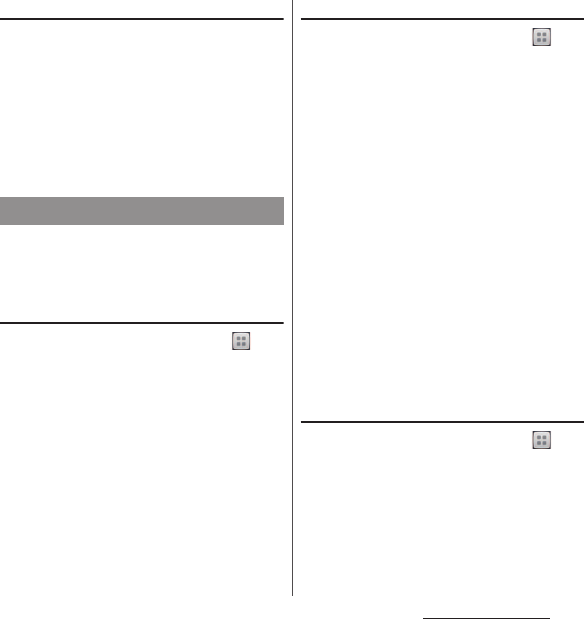
251
International roaming
After returning to Japan
When you return to Japan, the terminal is
connected to DOCOMO network
automatically. If connection is failed, perform
the following operations.
・
Set "Network Mode" to "LTE (preferred)/
WCDMA/GSM" (P.251).
・
Set "Search mode" to "Automatic" in "Service
providers" settings (P.251).
By default, the terminal automatically
searches available network and connect to it.
To switch network manually, set as follows.
Setting network mode
1
From the Home screen, tap ,
then tap [Settings].
2
Tap [More...]
u
[Mobile
networks]
u
[Network Mode].
3
Select a network mode you use.
・
You can select from "LTE/WCDMA"
"GSM only" and "LTE (preferred)/
WCDMA/GSM". If you select "LTE
(preferred)/WCDMA/GSM" to switch
available network automatically.
Setting a network operator
1
From the Home screen, tap ,
then tap [Settings].
2
Tap [More...]
u
[Mobile
networks]
u
[Service providers].
・
If a note appears, tap [OK].
3
Tap [Search mode]
u
[Manual].
・
To display available networks, tap
[Search networks].
4
From "AVAILABLE NETWORKS",
mark a network to use.
❖
Information
・
If you cannot search networks, disable mobile data
communication (P.198) and then search again.
・
If you set a network manually, the terminal is not
reconnected to another network automatically even
if you move out of the network area.
・
To return to "Automatic", tap [Automatic] in
Step 3.
Setting data roaming
1
From the Home screen, tap ,
then tap [Settings].
2
Tap [More...]
u
[Mobile networks].
3
Tap [Data roaming].
4
Read the note and tap [Yes].
・
"Data roaming" checkbox is marked.
Settings for overseas use

252
International roaming
When you arrive overseas and turn on the
terminal, an available network is
automatically set.
・
Check that the battery and signal levels are
high enough.
・
Depending on the network operator, even if
the Caller ID notification is active, the caller ID
may not be notified or appear properly.
In this case, calls cannot be made from the call
log.
You can make a call from overseas using the
international roaming service.
・
You can easily make international calls from
the country you stay to Japan or to other
countries by entering prefix "+" and then the
country code and phone number.
1
From the Home screen, tap ,
then tap "Dial" tab.
2
Dial + (touch and hold
[0])
u
Country code
u
Area code
(City code)
u
Enter a phone
number.
・
If the area code begins with "0", omit "0".
However, "0" may be required to dial to
some country or area such as Italy.
・
To call an overseas "WORLD WING" user,
enter "81" (Japan) for the country code.
3
Tap .
4
When the call is finished, tap [End
call].
❖
Information
・
During international roaming, if you make an
international call to Japan using "Phone" application,
the "International dialing assist" screen appears. You
can make a call without entering country code from
that screen.
For details on International dialing assist, see "Setting
international dial assistance" (P.255).
Making/receiving calls in
the country you stay
Making a call to outside
country you stay (including
Japan)
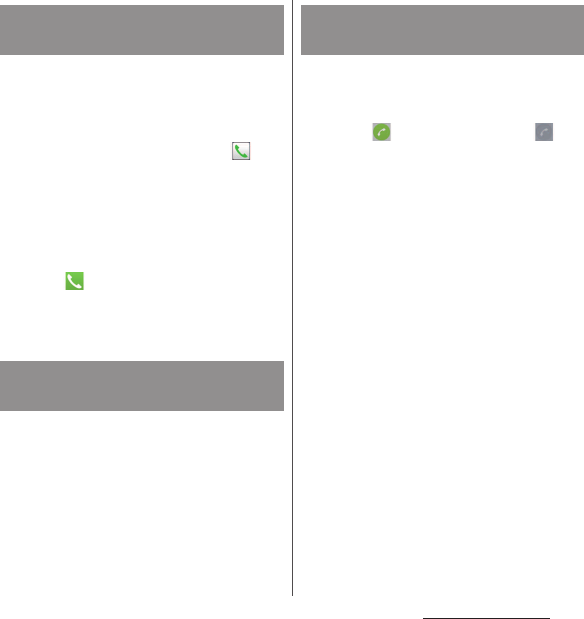
253
International roaming
You can make a call by entering the phone
number of the other party's land-line phone
or mobile phone in the same way you do in
Japan.
1
From the Home screen, tap ,
then tap "Dial" tab.
2
Enter a phone number.
・
To make a call to land-line phone, enter
the area code (city code) + other party's
phone number.
3
Tap .
4
When the call is finished, tap [End
call].
When the other party uses international
roaming service, make a call as an
international call to Japan even when you
stay in the same country as the other party.
You can receive a call using the international
roaming service.
1
While receiving a call, touch and
hold (left) and drag it to
(right).
2
When the call is finished, tap [End
call].
❖
Information
・
When you received a call during the international
roaming, regardless of which country the call is from,
it is forwarded internationally from Japan. A caller is
charged for a call fee to Japan, and the receiver is
charged for a reception fee.
■
Having the other party call you
・
Having someone make a call from Japan
to the country you stay
To have the other party make a call from a
land-line phone or mobile phone in Japan
to the terminal in the country you stay,
the other party only needs to dial the
phone number as in Japan.
Making a call within the
country you stay
Making a call to WORLD WING
user overseas
Receiving a call in the country
you stay
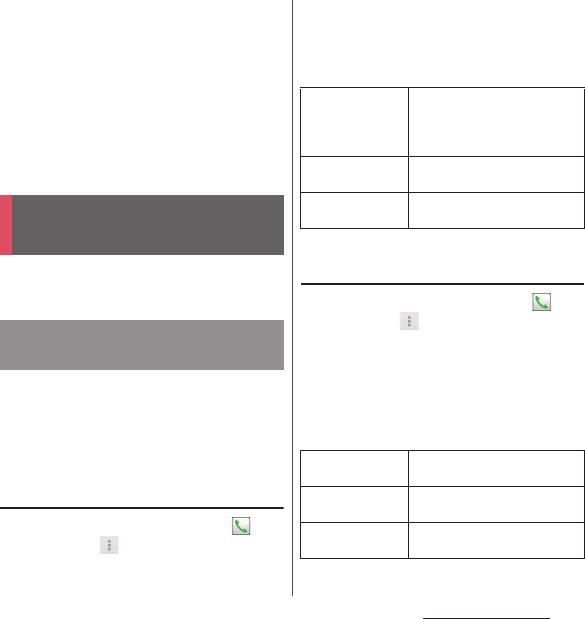
254
International roaming
・
Having someone make a call from other
than Japan to the country you stay.
You have to receive a call through Japan
no matter where you are; therefore, the
other party needs to enter the
international call access code and "81"
(Country code of Japan).
International access code - 81 - 90 (or 80)
- XXXX - XXXX
Make settings for using international
roaming or international calls.
Set restricting incoming calls overseas or
using roaming guidance.
・
For some overseas network operators,
settings may not be made.
Restricting incoming calls for
roaming
1
From the Home screen, tap ,
then tap .
2
Tap [Call settings]
u
[Roaming
settings].
3
Tap [Restricting incoming calls].
・
Select items you want to use.
Setting incoming notification on
roaming
1
From the Home screen, tap ,
then tap .
2
Tap [Call settings]
u
[Roaming
settings].
3
Tap [Incoming notification on
roaming].
・
Select items you want to use.
International roaming
settings
Settings for making/receiving
calls overseas
Activate restricting
Tap "Restricting all incomings" or
"Restricting incoming of video
call/64K data", enter the network
security code, and tap [OK].
Deactivate
restricting
Enter the network security code
and tap [OK].
Check settings
Check the current service
settings.
Activate incoming
call notification
Tap [OK] to activate roaming
incoming call notification.
Deactiv. incoming
call notification
Tap [OK] to deactivate roaming
incoming call notification.
Check settings
Check the current service
settings.
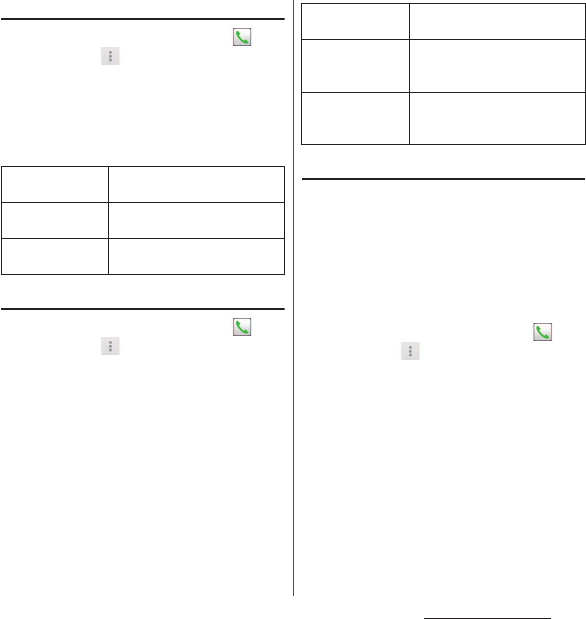
255
International roaming
Setting roaming guidance
1
From the Home screen, tap ,
then tap .
2
Tap [Call settings]
u
[Roaming
settings].
3
Tap [Roaming guidance].
・
Select items you want to use.
Setting international dial assistance
1
From the Home screen, tap ,
then tap .
2
Tap [Call settings]
u
[Roaming
settings].
3
Tap [International dial assist].
・
Select items you want to use.
Settings Network service (overseas)
Set network service such as voice mail from
overseas.
・
If you make the settings overseas, you are
charged a call fee to Japan from the country
you stay.
・
For some overseas network operators,
settings may not be made.
1
From the Home screen, tap ,
then tap .
2
Tap [Call settings]
u
[Roaming
settings].
3
Tap [Network service].
・
Select items you want to use. You need
to set "Remote operation" to activate
(P.102).
Activate roaming
guidance
Tap [OK] to activate roaming
guidance.
Deactivate
roaming guidance
Tap [OK] to deactivate roaming
guidance.
Check settings
Check the current service
settings.
Auto conversion
International prefix or country
code is automatically added.
Country code
Tap [OK] to select a country code
which will be used for auto
conversion.
International
prefix
Tap [OK] to select an
international prefix which will be
used for auto conversion.

256
International roaming
* Follow the voice prompts to operate.
Voicemail
(charged)
Activate
service
Tap [OK ].
*
Deactivate
service
Tap [OK ].
*
Play
messages
Tap [OK]. After this step,
follow the voice prompts
to play the message.
Settings
Tap [OK ].
*
Ring time
setting
Tap [OK ].
*
Incoming call notific.
(charged)
Tap [OK ].
*
Caller ID request
(charged)
Tap [OK ].
*
Roaming guidance
(charged)
Tap [OK ].
*
Remote operation
(charged)
Tap [OK ].
*
Call
forwarding
(charged)
Activate
service
Tap [OK ].
*
Deactivate
service
Tap [OK ].
*
Check
settings
Tap [OK ].
*

257
Appendix/Index
Appendix/Index
A variety of optional devices allows you to
expand the terminal's capabilities by
supporting a wide range of purpose,
including personal and business uses.
Some accessories are only available in some
areas.
For details, please contact a sales outlet such
as docomo Shop.
For details on optional devices, see the user's
manual of each device.
・
Back Cover SO22
・
Battery Pack SO09
・
Carry Case 02
・
Pocket charger 01/02
・
AC Adapter cable SO03
・
AC Adapter 03/04
・
DC Adapter 03
・
Desktop Holder SO17
・
AC Adapter Converter Plug TypeC 01
・
Micro USB Cable 01
・
Wireless Earphone Set 03
・
DriveNetCradle 01
・
L-03E
*
* Supports charger function to supply power
to the terminal.
・
First, check if the software update is necessary
for the terminal. If necessary, perform the
software update (P.269).
・
When checking the following items not to
improve the state, contact the phone number
given in "Repairs" the last page of this manual
(in Japanese only) or DOCOMO-specified
repair office.
■
Power supply
Cannot power on the terminal.
・
Check if the battery pack is installed
correctly.
→
P.32
・
Check if the battery is not run out.
→
P.32
■
Charging
Cannot charge the terminal.
(The notification LED does not turn on, or
the icon does not indicate charging
status.)
・
Check if the battery pack is installed
correctly.
→
P.32
・
Check if the adapter's power plug or
cigarette lighter plug is correctly inserted
to an outlet or cigarette lighter socket.
→
P.34
Optional and related
devices
Troubleshooting
Troubleshooting

258
Appendix/Index
・
Check if the adapter cable and the
terminal are set correctly.
→
P.34
・
When using the AC Adapter 04 (optional),
check if the microUSB plug of the AC
adapter is connected to the terminal or
supplied desktop holder correctly.
→
P.33,
P.34
・
In case of using the desktop holder, are
the terminal's contacts for the desktop
holder dirty? Clean the contacts with a dry
cotton swab etc. if they are dirty.
・
When using Micro USB Cable 01
(optional), check if the PC is turned on.
・
If you execute calls, communications or
other function operations for a long time
while charging, the terminal may become
hot and the notification LED turns off
(charging stops) or charging may not be
completed. In this case, wait until the
temperature of the terminal drops and
charge again.
The notification LED blinks in red and the
terminal cannot be operated.
・
When the battery level is low, charge the
battery pack.
→
P.32
■
Terminal operation
Become hot while operating/charging.
・
While calling, depending on the radio
wave condition or call duration time, the
terminal may become hot. This condition
is not abnormal.
・
While operating or charging, or if you
watch 1Seg, record video, etc. for a long
time while charging the battery pack, the
terminal, and adapter may become hot.
There is no problem about operation and
continue to use it.
The operation time provided by the
battery is short.
・
Is the terminal left for a long time under
the state of out of service area?
Out of service area, a lot of power is
consumed to search available radio
waves.
・
The operating time of the battery varies
depending on the operating
environment and the degradation level of
the battery pack.
→
P.32
・
The battery pack is a consumable
accessory. Each time it is charged, time
available with each charging reduces.
If the operation time is too short with fully
charged state, purchase a specified
battery pack.

259
Appendix/Index
Power discontinuity/rebooting occurs.
・
If terminals of battery pack is soiled,
connection gets worse and it may cause
power to be turned off. When it is soiled,
clean the terminals of the battery pack
with a dry cotton swab etc.
Operations are not possible when tapping
or pressing keys.
・
Check if the power is turned off.
→
P.36
・
Check if you activate the screen lock.
→
P.218
・
When you cannot cancel the screen lock
by flicking up or down (swipe) on the
unlock screen, Explore by touch of
TalkBack may be set to On. If Explore by
touch of TalkBack is enabled, flick (swipe)
the screen up or down with 2 fingers.
→
P.227
The screen reacts slowly when you tap or
press keys.
・
When large amount of data is saved in the
terminal or transferring large-size data
between the terminal and microSD card,
the reactions on the screen may be
delayed.
The docomo mini UIM card is not
recognized.
・
Check if the docomo mini UIM card is
attached in the right direction.
→
P.30
The clock is not on time.
・
The clock time may become wrong while
turning on the power for a long time.
Check if "Automatic date & time" and
"Automatic time zone" are set to on and
turn the power off and on in a place with
strong radio wave conditions.
→
P.225
The terminal operation is unstable.
・
Instability may be caused by applications
that you installed after purchasing the
terminal. If the symptom is improved
when you boot the terminal in safe mode
(near default state), uninstalling the
installed application may improve the
symptom.
To boot the terminal in safe mode, press
and hold
P
for over a second with the
terminal OFF until XPERIA logo appears,
and then touch and hold
m
at the
bottom. When safe mode is booted, "Safe
mode" is displayed at the lower left of the
screen.
To exit the safe mode, turn power OFF
and then ON.
With the power on, press
P
for over a
second, then touch and hold [Power off]
and tap [OK] to restart the terminal in Safe
mode.
* Back up the necessary data before using
safe mode.

260
Appendix/Index
* Some widgets that you created may be
removed.
* Safe mode is not a normal booting state.
To use ordinarily, exit the safe mode.
・
Developer options are designed for
developers. If you set them, the terminal
or applications may not be operated
correctly.
Applications cannot be operated properly
(applications cannot be activated, or
errors occur frequently).
・
Are there any applications being
disabled? Enable disabled applications,
then retry.
→
P.212
■
Phone call
Cannot make a call even if you press the
dial button.
・
Check if you activate the SIM card lock.
→
P.217
・
Check if you activate Airplane mode.
→
P.199
The ringtone does not sound.
・
Is the call alert volume of volume setting
set to silent?
→
P.205
・
Check if the silent mode is active.
→
P.41
・
Is the ring time for Voice Mail service or
Call Forwarding Service "0 Sec."?
→
P.101
・
Check if you set call rejection.
→
P.101
Calls are not connected.
(Even when moving, "
圏外
(out of service
area)" does not disappear, or although
radio waves are enough, making/
receiving calls is unavailable.)
・
Turn the power OFF and ON, or remove
and attach the battery pack or docomo
mini UIM card.
→
P.30, P.36
・
Due to the nature of radio waves, making/
receiving calls may be unavailable even
when "not out of service area" or "
appears on the display for the radio wave
condition". Move to the other place and
call again.
・
Due to the crossing of radio waves, at the
crowded public places, calls/mails are
crossed and the connection status may
not be good. Move to other place or call
again at other time.
■
Display
The display is dim.
・
Check if the backlight time-out is set.
→
P.208
・
Check if the brightness of screen is
changed.
→
P.207
・
Check if you set Power Saver.
→
P.210
・
Check if you cover the Proximity sensor
with sticker etc.
→
P.29
・
When the temperature of the terminal
becomes high while using, the display
may become darker. It is not abnormal.

261
Appendix/Index
■
Sound
During a voice call, the distant party's
voice is hard to listen to or too loud.
・
Check if the listening volume of the sound
volume setting is changed.
→
P.99
■
Display data
Images or ringtones set in each feature do
not work and the terminal operates in the
default data.
・
Is the inserted docomo mini UIM card the
same one that is set when the images or
ringtones are obtained?
■
Mail
Mail is not received automatically.
・
Check if you set "Inbox check frequency"
in Account settings to "Manual".
→
P.120
■
Camera
Still images and video taken with the
camera are blurred.
・
Check if clouds or dirt attach to the lens of
camera.
・
To shoot a portrait image, use the face
detection function.
→
P.169
・
Shoot using shake reducing function.
→
P.160, P.166
・
To shoot a close object, use "Superior
auto" for the capturing mode.
→
P.154
■
1Seg
Watching 1Seg is unavailable.
・
Are you out of terrestrial digital TV
broadcasting service area or in a place
where airwave is weak?
・
Is channel set?
→
P.144
■
Osaifu-Keitai
Osaifu-Keitai function is unavailable.
・
When removing the battery pack or
activating Omakase Lock, Osaifu-Keitai
functions are unavailable regardless of the
NFC/Osaifu-Keitai lock settings.
・
Check if NFC/Osaifu-Keitai is locked.
→
P.136
・
Check if you place mark of the terminal
over an IC card reader?
→
P.136
■
International roaming
Cannot use the terminal overseas.
■
When antenna mark is displayed
・
Do you subscribe WORLD WING?
Check if you subscribe WORLD WING.

262
Appendix/Index
■
Out of service area indicator appears
・
Check if you are out of the international
roaming service area or in an area with
poor signal strength. Check if the service
area and network operator are available,
referring to "Mobile Phone User's Guide
[International Services]" or DOCOMO
International Services website.
・
Change the network settings or overseas
network operator settings.
Set "Search mode" to "Automatic" in
"Service providers".
Set "Network Mode" to "LTE (preferred)/
WCDMA/GSM".
→
P.251
・
Turning off the terminal and then turning
on again may work for the restoration.
→
P.36
Cannot perform data communication
overseas.
・
Mark "Data roaming".
→
P.251
The terminal suddenly became
unavailable while using overseas.
・
Check if usage amount exceeds the limit
of maximum charges for use.
For use of "International roaming (WORLD
WING)", the limit of maximum charges for
use is set in advance. If exceeding the limit
of maximum charges for use, pay the
charges.
Cannot receive calls overseas.
・
Is "Restricting incoming calls" set to
"Activate restricting"?
→
P.254
No caller ID is notified/A notified caller ID
is different from that of the caller/
Functions for using contents saved in
phonebook or those using Caller ID
notification do not operate.
・
Even if a caller notifies its caller ID, it is not
displayed on the terminal unless the
network or network operator notifies it.
And a different caller ID may be notified
depending on the network or network
operator you use.
■
Data management
Data transfer is not performed.
・
Check if USB hub is used. If you use USB
hub, operations may not be performed
correctly.
Data saved in microSD card is not
displayed.
・
Remove the microSD card and insert it
again.
→
P.229
When trying to display an image, "
u
"
appears instead of it.
Or "
u
" appears for the demo play or the
preview function.
・
"
u
" may appear instead of destroyed
image data.

263
Appendix/Index
■
Bluetooth function
The terminal cannot be connected to a
Bluetooth communication device/A
Bluetooth communication device cannot
be found from the terminal.
・
Make Bluetooth communication device
(commercial item) registering stand-by
state and then register the device on the
terminal. If you delete already registered
device and register the device again as a
new device, delete the registrations on
both Bluetooth communication device
(commercial item) and the terminal and
then perform registration of the devices.
→
P.236
Calls cannot be made from the terminal
connecting to external device such as car
navigation or handsfree device.
・
If calls are made several times when the
other party does not answer or is out of
service, the call to this number may be
disabled. In this case, turn terminal off and
on.
■
Map/GPS
Cannot set AUTO-GPS service
information.
・
Check if the battery level is low and AUTO-
GPS function is stopped.
If AUTO-GPS is stopped by "Low-power
operation settings", AUTO-GPS service
information cannot be set. In this case, set
"Low-power operation settings" to "Not
suspend" or charge the battery.
→
P.32,
P.214
・
Check if "AUTO-GPS operation settings" is
marked.
→
P.214

264
Appendix/Index
●
No service
・
The terminal is out of service area, or the
received signal is too weak. Move to a
location where radio signal can be
reached.
・
The docomo mini UIM card is not working
properly.
Insert the docomo mini UIM card in
another terminal. If this works, it is
probably the terminal that is causing the
problem. In this case, contact "Repairs" on
the last page of this manual (in Japanese
only).
Removing and inserting docomo mini
UIM card may improve the problem.
●
Mobile network not available
Insert the docomo mini UIM card correctly
and move to a place where radio signal can
be reached (P.30).
●
Normal calls are restricted by access
control.
Appears when normal voice call service is
hard to receive because communication
lines are busy.
●
Emergency calls are restricted by access
control.
Appears when emergency voice call service
is hard to receive because communication
lines are busy.
●
Calls are restricted by access control
Appears when normal/emergency voice
call service is hard to receive because
communication lines are busy.
●
SIM card is locked
Enter your PIN code (P.217) correctly.
●
SIM card is PUK-locked
Enter your PUK (Personal Unblocking Key)
(P.217) correctly.
●
PIN lock disable code is locked.
PIN lock disable code is locked. Please
contact a docomo Shop.
●
The phone storage is full
There is no memory space. Delete log
information etc. in Browser (P.130) or
unnecessary applications (P.212) to obtain
memory space.
●
Memory full.
There is no memory space in microSD card.
Delete unnecessary data to save the
memory space (P.231).
Error messages
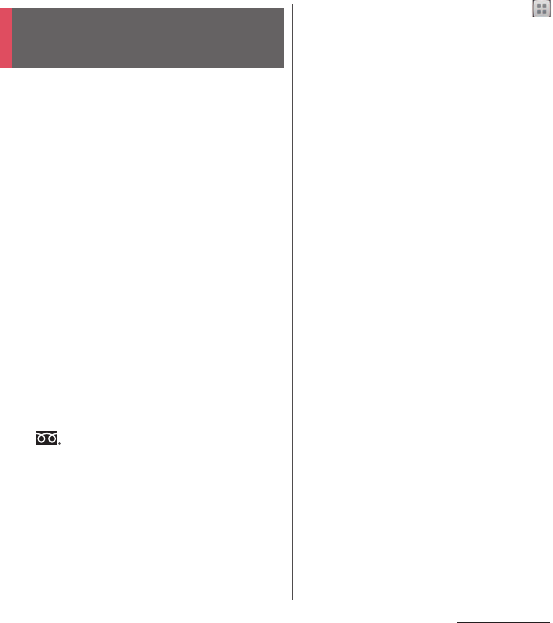
265
Appendix/Index
By sharing screens of your terminal with NTT
DOCOMO, you can receive technical support
to make settings (in Japanese only).
・
This service is not available when your
docomo mini UIM card is not inserted, during
international roaming, or in Airplane mode.
・
Smartphone Anshin Remote Support is a
service requiring subscription.
・
Some operations and settings are not
supported.
・
For details on Smartphone Anshin Remote
Support, refer to NTT DOCOMO website.
1
Call
スマートフォン遠隔サポートセン
ター
(Remote support center for
smartphone).
■
スマートフォン遠隔サポートセンター
(Remote support center for
smartphone)
0120-783-360
Business hours: 9:00 a.m. to 8:00 p.m.,
open all year round
2
From the Home screen, tap ,
then tap [
遠隔サポート
(Remote
support)].
・
When you use for the first time, agree to
"
ソフトウェア使用許諾書
(License
Agreement)".
3
Enter connection number notified
by DOCOMO.
4
Remote support starts when you
are connected.
Smartphone Anshin
Remote Support

266
Appendix/Index
・
Make sure that the warranty is received with
the terminal upon purchase. Check to be sure
that "
販売店名・お買い上げ日
(the name of the
retailer, date of purchase)", and other items
have been filled out on the warranty before
storing it in a safe place. If any necessary
information is not provided, immediately
contact the retailer and request to complete
the warranty. The terminal comes with a year's
free warranty starting from the date of
purchase.
・
Specifications of this product and its
accessories are subject to change for
improvement without prior notice.
・
Data saved in the Contacts etc. may be
changed/lost due to the trouble/repairs or
handling of the terminal. DOCOMO
recommends making a copy of the
Phonebook data etc., in case.
* You can save Phonebook data in a microSD
card inserted to the terminal.
* Data such as phonebook entries can be
backed up to Data center using Data Security
Service (subscription is required).
If you have problems with the
terminal
Before asking repair, see "Troubleshooting"
(P.257) in this manual to check the problem. If
the problem still persists, contact "Repairs"
on the last page (in Japanese only).
If repair is required resultingly
Bring the terminal to the DOCOMO-specified
repair office. However, it must be taken
during business hours of the repair office.
Make sure to bring a warranty card with the
product when you visit the shop. Note that
repair may take some days depending on the
problem.
■
Within the warranty period
・
We repair the terminal free of charge
based on the terms documented in the
warranty.
・
When requesting a repair, make sure to
bring the warranty card with the terminal.
Repair requests that are not accompanied
by the warranty or that involve
malfunction and damage due to incorrect
handling by the owner (damage of liquid
crystal, connector, etc.) will only be
repaired at the owner's expense, even if
the warranty period is still effective.
Warranty and After Sales
Services
Warranty
After Sales Services

267
Appendix/Index
・
Malfunction due to use of devices and
consumable parts other than those
specified by DOCOMO will only be
repaired at the owner's expense, even if
the warranty period is still effective.
■
Note that repair may be refused in the
following cases:
・
When the terminal has corrosion due to
wet by liquid, condensation, perspiration,
etc. or the internal circuit board is
damaged or deformed (we may not be
able to repair when the microUSB jack,
headset jack, liquid crystal, etc. is
damaged or the frame itself is cracked)
based on the result of our examination.
- Even if repair is possible, it will be done
at the owner's expense, as this type of
corrosion or damage is not covered by
the warranty.
■
If the warranty period expires
We will repair the terminal at the owner's
expense.
■
Parts stock period
The functional parts necessary to repair the
terminal will be basically available for a
minimum of 4 years after the manufacture is
discontinued.
However, depending on the defective
portion, repair may not be possible because
of a shortage of repair parts. Note that repair
may still be possible depending on the
defective portion even if the stock period
has expired. Contact "Repairs" on the last
page (in Japanese only).
Precautions
●
Never modify the terminal or accessories.
・
Doing so may result in fire, injuries or
malfunctions.
・
The modified terminal may be repaired
only if the owner agrees on that all the
modified parts are restored to the original
conditions.
However, repairs may be refused
depending on the modifications.
The following cases may be considered as
modifications.
- Put a seal etc. on the liquid crystal or key
part.
- Glued decorations on the terminal using
adhesion bond, etc.
- Change the parts such as exterior to
other than DOCOMO standard parts.

268
Appendix/Index
・
Malfunction and damage due to
modifications will be repaired at the
owner's expense, even if the warranty
period is still effective.
●
Do not remove the inscription sticker on
the terminal.
・
Note that if the inscription sticker is
removed or is replaced with a different
sticker, it may disqualify the terminal from
repairs.
●
Note that the settings and other
information may be reset (cleared) as a
result of malfunction, repair or other
handling. In this case, make the settings
again.
●
After the repair, Wi-Fi MAC address or
Bluetooth address may be changed
regardless of the repaired parts.
●
A material that generates a magnetic field
is used in the following parts of the
terminal.
Do not hold an object that is easily
affected by magnetism, such as a cash
card, close to the terminal. You may not
be able to use the card any more.
Where it is used: Speaker, earpiece
●
The terminal is waterproof. If inside of the
terminal gets wet or moist, however, turn
the power off, remove the battery pack,
then bring the terminal to a repair office as
soon as possible. However, repair may not
be possible depending on the condition of
the terminal.
Precautions on memory dial
(Phonebook function) and
downloaded data
Note that data you created or data you
retrieved or downloaded from sources other
than your terminal may be changed or lost
when you change the model or have repairs
done to the terminal. DOCOMO shall have no
liability for any change or loss of any kind.
Under some circumstances, DOCOMO may
replace your terminal with its equivalent
instead of repairing it.

269
Appendix/Index
It is a function to connect network to check if
software update for SO-01F is required, then
update software if required. You can check if
software update is required on NTT
DOCOMO, INC. website.
・
There are following 3 methods for software
update.
- Automatic Update : Update file is
downloaded automatically and write it at
the set time. When the rewrite start time is
not set, software is automatically rewritten
between 2 a.m. and 5 a.m.
- Immediate Update : Update immediately.
- Reserved Update : Update at the reserved
time automatically.
❖
Information
・
Software update can be done even when various
data, such as phonebook entries registered in
terminal, images, mails, downloaded data, are
remaining; note that data protection sometimes
cannot be secured according to the conditions of
your terminal (such as malfunction, damage, or water
leak). DOCOMO recommends backing up necessary
data. However some data such as downloaded data
may not be backed up.
When updating software
・
Do not remove the battery pack while
updating software. The update may fail.
・
Software update should be done with battery
fully charged. You are recommended to
connect charging cable when updating
software.
・
Software cannot be updated in the following
cases.
-During a call
- When
圏外
(out of service area) is displayed
*
- During international roaming
*
- Airplane mode
*
- When date and time are not set correctly
- When the remaining battery is not sufficient
for software update
- When the available memory of the terminal
is not sufficient for software update
* When the terminal is out of service area or during
international roaming, updating software is not
available even though you are connected via Wi-
Fi.
・
Software update (downloading or rewriting)
may take time.
・
Making/Receiving calls, communications
functions and other functions are disabled
during software update. Only incoming calls
can be answered while downloading.
・
Stay in a place with strong radio wave
condition when updating software. Software
update may be canceled if the radio wave
condition is not good enough.
Updating software
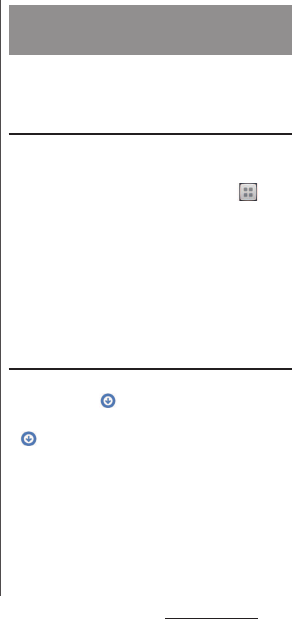
270
Appendix/Index
・
If software update is not needed, "No update
is needed." appears.
・
During international roaming or when the
terminal is out of service area, "When docomo
network is not available, or during roaming,
software update is not available even if Wi-Fi is
connected." or "When docomo network is not
available, or during roaming, install cannot be
started even if Wi-Fi is connected." appears.
The same messages appear even while
connecting via Wi-Fi.
・
SMS sent during software update is stored in
the SMS center.
・
When updating software, your private
information concerning SO-01F (model, serial
number, etc.) is automatically sent to the
server for software update managed by
DOCOMO. DOCOMO does not use the sent
information for purposes except software
update.
・
When software update has failed, the terminal
may not activate or "Update failed." appears
and all operations may become unavailable.
In that case, please bring the terminal to
DOCOMO-specified repair office.
・
While updating software, do not activate
other applications.
Update file is automatically downloaded and
software is updated at the specified time.
Automatic update setting
・
The settings of Software Update is set to
"Automatic Update" by default.
1
From the Home screen, tap and
tap [Settings]
u
[About
phone]
u
[Software Update].
2
Tap [Configure the software
update].
3
Tap [Automatic Update]/[Manual
Update].
When software update is necessary
If the update file is downloaded
automatically, appears on the status bar.
・
When the rewrite start time is reached with
displayed, software is automatically
rewritten. When the rewrite start time is not
set, software is automatically rewritten
between 2 a.m. and 5 a.m.
1
Drag the status bar to tap
notification of Software update.
・
Rewriting time appears.
Updating software
automatically
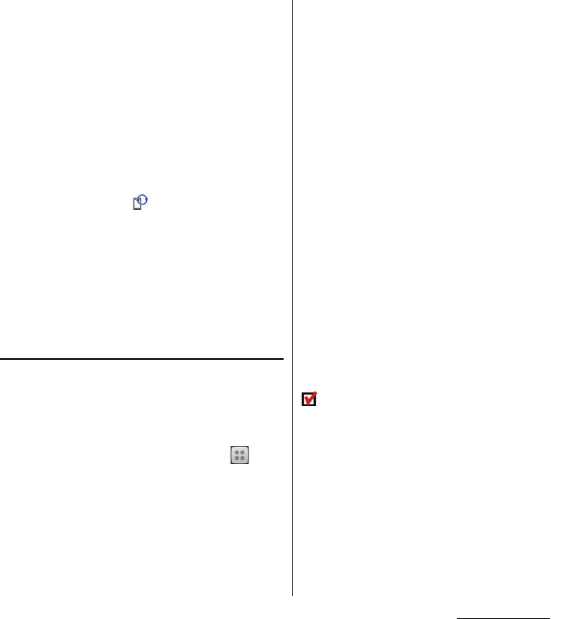
271
Appendix/Index
2
Perform a target operation.
・
[OK] : Go to the Home screen. Updating
starts when the preset time is reached.
・
"Set Time" : Reserved update
→
"Reserving software update" (P.272)
・
"Start update" : Update immediately
→
"Updating software immediately"
(P.271)
❖
Information
・
If the software is not updated when the update
notification is received, appears on the status bar
to notify.
・
If software update at the preset time could not be
performed, the software update will be performed at
the same time the following day.
・
Software cannot be updated automatically when the
Auto-update setting is set to "Manual Update" or
while updating software by Now update.
Updating software immediately
Software update starts immediately.
・
There are 2 ways to activate software update:
activating from Software update notice
screen and activating from the menu.
1
From the Home screen, tap and
tap [Settings]
u
[About
phone]
u
[Software Update].
2
[Start the software update]
u
Tap
[Yes].
・
For activating from Software update
notice screen, display the Software
update notice screen and tap [Start
update].
・
"Ready for update. Please refrain from
starting other application." is displayed,
then rewriting starts automatically. Tap
[OK] to start rewriting automatically.
・
While updating the software, all key
operations become disabled. Also,
updating cannot be canceled.
・
When the software update is complete,
the terminal restarts and the Home
screen is displayed.
❖
Information
・
If software update is not needed, "No update is
needed." is displayed.
■
Post-update display
appears on the status bar. Drag the status
bar downwards and tap the notification, a
message indicating that software update is
complete appears.

272
Appendix/Index
Reserving software update
You can preset time to update the software if
you want to specify another time for
installing the update file.
1
Display the Software update
notice screen
u
Tap [Set Time].
2
Set a time
u
Tap [Set].
■
When the reserved time is reached
When the reserved time is reached, "Ready
for update. Please refrain from starting other
application." appears, then rewriting starts
automatically.
❖
Information
・
While updating the software, all key operations
become disabled and updating cannot be canceled.
・
If software update could not be started at the preset
time, the software update will be performed at the
same time the following day.
・
When an alarm etc. is set at the same time as the
reserved time, priority will be given to the software
update.
・
If SO-01F is turned OFF at the reserved time, the
software update starts at the same time as the
reserved time after the terminal is turned ON.
・
If (Software update was suspended Please check
the remaining internal storage capacity and retry.)
appears on the status bar during software update,
make sure that sufficient memory remains on the
phone memory and retry to update.
・
If (Software update was suspended Please check
the status of the handset and retry.) appears on the
status bar during software update, make sure that
the terminal is not in the following states and retry to
update.
-No signal
- The battery pack is removed
- Interfered by some function
You can update software by using PC
Companion that can be installed into a PC
from the terminal.
❖
Information
・
To install PC Companion on a PC, an Internet
connection is required.
When PC Companion is not installed
on your PC
1
Connect the terminal to a PC using
a microUSB cable.
2
When "PC Companion software"
screen appears on the terminal,
tap [Install].
・
Installer of PC Companion starts on the
PC.
Connecting to a PC and
updating
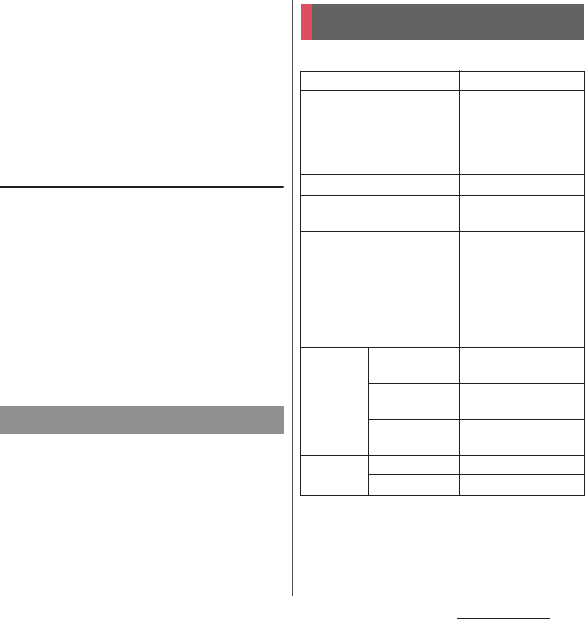
273
Appendix/Index
3
Follow the onscreen instructions
on the PC to install.
・
PC Companion starts on the PC after
the installation is complete. If further
software update is searched, it is
automatically notified. Follow the
onscreen instructions on the PC.
When PC Companion is installed on
your PC
1
Check if PC Companion is activated
on the PC. If not, activate PC
Companion from the Start menu.
2
Connect the terminal to a PC using
a microUSB cable.
3
Follow the onscreen instructions
on the PC.
・
If available software update is found, it
is automatically notified.
If software update is failed and the terminal
does not boot, restore the terminal by
performing restoration using PC Companion.
・
For restoration details, see FAQ in the
following website.
http://www.sonymobile.co.jp/support/ (In
Japanese only)
■
The terminal
When software update is failed
Main specification
Product name
SO-01F
Size
Approx. 131mm (H)
u
approx. 67mm (W)
u
approx. 10.5mm (T)
(thickest part approx.
10.5mm)
Weight
Approx. 141g
Storage
ROM 32GB
RAM 2GB
External storage
microSD card of up to
2GB
microSDHC card of up
to 32GB
microSDXC card of up
to 64GB (as of April,
2013)
Continuous
stand-by
time
FOMA/3G
Approx. 420 hours
(stationary)
GSM
Approx. 360 hours
(stationary)
LTE
Approx. 390 hours
(stationary)
Continuous
call time
FOMA/3G
Approx. 630 min.
GSM
Approx. 570 min.

274
Appendix/Index
Charging
time
AC Adapter 04
Approx. 160 min. (for
Desktop Holder SO17
combination use :
approx. 150 min.)
AC Adapter 03
Approx. 210 min. (for
Desktop Holder SO17
combination use :
approx. 210 min.)
DC Adapter 03
Approx. 230 min.
1Seg watching time
Approx. 320 min.
Mobacas watching time
Approx. 250 min.
Display Type
TFT16,777,216 colors
Size
Approx. 4.6 inch
Number of dots
Horizontal 720 dots
u
Vertical 1280 dots
Image
pickup
device
Type
Camera : Backside-
illuminated CMOS
Front camera : CMOS
Size
Camera : 1/3.0 inch
Front camera :
1/13.0 inch
Camera pixels
Camera :
Effective pixels :
Approx. 13,100,000
pixels (Recorded pixels
: Approx. 13,000,000
pixels)
Front camera :
Effective pixels :
Approx. 310,000 pixels
(Recorded pixels :
Approx. 310,000 pixels)
Digital zoom
Camera :
Max. approx. 16.0x (41
levels)
Front camera :
―
Still image capture size
Camera :
4128
u
3096 (13MP
4:3)
*1
3920
u
2940 (12MP
4:3)
*2
3920
u
2204 (9MP 16:9)
2592
u
1944 (5MP 4:3)
1920
u
1080 (2MP 16:9)
640
u
480 (VGA 4:3)
Front camera :
640
u
480 (VGA)
Video recording size
Video camera :
1920
u
1080 (Full HD
16:9)
1280
u
720 (HD 16:9)
640
u
480 (VGA 4:3)
Front video camera :
640
u
480 (VGA 4:3)
320
u
240 (QVGA 4:3)
Frame rate
Max. 30 fps
Wireless LAN
Compliant with
IEEE802.11a/b/g/n
(Corresponding
frequency band to
IEEE802.11n : 2.4GHz/
5GHz)

275
Appendix/Index
*1 The figures are image capture sizes when the
capturing mode is set to other than "Superior auto",
other than "Backlight correction HDR" for "Scene
selection", or "Off" for "HDR" in "Normal".
*2 The figures are image capture sizes when the
capturing mode is set to "Superior auto", "Backlight
correction HDR" for "Scene selection", or "On" for
"HDR" in "Normal".
*3 It is confirmed that the terminal and all Bluetooth
devices are compliant with Bluetooth standards
designated by Bluetooth SIG, and they are
authenticated. However, procedures may differ or
data transfer may not be possible depending on the
device's characteristics or specifications.
*4 May vary by the signal status and/or whether there
is an interference between communications
devices.
*5 Bluetooth standards for Bluetooth device
connection procedure according to the product's
applications.
・
Continuous call time is an estimate of the
operation time for calling when radio signal
reception is normal.
・
Continuous stand-by time is an estimate of
the stand-by time when radio signal
reception is normal. Stationary continuous
stand-by time is the estimated average
operation time when radio signal reception is
normal.
In certain circumstances, the stand-by time
may drop to as low as half the time shown
due to the battery charge, function settings,
temperature, or radio signal reception in the
area (no reception or weak).
・
A use of the Internet reduces the actual call
(communication)/stand-by time.
Composing messages or activating the
camera or applications also reduces call
(communication)/stand-by time even if you
do not call or use the Internet.
・
Charging time is an estimate of the time
required to charge a completely empty
battery pack. Charging under low
temperature requires longer time.
■
Battery pack
Bluetooth Supported
Bluetooth
version
Compliant with
Bluetooth standard
Ver. 4.0
*3
Radio power
Bluetooth standard
Power Class 1
Available
communication
distance
*4
Within approx. 10 m
Supported
Bluetooth
profile
*5
H F P, H S P, O P P, S P P, H I D ,
A2DP, AVRCP, PBAP,
H D P, P X P, M A P, D I D
Headset
jack
Size
Diameter 3.5 mm
Number of pole
Tetrapolar
Battery type
Lithium Ion Battery
Voltage
DC3.7V
Current
2300 mAh

276
Appendix/Index
■
File format
The terminal supports the display or
playback of the following file format:
* Still images are saved in JPEG format when shot with
Camera in the terminal.
■
Numbers of still images (Estimation)
* Shot images with a resolution of 640
u
480 (VGA).
■
Time length of shooting video
(Estimation)
* Time of recording with a resolution of 640
u
480
(VGA).
Type File format
Sound
WAV (PCM, G.711) (.wav), AAC (.3gp, .m4a,
.mp4), AAC+ (.3gp, .m4a, .mp4), eAAC+
(.3gp, .m4a, .mp4), MP3 (.mp3), AMR-NB
(.3gp), AMR-WB (.3gp), MIDI (SP-MIDI/GM/
GML (.mid), XMF (.xmf), Mobile XMF 1.0
(.mxmf ), RTTTL/RTX (.rtttl, .rtx), OTA (.ota),
iMelody (.imy)), Ogg Vorbis (.ogg), FLAC
(.flac), PIFF (.isma)
Still
image
*
JPEG (.jpeg, .jpg), GIF (.gif ), PNG (.png), BMP
(.bmp), WEBP (.webp)
Video
H263 (.3gp, .3gpp, .mp4, .m4v), H264 (.3gp,
.3gpp, .mp4, .m4v), MPEG4 (.3gp, .3gpp,
.mp4, .m4v), VP8 (.webm, .mkv), Xvid (.avi,
.xvid, .mkv, .3gp, .3gpp, .mp4, .m4v), WebM
(.webm), AVI (.avi), PIFF (.ismv)
Savable number
of shot images to
the internal
storage
Up to approx. 1,002,800 images
Savable number
of shot images to
a microSD card
(1GB)
Up to approx. 41,940 images
Savable time of
recording to the
internal storage
Per video : Up to approx. 254 min.
In total : Up to approx. 1,610 min.
Savable time of
recording to a
microSD card
(1GB)
Per video : Up to approx. 63 min.
In total : Up to approx. 63 min.

277
Appendix/Index
■
Display language
Japanese/Indonesian/Malay/Sundanese/
Bosnian/Catalan/Czech/Danish/German
(Germany)/German (Liechtenstein)/
German (Austria)/German (Switzerland)/
Esthonian/English (Australia)/English
(Canada)/English (Hong Kong)/English
(India)/English (Ireland)/English (Jamaica)/
English (New Zealand)/English
(Philippines)/English (Singapore)/English
(South Africa)/English (United Kingdom)/
English (United States)/Spanish
(Argentina)/Spanish (Bolivia)/Spanish
(Chile)/Spanish (Colombia)/Spanish (Costa
Rica)/Spanish (Ecuador)/Spanish (El
Salvador)/Spanish (Spain)/Spanish (United
states)/Spanish (Guatemala)/Spanish
(Honduras)/Spanish (Mexico)/Spanish
(Nicaragua)/Spanish (Panama)/Spanish
(Paraguay)/Spanish (Peru)/Spanish (Puerto
Rico)/Spanish (Dominican Republic)/
Spanish (Uruguay )/Spanish (Venezuela)/
Basque/French (Belgique)/French
(Canada)/French (France)/French
(Switzerland)/Galician/Croatia/Icelandic/
Italian (Italy)/Italian (Switzerland)/Javanese/
Latvian/Lithuanian/Hungaria/Dutch
(Belgium)/Dutch (Netherlands)/
Norwegian/Polish/Portuguese (Brazil)/
Portuguese (Portugal)/Romanian/Albanian/
Slovak/Slovene/Serbian/Finnish/Swedish/
Tagalog/Vietnamese/Turkish/Greek/
Bulgar/Kazakh/Macedonian/Russian/
Ukrainian/Hindu/Bengalee (Bangladesh)/
Bengalee (India)/Thai/Korean/Telugu/
Kannada/Malayalam/Marathi/Tamil/
Chinese (Traditional)/Chinese (Simplified)/
Chinese (Hong Kong)
■
Text language (Character entry)
Arabic/Icelandic/Albanian/Italian/
Indonesian/Anglo-Indian/Ukrainian/
Esthonian/Dutch/Kazakh/Catalan/Galician/
Greek/Croatian/Javanese/Swedish/
Spanish/Slovak/Slovene/Sundanese/
Serbian/Thai/Tagalog/Czech/Danish/
German/Norwegian/Basque/Hungarian/
Finnish/French/Bulgarian/Vietnamese/
Hebrew word/Persian/Polish/Bosnian/
Portuguese/Macedonian/Malay/Latvian/
Lithuanian/Romanian/Russian/Tamil/
Turkish/Hindu/English/Chinese
(Traditional)/Chinese (Simplified)/Japanese
Language

278
Appendix/Index
■
Text language ( Voice input)
Japanese/Icelandic/Afrikaans/Arabic
(United Arab Emirates)/Arabic (Israel)/
Arabic (Egypt)/Arabic (Qatar)/Arabic
(Kuwait)/Arabic (Saudi Arabia)/Arabic
(Jordan)/Arabic (Lebanon)/Arabic (Bahrain)/
Arabic (Oman)/Arabic (Palestine)/Italian/
Greek/Indonesian/Dutch/Catalan/Galician/
Swedish/isiZulu/Spanish (United States)/
Spanish (Argentina)/Spanish (Uruguay)/
Spanish (Ecuador)/Spanish (El Salvador)/
Spanish (Guatemala)/Spanish (Costa Rica)/
Spanish (Colombia)/Spanish (Spain)/
Spanish (Chile)/Spanish (Dominican
Republic)/Spanish (Nicaragua)/Spanish
(Panama)/Spanish (Paraguay)/Spanish
(Puerto Rico)/Spanish (Venezuela)/Spanish
(Peru)/Spanish (Bolivia)/Spanish (Hondura)/
Spanish (Mexico)/Slovak/Serbian/Czech/
German/Turkish/Norwegian/Hungarian/
Finnish/French/Bulgarian/Hebrew word
(Israel)/Polish/Portuguese (Brazil)/
Portuguese (Portugal)/Latin/Malay/
Romanian/Russian/English (United States)/
English (United Kingdom)/English (India)/
English (Australia)/English (Canada)/English
(New Zealand)/English (South Africa)/
English (standard)/Chinese, standard
(Taiwan, Traditional)/Chinese, standard
(Hong Kong, Simplified)/Chinese,
Cantonese (Hong Kong Traditional)/
Chinese, standard (China, Simplified)/
Korean
You can check details of certificate and
compliance mark specific to the terminal
(including certificate number/compliance
number).
1
From the Home screen, tap ,
then tap [Settings].
2
Tap [About phone]
u
[Legal
information]
u
[Certificates].
Certificate and compliance

279
Appendix/Index
Software delivered with this device and its
media is owned by Sony Mobile
Communications AB, and/or its affiliated
companies and its suppliers and licensors.
Sony Mobile grants you a non-exclusive
limited licence to use the Software solely in
conjunction with the Device on which it is
installed or delivered. Ownership of the
Software is not sold, transferred or otherwise
conveyed.
Do not use any means to discover the source
code or any component of the Software,
reproduce and distribute the Software, or
modify the Software. You are entitled to
transfer rights and obligations to the
Software to a third party, solely together with
the Device with which you received the
Software, provided the third party agrees in
writing to be bound by the terms of this
Licence.
This licence exists throughout the useful life
of this Device. It can be terminated by
transferring your rights to the Device to a
third party in writing.
Failure to comply with any of these terms and
conditions will terminate the licence
immediately.
Sony Mobile and its third party suppliers and
licensors retain all rights, title and interest in
and to the Software. To the extent that the
Software contains material or code of a third
party, such third parties shall be beneficiaries
of these terms.
This licence is governed by the laws of
Sweden. When applicable, the foregoing
applies to statutory consumer rights.
In the event Software accompanying or
provided in conjunction with your device is
provided with additional terms and
conditions, such provisions shall also govern
your possession and usage of the Software.
End User Licence
Agreement
End User Licence Agreement

280
Appendix/Index
This product includes certain open source or
other software originating from third parties
that is subject to the GNU General Public
License (GPL), GNU Library/Lesser General
Public License (LGPL) and different and/or
additional copyright licenses, disclaimers and
notices. The exact terms of GPL, LGPL and
some other licenses, disclaimers and notices
are reproduced in the about box in this
product and are also available at http://
opensource.sonymobile.com.
Sony Mobile offers to provide source code of
software licensed under the GPL or LGPL or
some other open source licenses allowing
source code distribution to you on a CD-ROM
for a charge covering the cost of performing
such distribution, such as the cost of media,
shipping and handling, upon written request
to Sony Mobile Communications AB, Open
Source Software Management, Nya
Vattentornet, SE-221 88 Lund, Sweden. This
offer is valid for a period of three (3) years
from the date of the distribution of this
product by Sony Mobile.
This product and its accessories may be
covered and controlled by Japan's export
control regulations ("Foreign Exchange and
Foreign Trade Law" and related laws and
regulations). If you wish to export this
product and/or its accessories, you must
complete the necessary procedures at your
own responsibility and cost. For details about
the procedure, contact the Ministry of
Economy, Trade and Industry.
About Open Source
Software
About Open Source Software
Export Controls and
Regulations
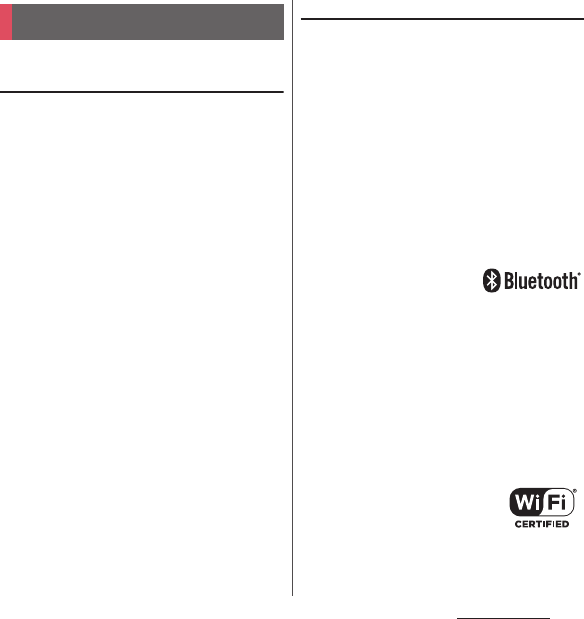
281
Appendix/Index
About the Copyright and Portrait
rights
Copyrighted contents you recorded or
obtained from sites or Internet home pages
using this product by downloading or other
means, such as documents, images, music
data, software, are prohibited from
reproduction, transformation and
transmission over public lines without
consent of the copyright holders, unless
intended for personal use or any other
purpose permitted by law.
Note that some performances, shows, and
exhibitions may not allow photography,
movie shooting, or sound recording even for
personal use.
You should also refrain from taking a picture
of other people and disclosing it by such
means as posting it on a site on the Internet
without their consent because of possible
infringement of their right of portrait.
Trademarks
The company names and product names
appearing in this manual are trademarks or
registered trademarks of their respective
holders.
・
"FOMA", "i-mode", "i-
D
ppli", "Deco-mail", "sp-
mode", "WORLD WING", "WORLD CALL",
"ToruCa", "mopera", "mopera U", "iD", "Xi", logo
of "sp-mode", logo of "ToruCa", logo of "iD"
and logo of "Xi" are trademarks or registered
trademarks of NTT DOCOMO, INC.
・
"Bluetooth" is a registered trademark of
Bluetooth SIG. Inc., and Sony Mobile
Communications is licensed to use them.
・
iWnn of OMRON SOFTWARE Co., Ltd. is used
for conversion methods for Japanese
language.
iWnn
©
OMRON SOFTWARE Co., Ltd. 2008-
2013 All Rights Reserved.
・
"Wi-Fi" is a registered trademark of Wi-Fi
Alliance.
・
Wi-Fi Protected Setup and Wi-Fi Protected
Setup logos are registered trademarks of Wi-Fi
Alliance.
・
"Catch Phone (Call waiting service)" is a
registered trademark of Nippon Telegraph
and Telephone Corporation.
Intellectual Property Right
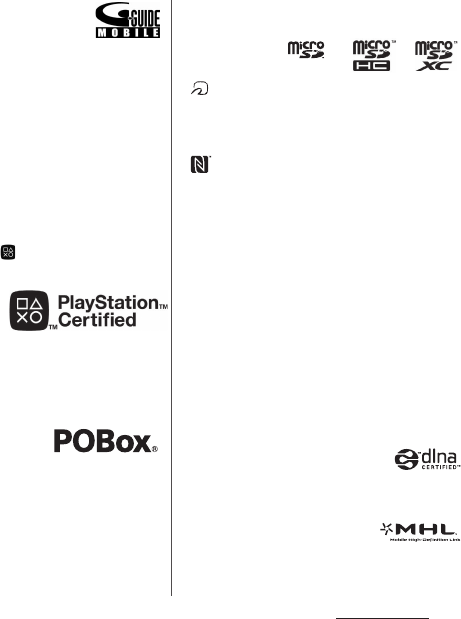
282
Appendix/Index
・
Rovi, G-GUIDE, G-GUIDE MOBILE
and their logos are trademarks or
registered trademarks in Japan of
U.S. Rovi Corporation and/or its affiliates.
・
"
モバキャス
" is a trademark of Japan
Mobilecasting, Inc.
・
"NOTTV" is a trademark of mmbi, Inc.
・
"Xperia"and "TrackID" are trademarks or
registered trademarks of Sony Mobile
Communications AB.
・
"Media Go" is a trademark or registered
trademark of Sony Media Software and
Services.
・
"PlayStation" and " " are trademarks or
registered trademarks or Sony Computer
Entertainment
Inc.
・
"BRAVIA", "Sony", "Sweep Panorama",
"WALKMAN", "xLOUD", "FeliCa", "Reader" and
"Clear Phase" are trademarks or registered
trademarks of Sony Corporation.
・
"POBox" and "POBox"
logo are registered
trademarks of Sony
Computer Science Laboratories, Inc.
"POBox" is a co-developed technology of
Sony Computer Science Laboratories, Inc. and
Sony Mobile Communications, Inc.
・
microSD logo, microSDHC logo and
microSDXC logo are trademarks of SD-3C, LLC.
・
is a registered trademark of FeliCa
Networks, Inc.
・
FeliCa is a contactless IC card technology
developed by Sony Corporation.
・
is a trademark or registered trademark of
NFC Forum, Inc. in the US and other countries.
・
"Twitter" is a trademark or registered
trademark of Twitter, Inc.
・
"Google" and "Google" logo, "Android" and
"Android" logo, "Google Play" and "Google
Play" logo, "Google+", "Gmail", "mobile Google
Maps", "Google Talk", "Google Latitude",
"Google Calendar", "YouTube" and "YouTube"
logo and "Picasa" are trademarks or registered
trademarks of Google, Inc.
・
Facebook and Facebook logo are trademarks
or registered trademarks of Facebook, Inc.
・
mixi and mixi logo are registered trademarks
of mixi, Inc.
・
"DLNA" and "DLNA" logo are
trademarks or registered
trademarks of the Digital Living Network
Alliance.
・
MHL, Mobile High-Definition
Link and MHL logo are
trademarks or registered trademarks of MHL,
LLC.

283
Appendix/Index
・
MHL, HDMI logo and High-
Definition Multimedia Interface are
trademarks or registered trademarks of HDMI
Licensing LLC.
・
"Microsoft", "Windows", "Outlook", "Windows
Vista", "Windows Server", "Windows Media",
"PlayReady" and "ActiveSync" are trademarks
or registered trademarks of Microsoft
Corporation in the United States and other
countries.
・
This product contains technology subject to
certain intellectual property rights of
Microsoft. Use or distribution of this
technology outside of this product is
prohibited without the appropriate license(s)
from Microsoft.
・
Content owners use Microsoft PlayReady
content access technology to protect their
intellectual property, including copyrighted
content. This device uses PlayReady
technology to access PlayReady-protected
content and/or WMDRM-protected content.
If the device fails to properly enforce
restrictions on content usage, content owners
may require Microsoft to revoke the device's
ability to consume PlayReady-protected
content. Revocation should not affect
unprotected content or content protected by
other content access technologies. Content
owners may require you to upgrade
PlayReady to access their content. If you
decline an upgrade, you will not be able to
access content that requires the upgrade.
・
This product is licensed under the MPEG-4
visual and AVC patent portfolio license for the
personal and non-commercial use of a
consumer for (i) encoding video in
compliance with the MPEG-4 visual standard
("MPEG-4 video") or the AVC standard ("AVC
video") and/or (ii) decoding MPEG-4 or AVC
video that was encoded by a consumer
engaged in a personal and non-commercial
activity and/or was obtained from a video
provider licensed by MPEG LA to provide
MPEG-4 and/or AVC video. No license is
granted or shall be implied for any other use.
Additional information including that relating
to promotional, internal and commercial uses
and licensing may be obtained MPEG LA,
L.L.C. (See http://www.mpegla.com ). MPEG
Layer-3 audio decoding technology licensed
from Fraunhofer IIS and Thomson.
・
Other product and company names
mentioned herein may be the trademarks of
their respective owners.
In context, TM and
®
mark are omitted.
・
Any rights not expressly granted herein are
reserved. All other trademarks are property of
their respective owners.

284
Appendix/Index
This terminal supports SIM unlock. If you
release SIM lock, you can use SIM by a carrier
other than NTT DOCOMO.
・
The SIM unlock service is provided at a
docomo Shop.
・
A SIM unlock charge is separately required.
・
If you use a SIM other than by DOCOMO, LTE
system is not available. Available services and
functions will be limited. DOCOMO is not
liable to any failures or malfunctions.
・
For details of SIM unlock, refer to NTT
DOCOMO website.
SIM unlock

285
Appendix/Index
A
About phone
・・・・・・・・・・・・・・・・・・・・・・・・ 228
Access point
Initializing
・・・・・・・・・・・・・・・・・・・・・・・・・ 205
Setting
・・・・・・・・・・・・・・・・・・・・・・・・・・・・ 204
Accessibility
・・・・・・・・・・・・・・・・・・・・・・・・・ 227
Account
Auto-sync
・・・・・・・・・・・・・・・・・・・・・・・・・ 226
Removing
・・・・・・・・・・・・・・・・・・・・・・・・・ 225
Setting
・・・・・・・・・・・・・・・・・・・・・・・・・・・・ 223
Adjusting sound volume
・・・・・・・・・・・・・・・ 206
Airplane mode
・・・・・・・・・・・・・・・・・・・・・・・ 200
Alarm & clock
・・・・・・・・・・・・・・・・・・・・・・・・ 188
Setting alarm
・・・・・・・・・・・・・・・・・・・・・・ 189
Album
・・・・・・・・・・・・・・・・・・・・・・・・・・・・・・ 174
Application
・・・・・・・・・・・・・・・・・・・・・・・・ 51, 91
Adding to Home screen
・・・・・・・・・・・・・・・ 55
List
・・・・・・・・・・・・・・・・・・・・・・・・・・・・・・・・ 51
Search
・・・・・・・・・・・・・・・・・・・・・・・・・・・・・ 51
Searching
・・・・・・・・・・・・・・・・・・・・・・・・・・ 94
Sharing
・・・・・・・・・・・・・・・・・・・・・・・・・・・・ 56
Sorting
・・・・・・・・・・・・・・・・・・・・・・・・・・・・ 51
Uninstalling
・・・・・・・・・・・・・・・・・・・・・・・・・ 55
Application button
・・・・・・・・・・・・・・ 48, 51, 91
Application screen
・・・・・・・・・・・・・・・・・・ 51, 91
Adding
・・・・・・・・・・・・・・・・・・・・・・・・・・・・ 51
Folder
・・・・・・・・・・・・・・・・・・・・・・・・・・・・・ 56
Groups
・・・・・・・・・・・・・・・・・・・・・・・・・・・・ 93
Recommends
・・・・・・・・・・・・・・・・・・・・ 91, 94
Switching
・・・・・・・・・・・・・・・・・・・・・・・ 51, 94
Application update
・・・・・・・・・・・・・・・・・・・・ 228
Applications
・・・・・・・・・・・・・・・・・・・・・・・・・ 212
Adding to Home screen
・・・・・・・・・・・・・・・ 92
Managing
・・・・・・・・・・・・・・・・・・・・・・・・・ 212
Moving
・・・・・・・・・・・・・・・・・・・・・・・・・・・・ 92
Resetting
・・・・・・・・・・・・・・・・・・・・・・・・・・ 214
Uninstalling
・・・・・・・・・・・・ 89, 92, 134, 213
Applications button
・・・・・・・・・・・・・・・・・・・・ 85
Audible touch tones
・・・・・・・・・・・・・・・・・・・ 207
AUTO-GPS
・・・・・・・・・・・・・・・・・・・・・・・・・・・ 215
Auto-rotate screen
・・・・・・・・・・・・・・・・・・・・・ 41
B
Backlight
Turning off
・・・・・・・・・・・・・・・・・・・・・ 38, 209
Turning on
・・・・・・・・・・・・・・・・・・・・・・・・・ 38
Backup & reset
・・・・・・・・・・・・・・・・・・・・・・・ 222
Battery
・・・・・・・・・・・・・・・・・・・・・・・・・・・・・・ 211
Battery level
・・・・・・・・・・・・・・・・・・・・・・34, 228
Bluetooth
・・・・・・・・・・・・・・・・・・・・・・・・・・・ 236
Device name
・・・・・・・・・・・・・・・・・・・・・・・ 237
Pair setting
・・・・・・・・・・・・・・・・・・・・・・・・ 237
Receiving
・・・・・・・・・・・・・・・・・・・・・・・・・ 239
Sending
・・・・・・・・・・・・・・・・・・・・・・・・・・・ 239
Bluetooth keyboard
・・・・・・・・・・・・・・・・・・・・ 83
Bookmark
・・・・・・・・・・・・・・・・・・・・・・・・・・・ 130
Brightness
・・・・・・・・・・・・・・・・・・・・・・・・・・・ 208
C
Calculator
・・・・・・・・・・・・・・・・・・・・・・・・・・・・ 53
Calendar
・・・・・・・・・・・・・・・・・・・・・・・・・・・・ 186
Creating schedule
・・・・・・・・・・・・・・・・・・・ 187
Index

286
Appendix/Index
Reminders
・・・・・・・・・・・・・・・・・・・・・・・・・ 188
Call
・・・・・・・・・・・・・・・・・・・・・・・・・・・・・・・・・・ 96
Calling screen
・・・・・・・・・・・・・・・・・・・・・・・ 99
Declining
・・・・・・・・・・・・・・・・・・・・・・・・・・・ 98
Ending
・・・・・・・・・・・・・・・・・・・・・・・・・・・・ 100
Hold
・・・・・・・・・・・・・・・・・・・・・・・・・・・・・・・ 99
Making
・・・・・・・・・・・・・・・・・・・・・・・・・・・・ 96
Mute
・・・・・・・・・・・・・・・・・・・・・・・・・・・・・ 100
Receiving
・・・・・・・・・・・・・・・・・・・・・・・・・・ 98
Speaker
・・・・・・・・・・・・・・・・・・・・・・・・・・・・ 99
Call forwarding service
・・・・・・・・・・・・・・・・・ 102
Call history
・・・・・・・・・・・・・・・・・・・・・・・・・・ 100
Adding to Phonebook
・・・・・・・・・・・・・・・ 101
Deleting
・・・・・・・・・・・・・・・・・・・・・・・・・・ 101
Making a call
・・・・・・・・・・・・・・・・・・・・・・・ 101
Call notification
・・・・・・・・・・・・・・・・・・・・・・・ 103
Call settings
・・・・・・・・・・・・・・・・・・・・・・・・・・ 102
Call Waiting
・・・・・・・・・・・・・・・・・・・・・・・・・・ 102
Caller ID display request service
・・・・・・・・・ 103
Caller ID notification
・・・・・・・・・・・・・・・・・・・ 102
Camera
・・・・・・・・・・・・・・・・・・・・・・・・・・・・・ 152
Continuous shooting
・・・・・・・・・・・・・・・・ 172
Face detection
・・・・・・・・・・・・・・・・・・・・・ 170
Front camera
・・・・・・・・・・・・・・・・・・・・・・・ 169
Picture effect
・・・・・・・・・・・・・・・・・・・・・・・ 171
Quick launch
・・・・・・・・・・・・・・・・・・・・・・・ 169
Recording videos
・・・・・・・・・・・・・・・・・・・ 163
Settings (still camera)
・・・・・・・・・・・・・・・・ 157
Settings (video camera)
・・・・・・・・・・・・・・ 165
Shooting mode
・・・・・・・・・・・・・・・・・・・・・ 155
Shooting screen
・・・・・・・・・・・・・・・・・・・・ 154
Shooting still pictures
・・・・・・・・・・・・・・・ 155
Smile Shutter
・・・・・・・・・・・・・・・・・・・・・・ 170
Sweep Panorama
・・・・・・・・・・・・・・・・・・・ 172
Changing theme
・・・・・・・・・・・・・・・・・・・・・・・ 50
Character entry
・・・・・・・・・・・・・・・・・・・・・・・・ 60
Character mode
・・・・・・・・・・・ 63, 66, 70, 71
Edit
・・・・・・・・・・・・・・・・・・・・・・・・・・・・・・・ 75
Input method
・・・・・・・・・ 63, 66, 70, 71, 73
Settings
・・・・・・・・・・・・・・・・・・・・・・・・・・・・ 75
Charging
・・・・・・・・・・・・・・・・・・・・・・・・・・・・・ 33
Desktop Holder
・・・・・・・・・・・・・・・・・・・・・・ 34
Using a PC
・・・・・・・・・・・・・・・・・・・・・・・・・・ 36
Using AC adapter
・・・・・・・・・・・・・・・・・・・・ 35
Using DC adapter
・・・・・・・・・・・・・・・・・・・・ 36
Chat
・・・・・・・・・・・・・・・・・・・・・・・・・・・・・・・・ 125
Checkbox on/off
・・・・・・・・・・・・・・・・・・・・・・・ 43
Chrome
・・・・・・・・・・・・・・・・・・・・・・・・・・・・・・ 52
Connecting DLNA device
・・・・・・・・・・・・・・・ 245
Connecting to a PC
・・・・・・・・・・・・・・・・・・・・ 242
Connecting TV
・・・・・・・・・・・・・・・・・・・・・・・ 247
Contact Picker 2.3
・・・・・・・・・・・・・・・・・・・・・・ 79
Contacts
・・・・・・・・・・・・・・・・・・・・・・・・・・・・・ 51
D
Data usage
・・・・・・・・・・・・・・・・・・・・・・・・・・ 199
Date & time
・・・・・・・・・・・・・・・・・・・・・・・・・・ 226
Developer options
・・・・・・・・・・・・・・・・・・・・ 228
Dial
・・・・・・・・・・・・・・・・・・・・・・・・・・・・・・・・・ 51
Dictionary
Backing up and restoring
・・・・・・・・・・・・・・ 82
English user dictionary
・・・・・・・・・・・・・・・・ 80
Japanese user dictionary
・・・・・・・・・・・・・・ 80
Online dictionary
・・・・・・・・・・・・・・・・・・・・ 81
Words by learning
・・・・・・・・・・・・・・・・・・・ 81
Disaster kit
・・・・・・・・・・・・・・・・・・・・・・・・・・・ 54
Display
・・・・・・・・・・・・・・・・・・・・・・・・・・・・・・ 208
dmarket
・・・・・・・・・・・・・・・・・・・・・・・・・・・・・ 132
dmenu
・・・・・・・・・・・・・・・・・・・・・・・・・・・・・・ 132

287
Appendix/Index
docomo apps password
・・・・・・・・・・・・・・・・ 215
docomo backup
・・・・・・・・・・・・・・・・・・・・・・ 191
docomo mini UIM card
・・・・・・・・・・ 19, 30, 217
docomo service
・・・・・・・・・・・・・・・・・・・・・・ 215
docomo voice input
・・・・・・・・・・・・・ 58, 60, 78
docomo Wi-Fi Easy Connection
・・・・・・・・・・・ 54
E
Early Warning "Area Mail"
・・・・・・・・・・・・・・・ 126
Earpiece volume
・・・・・・・・・・・・・・・・・・・・・・ 100
Email
・・・・・・・・・・・・・・・・・・・・・・・・・・・・・・・ 118
Deleting
・・・・・・・・・・・・・・・・・・・・・・・・・・ 121
Forwarding
・・・・・・・・・・・・・・・・・・・・・・・・ 120
Initial settings
・・・・・・・・・・・・・・・・・・・・・・ 118
Receiving
・・・・・・・・・・・・・・・・・・・・・・・・・ 119
Replying
・・・・・・・・・・・・・・・・・・・・・・・・・・ 120
Saving attachment file
・・・・・・・・・・・・・・・ 120
Sending
・・・・・・・・・・・・・・・・・・・・・・・・・・・ 118
Email account
Adding
・・・・・・・・・・・・・・・・・・・・・・・・・・・ 122
Changing
・・・・・・・・・・・・・・・・・・・・・・・・・ 121
Deleting
・・・・・・・・・・・・・・・・・・・・・・・・・・ 123
Emergency call
・・・・・・・・・・・・・・・・・・・・・・・・ 97
English guidance
・・・・・・・・・・・・・・・・・・・・・ 103
Extensions
・・・・・・・・・・・・・・・・・・・・・・・・・・・・ 79
F
Facebook
・・・・・・・・・・・・・・・・・・・・・・・・・・・・ 224
File Commander
・・・・・・・・・・・・・・・・・・・ 52, 231
FM radio
・・・・・・・・・・・・・・・・・・・・・・・・・・・・ 151
G
Gmail
・・・・・・・・・・・・・・・・・・・・・・・・・・・・・・・ 124
Google
・・・・・・・・・・・・・・・・・・・・・・・・・・・・・ 223
Google Maps
・・・・・・・・・・・・・・・・・・・・・・・・・ 183
Current location
・・・・・・・・・・・・・・・・・・・・ 183
Getting direction
・・・・・・・・・・・・・・・・・・・ 185
Google Latitude
・・・・・・・・・・・・・・・・・・・・ 186
Layers
・・・・・・・・・・・・・・・・・・・・・・・・・・・・ 185
Search
・・・・・・・・・・・・・・・・・・・・・・・・・・・・ 184
Street View
・・・・・・・・・・・・・・・・・・・・・・・・ 184
Google Talk
・・・・・・・・・・・・・・・・・・・・・・・・・・ 125
Google voice search
・・・・・・・・・・・・・・・・・・・・ 59
Google voice typing
・・・・・・・・・・・・・ 58, 60, 78
Google+
・・・・・・・・・・・・・・・・・・・・・・・・・・・・・ 53
GPS function
・・・・・・・・・・・・・・・・・・・・・・・・・ 181
H
Handwriting input
・・・・・・・・・・・・・・・・・・・・・ 71
HDMI
・・・・・・・・・・・・・・・・・・・・・・・・・・・・・・・ 247
Home application
・・・・・・・・・・・・ 48, 58, 85, 95
Home screen
・・・・・・・・・・・・・・・・・・・・・・・ 48, 85
Adding
・・・・・・・・・・・・・・・・・・・・・・・・・ 48, 88
Deleting
・・・・・・・・・・・・・・・・・・・・・・・・ 48, 88
Folder
・・・・・・・・・・・・・・・・・・・・・・・・・・ 49, 88
Group
・・・・・・・・・・・・・・・・・・・・・・・・・・・・・ 88
Kisekae
・・・・・・・・・・・・・・・・・・・・・・・・・・・・ 90
List
・・・・・・・・・・・・・・・・・・・・・・・・・・・・・・・・ 85
Shortcut
・・・・・・・・・・・・・・・・・・・・ 49, 86, 89
Sorting
・・・・・・・・・・・・・・・・・・・・・・・・・・・・ 89
Wallpaper
・・・・・・・・・・・・・・・・・・・・・・・ 50, 90
Widget
・・・・・・・・・・・・・・・・・・・・・ 49, 86, 89
I
IC Tag/Barcode Reader
・・・・・・・・・・・・・・・・・・ 54
iC transfer service
・・・・・・・・・・・・・・・・・・・・・ 135
i-channel
・・・・・・・・・・・・・・・・・・・・・・・・・・・・・ 54
i-concier
・・・・・・・・・・・・・・・・・・・・・・・・・・・・・ 54

288
Appendix/Index
Infrared communication
・・・・・・・・・・・・・・・ 233
Infrared data port
・・・・・・・・・・・・・・・・ 29, 233
Initial settings
・・・・・・・・・・・・・・・・・・・・・・・・・ 39
Input support
・・・・・・・・・・・・・・・・・・・・・・・・・ 77
Internal storage
・・・・・・・・・・・・・・・・・・・・・・ 210
International call
・・・・・・・・・・・・・・・・・・・ 98, 253
International roaming service
・・・・・・・・・・・ 249
International roaming setting
・・・・・・・・・・・ 255
IrDA (Infrared communication)
・・・・・・・・・・ 233
J
Japanese syllabary keyboard
・・・・・・・・・・・・・ 70
K
Kanji handwriting input
・・・・・・・・・・・・・・・・・ 73
Key icons
・・・・・・・・・・・・・・・・・・・・・・・・・・・・・ 40
Kisekae
・・・・・・・・・・・・・・・・・・・・・・・・・・・・・・ 90
Koe-no-Takuhaibin
・・・・・・・・・・・・・・・・・・・・ 102
L
Landscape view
・・・・・・・・・・・・・・・・・・・・・・・ 41
Language & input
・・・・・・・・・・・・・・・・・・・・・ 221
Light sensor
・・・・・・・・・・・・・・・・・・・・・・・・・・ 29
Location services
・・・・・・・・・・・・・・・・ 181, 216
Activate
・・・・・・・・・・・・・・・・・・・・・・・・・・・ 182
Location-based Wi-Fi
・・・・・・・・・・・・・・・・・・ 211
M
Media Go
・・・・・・・・・・・・・・・・・・・・・・・・・・・・ 244
Media Player
・・・・・・・・・・・・・・・・・・・・・・・・・ 178
Play list
・・・・・・・・・・・・・・・・・・・・・・・・・・・ 179
Playback
・・・・・・・・・・・・・・・・・・・・・・・・・・ 178
Memo
・・・・・・・・・・・・・・・・・・・・・・・・・・・・・・・ 54
Message (SMS)
・・・・・・・・・・・・・・・・・・・・・・・ 114
Deleting message
・・・・・・・・・・・・・・・・・・・ 117
Deleting messages (SMS) by sender/recipient
・・・・・・・・・・・・・・・・・・・・・・・・・・・・・・・・・・ 117
New registration of contact
・・・・・・・・・・・ 116
Receiving
・・・・・・・・・・・・・・・・・・・・・・・・・ 115
Sending
・・・・・・・・・・・・・・・・・・・・・・・・・・・ 114
Setting
・・・・・・・・・・・・・・・・・・・・・・・・・・・・ 116
Messenger
・・・・・・・・・・・・・・・・・・・・・・・・・・・ 53
MHL
・・・・・・・・・・・・・・・・・・・・・・・・・・・・・・・・ 247
microSD card
・・・・・・・・・・・・・・・・・・・ 210, 229
Format
・・・・・・・・・・・・・・・・・・・・・・・・・・・・ 210
Missed call
・・・・・・・・・・・・・・・・・・・・・・・・・・・ 102
Mobacas
・・・・・・・・・・・・・・・・・・・・・・・・・・・・ 139
Mobacas/1Seg antenna
・・・・・・・・・・・29, 140
Searching
・・・・・・・・・・・・・・・・・・・・・・・・・ 141
Settings
・・・・・・・・・・・・・・・・・・・・・・・・・・・ 143
Watching
・・・・・・・・・・・・・・・・・・・・・・・・・・ 141
Mobile BRAVIA Engine 2
・・・・・・・・・・・・・・・・ 208
Moji-Henshu
・・・・・・・・・・・・・・・・・・・・・・・・・・ 60
mopera U
・・・・・・・・・・・・・・・・・・・・・・・・・・・ 205
mopera U Mail
・・・・・・・・・・・・・・・・・・・・・・・ 123
Movies
・・・・・・・・・・・・・・・・・・・・・・・・・・・・・・・ 52
My profile
・・・・・・・・・・・・・・・・・・・・・・ 105, 110
N
Network connection settings
・・・・・・・・・・・・ 194
Network mode
・・・・・・・・・・・・・・・・・・・・・・・ 252
Network service
・・・・・・・・・・・・・・・・・・・・・・ 102
NFC
・・・・・・・・・・・・・・・・・・・・・・・・・・・ 138, 240
One-touch function
・・・・・・・・・・・・・・・・・ 240
Notes
・・・・・・・・・・・・・・・・・・・・・・・・・・・・・・・・ 53
Notification icon
・・・・・・・・・・・・・・・・・・・・・・・ 45
Notification LED
・・・・・・・・・・・・・・・・・・・・・・・ 43
Notification panel
・・・・・・・・・・・・・・・・・・・・・・ 46

289
Appendix/Index
Notification sound
・・・・・・・・・・・・・・・・・・・・ 207
Nuisance call blocking service
・・・・・・・・・・・ 102
O
OfficeSuite
・・・・・・・・・・・・・・・・・・・・・・・・・・ 193
Osaifu-Keitai
・・・・・・・・・・・・・・・・・・・・・・・・・ 134
NFC/Osaifu-Keitai Lock Settings
・・・・・・・ 137
Own number
・・・・・・・・・・・・ 6, 105, 110, 228
P
PC Companion
・・・・・・・・・・・・・・・・・・ 243, 273
Personal Unblocking Key (PUK code)
・・・・・ 218
Phone language
・・・・・・・・・・・・・・・・・・・・・・ 222
Phonebook
・・・・・・・・・・・・・・・・・・・・・・・・・・ 104
Accounts to display
・・・・・・・・・・・・・・・・・ 107
Adding a new entry
・・・・・・・・・・・・・・・・・ 105
Combining
・・・・・・・・・・・・・・・・・・・・・・・・ 109
Communication
・・・・・・・・・・・・・・・・・・・・ 104
Contacts display order
・・・・・・・・・・・・・・・ 106
Deleting
・・・・・・・・・・・・・・・・・・・・・・・・・・ 110
Editing
・・・・・・・・・・・・・・・・・・・・・・・・・・・・ 108
Exporting
・・・・・・・・・・・・・・・・・・・・・・・・・ 112
Favorites
・・・・・・・・・・・・・・・・・・・・・・・・・・ 108
Groups
・・・・・・・・・・・・・・・・・・・・・・・・・・・ 107
Importing
・・・・・・・・・・・・・・・・・・・・・・・・・ 113
Infrared
・・・・・・・・・・・・・・・・・・・・・・・・・・・ 111
Making a call
・・・・・・・・・・・・・・・・・・・・・・・ 106
My profile
・・・・・・・・・・・・・・・・・・・・ 105, 110
Ringtone
・・・・・・・・・・・・・・・・・・・・・・・・・・ 109
Searching
・・・・・・・・・・・・・・・・・・・・・・・・・ 106
Sending (Sharing)
・・・・・・・・・・・・・・・・・・・ 111
Setting photo
・・・・・・・・・・・・・・・・・・・・・・ 108
Shortcuts
・・・・・・・・・・・・・・・・・・・・・・・・・・ 106
Timeline
・・・・・・・・・・・・・・・・・・・・・・・・・・ 104
Phonebook list screen
・・・・・・・・・・・・・・・・・ 104
Phonepad keyboard
・・・・・・・・・・・・・・・・・・・・ 63
Flick input
・・・・・・・・・・・・・・・・・・・・・・・・・・ 65
Toggle entry
・・・・・・・・・・・・・・・・・・・・・・・・ 65
Photo collection
・・・・・・・・・・・・・・・・・・・・・・・ 54
PIN code
・・・・・・・・・・・・・・・・・・・・・・・・・・・・ 218
Play Books
・・・・・・・・・・・・・・・・・・・・・・・・・・・・ 53
Play Movies & TV
・・・・・・・・・・・・・・・・・・・・・・・ 53
Play Store
・・・・・・・・・・・・・・・・・・・・・・・・・・・ 133
Deleting
・・・・・・・・・・・・・・・・・・・・・・・・・・ 134
Installing
・・・・・・・・・・・・・・・・・・・・・・・・・・ 133
Playing video
・・・・・・・・・・・・・・・・・・・ 175, 178
POBox Touch User Guide
・・・・・・・・・・・・・ 72, 82
Power management
・・・・・・・・・・・・・・・・・・・ 211
Power Saver
・・・・・・・・・・・・・・・・・・・・・・・・・ 211
Preferred apps settings
・・・・・・・・・・・・・58, 215
Proximity sensor
・・・・・・・・・・・・・・・・・・・・・・・ 29
Q
Quick settings
・・・・・・・・・・・・・・・・・・・・・・・・ 209
QWERTY keyboard
・・・・・・・・・・・・・・・・・・・・・ 66
R
Radio button on/off
・・・・・・・・・・・・・・・・・・・・ 43
Recent calls screen
・・・・・・・・・・・・・・・・・・・・ 100
Recording videos
・・・・・・・・・・・・・・・・・・・・・ 163
Reject unregistered call
・・・・・・・・・・・・・・・・ 103
Remote operation settings
・・・・・・・・・・・・・ 103
Remote support
・・・・・・・・・・・・・・・・・・・・・・・ 55
Reset
・・・・・・・・・・・・・・・・・・・・・・・・・・・・・・・ 223
Ringtone setting
・・・・・・・・・・・・・・・・・・・・・・ 207
Ringtone volume
・・・・・・・・・・・・・・・・・・ 98, 207

290
Appendix/Index
S
Schedule
・・・・・・・・・・・・・・・・・・・・・・・・・・・・・ 54
Screen lock
・・・・・・・・・・・・・・・・・・・・・・・38, 219
Changing
・・・・・・・・・・・・・・・・・・・・・・・・・ 220
Setting
・・・・・・・・・・・・・・・・・・・・・・・・・・・・ 219
Unlocking
・・・・・・・・・・・・・・・・・・・・・・・・・ 220
Screen mirroring
・・・・・・・・・・・・・・・・・・・・・・ 214
Screenshot
・・・・・・・・・・・・・・・・・・・・・・・・・・・ 42
Searching
・・・・・・・・・・・・・・・・・・・・・・・・・・・・ 58
Voice search
・・・・・・・・・・・・・・・・・・・・・・・・ 58
Second call settings
・・・・・・・・・・・・・・・・・・・ 103
Security
・・・・・・・・・・・・・・・・・・・・・・・・・・・・・ 216
Security code
Network security code
・・・・・・・・・・・・・・・ 217
Personal Unblocking Key (PUK code)
・・・ 218
PIN code
・・・・・・・・・・・・・・・・・・・・・・・・・・ 218
Setting menu
・・・・・・・・・・・・・・・・・・・・・・・・ 194
Setup guide
・・・・・・・・・・・・・・・・・・・・・・39, 223
Shabette concier
・・・・・・・・・・・・・・・・・・・・・・・ 54
Shooting still pictures
・・・・・・・・・・・・・・・・・ 155
Silent mode
・・・・・・・・・・・・・・・・・・・・・・・・・・・ 42
SIM card lock
・・・・・・・・・・・・・・・・・・・・・・・・・ 218
Small apps
・・・・・・・・・・・・・・・・・・・・・・・・・・・・ 57
Smart Connect
・・・・・・・・・・・・・・・・・・・・・・・ 214
Socialife
・・・・・・・・・・・・・・・・・・・・・・・・・・・・・ 180
Software keyboard
・・・・・・・・・・・・・・・・・・・・・ 61
Common settings
・・・・・・・・・・・・・・・・・・・・ 76
Keyboard skin
・・・・・・・・・・・・・・・・・・・・・・・ 79
Software update
・・・・・・・・・・・・・・・・・・・・・・ 270
Sony Select
・・・・・・・・・・・・・・・・・・・・・・・・・・・ 52
Sound
・・・・・・・・・・・・・・・・・・・・・・・・・・・・・・ 206
Specific Absorption Rate of Mobile Phone
・・・・・・・・・・・・・・・・・・・・・・・・・・・・・・・・・・・・ 280
Specification
・・・・・・・・・・・・・・・・・・・・・・・・・ 274
sp-mode
・・・・・・・・・・・・・・・・・・・・・・・・・・・・ 205
sp-mode mail
・・・・・・・・・・・・・・・・・・・・・・・・ 114
Status bar
・・・・・・・・・・・・・・・・・・・・・・・・・・・・ 44
Status icon
・・・・・・・・・・・・・・・・・・・・・・・・・・・ 44
Stopwatch
・・・・・・・・・・・・・・・・・・・・・・・・・・・ 190
Storage
・・・・・・・・・・・・・・・・・・・・・・・・ 210, 229
External storage
・・・・・・・・・・・・・・・・・・・・ 229
Internal storage
・・・・・・・・・・・・・・・・・・・・ 229
Synchronizing data
・・・・・・・・・・・・・・・・・・・・ 226
T
Task manager
・・・・・・・・・・・・・・・・・・・・・・・・・ 57
Tethering
・・・・・・・・・・・・・・・・・・・・・・・・・・・・ 202
USB tethering
・・・・・・・・・・・・・・・・・・・・・・ 202
Wi-Fi tethering
・・・・・・・・・・・・・・・・・・・・・ 203
Text editing
・・・・・・・・・・・・・・・・・・・・・・・・・・・ 75
Themes
・・・・・・・・・・・・・・・・・・・・・・・・・・・・・ 208
Home screen
・・・・・・・・・・・・・・・・・・・・・・・・ 50
Timer
・・・・・・・・・・・・・・・・・・・・・・・・・・・・・・・ 191
ToruCa
・・・・・・・・・・・・・・・・・・・・・・・・・・・・・・ 138
Touch screen
・・・・・・・・・・・・・・・・・・・・・・・・・・ 40
Drag
・・・・・・・・・・・・・・・・・・・・・・・・・・・・・・・ 41
Flick
・・・・・・・・・・・・・・・・・・・・・・・・・・・・・・・ 40
Pinch
・・・・・・・・・・・・・・・・・・・・・・・・・・・・・・ 41
Scroll
・・・・・・・・・・・・・・・・・・・・・・・・・・・・・・ 41
Swipe
・・・・・・・・・・・・・・・・・・・・・・・・・・・・・・ 40
Tap
・・・・・・・・・・・・・・・・・・・・・・・・・・・・・・・・ 40
Touch and hold
・・・・・・・・・・・・・・・・・・・・・・ 40
TrackID
・・・・・・・・・・・・・・・・・・・・・・・・・・・・・・ 53
Troubleshooting
・・・・・・・・・・・・・・・・・・・・・・ 258
Turning power on/off
・・・・・・・・・・・・・・・・・・・ 37
U
Unlock screen
・・・・・・・・・・・・・・・・・・・・・・・・・ 38

291
Appendix/Index
USB connection
・・・・・・・・・・・・・・・・・・・ 36, 242
USB keyboard
・・・・・・・・・・・・・・・・・・・・・・・・・ 83
USB storage
・・・・・・・・・・・・・・・・・・・・・・・・・・ 210
Format
・・・・・・・・・・・・・・・・・・・・・・・・・・・・ 211
V
Vibration
・・・・・・・・・・ 42, 116, 121, 189, 207
Viewing photos
・・・・・・・・・・・・・・・・・・・・・・ 175
Voice input
・・・・・・ 58, 64, 67, 70, 72, 74, 78
Voice mail service
・・・・・・・・・・・・・・・・・・・・・ 102
Voice Search
・・・・・・・・・・・・・・・・・・・・・・・・・・ 53
VPN
・・・・・・・・・・・・・・・・・・・・・・・・・・・・・・・・ 201
W
WALKMAN
・・・・・・・・・・・・・・・・・・・・・・・・・・・・ 51
Wallpaper
・・・・・・・・・・・・・・・・・・・・・・・・・ 50, 90
Waterproofness/Dustproofness
・・・・・・・・・・・ 23
Web browser
・・・・・・・・・・・・・・・・・・・・・・・・・ 127
Adding a tab
・・・・・・・・・・・・・・・・・・・・・・・ 128
Bookmark
・・・・・・・・・・・・・・・・・・・・・・・・・ 130
Closing
・・・・・・・・・・・・・・・・・・・・・・・・・・・ 128
Copying text
・・・・・・・・・・・・・・・・・・・・・・・ 129
Going back to the previous page
・・・・・・ 128
History
・・・・・・・・・・・・・・・・・・・・・・・・・・・・ 131
Link
・・・・・・・・・・・・・・・・・・・・・・・・・・・・・・ 130
Moving
・・・・・・・・・・・・・・・・・・・・・・・・・・・ 127
New incognito tab
・・・・・・・・・・・・・・・・・・ 128
Opening
・・・・・・・・・・・・・・・・・・・・・・・・・・ 127
Searching text
・・・・・・・・・・・・・・・・・・・・・・ 129
Setting home page
・・・・・・・・・・・・・・・・・・ 130
Settings
・・・・・・・・・・・・・・・・・・・・・・・・・・・ 129
Switching tabs
・・・・・・・・・・・・・・・・・・・・・ 128
Zooming in/out
・・・・・・・・・・・・・・・・・・・・ 129
White balance
・・・・・・・・・・・・・・・・・・・・・・・・ 208
Wi-Fi
・・・・・・・・・・・・・・・・・・・・・・・・・・・・・・・ 194
Sleep policy
・・・・・・・・・・・・・・・・・・・・・・・ 198
Wi-Fi Direct
・・・・・・・・・・・・・・・・・・・・・・・・・・ 198
Word suggestion
・・・・・・・・・・・・・・・・・・・・・・ 77
WORLD CALL
・・・・・・・・・・・・・・・・・・・・・・・・・ 98
World clock
・・・・・・・・・・・・・・・・・・・・・・・・・・ 190
WORLD WING
・・・・・・・・・・・・・・・・・・・・・・・・ 249
X
xLOUD
・・・・・・・・・・・・・・・・・・・・・・・・・・・・・・ 206
Xperia
・・・・・・・・・・・・・・・・・・・・・・・・・・・・・・ 214
Xperia Chinese keyboard
・・・・・・・・・・・・・・・・ 60
Xperia Japanese keyboard
・・・・・・・・・・・・・・・ 60
Setting
・・・・・・・・・・・・・・・・・・・・・・・・・・・・・ 76
Xperia keyboard
・・・・・・・・・・・・・・・・・・・・・・・ 60
Y
YouTube
・・・・・・・・・・・・・・・・・・・・・・・・・・・・ 177
Numerics
1Seg
・・・・・・・・・・・・・・・・・・・・・・・・・・・・・・・ 144
Data broadcasting
・・・・・・・・・・・・・・・・・・ 147
Initial settings
・・・・・・・・・・・・・・・・・・・・・・ 145
Mobacas/1Seg antenna
・・・・・・・・・・・29, 140
Program guide
・・・・・・・・・・・・・・・・・・・・・ 150
Recording
・・・・・・・・・・・・・・・・・・・・・・・・・ 150
Recording reservation
・・・・・・・・・・・・・・・ 149
Settings
・・・・・・・・・・・・・・・・・・・・・・・・・・・ 147
TV Link
・・・・・・・・・・・・・・・・・・・・・・・・・・・ 149
Viewing reservation
・・・・・・・・・・・・・・・・・ 149
Watching program
・・・・・・・・・・・・・・・・・・ 146
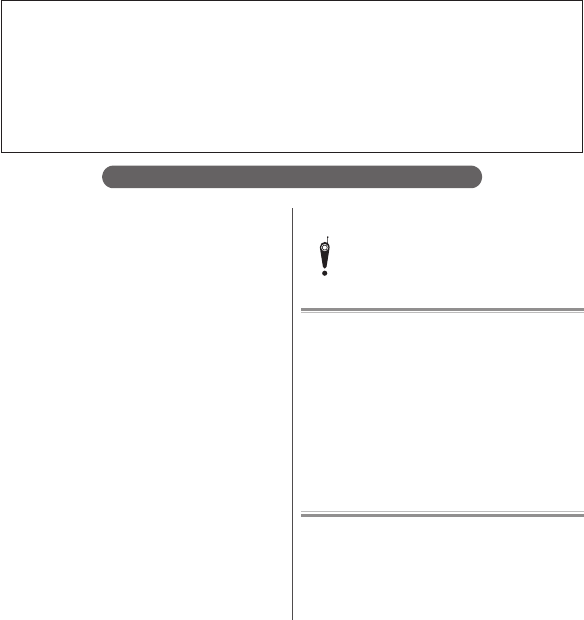
Don't forget your mobile phone ... or your manners!
Remember to be courteous to others when you use your terminal.
Turn the power off when you are:
■
In places where use is prohibited
Follow the instructions of each airline or medical
facility for the use of mobile phones on their
premises. Power off the terminal in a place where
the use is prohibited.
■
Driving
Using a handheld mobile phone while driving will
result in a penalty.
However, absolutely necessary cases such as
rescue of a sick person or maintaining public's
safety are exempted.
■
In places such as theaters, cinemas, and art
galleries
Using the terminal in a public place, where you
need to be quiet, annoys people around you.
Keep your voice and ring tone down
■
Keep your voice down in quiet places like
restaurants and hotel lobbies.
■
If you are in an outdoor public place, make sure
you do not disturb others.
Respect privacy
Please be considerate of the privacy of
individuals around you when taking and
sending photos using camera-equipped
mobile phones.
Have good manners
The terminal is equipped with useful functions
not to answer an incoming call or to mute the
sound.
【
Vibrate
】
(P.206)
Vibrates when there is an incoming call.
【
Silent mode
】(
P.41
)
Silent mode mutes the sounds of the terminal
such as the operation sounds and the ringtone.
* Shutter sound cannot be muted.
You can also use optional services such as the
Voice Mail Service (P.101) and Call Forwarding
Service (P.101).
Make various applications or charge your billing plan, check your charges and points, and more online.
sp-mode: dmenu
⇒
"
お客様サポート
(Customer support)
"
⇒
"
各種お申込・お手続き
(Various applications/procedures)
"
(Packet communication free) (In Japanese only)
PC: My docomo (http://www.mydocomo.com/)
⇒ 各種お申込
・
お手続き
(Various applications/procedures)
(In Japanese only)
* When using with sp-mode, "Network security code" is required.
* When using with sp-mode, you may be charged.
* "docomo ID and password" are required for use.
*
Please contact "General Inquiries" described on the last page if you forget or do not have "docomo ID and password".
* May not be available in some cases depending on the conditions of your subscription.
* There are cases where the site may not be available due to system maintenance, etc.
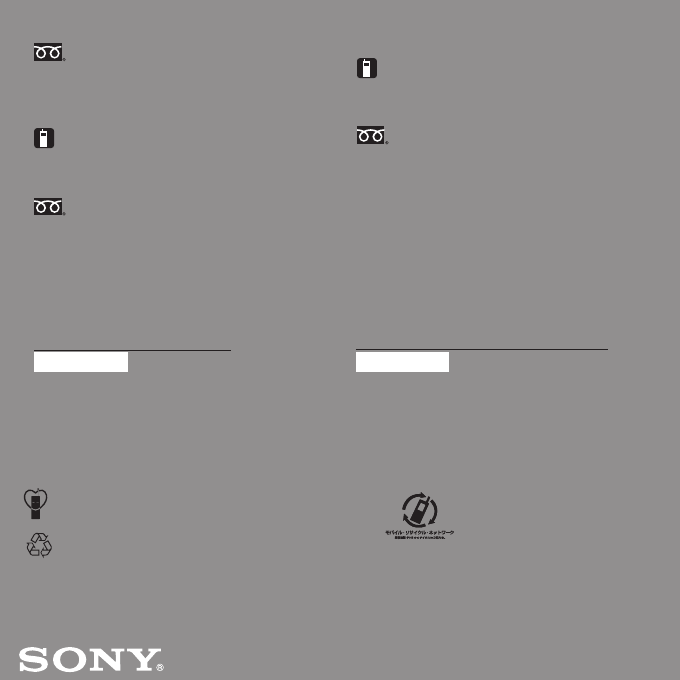
Sales: NTT DOCOMO, INC.
Manufacturer: Sony Mobile Communications, Inc.
’13.9 (1st Edition) 1277-2348.1
General Inquiries
<docomo Information Center>
0120-005-250 (toll free)
*Service available in: English, Portuguese, Chinese, Spanish.
*Unavailable from part of IP phones.
(Business hours: 9:00 a.m. to 8:00 p.m.)
■From DOCOMO mobile phones (In Japanese only)
(No prefix) 151 (toll free)
*Unavailable from land-line phones, etc.
■From land-line phones (In Japanese only)
0120-800-000 (toll free)
*Unavailable from part of IP phones.
(Business hours: 9:00 a.m. to 8:00 p.m. (open all year round))
●Please confirm the phone number before you dial.
●For Applications or Repairs and After-Sales Service, please contact the above-mentioned information center or the docomo
Shop etc. near you on the NTT DOCOMO website.
NTT DOCOMO website http://www.nttdocomo.co.jp/english/
For loss, theft, malfunction, and inquiries while overseas (24-hour reception)
International call access code
for the country you stay -81-3-6832-6600* (toll free)
*
You are charged a call fee to Japan when calling from a land-line phone, etc.
*
If you use SO-01F, you should dial the number +81-3-6832-6600
(to enter '㧗', touch and hold '0').
Don’t forget your mobile phone
・・・
or your manners!
٧When using your mobile phone in a public place, don’t forget to
show common courtesy and consideration for others around you.
Repairs
■From DOCOMO mobile phones (In Japanese only)
(No prefix) 113 (toll free)
*Unavailable from land-line phones, etc.
■From land-line phones (In Japanese only)
0120-800-000 (toll free)
*Unavailable from part of IP phones.
(Business hours: 24 hours (open all year round))
From land-line phones <Universal number>
Universal number international
prefix -8000120-0151*
*You might be charged a domestic call fee according to the call rate for
the country you stay.
*For international call access codes for major countries and universal number international prefix, refer to DOCOMO International Services website.
●If you lose your terminal or have it stolen, immediately take the steps necessary for suspending the use of the terminal.
●
If the terminal you purchased is damaged, bring your terminal to a repair counter specified by DOCOMO after returning to Japan.
From DOCOMO mobile phones
We collect old phones, etc. regardless of
brands and manufacturers. Bring them to
your nearest docomo Shop.
*
Items to be collected: mobile phones,
PHS, battery packs, chargers, desktop
holders (regardless of brands and
manufacturers)
Li-ion 00